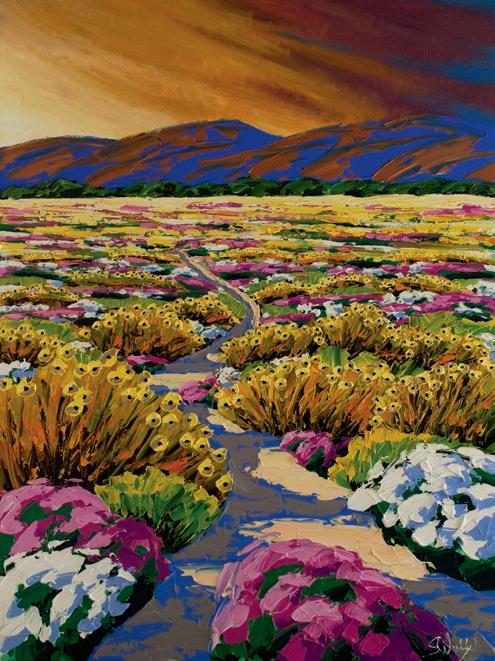




Judy Chicago
Agnes Martin
Bart Prince
Carlos Carulo
Erin Currier
Dennis Hopper
The Naminghas
Antoine Predock
Alexander Girard
Larry Bell
Emmi Whitehorse
James Havard
Eli Levin
Terry Allen
Fritz Scholder
Riva Yares
Meow Wolf
Madeleine Gehrig
Peter Sarkisian
Woody Gwyn
Florence Pierce
Michael Krupnick
Cody Sanderson
Kristin Diener

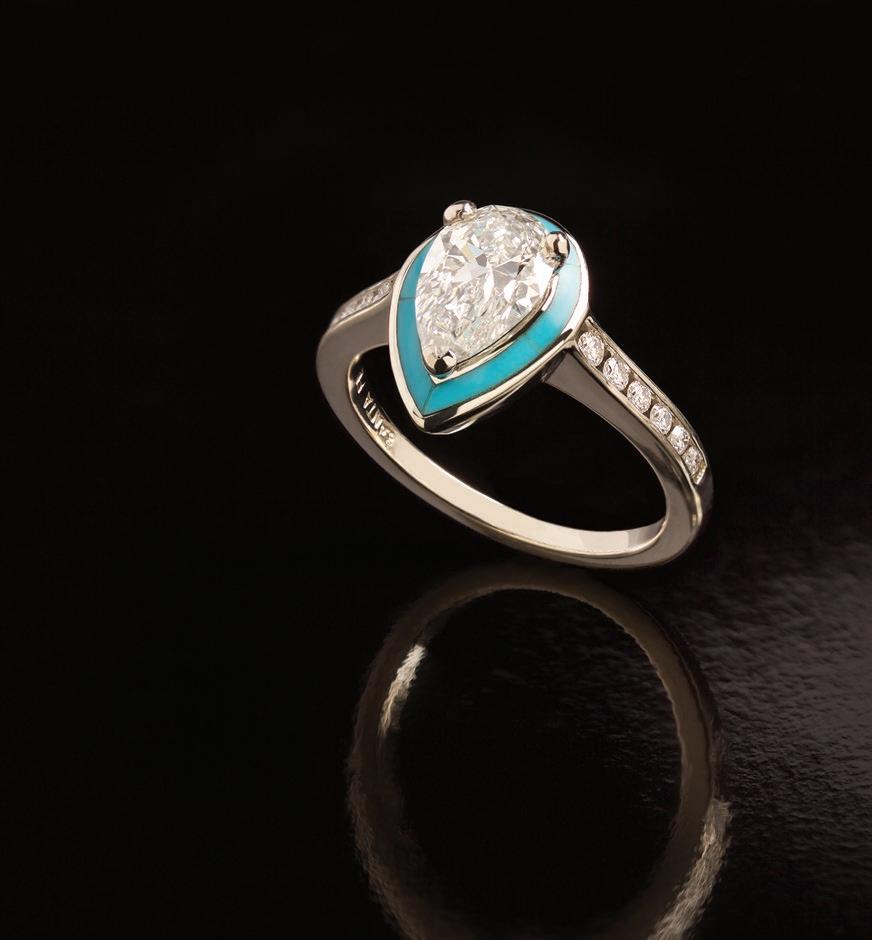





Nestled in the heart of one of the most historically significant buildings in Santa Fe, the Casa Sena, you will find Goler Shoes, a small, bustling boutique that has become a popular Santa Fe fashion hub. Part of its charm is no doubt due to owner Guadalupe Goler, who, after 40 years at the helm, still enthusiastically engages with customers when she’s not busy stocking the store with an everchanging selection of fine imported shoes, boots, clothing, and accessories for men and women. Brands include United Nude, Thierry Rabotin, Onfoot, Caddis, and Planet.

Guadalupe was only 28 years old in 1984 when she decided to bring fashion footwear to Santa Fe, a natural vocation for a woman whose grandfather and father had been in the shoe manufacturing business in Guadalajara, Mexico. Guadalupe quickly found her niche and her people. Her natural social skills and her ability to make people feel welcome both in and out of her shop have also played a large role in her success.
As has her family, who have helped her ride the myriad waves of change over the past 40 years. Whether it’s Guadalupe’s brother, her daughter, her son, or her grandkids, everyone plays an important part in keeping the business healthy and its legacy strong. So too do longtime salespeople and patrons, all of whom are also considered family.
Says Guadalupe’s daughter, Paula, “Goler is more than shoes, clothing, or accessories. Goler is an aesthetic, a vibe, and an experience.” Goler is also accessible to everyone. “Fashion is not exclusive—it’s an important means of expression.”
With Goler celebrating 40 years in business this year, it is Guadalupe’s greatest pride to see the continuation of her legacy to bring fun, fashion, and family connection to Santa Fe shoppers. golershoes.store | 125 E Palace Ave # 125, Santa Fe, NM 87501 | 505-982-0924







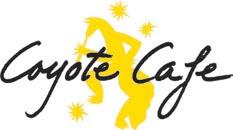



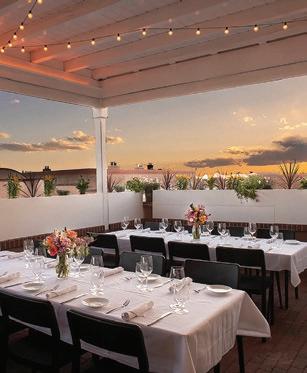
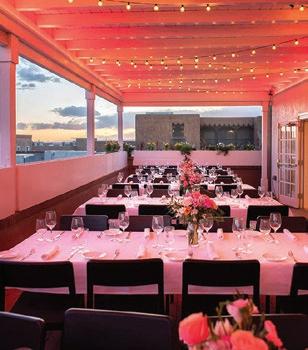
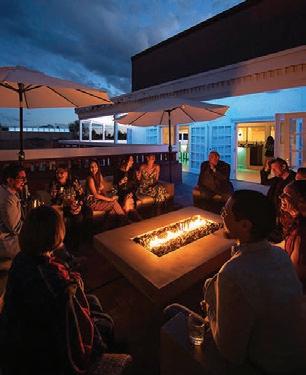

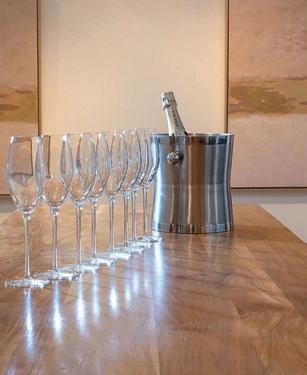

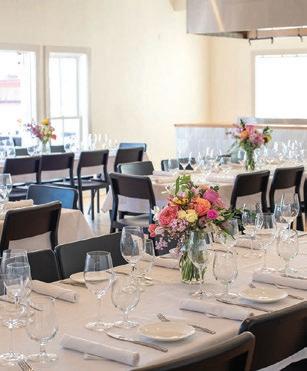







“Jack

JENNIFER







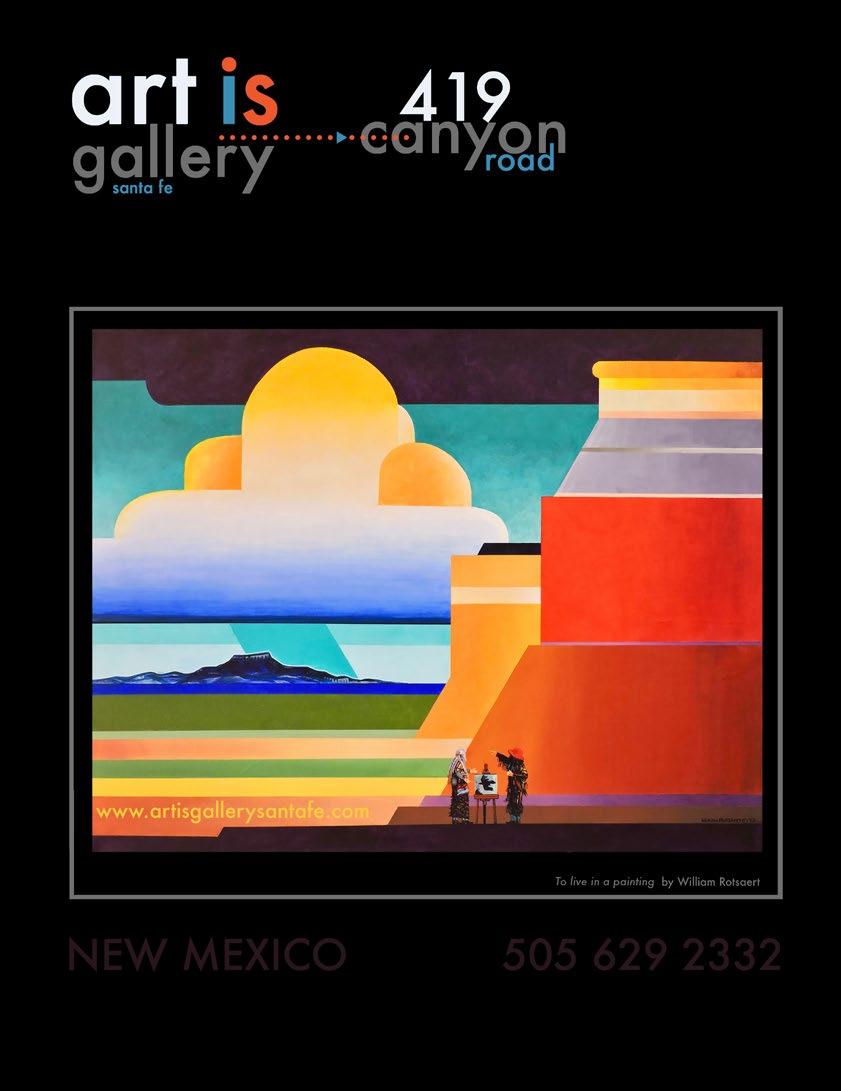
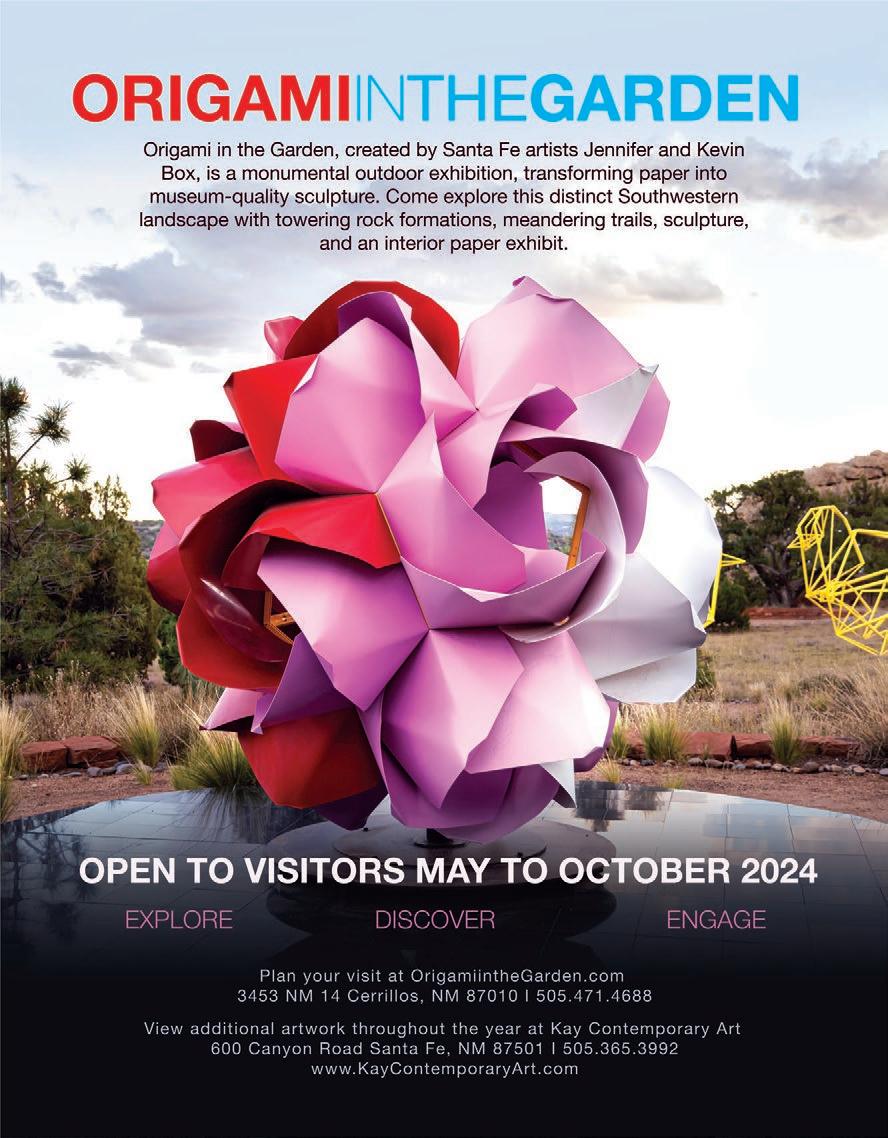

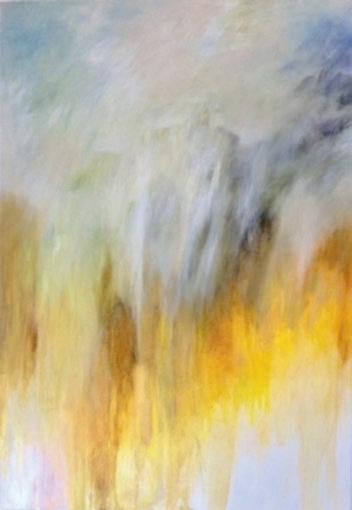

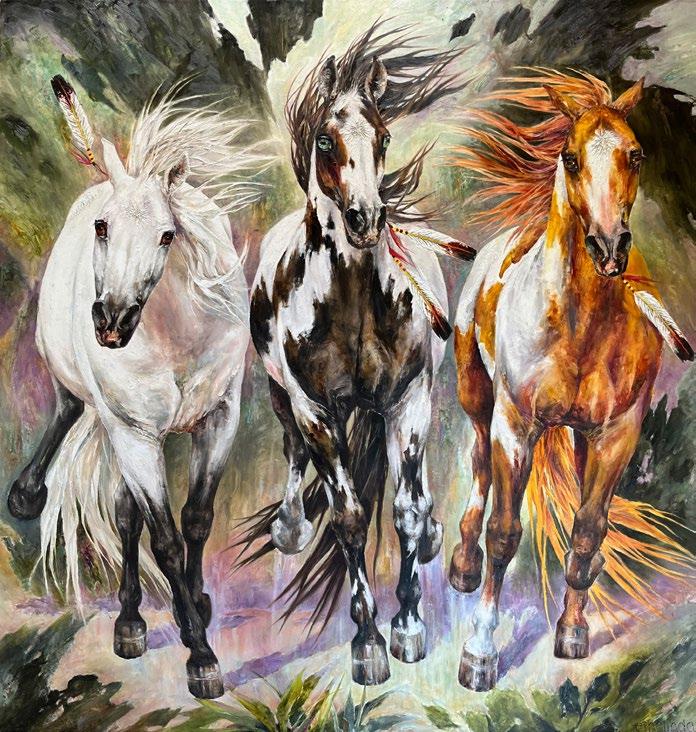



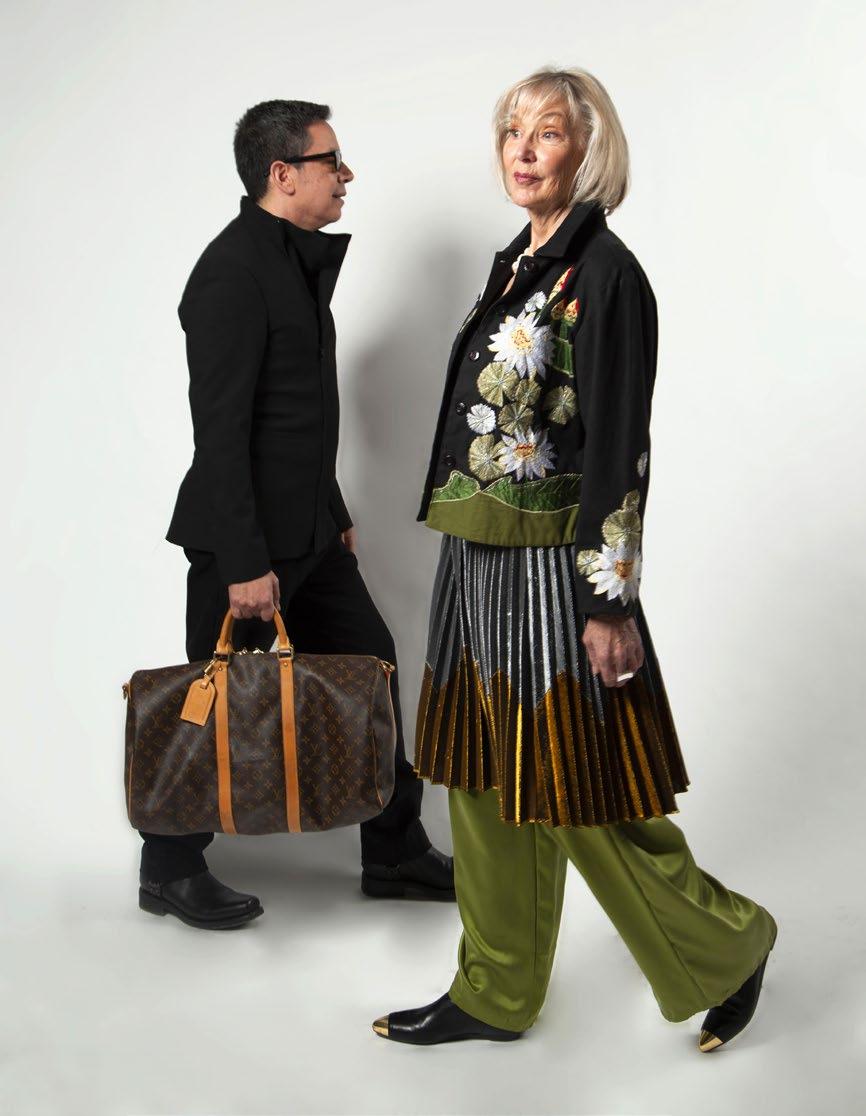







Twilight 5' high Edition of 9
Call to schedule studio/showcase visit. Open 6 days a week. Closed on Thursdays.

Famed sculptor David Pearson is best known for his exploration of the female form. His elongated, ethereal bronze figures, inspired by the ancient cultures of Egypt, Africa, and Asia, appear as if out of a dream or myth. A goddess, an angel, a muse, a nymph—all transcend ordinary reality, transporting the viewer to a space beyond time and place.
Pearson began sculpting at the age of 16, learning his craft at Shidoni Foundry in Tesuque, where he cast works for established masters, including Allan Houser. Despite being exposed to many sculptural influences, he developed his own style, imagery, and techniques, creating works that have drawn enthusiastic collectors from around the world.
Pearson was for many years represented by Patricia Carlisle Fine Art, his wife’s gallery in Santa Fe, which she established in 1997. In 2021, with Pearson now a nationally recognized, award-winning artist with an extensive customer base, the couple decided to move the gallery to their home, a peaceful rural retreat off the historic Turquoise Trail.
How does an established fine art gallery on iconic Canyon Road in Santa Fe metamorphose into a home studio and survive?
“Extraordinarily well,” Carlisle says. “We offer members of our huge customer base an opportunity to come out to David’s studio and experience the artist’s thinking and working processes and to see the many steps involved in the creation of a finished sculpture. We have a steady stream of clients and visitors, many who have become friends because this isn’t just a gallery visit, it’s a very private and personal experience. No one walks away unmoved by David’s dedication and total commitment to his art.”
carlislefa.com | Patricia Carlisle Fine Art, Inc. | Pearson Studio & Sculpture Garden 5 Sculpture, Santa Fe, NM 87508 | 505-820-0596


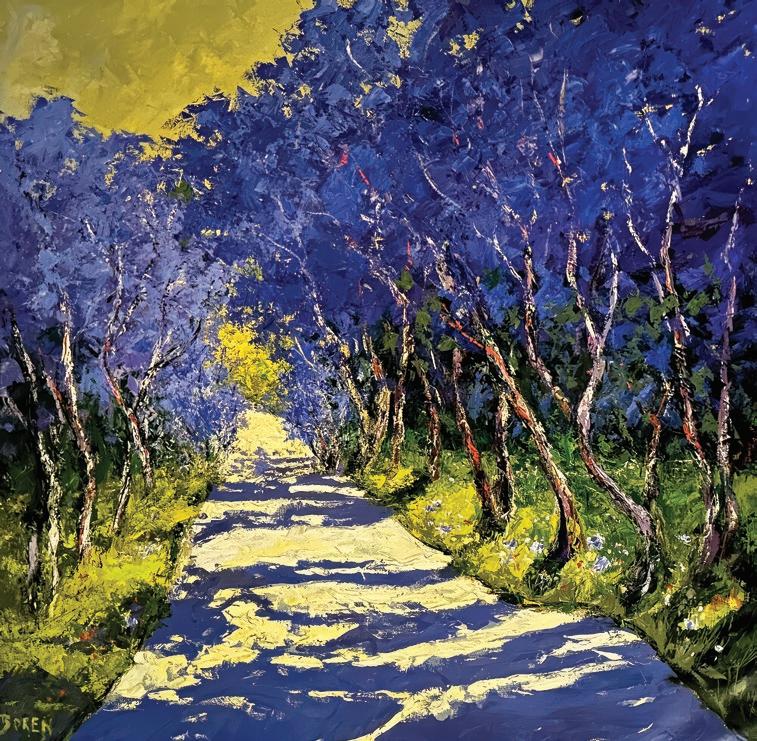
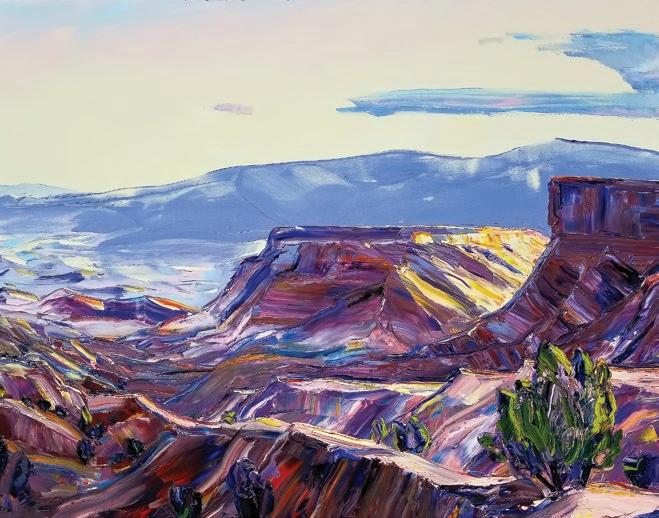
Acosta Strong Fine Art is the first gallery at the beginning of Canyon Road, and that prime location is something that co-owner Carlos Acosta pays special attention to. “We make a point of showing a variety of different artists,” he says, “mixing old and new, historic and contemporary, to give people a taste of what Canyon Road has to offer.”
Unlike most galleries, Acosta Strong puts on shows once a month in order to promote one or more of its 16 artists, six of which have exclusive representation. “I love being the conduit for completing the circle of life of a painting,” Acosta explains, “from its creation by the artist to finding a home with the right collector.”
He is committed to his artists, each of whom has a distinctive voice, or as he puts it, “brings something to the table.” They are always there for shows that promote their artwork, and some collectors even fly in from out of state as well. “Building relationships is something that really matters to us,” says Acosta, “and most of our collectors have met the artists and seen their paintings, which then makes it easier for them to relate to images on a screen.”
Something else that sets this gallery apart is that every artist has their work shown in a distinctive frame, handmade in gold metal leaf by a local frame-maker—another indication that the gallery is clearly invested in supporting its artists for the long-term.


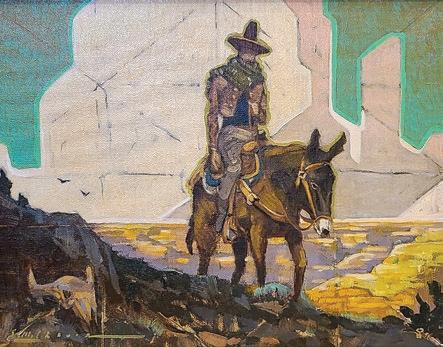
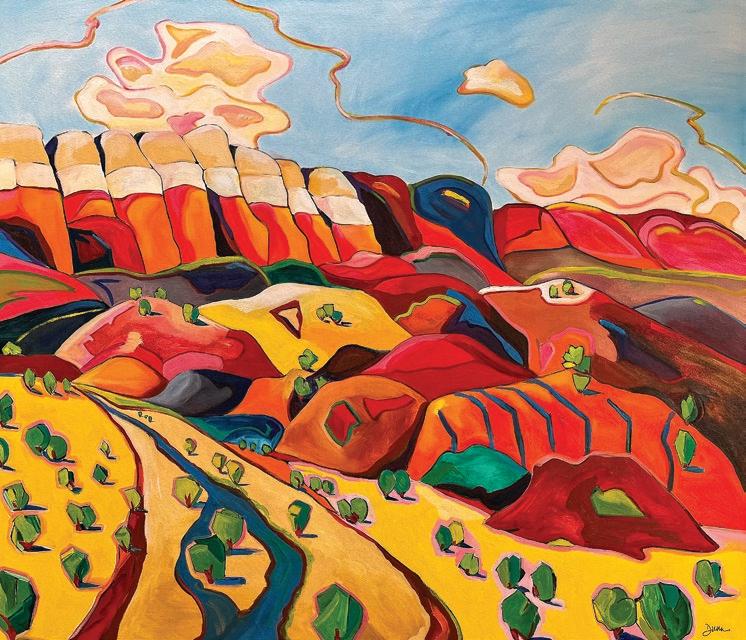



SITE SANTA FE, the city’s dynamic interdisciplinary contemporary arts institution, places artists at the center, collaborating with them to explore extraordinary ideas through innovative installations and programs. From its founding in 1995, notable artists invited to exhibit include Bruce Nauman, Deborah Roberts, Pedro Reyes, Shirin Neshat, Graciela Iturbide, Cannupa Hanska Luger, Raven Chacon, Doris Salcedo, Agnes Martin, Mungo Thomas, and others.
This year, in addition to regular exhibitions, the organization is preparing for 2025’s 12th International, where artists and curators, both local and from around the world, will respond to the unique geography, history, and cultures of New Mexico. Since its first edition in 1995—at the time the only community-wide, U.S.based, international biennial of contemporary art—the
International has collaborated with 331 artists and 21 curators in a forum for the most groundbreaking ideas in contemporary art.
“We’re excited that Cecilia Alemani will curate our 12th International, the first we’ve mounted since 2018,” says Louis Grachos, SITE’s Phillips Executive Director. The director and chief curator at High Line Art in New York City, Alemani also served as artistic director of the 59th Venice Biennale in 2022. “She’s the fourth curator to organize both, and as a champion of the voice of the artist her curatorial approach fits seamlessly with our artist-centric vision. We look forward to the new works, ideas, and dialogues that will emerge from her curatorial vision.”
SITE SANTA FE has free admission and is open to the public Thursday through Monday.


ON VIEW AT SITE SANTA FE:
TERESITA FERNÁNDEZ / ROBERT SMITHSON
07.05 - 10.28.2024
TRISTAN DUKE: GLACIAL OPTICS
09.27 - 01.13.2025
CASSILS: MOVEMENTS
11.15 - 02.23.2025
ERIKA WANENMACHER: WHAT TIME TRAVEL FEELS LIKE, SOMETIMES
11.15 - 02.23.2025
DAKOTA MACE: DAHODIYINII – SACRED PLACES
02.28 - 05.19.2025
HARMONY HAMMOND
02.28 - 05.19.2025
12TH SITE SANTA FE INTERNATIONAL CURATED BY CECILIA ALEMANI SUMMER 2025 - EARLY 2026
1606 Paseo De Peralta | Santa Fe, New Mexico 87501 | 505-989-1199 | sitesantafe.org





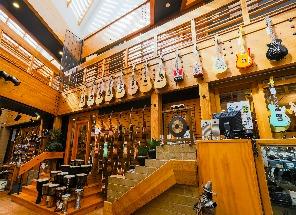







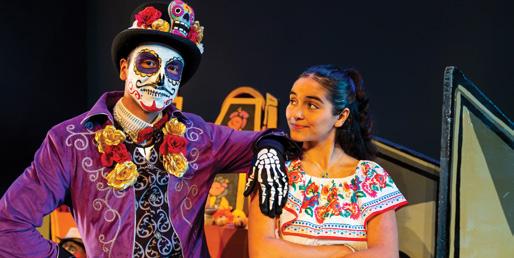













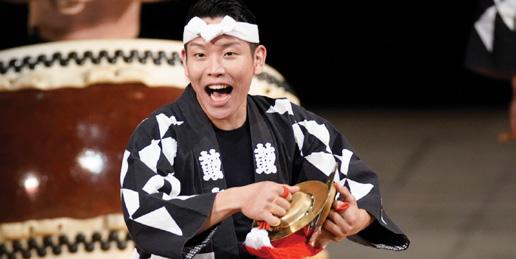












David DeStefano spends thousands of hours chiseling, hammering, and intricately grinding away at his stone sculptures until they become magnificent faces, torsos, or hands. And yet, in DeStefano’s case, the everevolving relationship between artist and material is much more. There’s respect. A reverence. A mutual understanding about birthing a form that embodies relational qualities such as candor and vitality.
DeStefano says: “There’s an honest world that exists inside the stone. Stones won’t initially reveal their natures, but if

Miracle of Life and Death, 90”x23”x22”, Texas limestone;
Bottom right: Mother and Child, 28”x23”x21”, Indiana limestone;
Bottom left: Work in progress, 85”x12”x12”, Indiana limestone
asked, they won’t lie—their answers are always honest.” For over 30 years, sculpting manifests expressive symbiosis for DeStefano and his pieces. Holding a hammer and chisel, and intently exerting his hands to convey flashed images he sees quietly nestled within blocks of stone or wood, brings him home.
“Life exists in and through stones,” DeStefano says. “Every angle and curve conveys emotion as told through shadow and light. My sculptures are guided by the emotional tone that already exists within them.”

200 Antoine Predock
Architecture and Time
B y Wesley P ulkka | Photos By Ro B eR t Reck
208 The Box Beyond
Peter Sarkisian turns TV sets into digital sculptures
B y D evon Jackson | Po R tR aits By JennifeR e sPeR anza
218 The Art of the Book
When art and literature converge, the result is a unique and compelling aesthetic experience
B y lynn stegneR
226 Queen of Interesting
The life, loves, and lasting impact of Riva Yares
B y D evon Jackson | Photos By k ate R ussell
236 Taking it to the Streets
Native American street art sparks a dialogue about cultural and environmental issues
B y nancy zimmeRman
248 Santeros in a Time of Few Saints
Spanish Colonial arts reach a crossroads
B y k eiko o hnuma | Photos By PeteR o gilvie
256 Iron Will
Sculptor Tom Joyce fuses the art and science of metal making
B y chR istina PR octeR | Photos By PeteR o gilvie
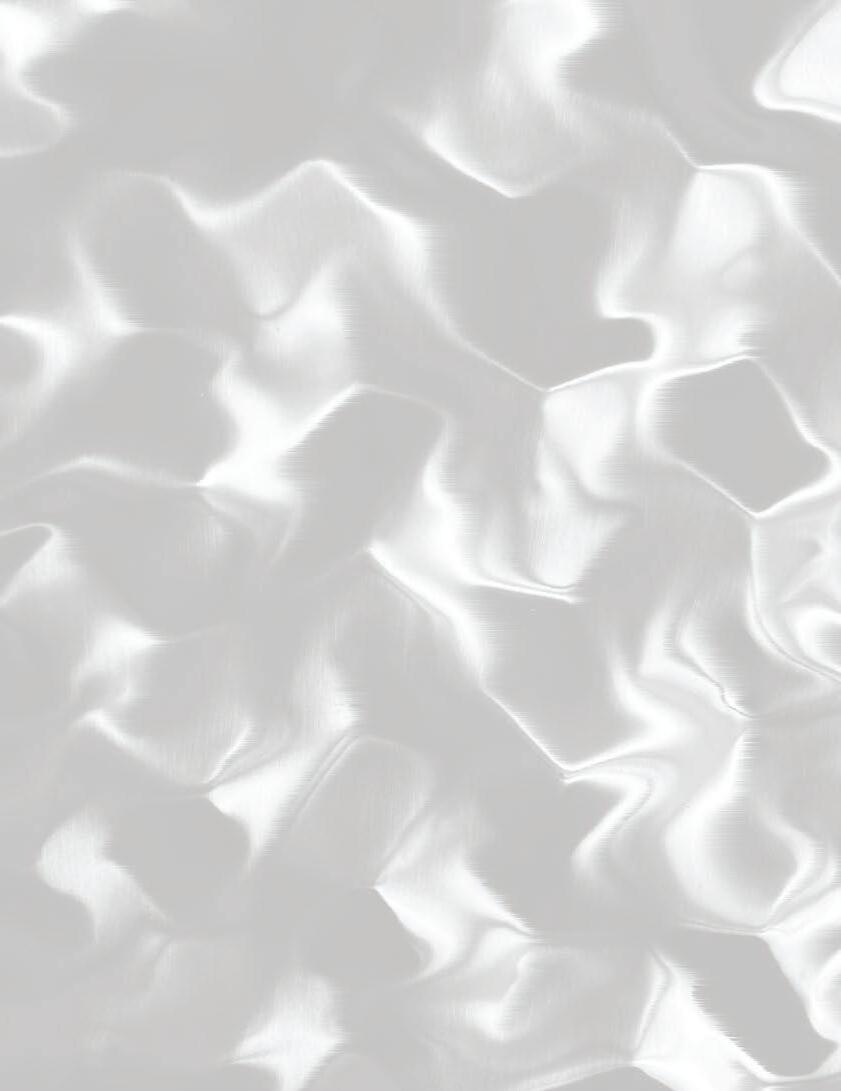
268 Points of Connection
The Namingha family of artists blends ancient ways with a modern worldview
B y nancy zimmeRman | Po R tR aits By k ate R ussell
280 Artistic Identity in Native America: What’s in a Label?
Art patrons tend to keep Indian artists in a cultural box that marginalizes their talents
B y PeaR l tiR esias | Photos By B R enDa k elley
292 Radically Original
The art of Bart Prince’s architecture
B y e llen B eR kovitch | Photos By Ro B eR t Reck
304 Changing the Vernacular
The late architect Jeff Harnar melded contemporary materials with an appreciation of the natural world
B y nancy zimmeRman | Photos By Ro B eR t Reck
322 Staging Light
Architect Michael Krupnick designs “movie sets” for people’s lives that keep nature close
B y B ill Ro D geR s | Photos By k iR k gittings
330 Down to Earth
Classic New Mexico architecture meets the latest in sustainable technology in architect
Michael F. Bauer’s high-desert, passive-solar villa
B y stePhanie PeaR son | Photos By chas mc gR ath
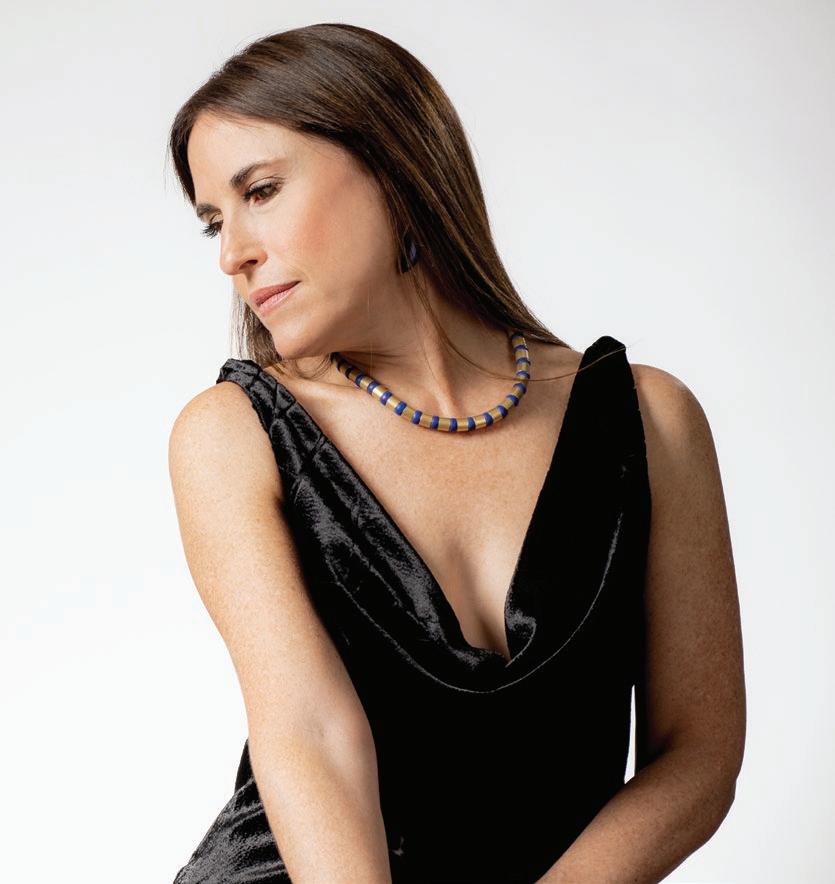
ART MATTERS
58 Cuffs Around the Edges
Two New Mexico jewelers amp up a traditional shape
B y heiD i e Rnst
68 Terry Allen: Theater of Art Master of multimedia, he invites all of our senses to the party
B y k athRyn m Davis | Photos By k ate R ussell
71 Crafting Worlds
A new Santa Fe art installation explores a fantastical family narrative
B y Jamie holt | Photos By k ate R ussell
81 Alexander Girard
The Legacy of the Mid-Century Modern Maestro in New Mexico
sto Ry anD Photos By R achel PR inz
86 Calling on the Past
An artist lives and works in his great-grandfather’s studio
B y gussie fauntleR oy | Photos By k ate R ussell
102 The Artful Adventurer
Madeline Gehrig brings the world home
B y Rena D istasio | Photos By k ate R ussell
TAOS
138 Water, Earth, Stone, Flesh
Currents of tradition flow through generations of Taos Pueblo artists
sto Ry anD Po R tR aits By Rick Romancito
151 He’s a Walking Contradiction, Partly Truth and Partly Fiction Reflections and Reminiscences of Dennis Hopper in Taos
B y lyn B leileR
162 The Bearable Lightness of Being Light and reflection in the work of Larry Bell
B y lyn B leileR | Photos By k ate R ussell

170 Abiquiu’s Luminous Stone
Excerpted from Valley of Shining Stone: The Story of Abiquiu
B y lesley Poling - k emPes
186 House on a Hill
Doug Coffin and Kaaren Ochoa’s Abiquiu inspiration
B y Wesley P ulkka | Photos By k ate R ussell
DESIGN SOURCE
287 Inspired Partnerships Inform Santa Fe’s Built Environment
348 Edgy Landscapes
Edith Katz enacts divisions and fusions between gardens and the prairie
B y e llen B eR kovitch | Photos By k ent B oWseR
354 New Mexico’s Largest and Most Diverse City Embodies the Spirit of the Modern American West.
356 Body and Spirit
Drawing from myth, memory, and ancient history, Kristin Diener crafts intricate sculptural adornments that are part jewelry, part talisman
B y Rena D istasio | Photos By k ate R ussell
360 The Art of Survival
A unique Albuquerque initiative addresses homelessness through pencils, paint, and purpose
B y heiD i utz | Photos By k ate R ussell
MASTER ARTISANS
368 Igniting Debate
Agnes Martin: Before the Grid unveiled Abstract Expressionist icon’s early work
B y Jan e Rnst a D lmann
372 Paint, Refined and Raw
The mastery of James Havard
B y l auR a a DD ison
112 Fritz Scholder in Galisteo
People remember the celebrity and the parties. But Santa Fe’s most controversial Native artist had another side
B y k eiko o hnuma | Photos By PeteR o gilvie
134 At Home with His Destiny
Santero Ramón López’s art and home are works in progress
B y teR esa z amo R a | Photos By JennifeR e sPeR anza
378 Minimalist Master
The Zen-like artistry of Florence Pierce
B y sunamita lim | Po R tR ait By D ouglas k ent hall
380 Chicago Rules
Judy Chicago devotes her life to shattering assumptions and stereotypes
B y Wesley P ulkka | Photos By D onalD Woo D man
386 The Purist
Eli Levin eschews technology and trends in works that speak directly to the viewer
B y a nya seB astian | Photos By Dominique voRillon
392 Precisely, Woody Gwyn
The master of plein-air realism finds truth in what is
B y e liza Wells smith | Photos By k ate R ussell
398 A Slow Unfolding of Landscape Emmi Whitehorse and her symbolic connection to the natural world
B y Wesley P ulkka | Photos By k ate R ussell
402 Stars and Spikes Forever
Cody Sanderson’s new jewelry anthem
B y gussie fauntleR oy | Photos By saR a stathas
406 Abstract Emotionalism
The idiosyncratic visual language of Carlos Carulo
B y Wesley P ulkka | Photos By k ate R ussell
408 Art that Heals
Erin Currier’s portraits convey the dignity, power, and heroism of the marginalized and unsung
B y nancy zimmeRman | Po R tR ait By Daniel q uat
412 Four-Dimensional Sculpture
James Marshall strives to embody nature and beyond
B y Wesley P ulkka | Photos By k ate R ussell
414 Material Metamorphosis
Tasha Ostrander’s meditative process turns artist into magician
B y Rick l um | Photos By k ate R ussell
419 New Mexico’s Culinary Inspiration
420 Nourishing Culture
Native American chefs create a healthier future by reclaiming the past
B y nancy zimmeRman | Photos By l ois e llen fR ank
428 Back to the Future of Farming
Rancho Manzana forms a new bond in the relationship between grower and customer
sto Ry anD Photos By ga BR iella maR ks
437 Call it Ethos
Erin Wade wants to change the way we think about healthy eating and sustainable practices
B y Rena D istasio | Photos By seR gio salva D o R



About the cover: Bedroom passage from a home in Colorado designed by Antoine Predock (1990), photo courtesy Robert Reck. Painting on far wall, Sasha vom Dorp, Unknown Frequency Sunlight (2011), archival pigment print mounted on aluminum. Painting on right-hand wall: Carlos Carulo, Nebula and Twelve Fragments (2023–2024), mixed media on canvas board.

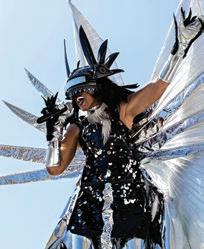



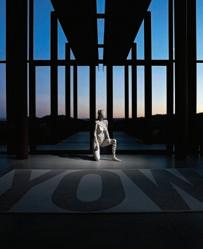











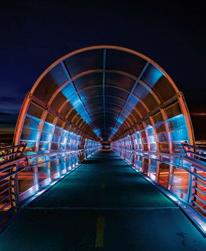
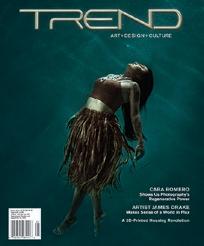












As you open this retrospective issue celebrating the best of Trend magazine over the past 25 years, you may ask, “Why look back instead of charging forward?” At this fraught moment in history, it’s the ideal time to take stock, review where we’ve been, and chart a new course for the future. Our world has experienced massive changes—social, political, technological, and climatologic—over this past quarter-century, and Trend has chronicled these changes via the works of the many artists, architects, designers, musicians, chefs, and assorted dreamers who have graced our pages. By creating this retrospective—448 pages of our fondest memories and finest talent—we offer not merely a trip down memory lane but also an overview of the shifting aesthetic, emerging voices, and evolving techniques that keep Santa Fe and Northern New Mexico in the forefront of artistic accomplishment. Our mission from the beginning has been to champion the myriad visuals and voices of the artmakers who call New Mexico home. Those we chose to revisit in this issue represent a cross section of 25 years of coverage—for every Agnes Martin, Judy Chicago, and Dennis Hopper we have been equally committed to those who, like Emmi Whitehorse, Woody Gwyn, and Eli Levin, make their art largely away from the glare of the limelight. We’ve also brought you stories of the gallerists who support them, like the incomparable Riva Yares; of the initiatives that nurture them, like Albuquerque’s Art Street; and of the exhibitions that redefine the art-viewing experience, like Meow Wolf.

Equally passionate about architecture, we have long been committed to showcasing the ways in which visionaries like Antoine Predock, Bart Prince, Jeff Harner, Michael Bauer, and Michael Krupnick, whose stories are reprinted here, have evolved the relationship between the natural and built environments. Trend is also a magazine of design, and our issues regularly feature the industry’s most renowned craftspeople, from interior designers to landscape architects, who bring their expertise to crafting outdoor environments as beautiful as they are functional. Our culinary coverage has likewise focused on those chefs, restaurateurs, and purveyors who consistently reconsider and redefine our relationship with dining, the land, and the bounty we harvest from it.
Then there is Trend itself. We’ve lost count of how many times the death knell of print media has been sounded since we first went to press. Yet, here we are, a testament to publisher Cynthia Canyon’s unswerving belief in the power of the physical page, made beautiful by art director Janine Lehmann, who has been evolving this magazine’s distinctive look from the beginning. We must also mention the many dedicated photographers and writers who have focused their lenses and sharpened their pens to help make Trend one of the region’s most respected magazines of the arts. There are too many to mention here, but you’ll recognize their names in these pages. Some write and shoot for us to this day; some have left for other opportunities; while others, like Heidi Utz and Eliza Wells Smith, were taken from us way too soon. May they rest in peace. We will always hold them in our hearts as cherished members of Team Trend.
As we also hold our readers and advertisers. We will forever be grateful for your support, for your feedback, for finding within our pages not only information but also inspiration. Whatever the next 25 years holds for us, we hope you join us on our journey.

During the process of working with my team to put together a retrospective of Trend’s 25 years of publishing, I started to think about the word legacy, which Webster ’s defines as “something transmitted by or received from an ancestor or predecessor or from the past.” Then while I was trying to translate these thoughts to this letter, the sudden death of a young Trend team member—Duncan Evans Walker—left me reeling and reconsidering the impact our work has on others. This young man gave his heart and soul to his clients, and although he lived only a short 21 years, he leaves a legacy of how to live with determination, confidence, and grace. He was just one of the many people I have met in my 25-plus-year journey as Trend publisher who helped me establish and grow one of the top art magazines in the region. What has emerged from my team’s in-depth review of the past 25 years of coverage was a renewed appreciation of the timeless, far-reaching legacy of New Mexico’s artistic output.
Here in New Mexico we are blessed with a unique artistic legacy that extends back to prehistoric times. The sophisticated symbols and designs first created by Native artists have stood the test of time, remaining as contemporary and evocative today as they were hundreds of years ago. These deceptively simple images continue to inform the work of current-day artists, both Native and non-Native, adding a timeless quality to work that might otherwise be considered new and trendy.
Similarly, the Hispanic artistic legacy, shaped by the richly symbolic devotional art forms brought from Spain by the initial settlers, has embedded itself in the local aesthetic, as has a distinctive architecture that still finds relevance in modern building styles. Later waves of settlers have added, and continue to add, to the everevolving state of New Mexico arts. The result is a unique syncretism wherein the distinctions among past, present, and future become blurred, while new creations build on the commingled legacies of past artistic contributions.
To me, the word legacy also means something more. I think of the many intertwined stories of the people, past and present, famous or anonymous, who have contributed to our collective spirit and aesthetic. It has been my goal since the beginning to present Trend readers with a magazine that chronicles and builds on the legacies of these innovators and unsung heroes, honoring the artistic spirit that makes our little corner of the world a key player in the art and design world writ large.
To the extent that Trend has created its own legacy, I tip my hat to the talent not only of the people we cover but also the writers and photographers who bring these many stories to life. I owe a debt of gratitude as well to the steadfast crew that produces each issue—most notably art director Janine Lehmann, editors and writers Rena Distasio and Nancy Zimmerman, and production editor Jeanne Lambert.
Trend magazine could never have existed without all of the aforementioned builders of the New Mexican artistic legacy. It has been my honor and privilege to explore their vision and artistry in our pages, and I am grateful to be able to play a part in our region’s ever-evolving legacy of artistic excellence.
Cynthia Canyon Founder and Publisher
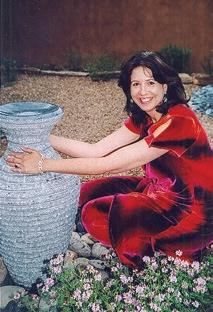

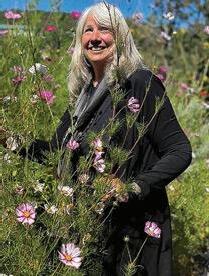

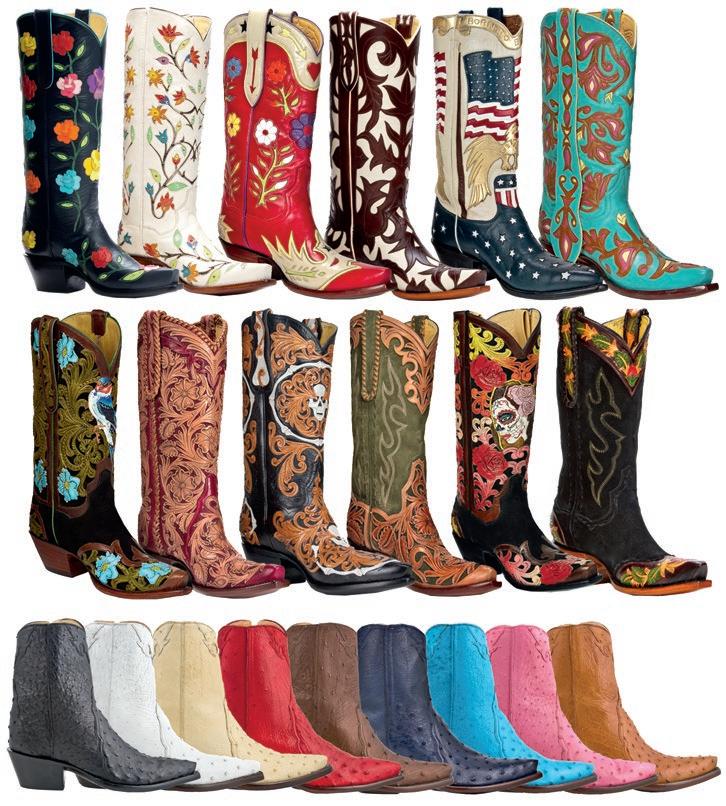

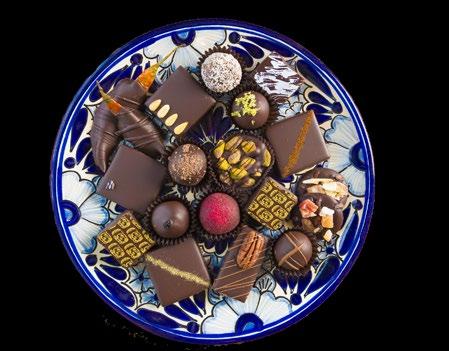
PUBLISHER
Cynthia Marie Canyon
EDITORS
Rena Distasio
Nancy Zimmerman
ART DIRECTOR
Janine Lehmann
PRODUCTION MANAGER & ASSOCIATE DESIGNER
Jeanne Lambert
PHOTO PRODUCTION
Boncratious
CONTRIBUTING WRITERS
Laura Addison, Jan Ernst Adlmann, Ellen Berkovitch, Ashley M. Biggers, Lyn Bleiler, Kathryn M Davis, Rena Distasio, Heidi Ernst, Gussie Fauntleroy, Jamie Holt, Sunamita Lim, Ric Lum, Devon Jackson, Gabriella Marks, Keiko Ohnuma, Stephanie Pearson, Rachel Prinz, Christina Procter, Wesley Pulkka, Bill Rodgers, Rick Romancito, Anya Sebastian, Eliza Wells Smith, Lynn Stegner, Pearl Tiresias, Heidi Utz, Teresa Zamora, Nancy Zimmerman
CONTRIBUTING PHOTOGRAPHERS
Boncratious, Kent Bowser, Jennifer Esperanza, Lois Ellen Frank, Kirk Gittings, Douglas Kent Hall, Brenda Kelley, Gabriella Marks, Chas McGrath, Peter Ogilvie, Rachel Prinz, Daniel Quat, Robert Reck, Rick Romancito, Kate Russell, Sergio Salvador, Sarah Stathas, Cyndy Tanner, Dominique Vorillon, Donald Woodman
REGIONAL SALES DIRECTOR
Sondra Lee Allison, 505-470-6442
ACCOUNT REPRESENTATIVES
Anya Sebastian, 505-470-6442
Duncan Walker, 505-470-6442
TAOS AD SALES
Bill Curry, 505-470-6442
NORTH AMERICAN DISTRIBUTION
Disticor Magazine Distribution Services, disticor.com
NEW MEXICO DISTRIBUTION
Ezra Leyba, 505-690-7791
ACCOUNTING AND SUBSCRIPTIONS
Patricia Moore
SOCIAL MEDIA MARKETING
Janna Lopez
PRINTING
Publication Printers
Denver, Colorado
Manufactured in the United States
Copyright 2024 by Santa Fe Trend LLC




All rights reserved. No part of Trend may be reproduced in any form without prior written consent from the publisher. For reprint information, please call 505-470-6442 or email santafetrend@gmail.com. Trend art+design+culture ISSN 2161-4229 is published online throughout the year and in print annually (20,000 copies), distributed throughout New Mexico and the US. To subscribe, visit trendmagazineglobal.com/ subscribe-renew. To receive a copy of the current issue in the US, mail a check for $35.00 to P.O. Box 1951, Santa Fe, NM 87504-1951or go online to subscribe to the next issue at trendmagazineglobal.com/subscribe. Find us on Facebook at Trend art+design+culture magazine and Instagram@santafetrend
We’re seeking new and diverse voices! If you are a writer or photographer interested in contributing, please visit trendmagazineglobal.com/contribute and send your story pitches to santafetrend@gmail.com.
Trend, P.O. Box 1951, Santa Fe, NM 87504-1951 505-470-6442, trendmagazineglobal.com

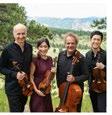





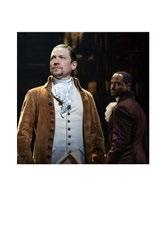






It was during his medical school studies in the late 1990s at Tulane University in New Orleans that metal artist Tim Church began to explore the possibilities of applying his knowledge of chemistry and machining to fine art as a way to generate emotion.
Inspired by the city’s rich cultural heritage, he decided to try to recreate one of the copper fountains he had seen during his walks through the city. “I thought they looked fun to make,” he says. “And they were.” Then he decided he wanted something for indoors.
“I kept experimenting, pushing the boundaries of the metal using various concentrations and combinations of organic acids and bases during different seasons to change colors.”
The result, a process he has since trademarked and calls “vibrant toning on copper,” combined the reactions of acids, bases, temperature, humidity, and oxygen on sheets of copper to create unique, multicolored wall art. Church’s first exhibition, in 2012 in Baton Rouge, sold out on opening night.
Now a chief medical officer in Dallas, he has been exclusively represented by Santa Fe’s Wiford Gallery since 2017. Church’s intimate partnership with the forces of Mother Nature draws color out of the copper rather than merely applying it, resulting in singular contemporary art pieces reminiscent of the patterns of nature. Each one is a statement about the power of organic transformation guided by the hand of the artist.
“Nature makes the acids and bases react, and their interactions affect what you see and feel,” he says. “No piece will ever be like another because of these factors—it’s impossible to perfectly recreate another one. The chemistry and experimenting with it are what’s interesting to me. I love that I get to work with nature to create fine art.”



Toms’ Evening Stroll, finished clay (available for preorder in bronze), 13 1/2” x 16” x 1”

TRANSCENDING THE MEDIUM
Low-relief bronze sculptor Jeremiah Daniel Welsh’s mastery of an ancient medium all but lost in the modern age is undeniable. Raised in a community where representational art was frowned on, his story is one of achieving recognition for his aptitude in the face of strong resistance. The gift of those challenging circumstances was a steep trajectory in developing his talent and art. Now his work demonstrates that he is one of the best low-relief bronze sculptors in the world.
Welsh’s ability to create intricately detailed, representational and contemporary portraits and nature scenes began when he encountered a ceramic artist from Korea who set such high standards for his personal work that he would destroy pieces that did not rise to those exacting expectations. This early exposure to Asian artistry was later reinforced while Welsh lived and sculpted professionally in Japan. Both experiences profoundly impacted his desire to continue pursuing artistic excellence.
Welsh further developed his skill set during the 15 years he spent as a contract relief sculptor for an international bronze foundry, where he produced upwards of 175 diverse pieces annually. This intensive practice honed his attention to detail and helped him develop an intimate understanding of the foundry process, which he insists on participating in for every piece.
Based in Colorado Springs, Welsh is the most acclaimed low-relief bronze sculptor working in the medium. Consistently awarded top honors by the National Sculpture Society at their annual juried exhibitions, he was also commissioned in 2022 to create the 50th anniversary medal for the Brookgreen Gardens in Murrells Inlet, South Carolina.
Whether working on a commissioned piece or his own designs, he is driven to continually explore the illustrative possibilities of the medium. “What you show the viewer on the surface is important,” he says, “but convincing them that what they cannot see is actually there, that’s where the finesse comes in.”
In addition to representing original living artists, Wiford Gallery also provides a service for collectors interested in acquiring or selling historical works of art. “Not everyone
wants to go through the process of getting involved or continuing with art auctions,” Wiford explains. “So we work on their behalf to find what they are looking for and match sellers with suitable buyers.”
Wiford’s passion for art has clearly not diminished one iota since he started the gallery back in 2002. “Putting beautiful art into the world satisfies an essential part of my soul,” he says. “It is our honor to serve our exceptional artists, our collectors whose support of the arts energizes and expands that process, and our team members who connect all the parts that make the existence of Wiford Gallery possible.”

Visions of Farewell, faux finished resin (available by order in bronze), 23” x 11 3/4” x 5/8” (unframed)


Charlotte Shroyer grew up in a rural area of Ohio, where neither her family nor the local school system placed much value on art. It was picking up a paintbrush for the first time as part of a project required for her elementary education certification at Ohio State University that planted the seed for her future passion. She began taking art classes at various universities while earning a bachelor’s degree in French. She later became a college professor after receiving a PhD in language and learning disorders. It was only after a serendipitous move to Taos many years later where she worked as writer and editor for a small art publication that the “art seed” finally took hold.
“I am inspired by the world, its people, archaeology, and cultures,” Shroyer says. “My favorite authors, like Lawrence Durrell, Orhan Pamuk, Thomas Pynchon, all explore duality of personality—what the individual shows to the world and what remains hidden—and that is what fascinates me.”
Shroyer also remains impacted by her work with children and adults who have limited language skills, and she has developed visual systems that convey information more symbolically. She cites the early Cubism of Picasso and later works by Ecuadorian artist Oswaldo Guayasamin as influences.
In addition to her paintings, which have earned numerous national and international awards, Shroyer also makes Navajo-style woven pillows and rugs, as well as wall hangings, table runners, and ethnic baskets. She also enjoys doing custom work for interior design projects.

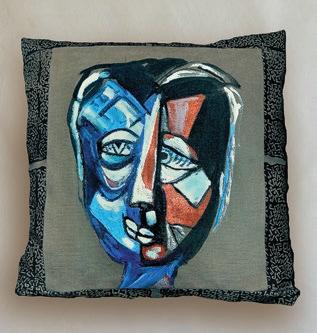


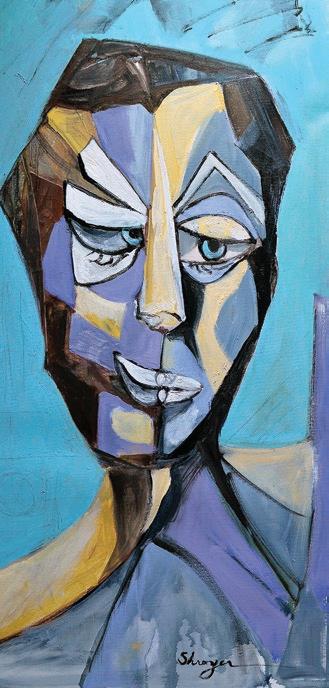


Like many people, I love a good accessory. I’m not really one to follow the crowd when it comes to clothes, but even though I tend toward the classics (black, denim, and more black), I still like one part of my outfit to make some sort of modern statement—usually an accessory. In my book, you can’t beat jewelry. Compare me (please!) with that perennial style icon Audrey Hepburn in Breakfast at Tiffany’ s, wearing an understated monochrome ensemble paired with a killer necklace or large costume earrings.
So when I recently made my way through the jewelry section of the shop at the Indian Pueblo Cultural Center in Albuquerque, New Mexico, I was mesmerized by the work of Pat Pruitt and Aaron Brokeshoulder. I started mentally flipping through my closet to remember what I have that would work with the dozen pieces each of them has on display. They have such different styles, but each in his own way takes themes or techniques from traditional jewelry design, both Native American and other, and modernizes them.

The gift shop’s manager, Ira Wilson—guitarist and lead vocalist for Albuquerque’s award-winning rock band Red Earth for more than a decade—likens Pruitt and Brokeshoulder to groundbreaking classic-rock guitarists such as Eddie Van Halen. “Those guitarists started with a Fender or a Les Paul, and see how innovative they were,” says Wilson. “With Aaron and Pat, the basics are the same, but they’re finding a way to express themselves that’s uniquely them.”
Of the two, Pruitt has the rock-star personality, and not just because of his hot-rod hobby. He started learning the silversmithing trade 20 years ago under traditional jewelers on the Laguna reservation in Paguate, New Mexico, an hour west of Albuquerque, but for the past 15 years he has made body-piercing jewelry of all shapes and sizes. He works in stainless steel, so when he began his own jewelry line (because he couldn’t find a whole lot of what he calls “cool guy stuff” out there), he stayed with that material.
Pruitt is one of the few fine jewelers to work in stainless steel exclusively. And he does it well: He was presented with the national Couture Jewelry Award in 2007 in the alternative metals category. His stuff is undoubtedly cool. I love a great cuff bracelet, so I was really attracted to the large ones on display at the Cultural Center, one with a timing belt along the top, another with stingray skin. Pruitt’s materials give the cuff shape a whole new modern edge.
“I am always looking for work that pushes the envelope. I loved Pat’s work immediately because his quality of workmanship was superb, because it is based on the traditional but goes to the extreme,” says Victoria Price, owner
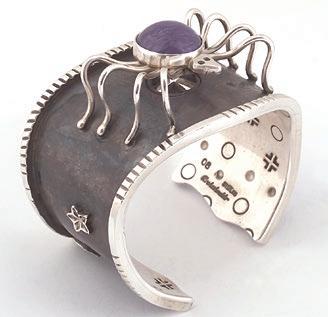




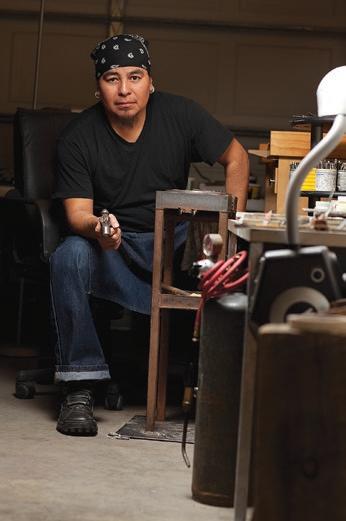
of Victoria Price Art & Design in Santa Fe and daughter of film legend and noted art collector Vincent Price. Her gallery showcases contemporary home decor, art, and jewelry and has featured Pruitt’s work for five years.
“He’s part of a new generation of artists whose work will not just be associated with being Native American or from the Southwest,” she continues, “but will be seen as having national and even international appeal—even as their heritage makes their work more compelling to many.”
Pruitt also makes thinner cuffs inlaid with copper, silver, and/or 24kt gold, and here’s where you’ll notice some of the Native influence in his work. He says I hit the nail on the head when I tell him I see rivers and mountains represented in the thin undulating lines. Often, though, he bucks conventional
Ira Wilson likens Pruitt and Brokeshoulder to groundbreaking classic-rock guitarists

design in favor of what he calls “badassedness.” Says Pruitt, “I take a different approach to my work because with stainless steel there is no tradition.”
Aaron Brokeshoulder, on the other hand, creates designs very much rooted in tradition. I’m drawn instantly to a polished sterlingsilver cuff that has rectangular coral inlays along the length, a center medallion of a raised coral, and Native symbols stamped into the inner and outer surfaces of the bracelet.
The symbolic storytelling is integral to Brokeshoulder’s work—and fits the jeweler, whose personality seems more like a roadie, or a lyricist, if his friend Pruitt is lead guitar. One bracelet tells of dancers asking a turtle for the blessing of rain. Another depicts two spiders meeting for mating. “I heard stories from my great-grandpa before he passed away, and I incorporate that stuff into my jewelry,” says Brokeshoulder, who works in his garage studio in Albuquerque. He learned smithing from his father at his Santo Domingo Pueblo home. Working his way up until he began designing on his own, Brokeshoulder has now won many artmarket awards—and a national following.
“Aaron’s jewelry is a combination of a continuing approach to tradition that doesn’t necessarily stay in the box,” says IPCC shop manager Wilson. “He likes to hang on the edge.” And that’s exactly where the next cuff I see goes. Also in a traditional shape, this one has a dark, pebbled surface: oxidized silver. It’s a relatively new technique for him, one that resembles sand-casting. Brokeshoulder retains the stamped symbols on the inside of this piece, but the outside has three raised lines— rivers—and four raised dots, which stand for the four directions (north, south, east, and west, traditional Native symbolism).
Both Brokeshoulder and Pruitt are hanging on so many edges in their work—in technique, design, and material. I can’t wait to see their next breakthroughs, but for now I just like dreaming about which one would look best out of the glass cabinet and around my wrist. R
From the Spring/Summer 2010 issue
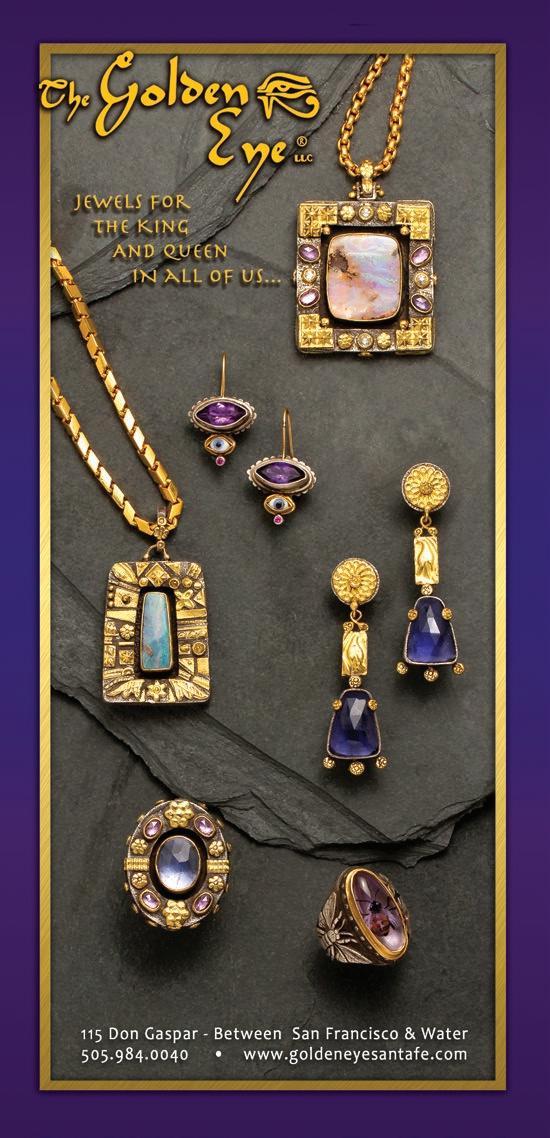
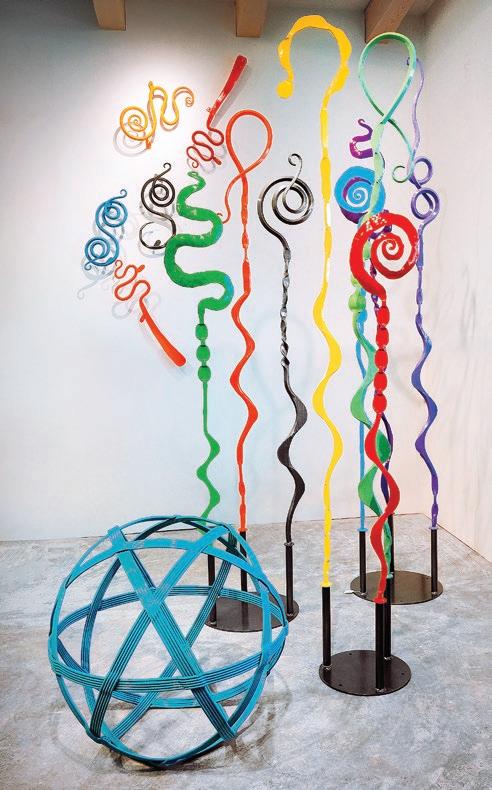

It was the discovery of an old, abandoned blacksmith’s forge in a school cupboard in 7th grade that led to Christopher Thomson’s career as a master blacksmith and artist. “I was drawn to it immediately,” he recalls, “and that feeling has only grown stronger and more intense over the years.” He now has a 6,000-square-foot studio at the base of Rowe Mesa, and his award-winning, hand-forged pieces, both practical and decorative, have been featured in galleries from New York to Los Angeles.
Among his most popular pieces are his series of brightly colored iron sculptures, forged and hammered into undulating spirals and waves and available in sizes ranging from three to nine feet high. Their colors were the inspiration of Thomson’s wife and business partner, Susan Livermore, also an artist. “Painting steel in vibrant colors had never occurred to me,” he admits, “but they really bring the sculptures to life.” Powder-coated, they can be displayed outside or inside, and some can even be hung on the wall. Whatever their setting, these ironworks embody new growth, upward movement, and an invigorated sense of momentum for our collective spirit.
Thomson’s works are also designed to be touched. “I don’t make pieces for people to just stand and contemplate from a distance,” he says. “I want them to experience the same kind of hand/eye connection that goes into the formation of everything I make. Creating things that people touch every day, from sculptures to fireside tools, communicates some of the magic I feel when making them.” Owen Contemporary now represents Christopher Thomson’s sculpture.
Turquoise Chinlone, Single Blooms and Single Musings, powder-coated forged steel sculpture
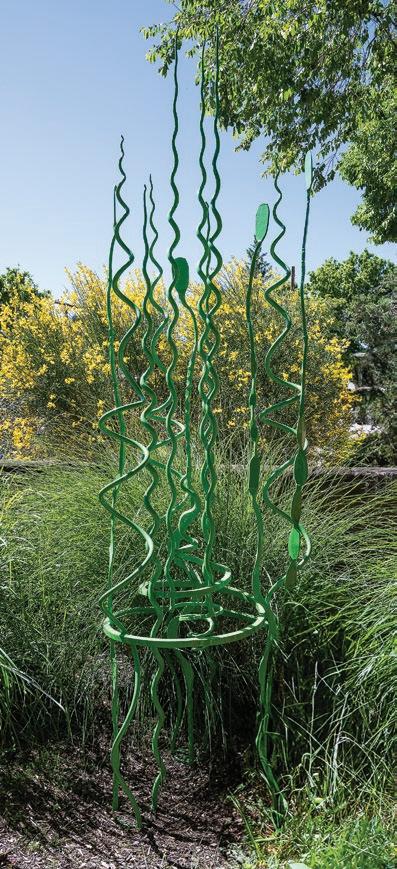








Master of multimedia, he invites all our senses to the party
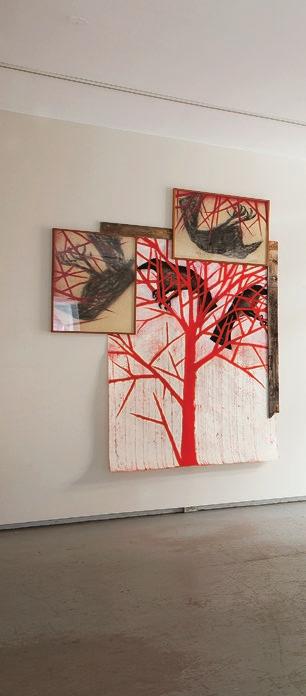
On his website, Terry Allen calls himself an artist/ songwriter, but the truth is much more complex than that. As he puts it in his soft West Texas drawl, we are beings of at least five senses: “You don’t wake up one morning and say, ‘I’m just gonna hear today.’”
Allen’s art engages not only all of our senses, but our intelligence too. He is a writer, musician, draftsman, sculptor, and videographer, and at his foundation he is a profoundly conceptual artist. He doesn’t make visual art that is set to his music, for example, so much as he serves as a multi-talented (and many-tentacled) stage director.

A performance of his most recent work, SongStories (From the Bottom to the Top to the Bottom of the World, etc.), was conducted this summer in an eight-story tower at the Oliver Ranch, 100 acres of sculpture in the heart of Sonoma County in Northern California. The piece serves as a model that typifies work by Allen—if indeed there is anything typical about him. The location for SongStories, Ann Hamilton’s The Tower, is a site-specific acoustic environment based on the discovery in Europe of an ancient cattle well with one set of stairs for the bovines to go down and drink, and another for them to ascend into their pastureland. Hamilton’s concrete structure is open at the top, while
a pool of water reflects the sky at the bottom. Audience and performers occupy some 125 seats up and down the double-helix staircases.
Allen composed the music, while the dramatic piece was written with his wife, actress Jo Harvey Allen (probably best known for playing the sex therapist in the 1991 hit Fried Green Tomatoes). She recounted stories from the protagonist’s life while Allen and his ensemble of musicians played at various levels of the tower. (The sound was managed—expertly—by one of Lady Gaga’s technicians.) The performance was followed by a concert on a regular stage outside the tower Allen recalls that it was odd to make the
transformation from hearing the music vertically to the more horizontal range diffused from onstage.
Usually, “it’s a living hell when we collaborate,” Allen says of working with his wife. “But this was so smooth; really it was an editing process,” where each wrote separately and then came together to join the parts. The smoothness may be the result of the couple having known one another since they were 11; they grew up together in Lubbock, Texas, and celebrated their 49th wedding anniversary this year— though neither looks old enough.
Probably the tie that binds them most, aside from their two sons Bukka and Bale, is that they “know the same stories.” Each was born with that spellbinding storyteller gene; their love for the craft and unique take on how to narrate a vision is what keeps them vibrant as collaborators, spouses, and artists with their own careers in what Allen calls “a funny balancing act.” (He claims that having a wife who is an actress is a bonus—she works for him cheap.)
Music and performance are natural mediums for Allen. His mother was a musician; his father, a retired baseball player for the St. Louis Browns, took over an empty Foursquare Baptist church where he held dances with live bands as well as popular wrestling and boxing matches. This was in the late 1940s and ’50s, the era of segregation. On Friday nights black musicians played, so Allen grew up with the likes of T-Bone Walker, countered by Saturday nights’ all-white stars, including Hank Williams.
He hated high school, where he got into trouble for drawing and writing songs— “the two things I wound up doing” as an adult. A teacher told him about Chouinard Art Institute (now the California Institute of the Arts, or Cal Arts) in Los Angeles, and within a half an hour of marrying Jo Harvey, the two had crossed the Texas state line, headed west. In L.A. they hosted Rawhide and Roses on one of


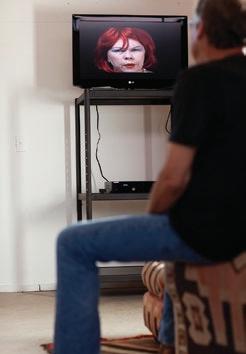
the country’s first independent FM radio stations, KPPC out of Pasadena.
“Jo Harvey told lies about everything she could think of,” Allen says of the show, which ran on Sunday mornings, followed by a blues show. Everyone stuck around during an hour break for the news before Firesign Theater, with a motley crew from the morning shows, offered its unique brand of live radio hijinks for the rest of the afternoon. It was a wild and woolly time of “anything goes” in the ’60s, and the Allens became known as part of a rich consortium of creativity. Nothing could hold them back after that kind of notoriety, and Allen’s art in all its forms reflects his original, independent thinking.
Ever since he landed upon an anthology of writing and drawings by the French playwright, poet, actor, and theater director Antonin Artaud at City Lights Books in San Francisco decades ago, and basically begged it from Lawrence Ferlinghetti— “Just take the damned thing,” Ferlinghetti growled at the young Allen—Artaud has been Allen’s great obsession. In his essay “Theater of Memory” (Dugout, 2005), David Byrne of the Talking Heads notes that “Allen spews out one of these epic works every decade or so . . . .”
For the last several years, his epic piece has taken shape as the installation work The Ghost Ship Rodez , about Artaud’s 1937 sea journey from Dublin to a mental instititution in Rodez, France. An opium addict, Artaud was in withdrawal and hallucinating, and was straitjacketed and chained to his cot below decks for the 17-day journey. Ghost Ship is a phenomenal work of art, consisting of videoed performances by Jo Harvey, plus installation, drawing, painting, music, and theater—particularly theater as Allen realizes it through Artaud’s writing. Most important, Ghost Ship has everything that makes for a great story: appallingly sinister humor, tragic lost beauty, an unrelenting search for redemption, the viciousness of corporeality, and more than a trace of tenderness. R
From the Fall 2011/Winter 2012 issue
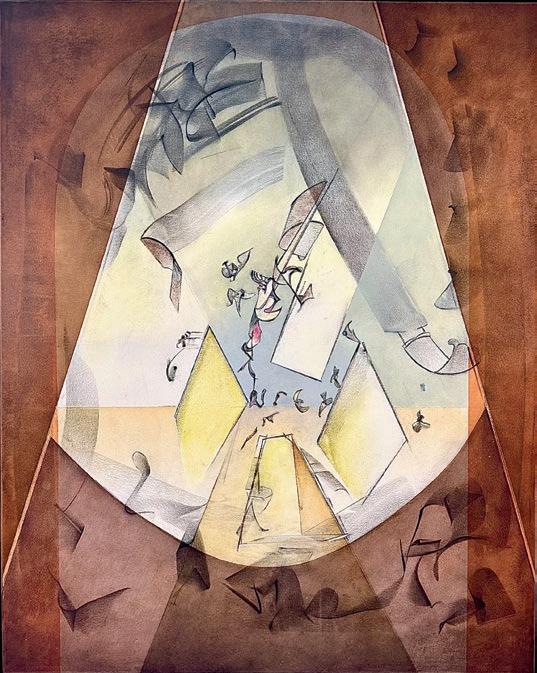




BY
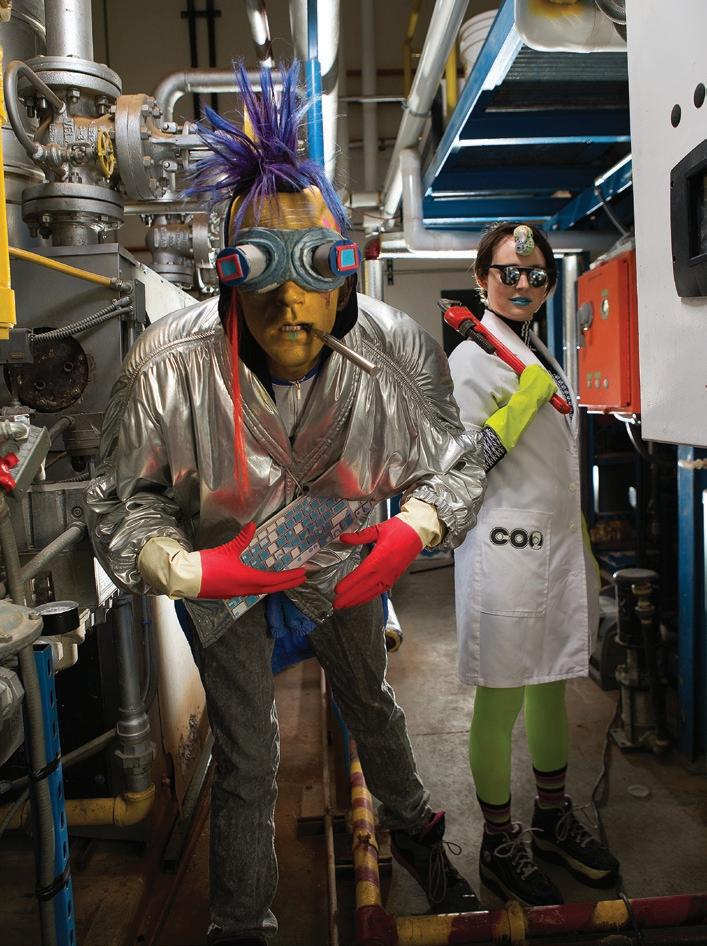
A new Santa Fe art installation explores a fantastical family narrative

You enter a large building formerly known as the Silva Lanes bowling alley, buy your ticket at the counter, and proceed into what’s apparently someone’s front yard. It’s dark as night, stars shine above, and light radiates from the porch and windows of an old twostory Victorian. It’s not your neighbor’s place, not your childhood home stirring up memories, but the keystone of The House of Eternal Return, a permanent, interactive installation by the collective art group Meow Wolf, set to launch this fall. Situated within the Meow Wolf Art Complex on Rufina Court in the geographical heart of Santa Fe, the installation unfolds over 20,000 square feet and two stories. Its overarching narrative is of a house divided, not in the traditional sense, but through
space and time, as if it’s been drawn into a black hole only to emerge reassembled in wildly fantastic ways on the other side.
Visitors are presented with the story of the imaginary Sig family—a mom and dad, brother and sister twins, an uncle, and grandfather. Each possesses a unique character, but also abilities beyond natural that when exercised precipitate a fracture in space and time. This event occurs within their home, causing the family’s memories, secrets, and fantasies to expand and contract in unusual ways. An uncle’s dream of success, for instance, takes the form of a travel agency, and a family remembrance of a trip becomes a cave of luminous lights and interactive sounds. A place of touch-
sensitive stalagmites and stalactites (the father’s retro-game nostalgia) turns into a light-filled arcade and pinball experience that immerses you in the game.

Visitors can discover the family’s story through audio, video, and tangible objects, like a cell phone. The group even outsourced the creation of an app that allows spectators to snap photographs at various points and pull up further information. Yet the house takes up only about a tenth of the installation. One can explore it and then by various egresses, such as through the refrigerator or backdoor, discover the remaining spaces. Some of these were conceived by Meow Wolf members, while others are the result of applications from artists across the nation.



This collaborative approach has defined the Meow Wolf pack since a core group of members established it in 2007. They’re best known for The Due Return, an immersive installation in the form of a 73 ½-foot, two-story ship that was moored outside the Center for Contemporary Arts long enough to draw 100,000 visitors in 2011.
The House of Eternal Return is Meow Wolf’s most comprehensive project yet, exemplifying the group’s mission to build multifaceted projects that provide a full sensory experience. “It’s an environment that you walk into, that surrounds you,” says Emily Montoya, a core member and the group’s graphic designer. “It’s not ‘don’t touch this, don’t open that.’ It invites you to be a character within it at some level, to share its reality and to make it your own.”
Making it your own is what the story’s about. Although the fictional family members can all interact with the element of time, it was the twin brother Lex—aided by his uncle—who conducted an experiment gone wrong, putting the home at the focal point of a rupture in physics. Yet the real gist of the story is a reward to spectators who search for it, uncovering the secrets of the narrative and how family dynamics are written into time and space.
More than 85 artists and 180 volunteers have contributed to Eternal Return in a space big enough for nine Due Returns
Since January 2015, Meow Wolf has assembled various teams: technology, performance, narrative, graphic design, aesthetic direction, administration, volunteer coordination, and more, each with a project leader, several artists, and a greater number of long- and short-term volunteers. “Many of our new artists have expressed that they’re taking this opportunity to build a piece they’ve been dreaming about making for years but have never had a venue for,” says Caity Kennedy, project coordinator.
Local artist Erika Wanenmacher has been involved with Meow Wolf since its inception. She champions the collective’s niche in the city’s art scene—its vitality, diversity of shows, and general “artistshelping-artists” mentality. Her project is





a dome of meticulously crafted iridescent animal eyes located deep within Eternal Return, and it includes the ever-watching eyes of the family pet and other significant animals.
Others involved in forging this world include volunteer painters, filmmakers, and actors, as well as those working in welding, lighting, and website building. Following a town-hall-style public meeting at the Santa Fe University of Art and Design, Meow Wolf also coordinated youth involvement. Projects headed up by youth include posters, drawings, notebooks, and other items belonging to the twins in the narrative. And two kids were cast to play the twins in various films, photographs, and audio recordings throughout the space.
Zubin, age ten (like the twins), built a Minecraft version of the entire installation, and Liam, 11, wrote and illustrated the notebooks of Lex. For Liam, Meow Wolf changes the face of
what art can be. He recalls the impact of seeing The Due Return “It’s cool that art can be a world,” he says, “a place you can walk into.”

Resources, both financial and technical, helped turn Meow Wolf’s dreams of an art center into reality. In early 2015, CEOs Sean Di Ianni and Vince Kadlubek made a winning pitch to Albuquerque-based Creative Startups, followed by the purchase of the Silva Lanes building and the public support of Santa Fe local George R. R. Martin, author of the popular Game of Thrones book series. Along with a Kickstarter campaign and private donations, the Meow Wolf Art Complex took form. In addition to the installation space, it will include 19 artist studios, a learning center, a gift shop, and a smaller gallery with rotating shows. The group’s hope is that the complex will receive 100,000 visitors a year for Eternal Return alone, a figure Kadlubek says is just slightly less than the annual attendance
of the Santa Fe Children’s Museum and about a third of Albuquerque’s Explora museum, both of which were chosen for their interactive appeal. The number doesn’t include those who visit the gallery or performance center. There will also be students from ArtSmart and other programs held at the Loughridge Learning Center, which at night will double as a venue for creative classes aimed at adults. With its worlds within worlds, Meow Wolf’s expanding community of artists has created an exhibition space unlike any other. The House of Eternal Return begs visitors not just to view but to also explore the world before them and become part of its story. It also invites them to join a created world and its fictional family, but with its creators, designers, even fellow visitors, forming a makeshift family across the boundaries of space and time. R


Fredrick Prescott’s larger-than-life, brightly colored, solid-steel sculptures are truly one of a kind. Engineered to move in the wind or be activated by hand, they combine reality with fantasy in an ever-evolving variety of magical images. There are 30-foot-high giraffes alongside pink flamingos, elephants, seahorses, dinosaurs, dragons, and many other real and imaginary creatures.
Everything is created in a 30,000-square-feet studio in Santa Fe. The process is inevitably complex, starting with a drawing transferred to a computer and then on to a machine that cuts sections in steel. The pieces are then powder coated with a spray gun, sandblasted, and then fired in a massive oven that heats the environmentally friendly powder paint up to 500 degrees, melting it into a glossy finish. A final
clear coat protects the work from the weather if it is to be displayed outdoors.
The enormous works are transported all over the country, strapped down on a huge trailer hooked onto a big truck, to be exhibited in museums, public parks, schools, galleries, and private homes. Prescott is also open to commissions and over the years has completed many, including some for celebrities such as Michael Jordan and Steven Spielberg.
The gallery on Agua Fria Street is currently showing a retrospective, with photographs and early works that demonstrate Prescott’s artistic evolution over the years. One may wonder: After a career that spans more than 50 years, has he ever run out of ideas? “Never,” he says. “The problem is too many ideas and not enough time.”




Rose Masterpol knew when she was just 15 that she would become a painter. Nothing else made sense to her.
The contemporary abstract artist, who studied at the California Institute of the Arts and was a graphic designer for 30 years, paints her “Geometrix” series in a style that draws on the formal language and optimistic spirit of 20th-century Modernism. Working in her Santa Fe studio, she creates vivid, colorsaturated forms that connect, overlap, and intertwine as they evolve in the viewer’s eye, their bold lines and energy transforming into dynamic geometric and architectural forms.
“I want to help the world feel something when they look at my art,” Masterpol says. “It could be a sense of happiness or lightness, or simply a good feeling. Not every piece of art will do this, but that is my sole wish and why I paint.”
Masterpol’s art can been seen online at masterpol.com and at Nuart Gallery in Santa Fe, Artful Sol in Vail, Merritt in Baltimore, Pryor Fine Art in Atlanta, and Cheryl Hazan in New York City.
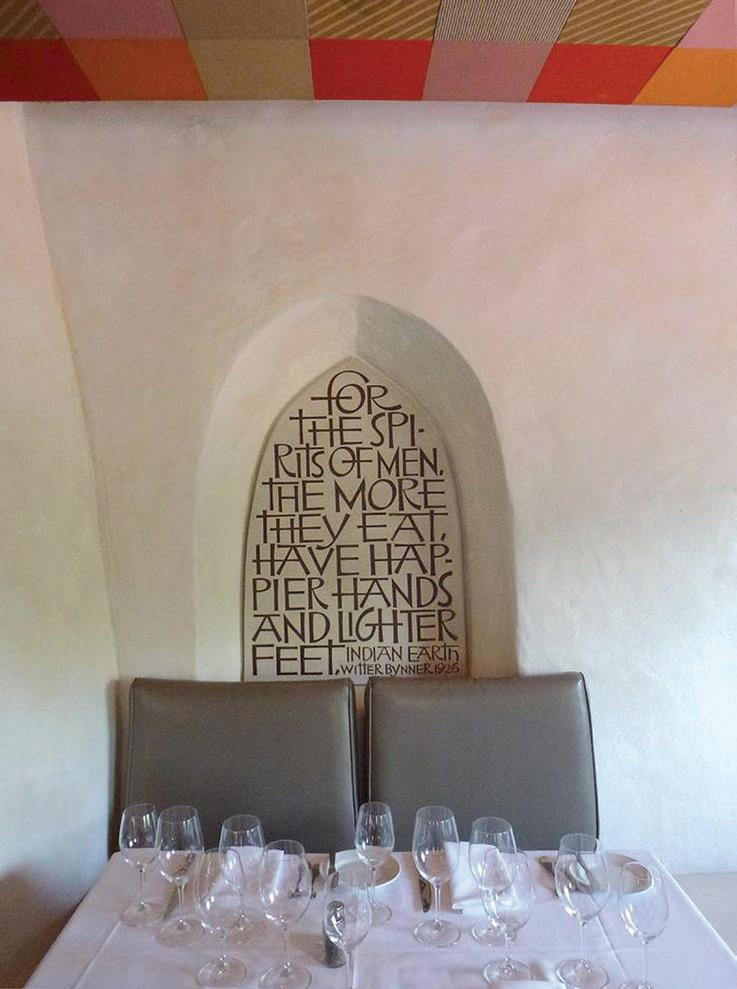
Renowned designer Alexander “Sandro” Hayden Girard was responsible for some of the Mid-Century Modern era’s most innovative designs in furniture, housewares, and interiors. Much of his work he produced from his studio in Santa Fe, where he moved with his wife and children in 1953. In the years that followed, Girard made an indelible mark on America’s and New Mexico’s artistic and architectural landscape, leaving a legacy that continues to inspire and excite design enthusiasts and visitors alike.
Girard was born in New York City in 1907 and raised in Florence, Italy. His Italian father—a master woodworker and an arts and antiquities dealer—was likely a large source of his early inspiration. Girard pursued his formal education at the Royal School of Architecture in Rome and at New York University.
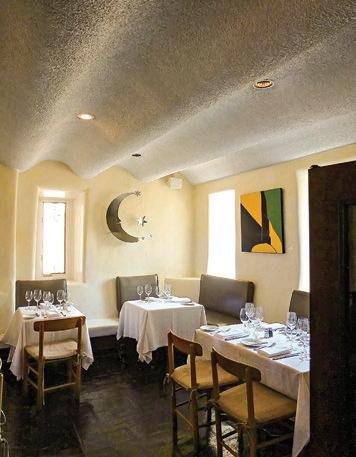
While working in New York in the 1930s, the soft-spoken and serious Girard met and married his wife, Susan Needham March. They were adoring partners, traveling the globe and amassing a folk art collection that would become the largest in the world. Along the way, they also befriended some of the era’s greatest artists and architects, including Eero Saarinen, Charles and Ray Eames, and fellow New Mexico transplant Georgia O’Keeffe.
In his early career, Girard had offices in Florence, New York City, and Detroit and Grosse Point, Michigan. He designed radio bodies and a factory for Detrola Radio, facilities for Ford and Lincoln car companies, furniture for Knoll, and several residences as well. In 1947, in a precursor to several later collaborations of the two masters, Girard joined Saarinen’s team for its award-winning design submission to the St. Louis Gateway competition—the St. Louis Gateway Arch.
Girard’s life changed in 1952 when his friend of nearly 15 years, Charles Eames, offered him the position of Director of the Fabric Division at Herman Miller. It was at this same time—fueled by a passion for folk culture, a desire to be in a suburban environment, and a need to be accessible to his bi-coastal clientele—that Girard moved his family into a nearly 200-year-old hacienda in Santa Fe.
From his office across the dirt road from their home, Girard designed lines for Herman Miller, including furnishings, textiles, and wall coverings for the interiors of Mid-Century Modernist master architects like George Nelson, Saarinen, and Eames, as well as a diverse array of projects that ranged from the interior architecture of star-quality restaurants in New York to colorful,
worldly interiors to complement the stark Modernism of Saarinen. Girard also designed functional items including a tableware line for Georg Jensen and both the interiors of and products for the Herman Miller Textiles and Objects showroom and Herman Miller showrooms in Grand Rapids and San Francisco.
Although Girard would work for Herman Miller until 1975, he accepted many other commissions from clients throughout the country, including several right here in New Mexico. In 1966, he turned his attention to a complete rebranding of Braniff International Airways, not only creating new and coordinating color schemes for airplane and ground equipment, but also revamping nearly 17,000 company items—everything from the buttons on the captains’ uniforms to matchbooks, signage, and furniture. He even redesigned the typeface for all of Braniff’s printed materials.
Ten years after moving to Santa Fe, restaurateur Bill Hooten approached Girard to renovate the main house of the McComb residence on Canyon Road into a restaurant. In the 100 years since it had been built, the residence had grown from a single room into a sprawling complex of buildings, inspiring the apt naming of the new restaurant—the Compound. Leaving the blended Spanish Pueblo Revival and Territorial architecture of the exterior and the walled courtyards and gardens alone, Girard added only a simple front entrance portal . On the interior, he dismantled the maze of tiny rooms, opening up the space to create an axial arrangement of dining rooms along one side of an open hallway and a bar and exterior patio along the other. He replaced a load-bearing wall with a tree trunk, angled the bancos to create personal dining niches, and sank the bar—a reference to the conversation pit he invented and installed in his own home nearly ten years before.
Girard was playful in the way he treated the whitewashed interior. For decoration, a patchwork of Mexican and Navajo weavings “tiled” the flat ceilings of one, while a ten-foot-long painted snake undulated to dramatic effect along another. Three-dimensional murals and inlaid wood doors were added throughout, and he decorated nichos and stands with pieces from his own folk art collection. Girard designed the table settings as well, placing white
china against crisp ecru tablecloths, finishing the bancos in faux leather, and designing a curvilinear white oak chair for additional seating. And again, he designed a unique typeface for the menus and signs. When completed, Architectural Forum deemed the Compound “The Town’s Newest and Best Restaurant.” Today, it is the last of the Girard-designed restaurants in operation, and nearly 50 years after its opening still maintains a reputation for exceptional dining and service.
Another of Girard’s renowned New Mexico projects is his mosaic/mural for the sanctuary of the First Unitarian Church of Albuquerque. The sanctuary was designed in 1964 by Harvey Hoshouer, an MIT graduate, former Girard employee, and collaborator with such legendary architects as Ludwig Mies van der Rohe, Harry Weese, and I.M. Pei. Hoshouer hired Girard to design an altarpiece for this starkly modern space, a 40' x 8' mosaic comprising 5,000 wood tiles harvested from abandoned barns purchased from ranchers in the Jemez Mountains and spotted by Girard’s son Marshall at horseback riding camp. Father and son hand-disassembled each barn, starting with the roof, stacking each board with cardboard between, and loading as many trailers as it took to get the barn down to Santa Fe. The wood was cut into three-inch squares by a church member and installed into an arrangement of colors, shades, and symbols by Girard’s team. The colors are original to their reclaimed condition, and include tar-scarred roof sheathing and stained and painted details. Completed in 1965, the mural depicts 22 symbols representing the wisdom of the world’s religions.
The First Unitarian mural was not Girard’s first or last. He also designed the 180-foot-long, three-dimensional Reflections of an Era mural for Saarinen’s John Deere headquarters in Moline, Illinois. Girard and five other team members scoured antique shops throughout the United States to collect the mural’s more than 3,000 three-dimnensional pieces of company memorabilia dating as far back as 1860. Its background, though mostly obscured, is also reclaimed wood.
Girard’s design for the Multiple Visions: A Common Bond exhibit at the Museum of International Folk Art in Santa Fe showcases nearly 10,000 of his and Susan’s folk art pieces. The exhibit, located in an addition to the museum’s original John Gaw Meem structure designed by Hoshouer, first opened in 1982 and captivates with unique displays that engage not only the art itself, but our response to it, asking us to confront our intellectual and emotional mindsets by illuminating ideas of sameness, difference, and perspective. In placing the collection’s multitude of objects into unexpected arrangements, or locating pieces in places we may not have predicted and not explaining any of it, Girard seems to suggest that color, pattern, and language—and therefore ideas—are perhaps more fluid than we may have believed. As if illustrating this, the entrance to the exhibit cites an old Italian proverb often cited by Girard: “Tutto il mondo e paese” or “The whole world is one hometown.”


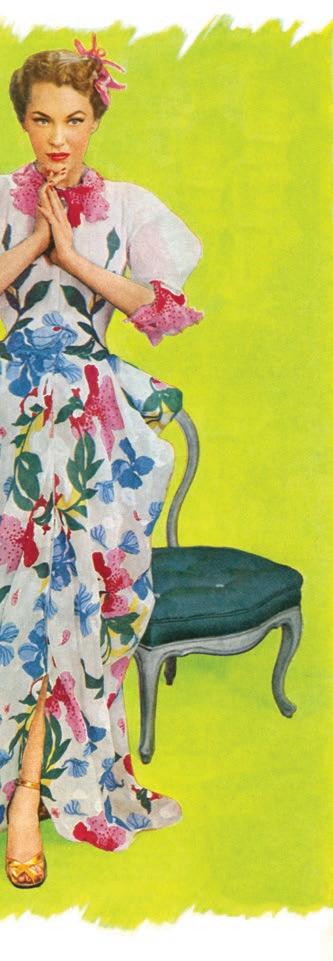



After his death in 1993, Susan Girard unsuccessfully attempted to find a writer to prepare a retrospective on her husband’s work. When she passed on several years later, their children searched for someone to commit themselves to their father’s legacy and tell his story. They eventually found Todd Oldham, a renowned designer in his own right, whose family homestead in Abiquiu gave him an understanding of the New Mexican culture in which Girard wished to immerse himself and for which he “left civilization” in order to do so. Oldham had previously produced design compendiums of Charley Harper and Joan Jett; had collaborated with legends Michael Graves, Camille Paglia, Amy Sedaris, and John Waters; and produced design studies on Mid-Century Modern aesthetics, embroidery, collage, and fabric printing and dyes. With help from Girard’s children and grandchildren, in 2011 Oldham and writer Keira Coffee produced an exceptional monograph.
In the 664-page tome, titled Alexander Girard , Coffee states, “In his lifetime Girard created not just a new style but a style of looking at things. He raised questions about how we make things, how we notice them, whether things speak to us or we speak to them. From the beginning of his career, Girard had an interest in the concord among lines, objects, colors. He disregarded trends and went to work showing others his discoveries.”
Throughout his career, Girard created thousands of simple, elegant, and colorful designs for the humanist MidCentury Modern aesthetic. He was more concerned with eliciting a feeling for the space than in intellectualizing the design. One newspaper of the time noted, “If Girard did it, it’s not just another anything.” Perhaps because of this, unlike much of the design of the period, Girard’s work is still venerated: his fonts and typographies have been reinvigorated by House Industries in the form of blocks, games, puzzles, and nativity sets; Elektra introduced a bicycle with Girard details; and MaXimo Design, Urban Outfitters, and Anna Sui have Girard details in their collections.
Although he was an internationally renowned designer, New Mexico was Girard’s spiritual as well as literal home. Through their use of reclaimed barn wood from the Jemez Mountains, the First Unitarian Church mural in Albuquerque, the patio doors of the Compound restaurant in Santa Fe, and the Girard exhibition space at the Museum of International Folk Art all illustrate the connectedness Girard felt to New Mexico’s landscape and history. That reflection of age-old traditions reinterpreted in a modern way remains one of the most timeless and engaging aspects of his work. R
From the Fall 2012 / Winter 2013 issue









An artist lives and works in his great-grandfather’s studio

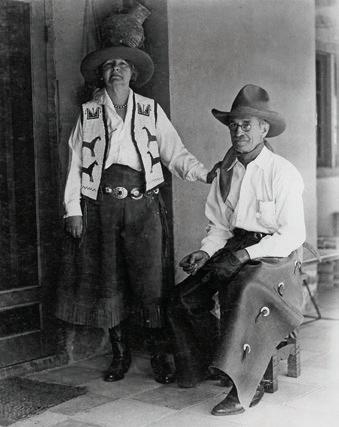
There’s an empty nicho oddly situated near the floor in Andy Mauldin’s kitchen, in the adobe structure his great-grandfather built in 1919 on the street called Camino del Monte Sol, which runs between Canyon Road and Old Santa Fe Trail in Santa Fe. Mauldin thinks the odd little space may have been where the phone company installed a wire box, way back in the day, for phone service to what was the property’s art studio. While Mauldin doesn’t know for certain that his great-grandfather—the renowned painter, architect, and furniture designer William Penhallow Henderson—actually had a phone, the sight of the nicho prompts an unexpected remembrance: “My great-grandmother stopped them from putting up signs out there [that would name Monte Sol] Telephone Road,” Mauldin says, gesturing in the direction of the narrow street.
The Hendersons moved from Chicago to Santa Fe in 1916 because Alice Corbin Henderson, a poet and co-founder of Poetry magazine, was suffering from tuberculosis and hoped for healing in New Mexico’s clear, dry air. She spent five years at Sunmount Sanitorium—a tent-city tuberculosis treatment center at the end of Monte Sol whose existence meant telephone service would soon snake its way along the eastside lanes. William and their daughter, “Little Alice,” lived in a small rented house on Monte Sol while William built himself a studio up the street. Alice joined them after recovering her health. The studio was William’s until his 1943 death; in the 1950s, Little Alice converted it to a living space. Since 1971, Andy Mauldin, now 59, has called it home.

Above: The fireplace nook in Mauldin’s studio/living room. William Penhallow Henderson’s furniture craftsmen built the wooden window shutters, featuring Henderson’s carved-rose motif, and the hand-adzed cabinet doors.
Right: Mauldin gazes out the studio windows that provided north light for his great-grandfather’s easels in the early 20th century, just as they do now for Mauldin’s artwork.
Far right: In Mauldin’s bedroom sits a cabinet designed by Henderson and built in the early 1900s. The room was once Henderson’s furniture-making shop. An oil painting by David Barbero

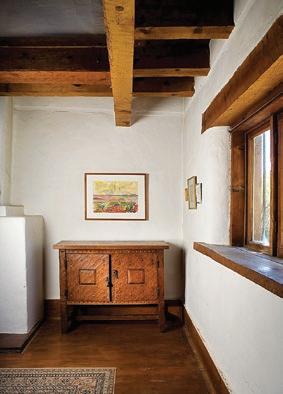
It’s a good fit, since the descendant of the Works Progress Administration muralist is a painter too.
Mauldin explains, touring the kitchen, “This was Henderson’s drafting room. There would have been a secretary here by the door to greet you and drafting tables under the windows.” The room, with its low ceiling, blue painted cabinets, and row of south-facing windows filled with geranium pots, is like a postcard for old Santa Fe. And Mauldin, too, seems to have stepped into modern life from a slower past. His speech is thoughtful, his movements unhurried. He has no computer, says he has no interest in TV.
“I listen to the radio a lot,” says Mauldin. “It’s not my intention to live as an anachronistic anomaly; it just kind of works out that way.”
Surrounded by rustic, hand-carved wooden furniture of his great-grandfather’s design—Mauldin’s bedroom was Henderson’s furn iture studio— the artist paints in the large, high-ceilinged room where Henderson’s own easels once stood. Outside the kitchen windows, lush grass and flourishing roses speak to Mauldin’s other pas -

sion: gardening that resembles an English-cottage style.
Mauldin’s artistic leanings literally come with the territory—not only were William and Alice Henderson an influential part of Santa Fe’s early art scene, but also another of Mauldin’s great-grandmothers, Mabel Dodge Luhan, was a social magnet and patron of artists and writers in Taos.
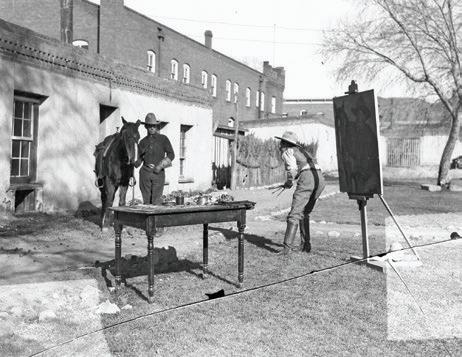
The artistic links don’t stop there: In 1922, Little Alice, at 15, married John Evans, Mabel’s 20-year-old son. Natalie, one of their daughters, was Mauldin’s mother; his father was New Mexico native Bill Mauldin, a two-time Pulitzer Prize–winning syndicated political cartoonist known for drawing Willie and Joe , a pair of battle-weary soldiers whose wryly irreverent perspective gave Americans a glimpse of the realities of World War II.
In the early 1920s, Henderson built a rambling single-story adobe home for himself and Alice on land adjacent to his studio. In 1925, along with John Evans and Edwin Brooks, a builder, he formed the Pueblo-Spanish Building Company, whose office was Henderson’s drafting room (now the kitchen). The company helped popularize Pueblo Revival architecture, which formed the foundation for Santa Fe style. Among its signature projects: the Garcia Street compound owned by sisters Amelia Elizabeth and Martha White, now the School for Advanced Research on the Human Experience; what is now the Wheelwright Museum of the American Indian; and a renovation of historic Sena Plaza.
Meanwhile, Camino del Monte Sol was filling up with artists—including Frank Applegate and Andrew Dasburg and writer Mary Austin.

Five young avant-garde painters known as Los Cinco Pintores—Fremont Ellis, Willard Nash, Will Shuster, Jozef Bakos, and Walter Mruk—built a row of small adobe houses across the street from Henderson’s studio. When the Depression hit, the Pueblo-Spanish Building Company closed and the Hendersons sold their house and moved to Tesuque, but William held onto the studio.
Half a dozen years later, William Henderson was hired by the federal Works Progress Administration to paint six New Mexico landscape murals for the federal courthouse (next to the downtown post office), where the remarkably modern paintings can still be seen today. Getting the 8-foot-by-12-foot paintings out of the studio required some ingenuity: The artist cut a five-inch-wide slot, ten feet tall, into an outside wall of his studio, and passed the finished murals through the slot.
“He was a master colorist, really a genius,” Mauldin says of Henderson, adding that his great-grandfather was an important influence in Mauldin’s own artistic evolution. Represented for many years by the Laurel Seth Gallery before it closed in 2006, Mauldin creates watercolor

landscapes with a strong focus on color and with delicately delineated forms. “My grandmother told me my paintings really reminded her of [William’s] color concerns,” he relates. “I’m doing something similar to what he did: taking complex visual information and simplifying it so it looks realistic but it’s abstracted.”
Mauldin grew up outside New York City in the town of New City, New York, and in St. Louis. He spent three years at the Art Institute of Chicago before accepting Little Alice’s suggestion to move to Santa Fe, where as a boy he had often visited relatives. Today Mauldin’s home remains largely unrestored since he moved in. The slot door can still be seen in the studio wall. The hand-built furniture and masterfully hand-adzed cabinet doors—“Nobody does that anymore,” he says—reflect the skill of Hispano artisans who worked for his great-grandfather.
The furniture designer’s signature carvedrose motif adorns thick wooden interior window shutters. Roses also are engraved on a combination daybed and sofa, called a Taos bed, which Henderson made for the comfort of his ailing wife. In the former woodworking room, an open-beam ceiling and clerestory windows were inspired by the architecture of New Mexico’s mission churches, Mauldin believes, adding, “It’s kind of cool to think that all this furniture was made in this room.”
Whatever interior design touches have been added to the house, like the cozy nook produced by facing twin benches in front of the fireplace, Mauldin ascribes to the “really good taste” of his former wife, Barbara.
Time has made some changes as well. The house has settled and shifted over the years, leaving walls slightly tilted and some beams warped. The lived-in feeling has its charm, and the absence of updates suits Mauldin, though he did have an engineer check the curving beams recently (he pronounced the house safe). “This is just a great place to be able to do the kind of work I do, both the painting and gardening,” Henderson’s great-grandson reflects. And in that pair of passions, he’s clearly carrying on the esteemed traditions of the artists’ colony that grounds his house’s neighborhood and history. R
From the Summer 2007 issue

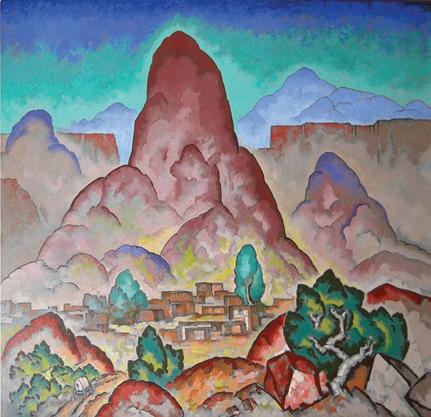




Over the last 25 years, Allan Affeldt, Tina Mion, Dan Lutzick, and their team have restored more than a dozen historic properties in the Southwest, and helped bring new prosperity and fame to their communities. Here are four of their famous projects.


LA POSADA HOTEL, WINSLOW, ARIZONA, was built for Fred Harvey and the Santa Fe Railway in 1929. It was the finest hotel on Route 66, and the favorite project of legendary designer Mary Colter. Everybody stayed here—from Howard Hughes and Dorothy Lamour to John Wayne, Albert Einstein, and the Crown Prince of Japan— just like they do today, from Elon Musk to Tom Ford. Closed for 40 years and nearly torn down, La Posada is one of the most renowned and beloved restorations in the country, with nationally famous dining in the Turquoise Room For reservations: 928.289.4366.
THE LEGAL TENDER, LAMY, NEW MEXICO, started as a general store in 1881 when the Railroad arrived in Lamy. In 1884 the store got a stone saloon with a beautiful walnut bar, and it’s been here ever since —now the oldest bar in New Mexico. The famous and infamous have met and entertained here for more than 100 years, from Robert Oppenheimer to George R.R. Martin. Join us at the Legal Tender in Lamy NM, Where the Road Ends and the West Begins — just 15 miles and a world away from Santa Fe. For reservations: 505.466.1650

THE PLAZA HOTEL, LAS VEGAS NEW, MEXICO, with its famous Victorian façade, has presided over beautiful Plaza Park in Las Vegas, NM, since 1882. All of our rooms are loving restored, with period antiques and a multi-million-dollar renovation. For 140 years the Plaza has been home away from home for everyone from Doc Holiday to Tommy Lee Jones, and has been featured in films and television series like Longmire, Easy Rider, Red Dawn, and No Country for Old Men. Join us for fabulous farm-to-table dining at Prairie Hill Café.
For reservations: 505.425.3591
THE CASTAÑEDA, LAS VEGAS, NEW MEXICO, was built in 1898 as Fred Harvey’s first trackside hotel in the Southwest, when Las Vegas, NM, was bigger than Albuquerque and richer than Santa Fe. Las Vegas, with almost 1,000 buildings on the National Register of Historic Places, is an architectural treasure trove. In 1899 Teddy Roosevelt held the first reunion of his Rough Riders at the Castañeda, but it closed in 1948 and was mostly abandoned for 70 years. Now the entire hotel has been lavishly restored, with 20 deluxe guest rooms and our wonderful Trackside dining and saloon.
For reservations: 505.425.3591



For award-winning Santa Fe artist Sandra Duran Wilson, art and science are not separate disciplines. As a child peering into her father’s microscope, she wondered about quantum physics, while her mother’s family of artists taught her to harness her imagination and push boundaries. Today, her multimedia painting, sculptures, and photographic prints illustrate her exploration of the possible.
“I always envisioned creativity as a torch that lights the way for others to see and experience art,” she says. “Risk taking, which manifests itself in my experiments combining different mediums, drives my work with depth, texture, layers—making materials into something they were never intended to be.”
Her work, influenced by scientific concepts in physics, chemistry, and biology, is also informed by her study of cognitive science. It is further influenced by a neurological condition called synesthesia, in which the senses cross their wires and produce such sensations as colors that talk, or music that appears as waves of color.
“The music I listen to—the sounds and tempo—influences how and what I paint,” she says.
Wilson’s three-dimensional sculptures fuse acrylic paint on layers of cast acrylic. The light penetrates and the images morph depending on the viewing angle. Her latest venture, digital mixed-media prints, combine her own photographs, paintings, and natural objects like branches and leaves. These on-demand digital works are available in a variety of paper, mat, and framing options.
An accomplished author of six art technique books, Wilson also teaches classes and workshops around the world, calling her travels “adventures to discover creativity, where one is open to surprises.” Her work can be found at her studio in Santa Fe and in corporate, civic, and educational institutions and private collections globally.
Connections, 6" x 24", cast acrylic and resin, 2024




Storm’s most important tools are Wonder and Possibility
As a child, award-winning painter Linda Storm played in the mud, foraged, and danced. She read myths about ancient goddesses who birthed seasons, healed diseases, and tossed magical golden apples. She laughed as she ran through spider webs sparkling with dew. She drew whenever she had supplies. Art was her favorite subject.
Storm’s stepfather, a professional artist, came into her life when she was 12 years old. They painted together often. He showed Linda’s paintings of flowers on barnwood to a gallery owner in Lancaster, NY, which led to a sold-out show. She was 14 at the time. Today, her art is in museums, galleries, and collections around the world.
Myths, nature, and music are her pillars of inspiration. Wonder and possibility radiate from her canvases. Linda mostly works with oil and acrylic paints, although in June 2023, during an art residency in Italy, she created a paper installation titled “A New Vision for The Same Place.” She also creates custom art, having completed indoor wall murals, stage projections, and album covers.
“We live in a magical world, and I live to depict it,” she says. “Each of us experiences life uniquely, but we all want to feel connected and nourished in that heartfelt place, often hidden behind hopelessness. I’ve seen people moved to tears and smiling with joy while experiencing my paintings—art is a language beyond words.”
Read Linda’s full story on her website. Collectors can see her work in person at The StormHold, her studio/gallery, in an old adobe home in Santa Fe, New Mexico, by appointment.

Clockwise from left: She Harbors the Sea, 60” x 48” Dragon Cloud, 24” x 30”
Linda Storm with She Makes Land
Opposite: Dragonfly Between, 60” x 48”


Emerging artist Rocko Rupert is rapidly gaining attention for his vibrant and expressive paintings of the American Southwest, works that incorporate elements of realism, psychedelia, and urban American street art.
After graduating from the School of Visual Arts in New York, he worked as a framer at a Japanese woodshop in Brooklyn, and then spent more than a decade as an illustrator, woodworker, and muralist. He also traveled extensively throughout Mexico, Europe, and the Southwest before moving to Santa Fe in 2022.
In addition to traditional brushwork, he also uses spray paint and airbrush, which, he says, allow for the spontaneity required to capture the fleeting light, bold forms, and beauty of the desert landscape. “My art reflects the long-standing tradition of Southwestern imagery, as seen through the lens of contemporary surrealism,” he says. “I’m not painting to illustrate an idealized version of the West, but a compilation of my personal experiences here.”
Rocko Rupert | Santa Fe, NM






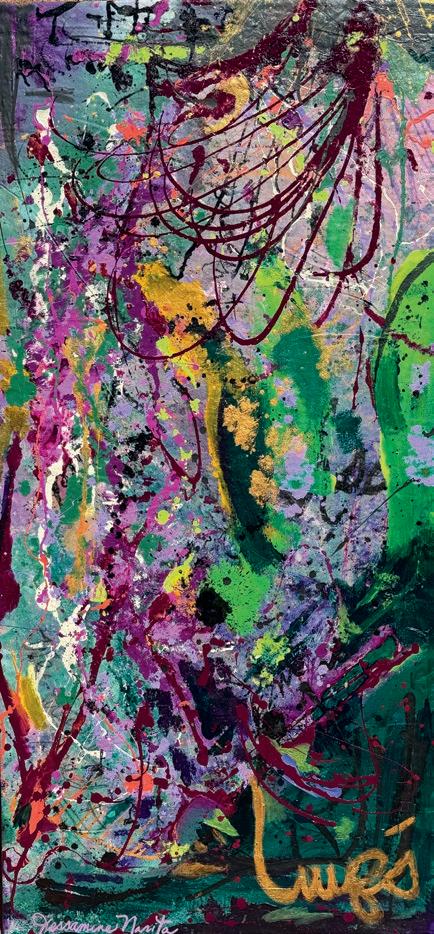




BY RENA DISTASIO | PHOTOS BY KATE RUSSELL
In the several days after Madeleine Gehrig returns from a trip to Spain, she offers visitors who drop by her Santa Fe home little golden-colored half-moon pieces of marzipan handmade by nuns at a Toledo convent. Gehrig loves to share her finds, accumulated from over 40 years of trotting the globe, and the marzipan is a delightful surprise—lightly textured, sweet but not cloying, and utterly delicious.
It is also one of her few treasures that Gehrig could easily tuck into her carry-on.
Although the retired businesswoman and accomplished photographer balks at being called a collector, insisting that she simply buys what she likes, her accumulation of art and artifacts is nonetheless impressive, mixing African masks and Japanese ceramics, Djenné sculptures and 20th-century bronzes, Aboriginal paintings and mixed-media constructions. That very little of it ever fits securely under the seat in front of her is a tribute to her cheerful willingness to suffer for her art. She once pushed a cart holding a heavy statue of a Burmese water spirit through the airport and onto the plane, right behind her then-husband who was also being wheeled onto the tarmac because of a knee injury. “But I wasn’t worried about him,” Gehrig says, laughing. “He was in good hands. I was going along thinking, ‘Just don’t drop the water spirit!’”
She is only half joking. Along with travel, artistic pursuits are the driving force in Gehrig’s life. She credits a teacher for her love of art, but when asked about what made her catch and keep the travel bug, she shrugs and says, “I have no idea. But it was the number one passion in my life from the beginning.”
Born just outside Zurich, Switzerland, an only child of hardworking farmer parents, she knew from an early age that she “absolutely never wanted to be a farm girl.” Instead, her life after leaving home to study chemistry at a professional school in Zurich has been one of continual change and exploration. Spend a few minutes throwing darts at a map of the world and you’ll likely hit several spots she’s called home—Germany, Canada, Holland, Italy, the United States—along with more than a hundred others she’s visited.
Threads of constancy are woven throughout the years as well. For more than two decades, she ran a successful real estate and travel agency from her home base in Rome. Although she has no children of her own, she has formed a tightly knit extended family that includes an adopted son, a very close goddaughter, and a group of a half dozen or so “travel solid” friends with whom she has shared many adventures over the past 40 years.
An elegant blue-eyed blond with an air of gentle, well-mannered grace, Gehrig also possesses the self-assurance and levelheadedness that make for a world-class adventurer. Long before the word “immersive” became ubiquitous in travel circles, Gehrig and her companions were pursing experiences in the most remote, sometimes inhospitable, parts of Africa and Asia—experiences that would have even today’s most intrepid trekker Google-mapping the nearest Hilton.
And while she concedes that she and her companions no longer wish to crawl in and out of tents, neither are they slowing down. They currently plan to explore South America more thoroughly and, says Gehrig, smiling, “save Europe for our old age.”
Africa and Asia remain frequent destinations. When asked what attracts her to Africa in particular, Gehrig doesn’t hesitate. “The people. There is not one moment when you don’t see someone smiling. Yes, there is immense poverty and hardship in most of the countries, but we have always been received with open arms, smiles, and laughter.”
And then there is the continent’s absolutely awe-inspiring geography. Gehrig’s first experience with its power was back in the late 1980s during a scouting trip to Algeria for her travel agency. Her first night in the desert, Mother Nature went on a bender and sent a massive sandstorm to blow through the village in which she was staying. Later that evening, camped out on the roof of her host’s home to keep cool, she was jolted awake by drops that would soon turn into a rainstorm so fierce that it flooded the property and left several deaths in its wake. But along with the destruction came breathtaking beauty: endless lakes of water six to eight inches deep, their surfaces reflecting the seamless blue



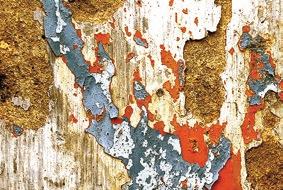
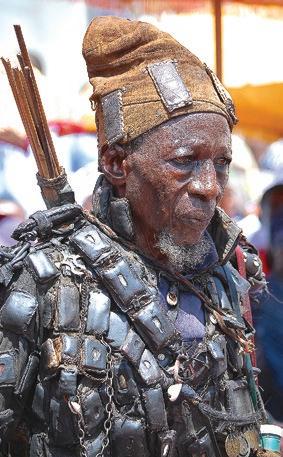

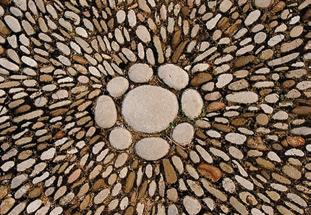











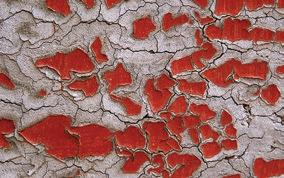


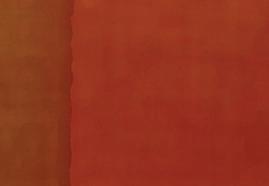
A collage of some of Gehrig’s striking travel photographs. Several are from her visit to Ghana during the Ashanti tribal kings’ yearly celebration in Kumasi’s football stadium. Each leader arrives attended by a small court of wives, relatives, grooms, and warriors—and wearing his best gold jewelry, a craft for which the Ashanti are renowned.

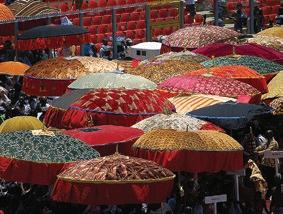






of the sky, stretching as far as the eye could see. A week or so later came another transformation—millions of bright pink flowers blooming from the water-soaked earth.
“It was deeply unsettling in some ways,” she says, “but it remains one of my most remarkable memories.”
She would be hard-pressed, however, to name a favorite destination. “It’s impossible to say. My favorite place is the last place I’ve been to.” And she does not like to repeat herself. “Especially if such a long time has passed since the last trip. It is best to keep the memories of a place when it was unpolluted or uninhabited, not destroyed.”
But wherever she goes, she is by no means a detached observer. “We sit with the people, we eat with the people, we sleep where they sleep. We have never been treated like outsiders.”
And she and her friends regularly return the kindness. Several years ago, for instance, one of Gehrig’s traveling companions met a young man from an impoverished village in Burkina Faso. Together they sponsored the redevelopment of the village, everything from acquiring land to building schools. “One has to give back,” she says. “We have so little idea what goes on in the world. But even though we have such a small postage stamp of time in life, there is still so much we can do.”
Still, Gehrig does require time to rejuvenate. “The world has, what, a couple hundred
countries? And I have been to about half of them,” she says. “There are many places I would still like to see—too many, frankly—but I also like to stay at home as I love to be alone.”
And since moving to Santa Fe five years ago, she has made many close friends with whom she likes to spend time. A gracious hostess as capable of organizing large dinner parties as she is of going with the flow at impromptu gettogethers, Gehrig regularly welcomes an array of friends and adopted family into her home. One of eight structures originally built as part of an 18th-century gristmill located on Santa Fe’s east side across from the river, the restored adobe home still bears many original features. In its long, rectangular layout, the kitchen, dining room, living area, guest bedroom, and bath follow one after the other. The master bedroom, bath, and small office occupy the upstairs space. Patios and gardens blooming with native plants surround the elegant, cozy house, which is decorated with Gehrig’s keen eye for color and pattern. And while the artworks inside must number in the hundreds, they are lovingly and thoughtfully displayed, without any one piece overwhelming the other.
“Because I travel so much, I don’t collect any one thing,” Gehrig explains. “Every time I go, I discover something new—another culture, other ideas. The world is so infinite.” Still, her democratic eye does skew toward certain

cultures and themes, namely ethnographic art from Africa, Asia, and Australia. These objects both remind her of her travels and also serve as tangible testaments to the commonalities that bind humankind, regardless of cultural differences. One of her first-ever purchases is a wooden ancestor piece from Africa, carved upon the death of a loved one and placed outside the family home in the hopes that the deceased spirit will enter the effigy, offer protection, and bring good luck. She also has pieces from the Amazon and Indonesia that serve the same function. African initiation masks, a section of a bronze frieze from a now-destroyed Tibetan monastery, and paintings from Australian Aborigine artists all reflect the shared human impulse to make sense of our world and our place in it.
Gehrig’s love of abstract imagery is revealed in her collected American and Italian paintings and Japanese ceramics, as well as in her own photography. “Having traveled all my life, I started early to make photos in order to remember my trips,” she says.
But the photos are more than just snapshots. She has had several exhibitions of her work in Rome and two others in Santa Fe, one at the Center for Contemporary Arts (CCA) and another at Victoria Price Art & Design. She has enjoyed brisk sales of a series of unusual boxed photo cards and is also planning a small book of her abstract photography.
Despite her wide-angle view of the world, her camera eye aims at its details—her big love is macro photography and the infinite beauty of the minutely scaled. The end result in both cases is a search for communion among people and cultures, the natural and the human-made. Hence, the forms revealed in an up-close view of a Shanghai skyscraper are echoed in another photo of windblown patterns on Saharan sand dunes and still another of the geometric structure of Italian roof tiles.
But whether she is hiking a remote section of the Himalayas, hunting down a treasure, or distilling portions of the world with her camera, Gehrig always remains solidly herself. Asked if she ever feels overwhelmed or unmoored in her travels, she says firmly, “No, never. I live in my own skin, I see with my own eye.” One gets the sense that she is too busy participating in life to indulge in much navelgazing. “We are all just little ants, you know? And I’m one of many, neither positive or negative, important or unimportant.”
Perhaps her most unique discovery of all is not how different we are, but how alike. In our impulses to create art, to adorn our bodies, to connect to our ancestry—and in the end to make our marks and leave something positive for the future. R
From the Fall 2013 / Spring 2014 issue

Top and opposite top: Gehrig’s home is a stylish sanctuary, but her preferred method of travel for many years rarely involved anything more glamorous than a sturdy backpack, tent, and Jeep. Those immersive experiences also helped forge the tight bonds of friendship she shares with her travel companions. “These relationships are precious,” she says. “It is so important when you travel, especially to places that are difficult, to have companions with similar values and temperaments.”
The three photos on opposite page are some of Gehrig’s favorite pieces, top to bottom: A “twofaced” head by Chinese artist Wang Keping, who was a founding member of China’s first nonconformist artist’s group, Xing Xing (the Stars). The piece represents the dualities of his life as a child in Communist China—one half Buddha, the other Chairman Mao. The bronze piece is a portion of a frieze from the 13th-century Tibetan monastery Densatil, once considered the country’s most beautiful until the Chinese destroyed it as part of their Cultural Revolution in the mid-1960s. The sculpture at bottom is by Japanese ceramist Mishima Kimiyo.
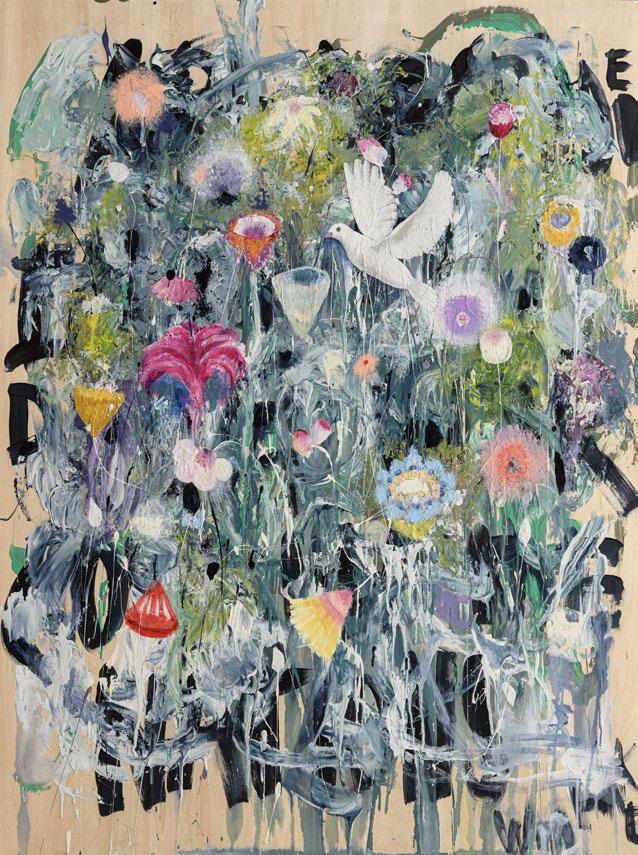



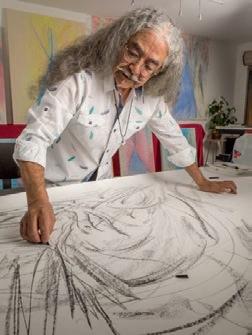
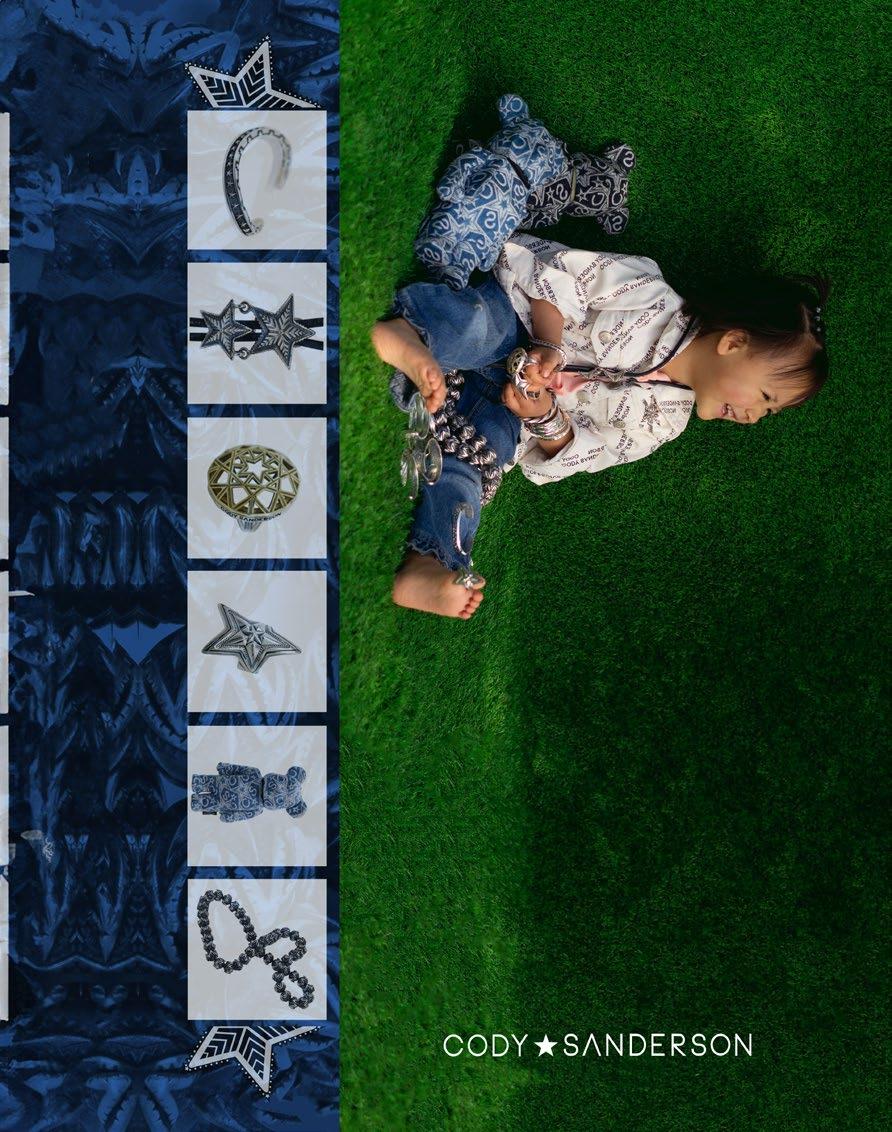
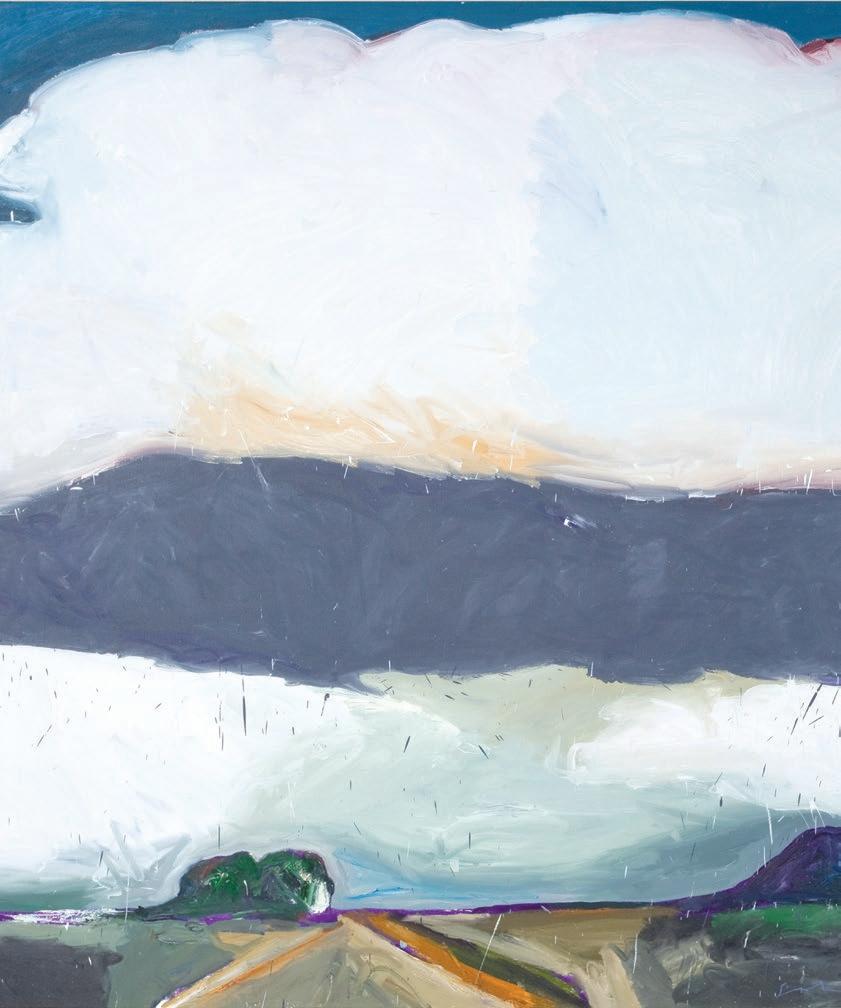
People remember the celebrity and the parties. But Santa Fe’s most controversial Native artist had another side

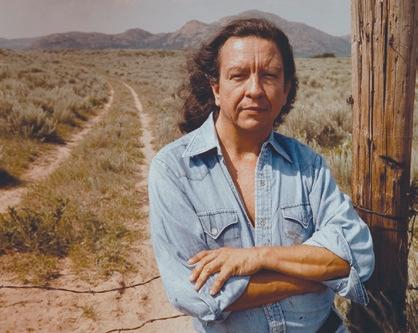
BY KEIKO OHNUMA |
SBY PETER OGILVIE
leepy, windswept, and often deserted, the remote village of Galisteo, New Mexico, shows few traces today of what was once its most famous resident, an artist so glamorous he was more like a rock star. And if Fritz Scholder’s ghost still roams the grounds of his old hacienda here, it is more quiet than the painter ever was in real life.
Behind the thick adobe walls of his former home, his wife of 27 years, Romona Scholder, lives a peaceful existence in what most resembles a museum or shrine whose neatly arranged books and artifacts testify to the artist, collector, reader, and traveler that her ex-husband was. But nothing signals the big parties, admiring fans, the national éclat he sought all his life—and which seem to wait, like the house itself, for the full story of Fritz Scholder to be told.
The most controversial Indian painter America had known, and its most reluctant, Scholder was a paradox in his time, and remains one still. His story parallels the ambiguous place of Santa Fe on the contemporary art map.
He arrived in the late 1960s to teach painting at the brand-new Institute of American Indian Arts, in what was then a quiet art colony. Scholder was a product of his times: an Abstract Expressionist who studied under Wayne Thiebaud in Sacramento, California, and embraced the trends toward Pop Art, minimalism, and color field painting; he did landscapes and butterflies. Ambitious and serious, he told his Native students at IAIA they would get nowhere painting their subject matter.
Scholder did not realize what Santa Fe had in store for him, nor how it would mark the turning point of his artistic career. The Indian power movement was building energy that would stun the nation in 1969, and Scholder was readily drawn into the fiery debate and creative engagement of the “artist-warriors” at IAIA.
Revisionists today question whether he was truly an original or a follower in the move to merge modern art with Indian subject matter. There can be no question, though, that Scholder ran with it fastest and furthest, powered by the force of enormous talent and hard work. “He was ruler of the roost,” declares an old friend, Santa Fe art collector Jonathan Abrams. “There’s no question that he was the ruler of Native American art—and he loved it.”
Scholder’s jarring portraits of Indians dashed with wild brushstrokes, fields of outrageous color, and distorted proportions shocked a community accustomed to the flat, detailed, serene figures for which Indian painters had long been known. His Indian with Beer Can still raises blood pressure in Indian Country today, and nearly everyone has seen some of the startling series of Indians wrapped in the American flag.
Fritz and Romona married when he was still an unknown painting teacher, and bought a home on Canyon Road in 1969. As his fame soared, they graduated to twin adobe homes in 1972, in Galisteo and in Scottsdale, Arizona. The Arizona address gradually gained favor with Fritz, where he moved among glamorous art patrons who knew him as “the Indian Andy Warhol.”
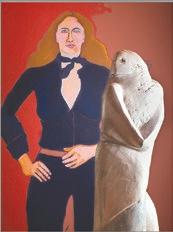
But friends remember Galisteo, too, for its lavish soirees. Immediately upon arrival, Fritz erected a huge tepee in the yard and invited friends to sample his old family recipes, Romona recalls. They hosted Jackie Onassis and her sister and
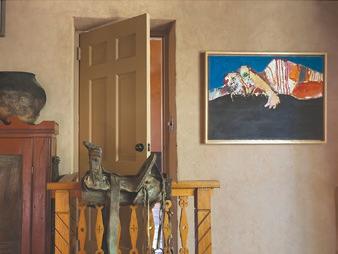


Scholder did not realize what Santa Fe had in store for him, how it would mark the turning point of his artistic career

the Chinese minister of culture, with a retinue of thirty. “The whole Santa Fe party scene would transport itself here,” says their friend Priscilla Hoback, a ceramic artist who still lives across the street in the village of 150 people. Romona would bring in flamenco dancer Maria Benitez, Hoback recalls, who “would come to dance for, like, fifteen minutes on her way to something else.”
They hosted Jackie Onassis and her sister. According to a friend, “The whole Santa Fe party scene would transport itself here.”

This was the Fritz Scholder that the world knew: driven by a sense of destiny, “serious about making it, becoming a famous artist,” says Romona; “a great painter but also a great salesman,” adds his friend Skip Holbrook, who taught with him at IAIA. A man who had time for everyone, “even the idiots who wanted to drape an arm around him for a photo,” says Holbrook; an artist who was “very precise about assembling a good biography.”
But recognition came at a price for Scholder, one that continues to be paid by his legacy. Lauded for his revolutionary depiction of Indians, he soon felt trapped in a Native stereotype. “I was mislabeled an Indian artist because I had done a series on the American Indian when I came to Santa Fe . . . because all painters
who go to Santa Fe become immediately seduced by this very strange and foreign little town,” he said in a 1996 interview.
Although his grandmother was Luiseño (a California Mission tribe) and his father worked for the Bureau of Indian Affairs, Scholder was not “raised Indian” and did not self-identify as Native. He often remarked that he looked more Indian than he was. It was at IAIA that he first became aware of what he called “real Indians” and their “whole different mind-set.” And it was only at home, within the walled compound so far from Santa Fe that the 23-mile journey was made at night in complete darkness, that Scholder could set aside his pose of famous Indian artist—or not-Indian artist—and simply respond to what moved him.
“This was the interior side, the interior space,” Hoback says of a small number of paintings she saw that spoke of a “more intimate, vulnerable, revealing” Fritz. Paintings of animals, of Romona, or the color-field landscapes from a previous time she found moving because they were so rare. “They were so deep, an emotion so different from the fierceness of his other work— but as intense.”
During the summer months, when they were in Galisteo, Romona says she and Fritz would drive into Santa Fe for the day to take care of business, then come home for a quiet supper before he retired to the studio until midnight. “He loved painting in the evening,” she says, even though his studio was rich in natural light.
Holbrook remembers that “he was a demon in the studio.” He worked furiously and fast, leaving behind hundreds of paintings, prints, sculptures, and illustrated books. “He was a force of nature,” marvels Abrams, the collector, producing so much so fast that detractors wondered if he was “overdoing it.”
Gregarious by nature, Scholder felt immediately the isolation of their 200-year-old adobe shaded by cottonwoods on two acres near the Galisteo church. Romona recalls him lying in bed on one of their first nights in the house and wondering aloud, “Where is Thirty-one Flavors? Where is Pizza Hut?” Galisteo was then a traditional Spanish village, and none of the artists who have made it a haven—Agnes Martin, Bruce Nauman, Woody Gwyn, John Massee, Judy Tuwaletstiwa, the critic Lucy Lippard, and Hoback herself—had yet discovered it.
“I am part of this village and I’m not,” Scholder told a New York Times reporter in 1977. “I keep open but I keep a private world. It was like stepping back in time to move here, because Galisteo . . . hasn’t changed that much over the years. It’s as close to the land as an artist can get.”
As Scholder shifted his center of operations to Scottsdale, near his gallery (Elaine Horwitch), he moved away from Indian subject matter to themes that caused discomfort among his Native fans, such as death and skulls, angels and demons, and the “mystery woman” series, often illustrated from his vast collection of shamanistic, sometimes taboo objects. The artifacts followed him to Scottsdale; gone from the Galisteo home are the outrigger canoe from New Guinea, the Egyptian mummy


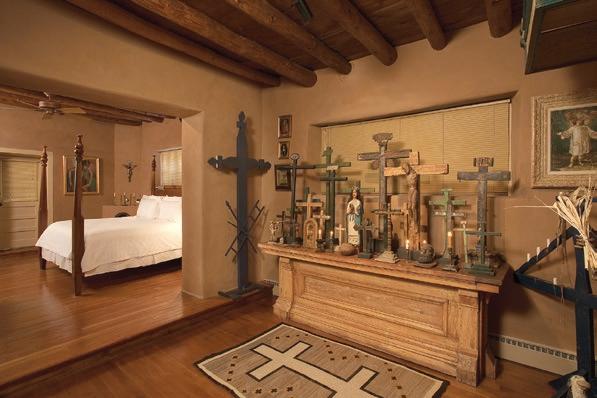
Leading into the
a display of colonial Spanish religious objects, one of the Scholders’ early collecting interests.

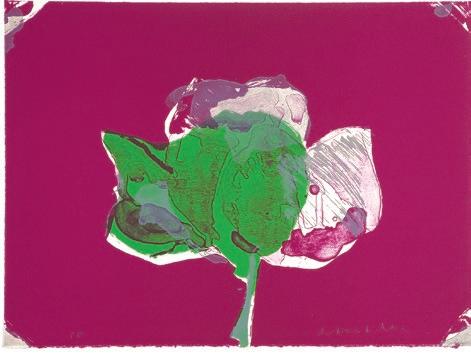
baby in a glass coffin, and the room full of skulls described in earlier reports.
Fritz and Romona divorced in 1994, after years of living apart. With a lifelong career as a psychotherapist, Romona had remained as devoted to her patients as to being a famous artist’s wife. In 2002, Fritz married gallery employee Lisa Markgraf, just three years before his death from complications of diabetes. His widow retains the estate and most of his artwork; Romona has just the Galisteo home— a whisper from a much earlier time, but one that feels increasingly formative.
Gone from the Galisteo home are the outrigger canoe, the Egyptian mummy baby, and the room full of skulls
In his old studio here, a large painting called Galisteo is displayed—one of the few from his earlier style, with bands of pure color, all observation and emotion without any of the later cynicism. A bronze bust in the garden is called simply Romona. The house had been, from the time they saw it, Romona’s. “It’s a lovely house,” she remembers telling him, “but it’s my house. It’s the perfect setup in the wrong place.” Fritz Scholder was just not an artist who would be drawn to privacy and isolation. “He was like, ‘Bother me, please,’” Romona says of the artist-showman. “He loved contact with other people, giving autographs; he liked that regular people saw and loved his art.”
Fritz Scholder never achieved the name recognition of some of his peers in New York, where he relocated in the 1980s to cement his success. And he remains obscure today outside the Southwest, which he took by storm in the 1970s. “I would say the career we expected of him never happened,” concludes Abrams.
But history may yet redeem the not-Indian artist, albeit under a chapter labeled “Native America.” In 2008 and 2009, the Smithsonian Institution’s National Museum of the American
Indian mounted a double exhibit of his work titled Indian/Not Indian in New York and Washington—its first-ever solo retrospective—cementing Scholder’s place in Native American cultural history.
He was able to capture like no one else a moment when Indians quit assimilating and began to reclaim their traditions, the curators noted. By portraying the ambiguities of Native identity, Scholder prefigured postmodernism’s central concern with how cultural identity is constructed. In his insistence that he was not Indian—“I’m very proud of being one-quarter Luiseño,” he said in 1996, “but you can’t be anything if you’re a quarter”—he also presaged ongoing debates about what qualifies as “authentic” Indian art.
It seems clear today that Scholder was able to transform Native art precisely because he was both Indian and not Indian, seeing them from outside while being treated as inside. Romona describes his instant reaction to spotting a buffalo dancer at Santo Domingo Pueblo eating an ice cream cone, the inspiration for his Super Indian No. 2 . “He picked up on that Indian-as-mythical-being and Indian-as-ice-cream-cone-eater,’” she said in 2008. “And I think that’s why this painting is quintessentially Scholder.”
He was fond of saying that the Indian is the ultimate cliché, that everything one paints has become a cliché. In his paradoxical double life, gregarious and private, the Indian Warhol and the first artist to “get” Galisteo, Scholder in his precocious identity as self-consciously Indian tried on every cultural cliché while refusing to inhabit any of them. R
From the Fall 2010 / Winter 2011 issue
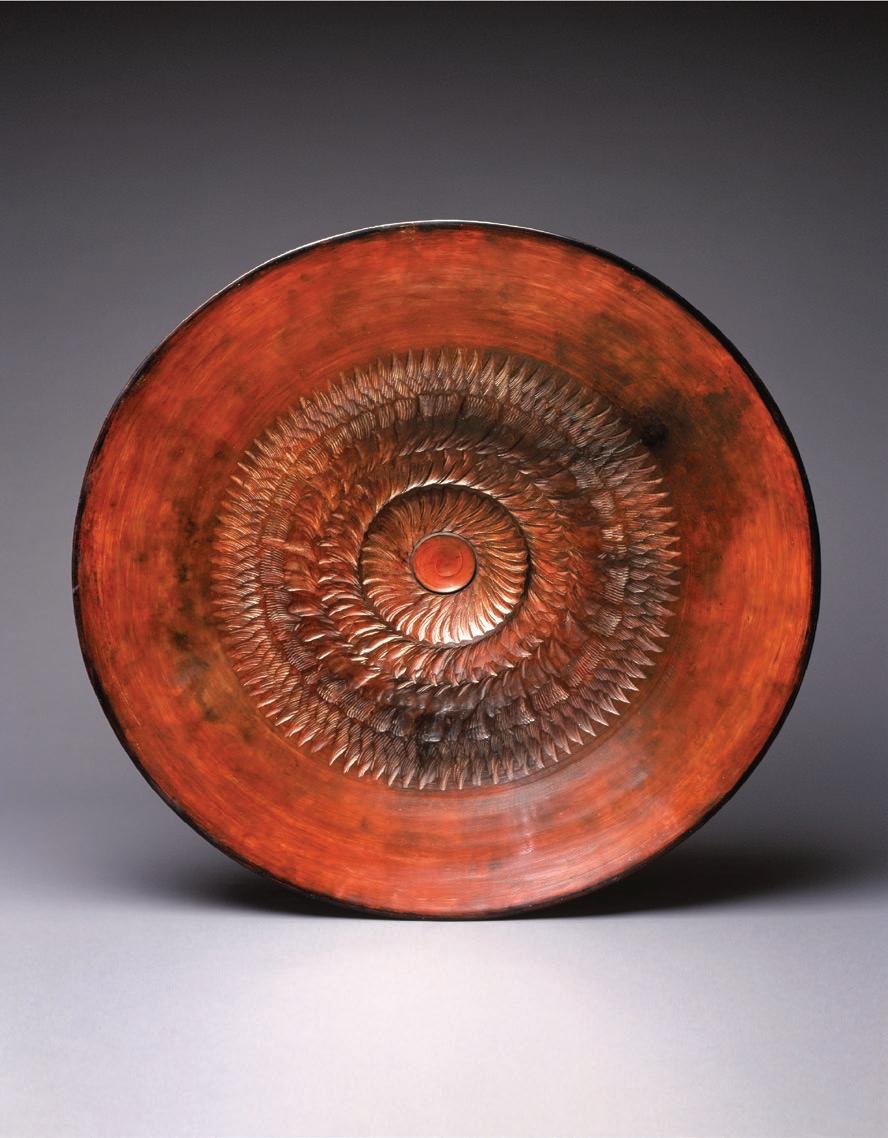
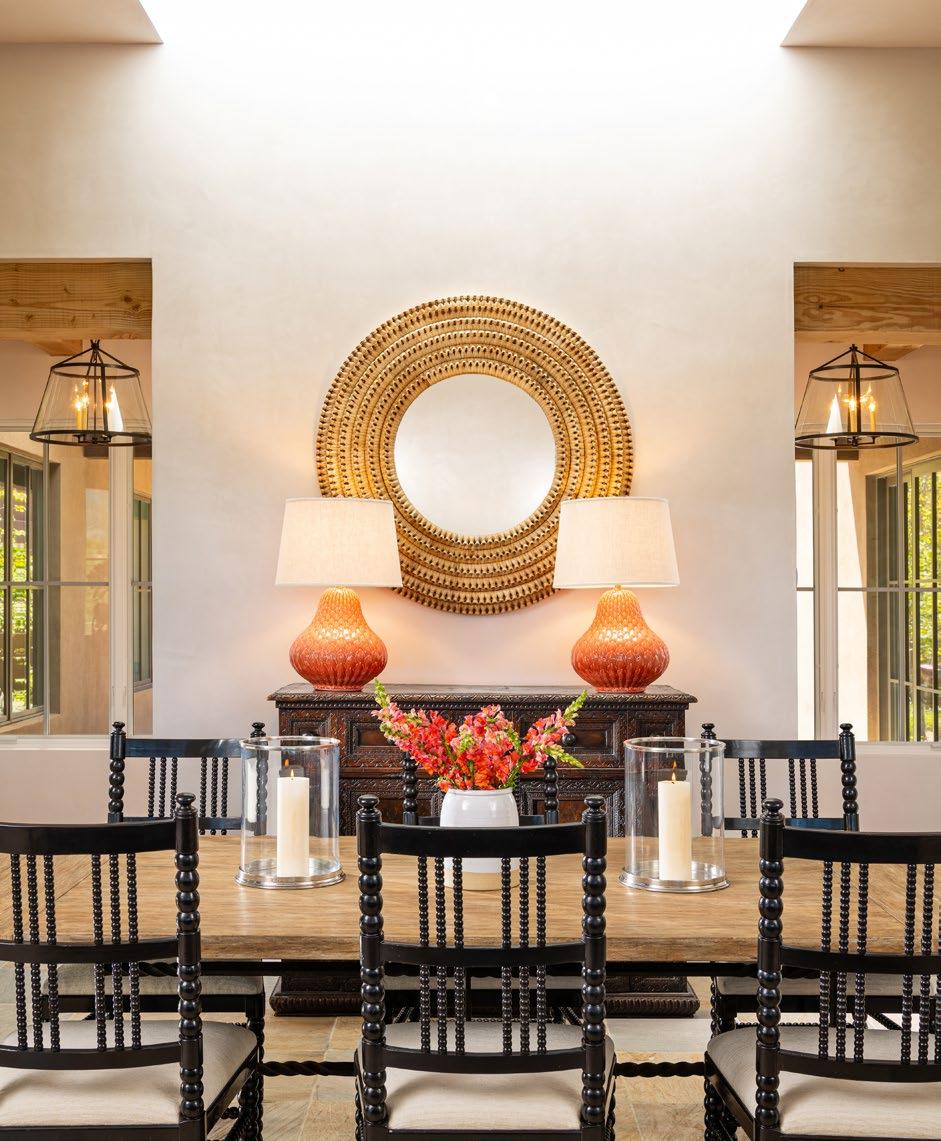








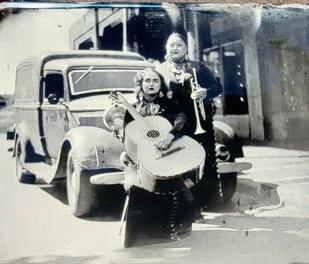


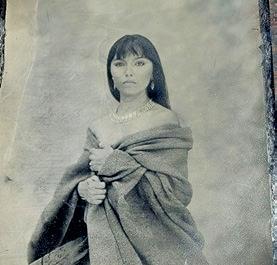

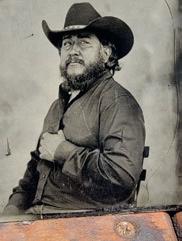
R.J. Gibson is a master of the wet plate tintype photographic process, which originated in the 1850s and continued through the 1930s. Gibson’s work has been featured in numerous magazines and motion pictures and in the National Portrait Gallery of the Smithsonian Institution, the National Archives, and the White House Press Corps.
What makes Gibson’s process truly remarkable is that he shoots the wet plate tintype photograph in the field and develops it immediately in a portable darkroom housed in the back of his 1934 Dodge panel truck. R.J. Gibson is available for private portrait sessions, public events, lectures, demonstrations, movies, television, media work, and private lessons in the tintype photography process.
For more information: call or text 717-337-9393 Instagram: rjgibsonphotographer | Email: tintypeartist@gmail.com









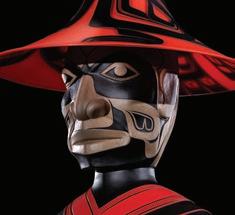







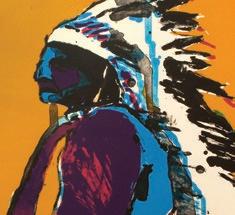
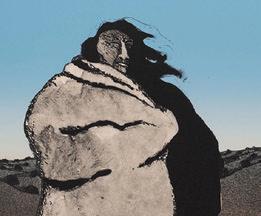























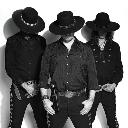



PRESENTED BY LENSIC 360

MOVIESINTHERAILYARD PARK
740 CERR ILLOS RO AD
JUNE 1 – AUGUST 24 , 2 024 @ 7 PM
6/1
• BARB IE PR E- EVENT : BARB IEPH OTO BO OTH, 5-7 PM
6/15
6/29
7/ 20
• THEOR IG I NAL MU PP ET MOV IE
• W IZARDOFOZ
• S TOPMA KI NG SE NSE
7/27
• BE STIN SH OW
8/10
• KU NGFU PANDA4
8/ 24
• STAR WAR S:ANEWHO PE R AI LYARDPL AZ A LIV E MUSIC ATTHE WATER TO W ER
JUNE 7 – AUGUST 23 , 2 024 @ 7 PM
6/ 7
• ME XI C AN INS TIT UTE OFSO UND
6/14
• SAN FER MIN
6/ 21
• HIRIE
6/ 28
• MON ST ERBAT TL E:
PO L ISH AM BASS AD OR
7/5
7/10
7/11
• FR UIT ION
• BO MBINO
• OS MUTAN TE S
7/12
7/19
7/ 26
8/2
8/9
8/ 23
• LADAMEBL AN CHE
• DIRT WIRE
• L AS CAFETE RA S
• SF SA L UT ES TAY LORSW IFT
• DIGA BLE P LANETS
• CI MA FUNK




More De tails & Indoor Events: RAILYARD SA NTAFE.COM &SantaFeRailyardFacebookPage Dates & EventsSubject to C hange



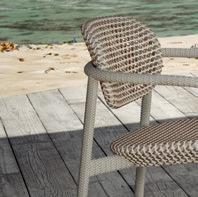

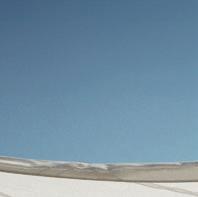









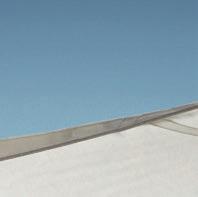









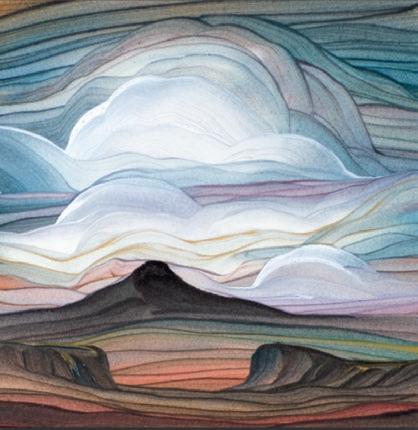

Located in the heart of the Railyard, the Santa Fe Farmers’ Market draws people together in a celebration of local flavor and community connection. Here, amid rows of colorful stalls bursting with fresh produce and artisanal goods, residents converge to engage in more than just commerce. The Santa Fe Farmers’ Market has become a social hub—a space for impromptu gatherings and for forging bonds that strengthen the fabric of the city.
You’ll find neighbors meeting neighbors as they browse the many stalls, along with local chefs looking to stock their kitchens with the best Santa Fe has to offer. Fair-trade goods from the market’s gift shop and locally made fine art and crafts—from jewelry to table centerpieces to antiques to apparel—showcase the diversity and creativity of local artisans at the Sunday Railyard Artisan Market.
This one-of-a-kind venue is open every Saturday from 8 am to 1 pm year-round for the Santa Fe Farmers’ Market and every Sunday from 10 am to 3 pm year-round for the Railyard Artisan Market.
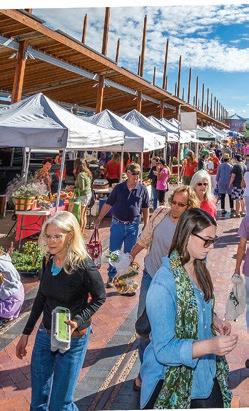

Baca is no ordinary street. It may not have the fame of Canyon Road or the deep history of El Camino Real de Tierra Adentro (more commonly called Agua Fria), but as the Cerrillos Road gateway to Santa Fe’s Railyard, Baca Street has a distinct and lively culture all its own. A haven for artists and craftspeople since the early 1990s, Baca Street and the Baca Railyard—which encompasses the Railyard property southwest of St. Francis Drive— today hums with opportunity and vision.
Just a short distance from the South Capitol Rail Runner stop, the Baca District as a whole is easy to access, with or without a car. The Acequia Trail Easement is a scenic pathway along the tranquil Acequia Madre that connects the Baca area to the North Railyard, offering an immersive experience for walkers, hikers, and cyclists. This trail forms a vital part of Santa Fe’s extensive citywide trail system, weaving through the distinctive landscape that is shaded by majestic oldgrowth elm trees. The tunnel underneath St. Francis connects the two railyards along the trailhead.
The neighborhood is also a canvas for cutting-edge contemporary architecture. This brings with it fresh art and design spaces, eclectic retail shops, and innovative live-work spaces for artist and architects, all contributing to a dynamic and modern vibe. As a destination for the arts, the area is home to galleries like
Pie Projects Contemporary Art and Baca Street Studios, which houses five galleries, including Liquid Light Glass, a hub for glass blowers and lovers of art glass. Container, an offshoot of Turner Carroll Gallery, is a combination of art institution and gallery that brings contemporary touring exhibitions to Santa Fe.
Additional enterprises include Natural Stones, which offers both novice and professional jewelry makers a huge selection of rare stones and supplies; Raven consignment super store, the eclectic consignment clothing boutique Art.i.fact; Justin FrameDesigns; and Undisputed Fitness. Great eats abound as well, including the always-buzzing Counter Culture Café, with its displays of local artwork; Cafecito Santa Fe, which serves Argentinian specialties merged with local flavors for breakfast and lunch; and Turquoise Teapot and Cat Café, which connects patrons coming in for specialty teas and coffees with adoptable cats.
In addition to its contemporary architecture, extensive walking and biking paths, and progressive Business-Capital District zoning, generous lease agreements make renting apartments and live-work spaces another reason to choose the district as a cool place not just to hang out but also to live, work, and thrive—a community designed to promote synergistic relationships between tenants, residents, and neighbors.



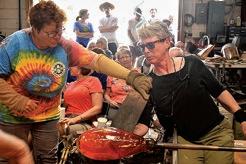

Nestled on the outskirts of downtown , at the Baca Railyard , our space is designed to cultivate community and organic growth in every facet of life.
Trailhead Santa Fe: Where every moment is a connection and every stay is an experience. Stop by for a cup of tea, settle in to work, or experience the comfort of staying in one of our short rental apartments. As hosts with over 700 five-star reviews garnered over the past six years, we ensure your stay is nothing short of exceptional.
Experience a long-term live/work lifestyle at the compound.



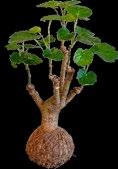
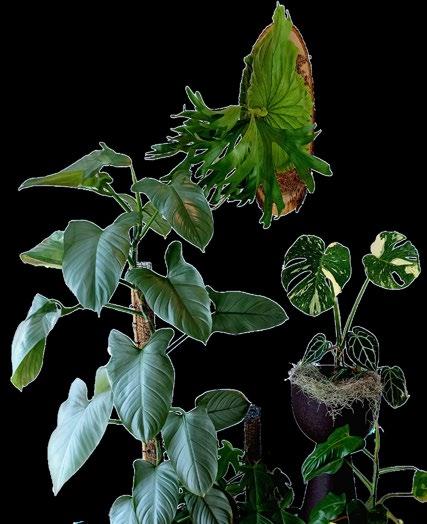
Allison, renowned for her expressive portraiture, also captures the essence of spaces and landscapes, infusing them with a serene quality that immerses viewers in the artwork. Her artistic journey began in Paris, where she trained under private tutors before transitioning to teaching.
Compound, Allison’s studio welcomes you.
Commission Allison to craft a timeless portrait of your loved one, capturing their essence in a breathtaking masterpiece your family will cherish.
−−Julian Blue www.deborahallisonstudio.com
Located next to Cafecito in Santa Fe’s trendy Trailhead




Cafecito offers an authentic experience, merging deep Argentine roots with local Santa Fe flavors and producers. Join us for coffee, natural wines, maté, and house-crafted cuisine.

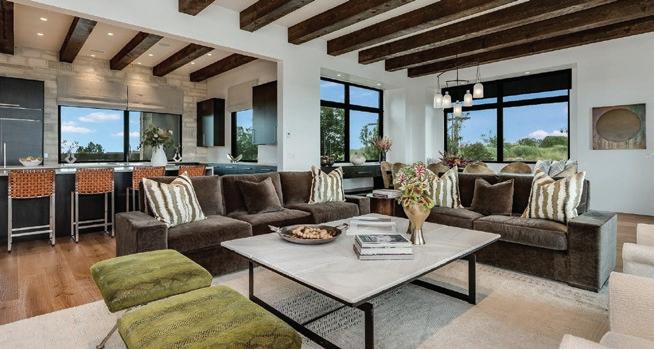

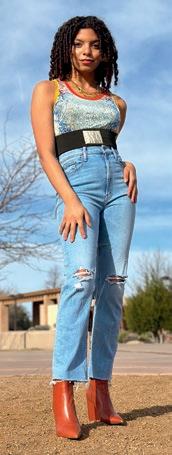
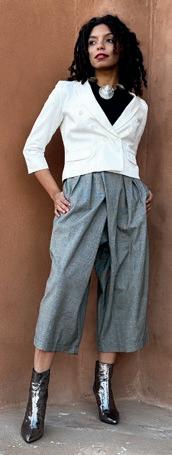








TERESA ZAMORA
It was 1975 when Ramón José López and Nance, his bride of a month, began building their adobe home in the foothills of the Sangre de Cristo Mountains. López had not yet embarked on his path as a santero, a path that was to bring him international acclaim and deep spiritual satisfaction. A jeweler at the time, his priority was to create a home where he could work at his craft and raise a family.
“Two of Ramón’s nephews came to help us. We had no water, no electricity—but, overnight, we had two sons,” chuckles Nance as she recalls building the secluded home that has been at the center of the couple’s lives for 30 years. As the family grew, the house also grew, eventually becoming the casual retreat it is today: sprawling yet cozy, a place where time seems to stand still. A greenhouse with a serene cactus garden extends the length of the home, a fountain whispers, and the magenta bougainvillea the couple planted when their first child was born spills petals like small hearts.
It was here in the family sanctuary that López first connected with the traditions of his ancestors, who had come to this land 400 years before, guided by faith and grit. Propelled by a desire to participate in the annual Spanish Market, López shifted his focus from jewelry to the time-honored art forms of the santero: bultos (wood carvings), retablos (paintings on wood), and reredos (altar screens).
“My grandfather died two years before I was born, but the fact that he was a santero was a great inspiration for me. I began by using his old hand tools—his adz, planes, and knives,” López says with reverence. His heritage has clearly inspired him: López feels the divine energy flow through him as he carves the sacred images. He has in turn passed on his knowledge of the traditional arts that give his life meaning to son León, 28, daughter Lily, 26, and twins Bo and Miller, 20— all artists in their own right.
López has become a perennial Spanish Market winner, and his work has been sold to collectors around the world. It’s exhibited in institutions such as the Smithsonian in Washington, D.C., the Heard Museum in Phoenix, and Santa Fe’s own International Museum of Folk Art and Museum of Spanish Colonial Arts. But his most precious collection is housed in the family chapel he began building 18 years ago.
“For years I’d get up in the dark at 4 a m to start work,” he recalls. ”One night, early on, I climbed up on the roof and saw that the light from inside formed a cross that hovered over the chapel like a blessing.”
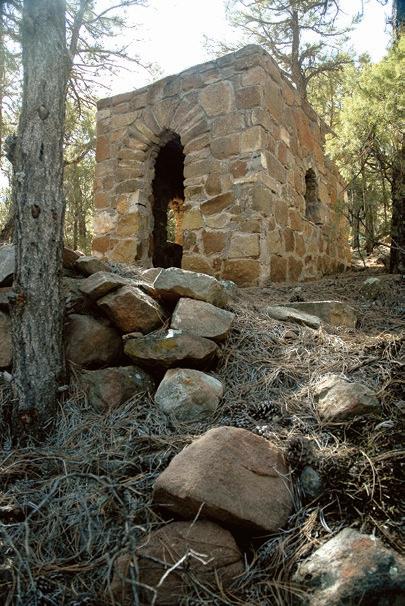
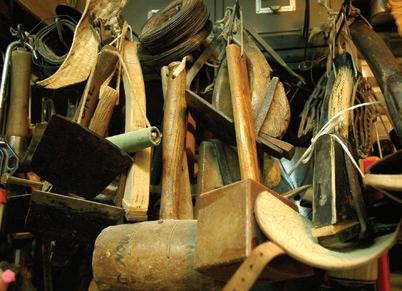

Inside the chapel, the temperature is cool and even. Two-foot-thick adobe walls are studded with binding straw that gleams like inlay. López’s handscraped, -treated, and -painted buffalo hide, or parapolvo, protects the altar from dirt and dust. The window is carved from selenite, a wafer-thin stone often used in New Mexico’s earliest chapels because of its translucence. You don’t have to be a Catholic to feel the energy emanating from the altar screen, which seems to vibrate with devotion and compassion. Among the quiet chapel’s many carved saints and crosses stands a small statue of San Ysidro Labrador, a delicate, three-dimensional piece made by Lily when she was just 16. The saint stands in a miniature field of real wheat that looks like it was just harvested.
Hand-carved wood is never static. As the afternoon deepens, López’s santos appear to breathe and shift position. Their natural pigments of red, ocher, green, and indigo dance in the waning light seeping through the chapel’s small window. R


From the Summer/Fall 2005 isssue

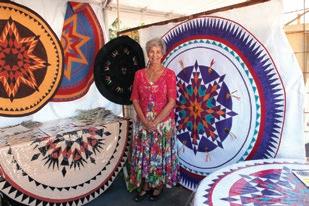






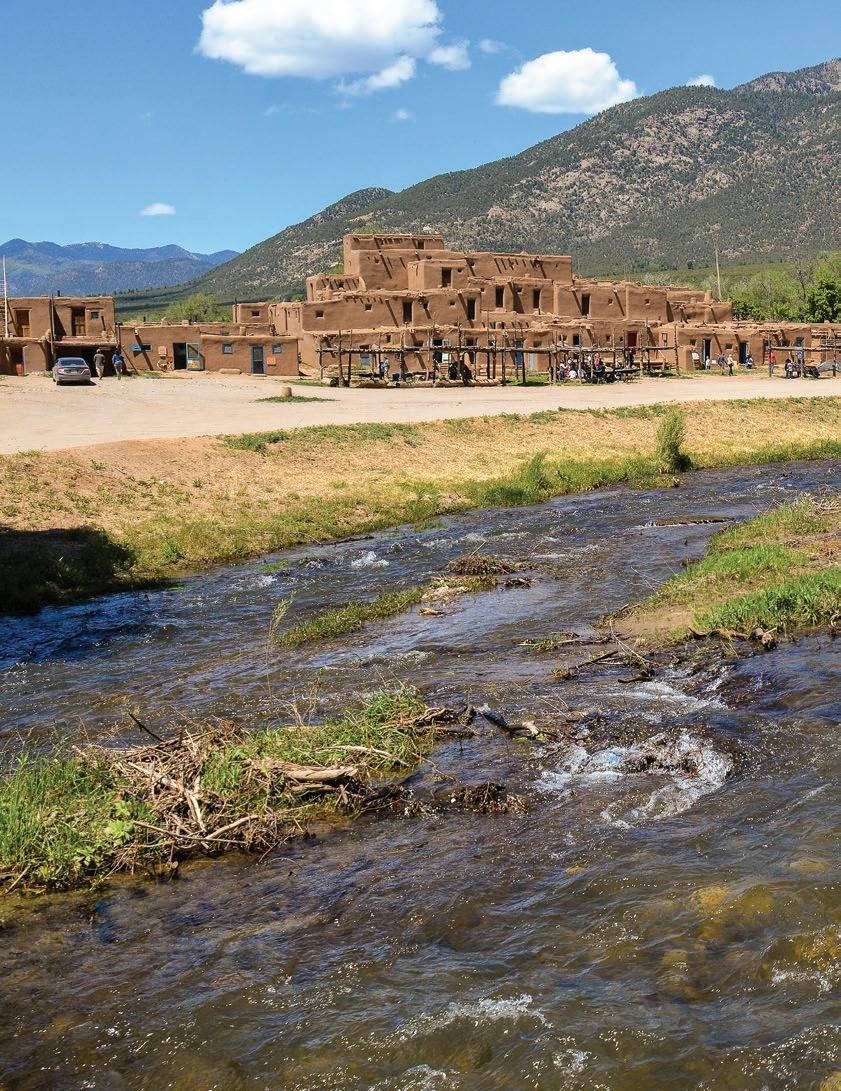
Currents of tradition flow through generations of Taos Pueblo artists
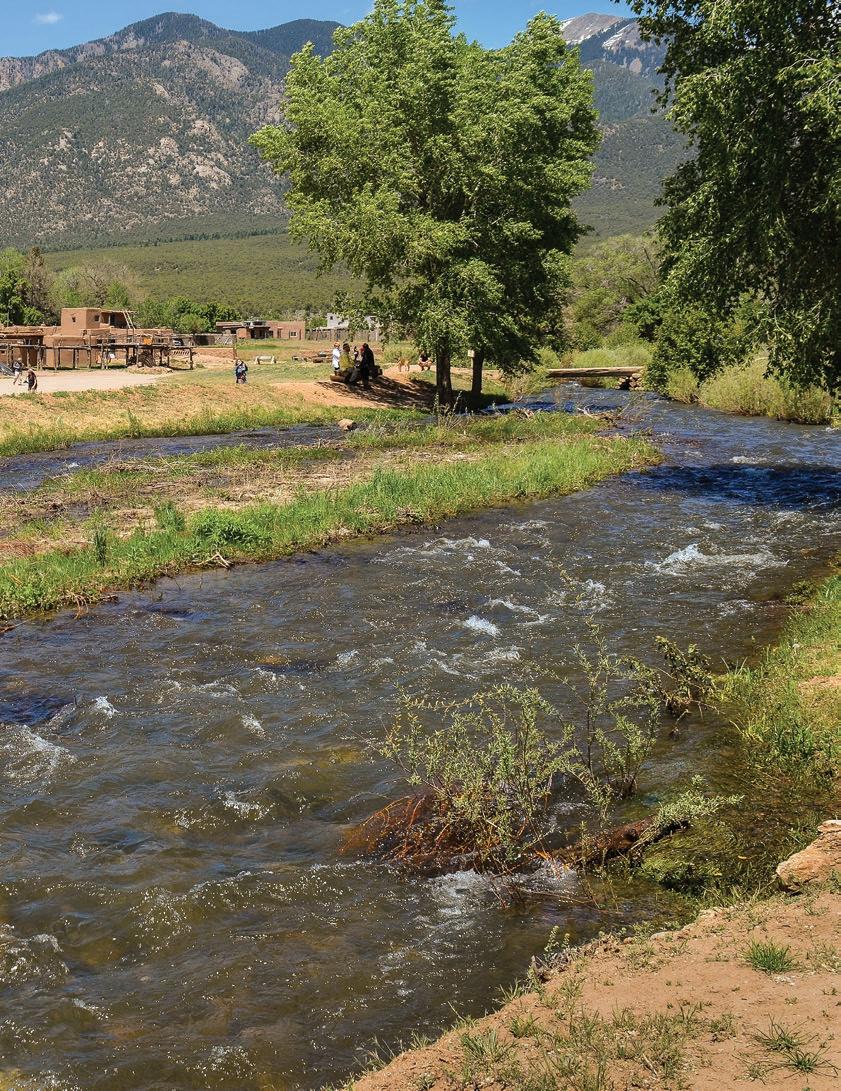
In the winter not too long ago, Taos Pueblo kids would bundle up to carry metal buckets down to the Rio Pueblo from their adobe homes in the village. Sometimes they’d have hatchets in hand, which they’d use to hack holes in the ice. Armed with cold, clear water, they’d stagger back to their houses, where the heavy buckets would be placed on wood stoves to warm for use as wash water. Taos Pueblo artist Jonathan Warm Day Coming says this is what he often did to get ready for school. It’s easy to romanticize this as a cultural snapshot of a time past, but the tribal council decided long ago to never have plumbing or electricity in the central pueblo area. So, if you need water for washing or drinking or cooking, you go down to the river to get it. In the mind of a Taos Native, there has always been something holy about it. Back when the people collected water in micaceous clay ollas, they did so knowing that this
water originated at Blue Lake, high in the mountains above their village.
The lake’s sacred significance is ever present, especially this summer, as tribal members commemorate the 50th anniversary of its return from federal government control in 1970.
“Back when Theodore Roosevelt took our land in 1906 and made it a national forest, our people couldn’t hunt up there anymore and go up for religious doings,” renowned sculptor John Suazo says. “My grandfather Jim Suazo used to say the men used to go up there to hunt, hiding from the rangers. And they would hide during Blue Lake ceremonies, waiting until the tourists were done fishing.”
Blue Lake was revered for centuries before Spanish contact in the 16th century. The ceremonies conducted there are so sacred that the tribe prohibits sharing any information about them with outsiders. So, when President Roosevelt established the Carson National Forest in 1906—with-
out informing the tribe that it included Blue Lake—this was an epic offense. Jim Suazo, in fact, was beaten over the head with a pistol by rangers who caught him hunting in the area, as chronicled in Frank Waters’ seminal novel The Man Who Killed the Deer.
Just as the river connects the villagers with the lake, there are currents that connect the village with its artists, whose traditions and beliefs include Blue Lake as an integral part of their cosmology. These traditions and beliefs have influenced generations of Taos Pueblo artists, past and present, such as John Suazo, DeAnna Autumn Leaf Suazo, Dawning Pollen Shorty, and Jonathan Warm Day Coming.
The stone sculptures by John Suazo have a mythic grace, and much of his work stems from his love of stories, typified by imagery that often depicts women and children. He says his works are inspired in part by his late uncle Ralph Suazo, whose sculptures reflected the people and nature

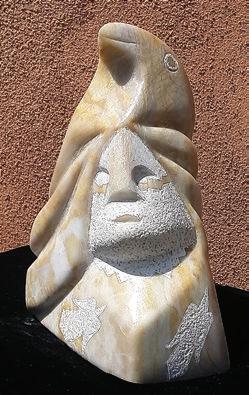
attended the Taos Pueblo Head Start program as a young child. “We were drawing on the floor with crayons and I remember one of the teachers was like, ‘Oh wow, DeAnna, you put a neck on your person!’ And, for some reason, that memory always stuck. Why wouldn’t you put a neck on a human figure?”
This past spring, Suazo exhibited with the 63rd Annual Heard Museum Guild Indian Fair & Market in Phoenix. It was the first week of March and signs of the coronavirus emergency were already evidenced by diminished crowds. Suazo’s work, though, did not fail to impress, especially those pieces recalling the style of Plains Indian ledger art for which she has gained quite a following.
around the Taos Pueblo, and he also credits his experience working with renowned Chiricahua Apache artist Allan Houser.
While Ralph worked primarily in cedar wood, John works in alabaster, limestone, and granite, which he occasionally travels hundreds of miles to locate. Although now in his late 60s, Suazo says he is fighting the years as much as the weight of his medium. He feels that his efforts to forge ahead are always done with his ancestors looking over his shoulder—and in the knowledge that his grandfather might approve.
DeAnna Autumn Leaf Suazo, a much younger artist, takes a turn from convention, drawing from Native traditions along with the aesthetics of Japanese anime. Her multimedia paintings, rendered in India ink, colored markers and pencils, and acrylic paint, have made patrons at Santa Fe Indian Market step back and reevaluate their ideas of what Native art really is.
The daughter of well-known artists Gary David Suazo and Geraldine Tso, Suazo began making art at an early age. One of her fondest memories is from the time she
“My art now is about Indigenous women present today, so what I’m doing is incorporating traditional attire—of course, it’s pre-contact attire,” she says. Ledger art, created by Plains Indians, is rooted in pictographic imagery created on buffalo skins and other materials. Around the 1860s, this imagery was transitioned to the discarded ledger books of accountants. The lined and numbered pages notwithstanding, these drawings create an indelible account of life way before the advent of photography. “The stories of ledger art, how these warriors and prisoners put down their stories on ledgers given to them while imprisoned, that’s what I do,” she says.
“We’re deep into our traditions. I’m Taos Pueblo and Navajo, but we’re also very modern and know how to balance the two . . . . For our tribe to be one of the first to get our land back from the US government was monumental. For so many Indigenous communities, their land was taken and they’re no longer able to do their ceremonies.”
Meanwhile, ceramics artist and teacher Dawning Pollen Shorty initially tried not to become an artist. She was born into a family steeped in the arts; her late grandmother Geri Track was a model for Taos Society of Artists painters, and other family members, including her uncle, John Suazo, are well known. Still, as a teen, Pollen Shorty bristled at the idea that people would have “these preconceived ideas about who I was based on who my parents or my grand-


DeAnna Autumn Leaf Suazo (right) used to hang around bookstores, poring over art books like Fruits, with photography of Japanese Harajuku girls dressed in vivid clothing. “Some of their clothing reminded me of the corn dances at the Pueblo. The colors blended together like there’s a palette going on. Those are the colors I use in my work.”
Top: Untitled (2019), Prismacolor marker, black India ink, colored pencil, and acrylic paint on canvas. Bottom from left: Waiting Maiden (2020), Prismacolor marker, black India ink, colored pencil, and acrylic on 1907 ledger paper; Spring Dances (2018), acrylic on canvas





parents or my uncles are, you know, and I just thought like, hey, ‘Know me before you think about me! Maybe I want to be a scientist or I might want to be a veterinarian.’ I just felt like I had been put into this box. I didn’t like it.”
She delved into archaeology and photography instead and now tells stories with clay. “I’m always looking to the past,” she says. “You just see this continuation of
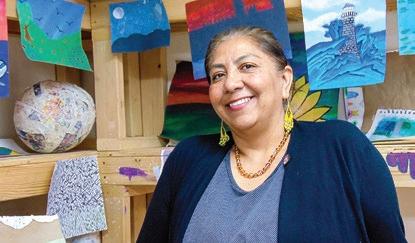
patterns that started a long time ago and are still being used today. And then you have a connection.”
The ceramic tradition at Taos Pueblo is primarily utilitarian and includes the wide-mouthed ollas used to collect water from the Rio Pueblo and small bean pots used for cooking, both made from local micaceous clay. It wasn’t until the 20th century when the tourist trade popularized the decorative pottery of other Pueblo tribes that Taos artists began incorporating figurative designs into pots made only as works of art.
“When I was developing my style,
I was doing it from a purely aesthetic point of view,” Shorty says. “I just want to show people beauty and simplicity.” Always an innovator, Pollen Shorty’s work is becoming more satirical and political. “I don’t really show those pieces,” she says, “because the public isn’t ready. It’s from life. It’s from what happens. They’re too controversial.”
Jonathan Warm Day Coming also hails from an honored lineage that includes the Taos Pueblo painter Eah-Ha-Wa (Eva Mirabal), whose gouache and watercolor cartoons famously depicted World War II as well as pastoral Pueblo scenes. Works

Jonathan Warm Day Coming, The Tastiest Plums (2014), acrylic on canvas. Bottom from left: New Buffalo Commune (2015), acrylic on canvas, is the artist’s take on Taos hippies, referencing the iconic Grant Wood painting; Cacique (2018), acrylic on canvas, refers to the title given to the men of one lineal descent whose generational duty is to oversee and pass down their knowledge of Taos Pueblo’s intimate religious life to fellow tribal members.

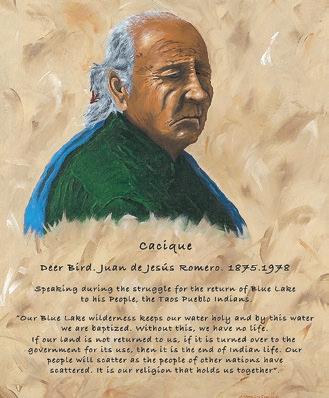

by both were shown together in a special exhibition at the Harwood in 2013.
Warm Day Coming grew up at the Pueblo, unlike many members today who live outside of the village, and that experience informed his personal vision. Within his artwork, one can glimpse an ideal image of Taos Pueblo life: harvesting corn, gathering water from the river, women in traditional attire picking chokecherries, and men singing at night on the middle bridge in the village. He works primarily in acrylic on canvas with a representational, illustrative style. In
each of his paintings, there is an attention to detail without the hard-edged adherence of an academic’s approach. That’s because these are memories, and when fellow tribal members see his work, they nod in assent, for these moments are shared, part of the village community.
As Warm Day Coming began to develop his signature style, made famous by his painting Night for Songs and Stories that was used to promote the now-defunct Taos Talking Pictures in the 1990s, he was also writing. For many years he’s been working on a novel rich with per-

sonal insights from his upbringing. Another book nearing completion, written in collaboration with Lois Rudnick, is Eva Mirabal: Three Generations of Tradition and Modernity, the first comprehensive book about her art and life.
The contemporary art of Taos Pueblo flows from water, stone, earth, and the deep traditions of its people. During the fight for Blue Lake in 1969, tribal elder Severino Martinez said, “The Blue Lake is the lifeline of this country. This is what has been told by our forefathers and their elders. This Blue Lake is not only a lake, but the blessing that we get from that lake belongs to everybody.”
Western culture often has a need to understand by full disclosure, even if that admission may ultimately be discarded because it doesn’t fit a preconceived idea. In some respects, it would rather hold to a stereotype than a simpler truth. Martinez said as much when he stated, “We know this is true, although we do not know how to explain it or prove it to you who are not Indians.”
John Suazo puts it more directly. “We were here first. This is our land.”
RFrom the 2020 issue

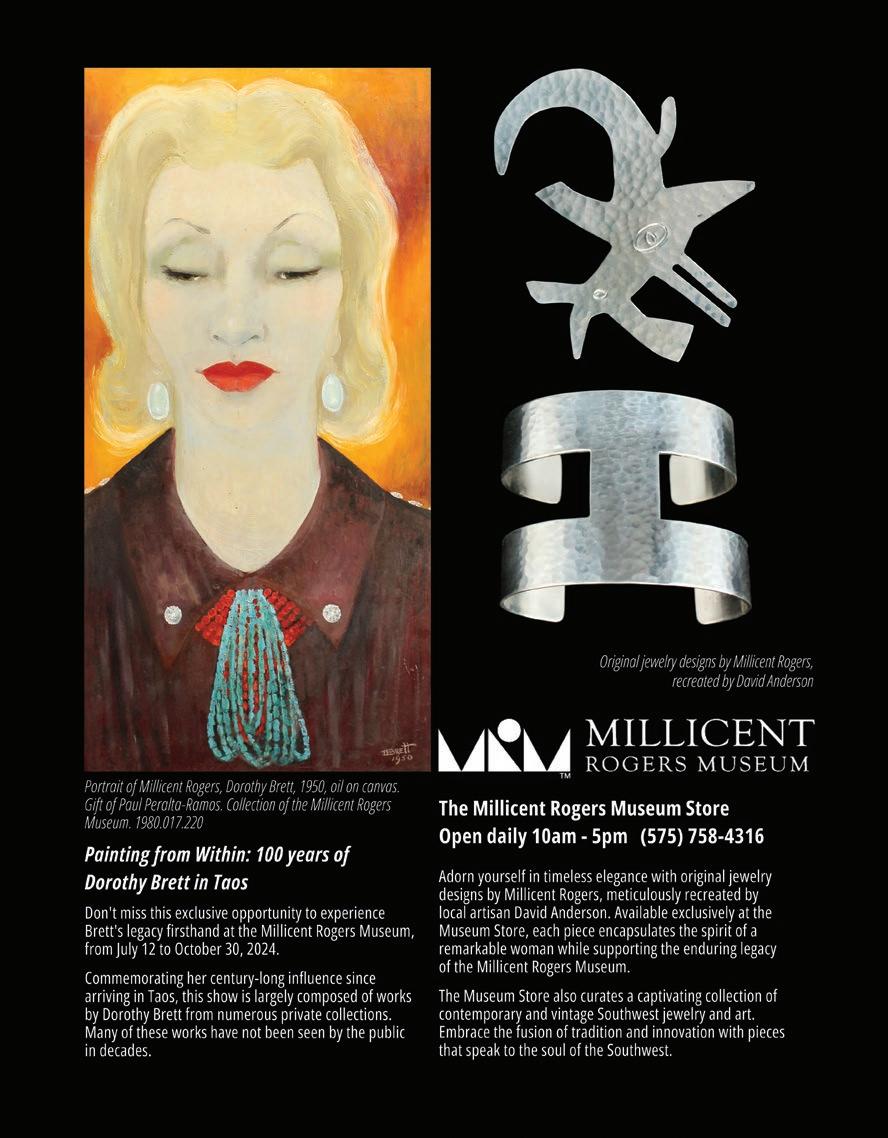
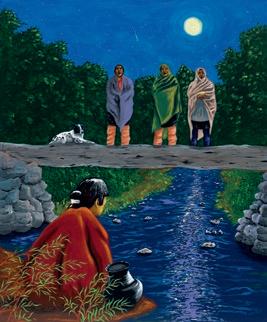
Red Willow Serenaders original acrylic/canvas, 36” x 30”

The Day of The Rabbit Hunt ledger drawing/colored pencil, 11” x 8”

A Night for Drumming and Singing ledger drawing/colored pencil, 15” x 6”


Spring In The Air giclée fine art print, 31” x 22”

Crop of Blue Corn ledger drawing/colored pencil, 10” x 8”
JONATHAN WARM DAY COMING, a Taos Pueblo Tribal member, is a world-renowned established painter, published author, accomplished illustrator, and father of two daughters, Carly Eva and Nuna Jade.
FURTHER CONTACT INFO & ART PURCHASE OPTIONS: Facebook: Jonathan Warm Day Coming Art | Instagram: @jonathanwarmdaycomingart Email: jwdc.business@gmail.com | Phone: (575) 751-1273 Online Store: jwarmdaycomingart.com
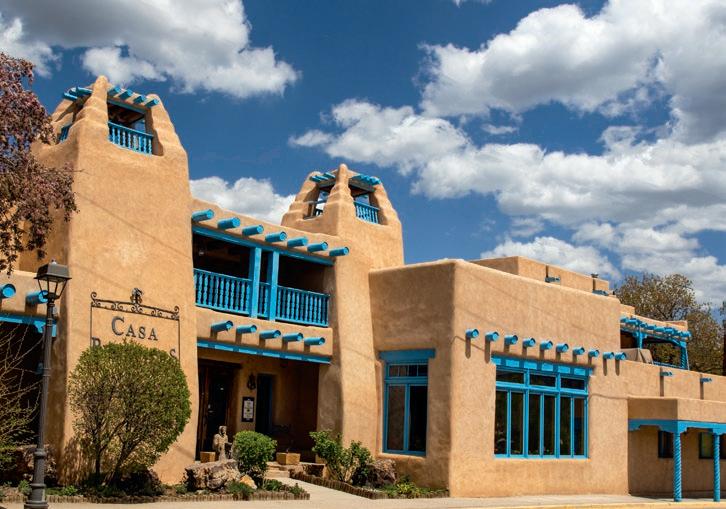
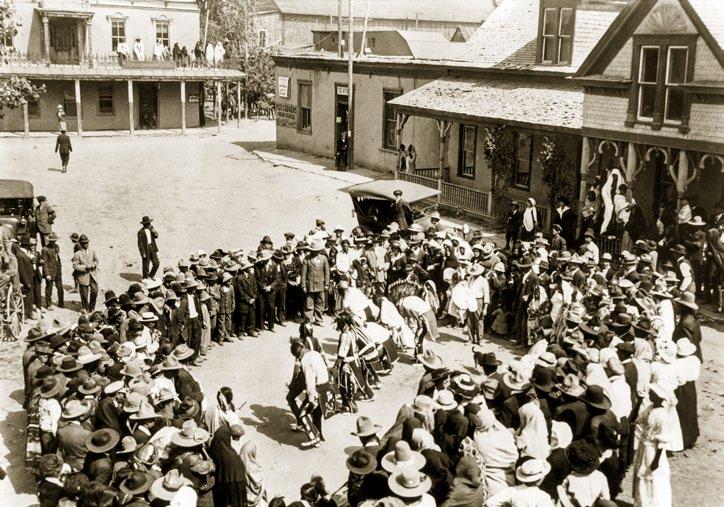
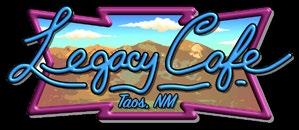

BY LYN BLEILER
ne can only imagine the impact Dennis Hopper had on the tiny village of Taos, New Mexico, when he blew into town on his Harley at the height of America’s most radical decade. Back then, he was considered a paranoid, pistol-packing local menace—a far cry from his eventual evolution into beloved denizen, which culminated in his designation as Honorary Mayor of Taos in conjunction with a town-wide celebration, Hopper at the Harwood, in 2009. Upon receiving the keys to Taos, Hopper said with a smile, “Who would have believed this in the ’60s?” Just over a year later, in June 2010, he was laid to rest near the village that had been his physical and spiritual home for nearly 50 years.
A lot has happened since.
Within weeks of his passing—and in the midst of considerable controversy—a retrospective titled Dennis Hopper Double Standard opened at the Museum of Contemporary Art in Los Angeles. Said to be the first comprehensive exhibition of Hopper’s artwork to be presented by a North American museum, the show was curated by Hopper’s friend, New York artist Julian Schnabel, and included photographs, paintings, assemblages, graffitiinspired wall constructions, billboard paintings, sculptures, and film installations.
Hopper was also a passionate art collector and his was considered one of the most extensive collections in the U.S. In a highly publicized feeding frenzy, it was parceled off and sent to auction in what fellow collector and artist Ron Cooper says is, “Tragic. One of the most unfortunate things that I have seen happen in the world of art in the last 40 years is the cheap auctioning and breaking up of Dennis’s collection.”
While his life’s accumulation of artwork has been flung to the far corners of the globe, writers and filmmakers are beginning to explore Hopper’s legacy as one of modern culture’s
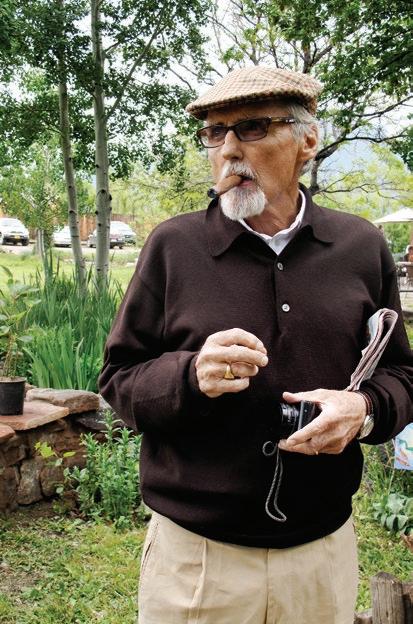
most controversial and contradictory figures. An independent film about his life in Taos titled The New Neighbor, directed by Kathleen Brennan and co-produced by Brennan and John Hamilton, was released in 2011. It has since been shown at Taos Shortz Film Festival, the Santa Fe Independent Film Festival, and The Female Eye Film Festival in Toronto. And this year a new biography by Tom Folsom, HOPPER: A Journey into the American Dream, was released by HarperCollins. The book’s dedication reads “For Dean,” a combination, says Folsom, of Hopper’s longtime friend Dean Stockwell, James Dean, and the rebel spirit revealed throughout the book—and indeed throughout Hopper’s life.
Now that several seasons of dust have settled on Hopper’s intentionally humble, dirt-mound burial site, his own words lend an interesting perspective—as do the reflections of his fellow artists and Taos friends—on Hopper’s influence as artist, art collector, and member of the Taos community.
Taos: The Early Years
High on the prospect of filming the first serious portrayal of
the turbulent times and counterculture of the 1960s, Hopper and his crew were literally “on the road” in search of film locations for a movie he had written. In a 2009 video interview with Rick Romancito of The Taos News, Hopper said, “I was coming down from Farmington with my production manager looking for locations for Easy Rider and we got down to Española and he said well, ‘If we take a left here we’ll go to Santa Fe. If we take a right we go to Taos, and Taos is an art community,’ and I said, ‘Well I don’t want to go to any damn art community, man! We are making Easy Rider.’ He took the wrong turn and I ended up in Taos . . . in the plaza, and this Indian guy came up to me as I was getting out of the car and he says, ‘The mountain is smiling on you. I know where you need to go.’ And he took me out to New Buffalo, which is what I was looking for— a commune—so that’s the way it started.”
“It’s obvious that Taos is Dennis’s spiritual home. They say he spent his lost years there, but I think those years were anything but. In fact, they may have been the years where he found himself.”
—Tom Folsom
Stockwell elaborates: “He did some locations around Taos for Easy Rider. I think that’s what got him hooked, because he was trying to decide between buying a ranch in Nevada and [Mabel Dodge Luhan’s] house, and I remember telling him, ‘Dennis, man, Taos is the place.’”
While he also kept a home in Los Angeles, for the rest of his life Taos indeed became the place for Hopper—although some
have often wondered why. “Maybe Dennis was on some sort of spiritual search, but the reality is that Taos was a rathole,” says artist Ron Davis. “You can take that scene in Easy Rider where Bobby Walker is at the commune at face value. There is something about that at the time maybe Dennis didn’t even know. Watching it now, it feels very ironic. Like, ‘Oh, we are going to plant seeds now.’ It was the ’60s, you know? [You’ve got] Timothy Leary saying, ‘We’re all going to have internal freedom, man.’ But we all know that that went out the window with Altamont.”
Self-proclaimed showman R.C. Israel arrived the same year as Hopper. “He opened a gallery in 1971, Dennis Hopper Works of Art, in Cabot Plaza. His objective was to show the community what artists were doing in New York and San Francisco by showing art from his own collection,” Israel says. “We knew the same artists, Bruce Conner and Andy Warhol and Edward Curtis, whose photos weren’t well known then. Dennis collected Lichtenstein, and he knew the New York artists of the ’60s and collected a lot of their work.”
Hopper also purchased the old El Cortez Theater in Ranchos de Taos, which was open to the public for a time, then open for premieres by invitation only, and ultimately became Hopper’s art studio. Israel goes on to recall, “After Dennis decided to close
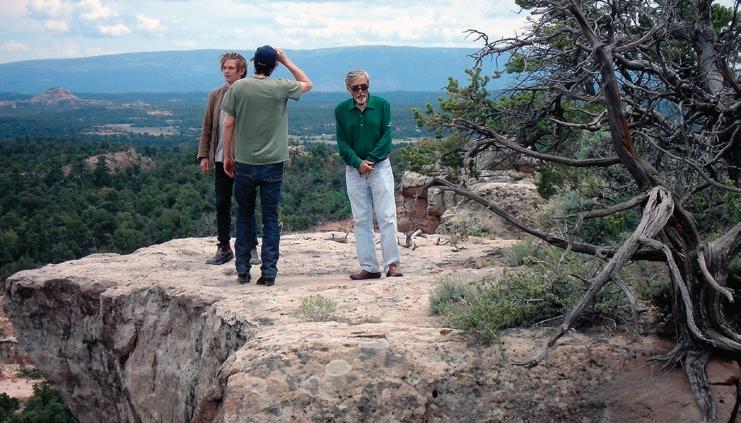
To mark the 40th anniversary of Easy Rider ’s release, the town of Taos hosted a “Summer of Love 2009” celebration. At the heart of the festivities were two exhibitions at the University of New Mexico’s Harwood Museum of Art: Dennis Hopper Photographs and Paintings and L.A. to Taos: 40 Years of Friendship , which Hopper himself developed.
As he told Rick Romancito of The Taos News: “When I first was told I was going to curate a show, I thought I’d start with anyone I had ever met in Taos. I’d start with Georgia O’Keeffe, and Andrew Dasburg and Dorothy Brett, and go all the way through. I suddenly realized that was a little ambitious, so I went back and I thought it through and realized that there were five guys that lived here that I had known for over 40 years.” Those turned out to be Ron Cooper, Ron Davis, Ken Price, Larry Bell, and Dean Stockwell. “I wanted to show what they were doing then, and what they are doing now,” Hopper continued. “I wanted people to see how long they’d been doing what they’re doing and how important it is in the world.”
The Hopper at the Harwood exhibitions, as they became collectively known, were shown from May 8 to September

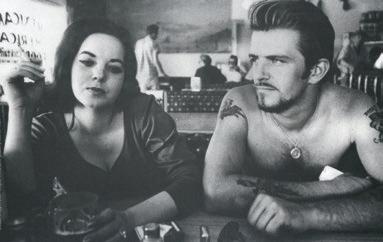
20, 2009. They garnered national attention and were widely attended. Curator Jina Brenneman told The New Neighbor filmmakers that she was surprised that Hopper, given his fame, would “give us the time of day.” Turns out he did more than that. “He became part of the Harwood family. He was very much at home here. He didn’t hesitate to spend time with us and to commit to being at the Harwood because he believed so much in the town of Taos.”

Larry Bell at the opening of Dennis Hopper’s one-man show Out of the Sixties at Sena Gallery West. He is standing in front of his portrait, which Hopper took in Los Angeles in 1964. Right: Portrait of Jack Smith, taken by Hopper in 2008, at Smith’s Reed Street Studios in Taos. Opposite: Dennis and Henry Hopper with German screenwriter Norman Ohler, Lindrith, New Mexico, 2009
“The Pilgrim: Chapter 33” Words and Music by Kris Kristofferson © 1970 (Renewed 1998) RESACA MUSIC PUBLISHING CO.

the theater, he took out all the seats except 52—because it is the number of seats he said were in the actor’s theater in New York.” He’s a Pilgrim and a Preacher and a Problem When He’s Stoned With the bad boy image firmly established in James Dean’s wake, along with the heady success of Easy Rider, Hopper spiraled out of control in the 1970s. There was the eight-day marriage to the Mamas and the Papas singer Michele Phillips and Hopper’s Taos arrest in 1975 for reckless driving, failure to report an accident, and leaving the scene. Not to mention countless stories of guntoting altercations with locals. Reflecting on those days in a 2006 interview with GQ, Hopper said, “I was doing half a gallon of rum, 28 beers, and three grams of coke a day just to get by.”
In an interview for The New Neighbor, Israel recalls that, “During the time Dennis was living at the Mabel Dodge Lujan house, he brought people in from all over the world and there was a constant party going on.”
With the round-the-clock partying and serious substance abuse came delusional thinking and distrust of epic proportion. “He just seemed very paranoid. Perhaps he was irrationally afraid of people, maybe suspicious of things that were going on that were probably quite okay,” says Pam MacArthur, former Director of Dennis Hopper Works of Art, in The New Neighbor “He carried a pistol because he was convinced that people were coming to get him.”
Artist Jane Mingenbach, a neighbor of Hopper’s when he lived at Mabel’s (a.k.a. the “mud palace”), says in the film, “He
would have this whole place always patrolled. He’d come over and say, ‘Okay, Jane, don’t worry.’ He was always afraid that these outside people or something were gonna beat him up.”
“He was hard core,” says Davis. “He went insane. He’d be up on the Mabel Dodge house roof shooting at imaginary helicopters. He was parading his addiction. Maybe it was a cry for help. And you have to think, too, he was a kid from Dodge City, Kansas, for Christ’s sake, with a Warner Brother’s contract at 18.”
But, as artist Jack Smith points out, “Wild behavior defines him as well as creative genius, but those were craziness years. Everybody was like that. Dennis wasn’t alone in that. We were all living a certain moment in time.”
Serious and Sober
Hopper officially bottomed out while in Mexico to play, of all things, the head of the Drug Enforcement Administration in a German film called Euer Weg Führt durch die Hölle (Jungle Fever). Folsom writes in his book, “Hopper found himself in his pajamas in the Mexican jungle after becoming fascinated with some outer-space holograms he saw flashing and dancing in his periphery . . . A few hours later, the sun came up on [Hopper naked] walking down a road into the Mexican city of Cuernavaca.” Soon he was on a plane to the States to undergo rehab.
“He had a lot of ups and downs in his career and made a wise decision to give up drinking about 30 years before he died

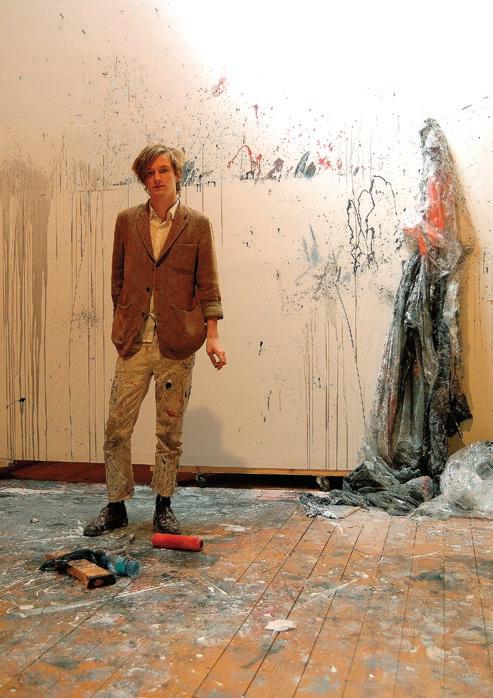
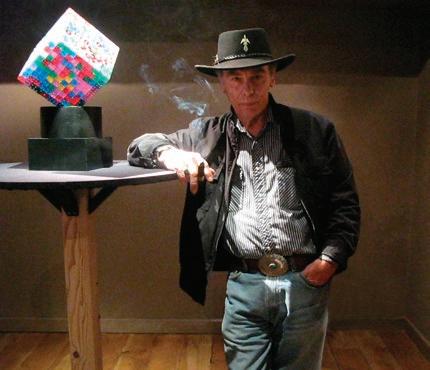

Clockwise from top left: Art and culture critic Dave Hickey heads the August 1, 2009, panel discussion in conjunction with the Hopper at the Harwood exhibition. Also on the dais are Larry Bell, Ron Cooper, Dennis Hopper, and Ronald Davis. Dean Stockwell with his piece Dice Cube, part of the exhibition at Ray Trotter’s R.B. Ravens Gallery, 2009. R.C. Israel at Dean Stockwell’s Ranchos de Taos home, March 2005. Henry Lee Hopper at his father’s studio at the El Cortez Theater.
“With Dennis it was always about the art and the artist. He was an incredibly creative person with an incredible generosity of spirit. He liked to play with others, and he played with others very well.”
—Jack Smith
because he could see that he needed to do that,” Israel notes. “I always admired that.”
Hopper’s life can be read as a series of contradictory roles, from James Dean’s protégé to fanatical madman to sober Republican who backed both Bushes in their presidential campaigns. Yet, when speaking with people who knew him, two consistent personality traits emerge: generosity and genius, a true Renaissance Man. Says Dean Stockwell, “Dennis always had a big problem turning people down. He was very generous, both with his time and talent.”

Smith concurs. “With Dennis it was always about the art and the artist. He was an incredibly creative person with an incredible generosity of spirit. He liked to play with others, and he played with others very well.”
Similarly, artist Larry Bell recalls, “He was a good friend for about 50 years. One of the last things he did was to come and see a show I had in Los Angeles. He came to my first show in LA, too. I was very touched.”
While working with him on the 2009 Hopper at the Harwood events, curator Jina Brenneman recounts how impressed she was with his determination. “Every ounce of his being was focused on doing or promoting creativity and imagination and not letting any naysayer get in the way. He wasn’t afraid of bucking the system. It didn’t matter if the person he met was famous or unknown—if they were involved in the creative process they were part of his tribe.”
As for his genius, Ron Cooper says, “He was a very talented multidisciplinary artist. I actually think that the so-called failed movie that he made in Peru [The Last Movie] was completely Duchampian and completely Jasper Johnsian. It was brilliant! And the reason it failed as a commercial film was because it was high art.”
Though Hopper was most known for his work in film, many people have equal respect for his talent as a photographer. “His real passion was his character assimilation in his acting,” Bell says. “He had the same creative passion in his photography.”
Clearly the creative outlet afforded by this work meant a great deal to Hopper, who wrote in a curator statement of his 2009 Harwood Museum of Art show LA to Taos: 40 Years of Friendship, “I never made a cent from these photos. They cost me money but kept me alive.”
The subject of an early Hopper portrait, Davis recalls meeting him in 1966 or 1967. Vogue had commissioned Hopper to take photos to accompany an essay on Los Angeles artists by John Coplans called “Art Bloom.” Davis was one of the subjects.

“Dennis came up to my studio in Pasadena to take a portrait, and asked me where I wanted to go for the shot. I said, ‘Well, there’s a mural on the wall of this deli with cows in a pasture and a ventilator in the sky.’ Hopper liked the idea. So I’m sitting there on a stool and he is lying in the gutter with a 35 mm camera rolling around to get a good angle. The connection was there between us. I was hysterical. He’d be like, ‘Move your hand over two inches’ or ‘do this.’ In other words, he directed.”
In 2006, Hopper prophetically told GQ of his photography: “I was doing something that I thought could have some impact some day.” A collection of photos chosen by Hopper and New York gallery owner Tony Shafrazi culminated in a volume titled Photographs 1961–1967 DENNIS HOPPER, published by Taschen. With essays by Shafrazi and Walter Hopps of Los Angeles’s Ferus Gallery fame, the book captures a decade of cultural transformation from the mundane—strangers in everyday settings—to the monumental, such as Martin Luther King on the legendary Civil Rights March from Selma to Montgomery.
Taking Every Wrong Direction on His Lonely Way Back Home
A wrong direction brought Hopper to Taos and on occasion
he bemoaned his decision to live there, once telling Davis that he went up and sat in D.H. Lawrence’s chair and “it didn’t do anything for my career.” However, ultimately Hopper chose to be buried in Taos.
Installation view of Dennis Hopper Double Standard at The Geffen Contemporary at the Museum of Contemporary Art in Los Angeles, July 11–September 26, 2010.
Curated by Julian Schnabel, it was the first comprehensive photographic exhibition of Hopper’s work to be mounted by a North American museum. The photograph that inspired the name of the exhibition, “Double Standard,” encompasses one entire wall, at left.
“It’s obvious that Taos is Dennis’s spiritual home,” says Tom Folsom. “They say he spent his lost years in Taos, but I think those years were anything but. In fact, they may have been the years where he found himself.” And, in doing so, significantly added to the Taos tradition of attracting trailblazing individuals.
“It should not be underestimated what Dennis did in helping to bring enormous creative energy to Taos,” says Smith. “Not just his own, but that of all the people who came to Taos to be a part of what Dennis himself created here. Without Dennis, Taos would have been a completely different place.” R
From the Summer 2013 issue
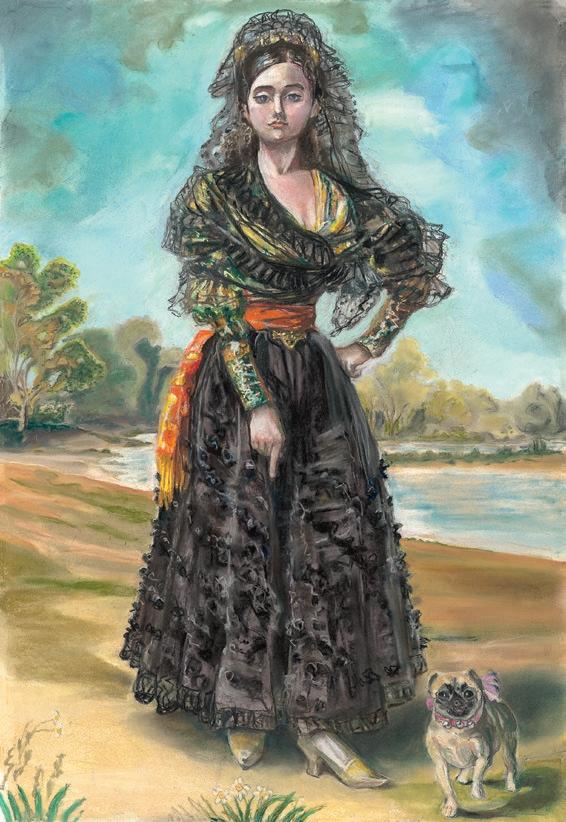

ILLUMINATING SOUND
Deeply influenced by his fascination for the natural world, modern physics, and the metaphysical borderlands between them, Taos native Sasha vom Dorp’s photographs capture the intersection of two energies: sound and light. His process allows the observer to see how sound vibrations “look” as they push through water, illuminated by the wave/particle makeup of sunlight.
Each limited edition archival-pigment print is titled according to its sound frequency, longitude, and latitude—the observation of a unique, complex moment of water droplet surface tension resonating, refracting, and magnifying simultaneously.
“These pieces teach something about what’s happening around us. There’s always something new to be discovered,” he says of his 25-year experiment, which has been featured on PBS.
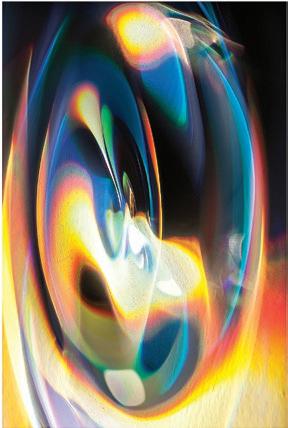
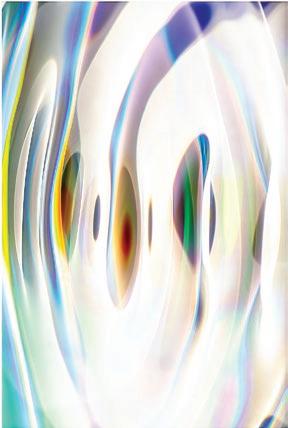
22.22 Hz Sunlight 2017-12-23 13:20:28.003 36°24 22”N 105°34’31”W
Archival pigment print mounted on aluminum, with artist-made frame and DNA certificate of authenticity; ed. of 3; 58” × 40”
23.23 Hz Sunlight 2021-12-02 10:42:16.025 36°24 22”N 105°34 31”W
Archival pigment print mounted on aluminum, with artist-made frame and DNA certificate of authenticity; ed. of 3; 58” × 40”
333.33 Hz Sunlight 2017-11-13 11:21:23.039 36°24 22”N 105°34’31”W
Archival pigment print mounted on aluminum, with artist-made frame and DNA certificate of authenticity; ed. of 3, 48” × 72”
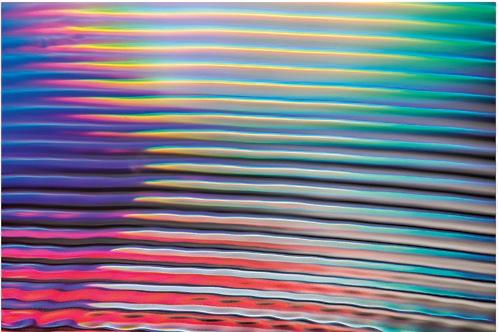



Larry Bell caught the Los Angeles art wave in the late 1950s and has been successfully navigating those often turbulent waters ever since. Instead of looking to art history for guidance like their New York counterparts, Bell and a handful of renegade Southern California artists found inspiration in their immediate surroundings—lackluster architecture, tacky billboards, and the prevalent hot-rod and surf cultures of their day.
“There is a tendency out here to not care about art history because we’re a young city,” conceptual artist John Baldessari told filmmaker Morgan Neville in the 2008 film The Cool School: How L.A. Learned to Love Modern Art. “We don’t have to deal with our past because there is no past.” Employing nontraditional methods and materials—from assemblage of found objects to spray paint and techniques used in surfboard construction—the L.A. artists were making a significant splash. And for Bell, this approach was a perfect fit.
Bell was born in Chicago but raised in L.A.’s San Fernando Valley, in an environment virtually bereft of a modern art culture. At 17, a brief but pivotal stint at Chouinard Art Institute starting in 1957 would change the trajectory of his life. In Bell’s day, the school was known as “the mouse house” because of its reputation as a training ground for Walt Disney Studios. “I went off to art school with the intention of learning to be an animator,” Bell says. “But I liked the painting instructors better than the technical ones, so I changed my whole focus to fine art.”
At Chouinard, Bell was impressed as much by the forward-thinking and unconventional lifestyles of his peers and instructors—especially early installation art pioneer Robert Irwin—as he was by their work. “Larry was thrilled by the racial and social mix of the student body, as was I,” classmate Dean Cushman recalls. “It was truly exciting to be around so many different lifestyles, opinions, and talents.” Mere miles from the whitebread values of the then-ultraconservative San Fernando Valley of his youth, 19-year-old Bell was suddenly immersed in a tidal wave of cultural upheaval.
Initially influenced by the Abstract Expressionists, particularly Willem de Kooning, Bell began by painting on canvas but quickly became interested in hard-edged shapes. A part-time job at a framing shop further shifted his focus. Working around glass gave him the idea to stick a piece onto one of his canvases. “It looked great,” he says, “and I eventually decided that I was just making illustrations of volumes when what I really wanted to do was make the volumes themselves.” Thus began the creation of glass cubes and large glass installations—and the lifelong fascination with light, reflection, and surface that would define Bell’s career.
As early as 1961, Bell’s work was shown at L.A.’s Huysman Gallery on La Cienega Boulevard, along with Ed Bereal, Joe Goode, and Ron Miyashiro, in a group exhibition titled War Babies: 1937–1961 . One year later his first solo show opened across the street at the legendary Ferus Gallery. Bell soon joined John Altoon, Billy Al Bengston, Robert Irwin, Ed Kienholz, Ed Moses, Ken Price, and others as the youngest member of Ferus’ stable of rock star–style artists. Their sweeping significance is illustrated in The Cool School
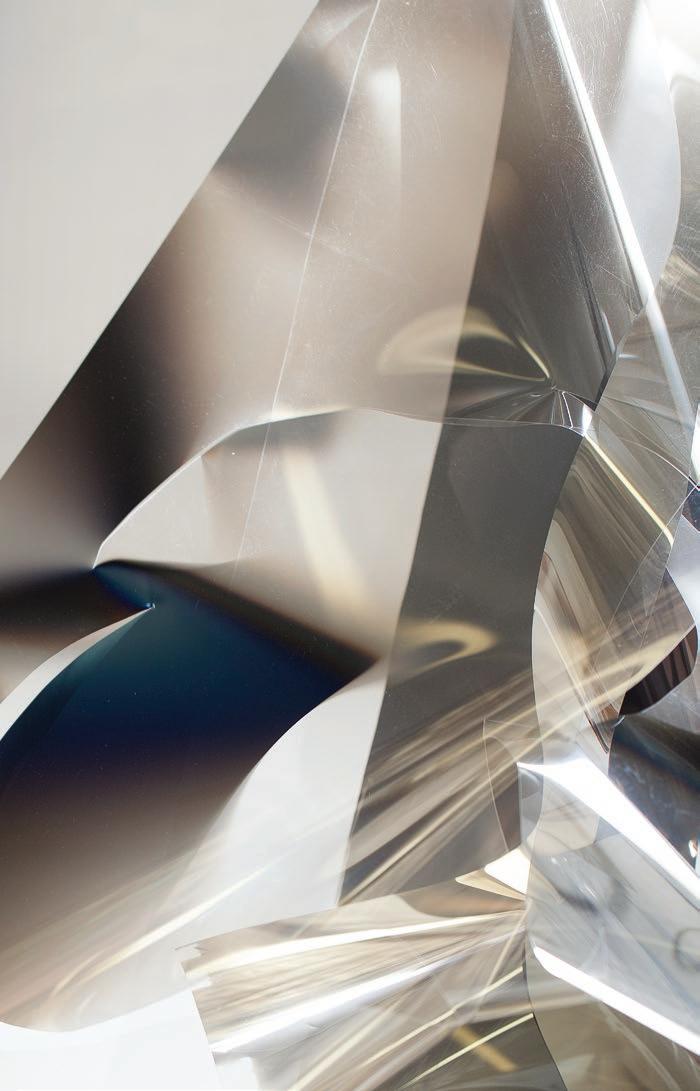


documentary. Almost overnight, it seemed, L.A.’s once bland, conservative cultural landscape had transformed into a vital art scene thanks to Bell and his fellow artists.
In 1964 gallery owner Sidney Janis noticed Bell’s work and included the glass cubes in a group show at his gallery in New York City. This, in turn, led to a sold-out solo show at the Pace Gallery in 1965 and a brief move to New York. But, missing friends and the West Coast lifestyle, Bell moved back to California in 1966, settling into a studio in what was then Venice’s low-rent artist district.
In The Cool School documentary, art critic Peter Plagens recalls, “In those days in L.A., there were two kinds of artists: those of us who were teaching, who were basically wusses because we wanted a salary and security and stuff like that . . . and the real artists, guys who were living by their wits and renting storefronts down in Venice.”
Curator Hal Glickman adds, “Wallace Berman was the one who said you could be an artist, a real artist, in Los Angeles, and that there you could live a life of poetic poverty.”
As the 1960s morphed into the 1970s, Bell worked in the thick of an increasingly exciting time to be a young artist in L.A. Along with a range of cultural icons, he was chosen to be included on the legendary album cover of The Beatles’ Sgt. Pepper’s Lonely Hearts Club Band, designed by Peter Blake. And Bell’s 1971 acting debut was documented for posterity in a
lead role in one of Ed Ruscha’s obscure art films, Premium , a 24-minute, 16-mm romp featuring model Léon Bing, comedian Tommy Smothers, and designer Rudi Gernreich.
But the art scene was also notoriously social, and the demands to see and be seen, however enjoyable, were taking their toll. Thinking a change of pace would benefit his art, in 1973 Bell followed longtime friend Ken Price to Taos, New Mexico. “I’m a party guy,” Bell says, with a boyish grin. “If I allow myself to be distracted by poker and hanging out at the bars, it breaks my concentration. In Taos there is much less temptation. It’s easier to control one’s distractions here.”
In Taos, Bell continued to gain international recognition for his early explorations in light and illusion, from glass cubes and large glass sculptural installations to applying similar surface techniques to paper and canvas in the Vapor Drawings and Mirage Paintings series. He even made a foray into furniture design in the early ’80s. Asked by longtime friend Frank Gehry to collaborate on a commission for Cleveland client Peter B. Lewis in the late ’90s, Bell developed a series of calligraphic stickmen, some of which have been transformed into large bronze figures he calls Sumer Figures. Like his furniture making, these stickmen seem to have no parallel in either Bell’s earlier work or his current explorations into light and surface, until one learns that he had a talent for drawing cartoonlike characters in high school.
Still, the series Fractions (small collage compositions made from pieces of previous works on paper) that followed was in keeping with Bell’s earlier passion. As the late Douglas Kent Hall observes in an essay titled “Strange Days: Conversations with the Doctor,” “No matter what new material he explores, Bell keeps coming back to glass. He attempts to translate the qualities he achieves on glass to other surfaces, other materials. For example, his series of elegant vapor drawings on paper, their thin coatings identical to those he lays onto glass, assume a mysterious other-worldliness.”
Although he was enamored with the life and career he had built in Taos, in 2004 Bell found he was once again missing his West Coast friends and lifestyle. By an odd twist of fate, the same studio he had back in the day was available for rent. The current owners had made improvements, and though the rent had increased a bit from the $75/month Bell once paid, he nonetheless jumped at the chance to lease it.
Some artists might find the duality of keeping two studios unsettling, but for Bell the arrangement is grounding—and each location has its advantages. “Taos is much more livable than Venice, but Venice has a unique creative energy and magic,” he says. “In the studio I have there, I have been incredibly productive. It may have less to do with the places themselves than with my focusing and not being distracted. Sometimes I just sit and look at stuff. Or just not think about working until the muse comes around and kicks me out of my chair.” But these days, whether in his Taos studio or Venice space, Bell says, “I’m there to work.”
As for the commute, the 74-year-old Bell enjoys the road time as a chance to unplug, with his American bulldog, Pinky, in tow as copilot. “I turn off the radio, take out my hearing aids,
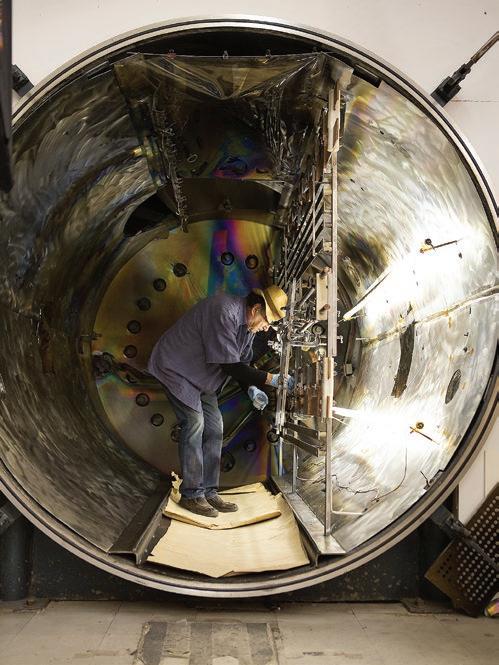



Top, left: A light knot in progress inside Bell’s nine-ton thermal evaporative vacuum tank. Bell creates his light knots using a process similar to the thin-film deposition technique used to coat the insides of potato chip bags. Reflective metals and silicon monoxide are set on heating terminals, shown in top photo. The vaporized metals are then blown out into the vacuum, where they naturally float to adhere to the surface of the Mylar form hanging inside.

Bell’s Taos studio occupies half of what was once a commercial laundry catering to hotels and restaurants—large enough to hold rows of his light knots, his vacuum tank, and assorted other laboratory-like equipment. The setup once inspired late writer/photographer Douglas Kent Hall to call it a “combination warehouse and space station,” while Taos author John Nichols once likened it to Willy Wonka’s chocolate factory.

and just drive. It is as close to a religious experience as I get—16 to 17 hours of meditation and random thoughts. I get some great ideas on the road, but I usually forget them,” he says, grinning. “The only distraction is my CB radio because when you are out there, the only important news is what’s happening a mile ahead of you.”
It’s easy to trace the evolution of much of Bell’s work. Pieces are sequentially numbered, and materials from one series tend to show up differently configured in new work. Bell’s most recent series, Light Knots, are three-dimensional kinetic forms made of Mylar film that Bell cuts, folds, and coats with vaporized metallic particles in a nine-ton vacuum tank in his Taos studio. “Light Knots came right out of these things,” Bell explains, gesturing toward a piece from his Mirage Works series. “Those have 50 or so layers of Mylar, but I began manipulating individual sheets making sculptural forms. [The light knots] just fell out of the work. In a strange way the work makes itself—and it is always honest. [A kernel of future art] is always locked inside the [present] work . . . you just somehow have to find it. But the next thing is always there.”
As Bell points out in an interview for a recent show in Southern California, the light knots reward the patient viewer, revealing themselves over time as they revolve elegantly with the slightest air current and display infinite gradations of color, opacity, and reflection as well as myriad variations of form. Bell’s son, videographer Oliver Bell, documented the knots’ undisturbed reaction to natural light. “It was wonderful!” Bell enthuses. “Ollie set up his camera in the studio one evening and let it run all night. The next day he came running in and said, ‘You’ve got to see this.’ Holy cow! I hadn’t seen the light play on them that way. It was a gift from the work to me.”
Over the years, writers and critics have lumped Bell’s work into various camps, calling him, among other things, a Perceptualist, Abstract Expressionist, and member of the Light and Space movement. “I’ve never really thought of myself as a Minimalist either, but I’ve been included in that, too,” he says. “I just appreciate the fact that anyone considers my work in any way. I have always just trusted the work. I have been included in a lot of different movements, and in most cases I never even thought about the intellect of a movement regarding what I am doing. Everyone’s perception of a trip is different, and I see my trip in a different way than most people.”
However Bell’s trip is perceived, his work continues to garner worldwide respect and is included in the Museum of Modern Art in New York, the Solomon
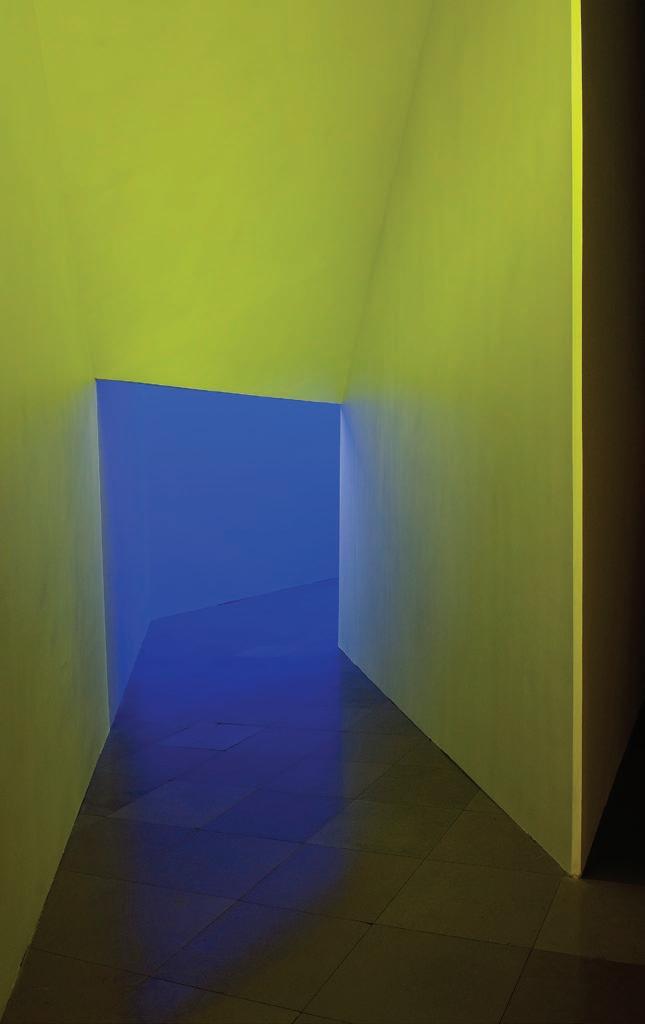


R. Guggenheim Museum, the Albright-Knox Art Gallery in Buffalo, the Los Angeles County Museum of Art, the Art Institute of Chicago, the Massachusetts Institute for Technology, the Tate Modern Gallery in London, Museum Ludwig in Cologne, the Stedelijk Museum in Amsterdam, the Walker Art Center in Minneapolis, the San Francisco Museum of Modern Art, and the Whitney Museum of American Art.
The Taos studio brims with activity this year, as Bell’s long-standing personal assistant and loyal friend, Lois Rodin, juggles many calendars and time zones. Artwork from exhibits in France and Southern California are returning to Taos, while other shows are being organized. The London gallery White Cube Bermondsey will exhibit Bell’s work in mid-October. Obviously pleased, Bell says, “They want to show works on paper and my collage work, which no major gallery has ever been interested in before. Collages, vapor drawings, and the light knots.”
Meanwhile, Bell and veteran studio assistant, artist Cody Riddle, are busy inventorying various glass pieces in storage to create a composition for a possible yearlong installation at the Chinati Foundation contemporary art museum in Marfa, Texas. “One thought being considered [for the Marfa show] is to tie the glass sculptures into the light knots in some manner because the knots reflect, absorb, and transmit light, just like the glass. But in the glass it is all based on right-angle relationships, whereas there are no right angles in the knots,” Bell explains.
In the midst of yet another exciting run with the Light Knots series—and with national and international exhibitions on the calendar—Bell is still successfully riding that wave he caught decades ago in Los Angeles. When asked about highlights of the ride so far, he assumes a reflective tone. “My life is filled with highlights. Just getting up in the morning is a highlight. Having work where the energy is self-propagating, where the energy you put out creates even more energy, is a highlight, as is a good work run that lasts six to seven months. Stumbling over accidental things and finding that the thing I stumbled across is actually the next step is always exciting.” Pausing thoughtfully, Bell adds, “My trip has been full of these things.” R
Light Knot 7 (2012), polyester film vacuum-coated with aluminum and silicon monoxide, fishing line, and hardware, from the Weightless exhibition at Larry Bell Venice Studio Annex, 77 Market Street, Venice. Opposite: Leaning Room (2011), environmental light installation with leaning walls, black lights, and florescent paint, from the exhibition Larry Bell in Perspective, Carré d’Art, Musee d’Art Contemporain (Nimes, France).


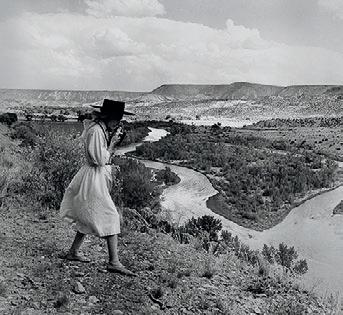
The Pueblo people of New Mexico believe that the earth is imbued with the breath, thoughts, and feelings of every person that has ever placed a foot upon it. They say that the earth is alive with the spirits of those who have walked across its body: the faraway past vibrates in the soil, and the stories of the long-ago people lie scattered like stones upon the places that once harbored them.
Standing upon the wide, luminous space of earth that is the Piedra Lumbre Basin [piedra lumbre means “stone of light” or “stone of fire”] in Northern New Mexico, one is privy to the whispers of a thousand years of stories. A chorus of voices—prehistoric Native American, historic Tewa, Ute, Navajo, Hopi, Apache, Hispanic, and Anglo—echoes from the rock walls whose gleaming, unworldly color gave the region its name. R
Excerpted from Valley of Shining Stone: The Story of Abiquiu (1997) by Lesley Poling-Kempes
From the Summer 2018 issue


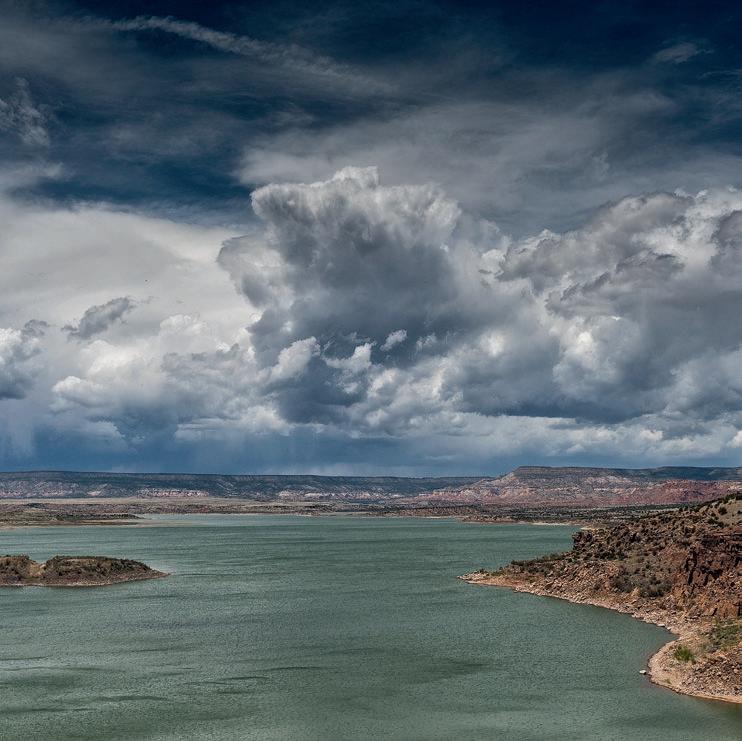
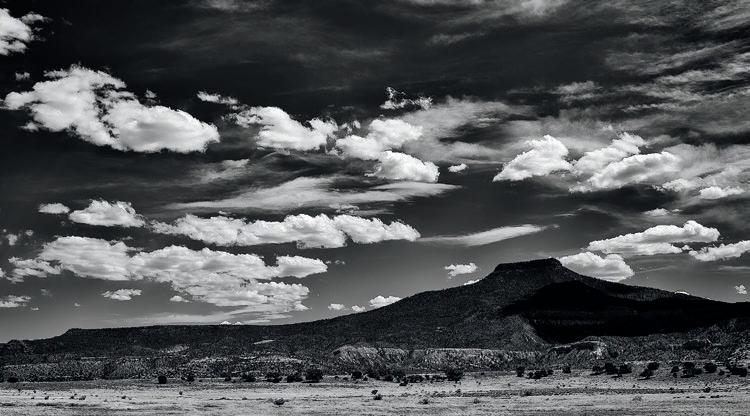
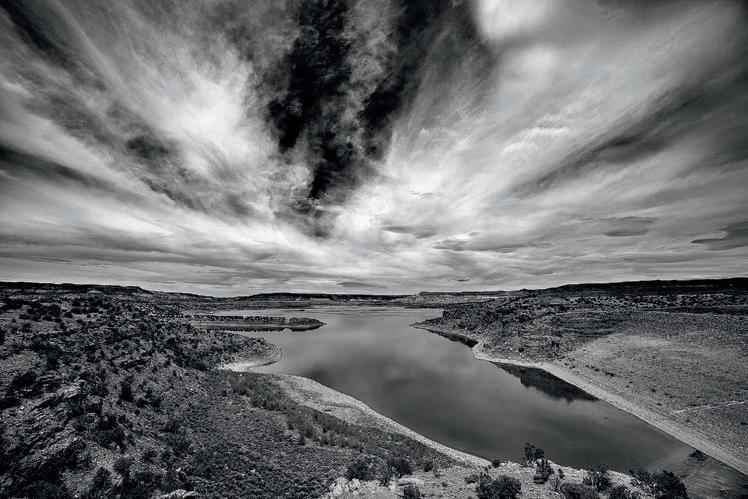


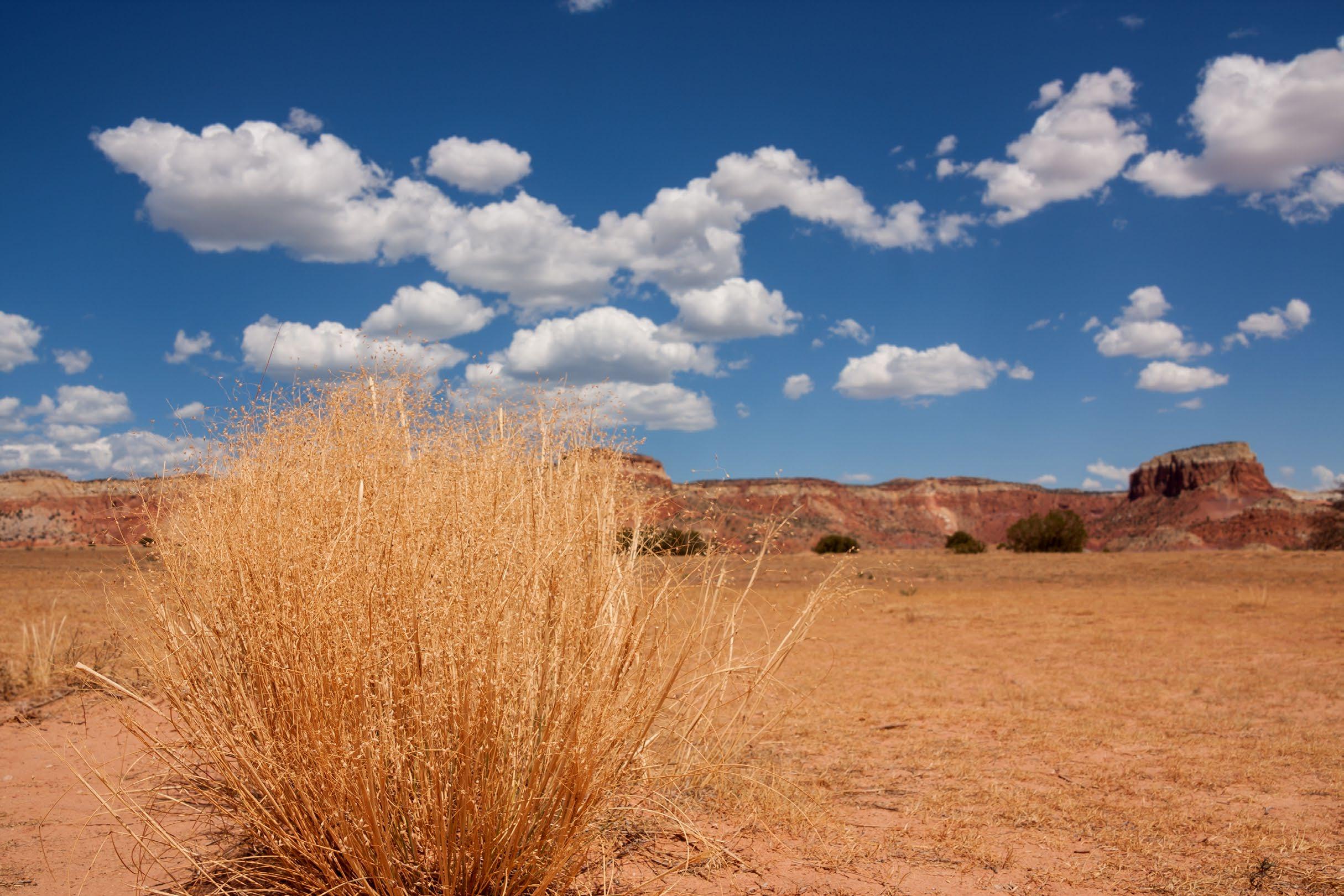
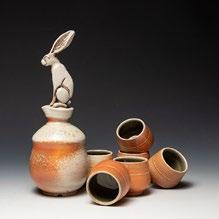













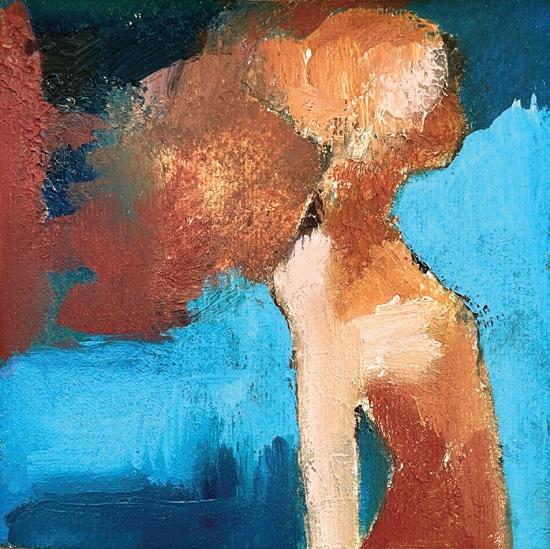
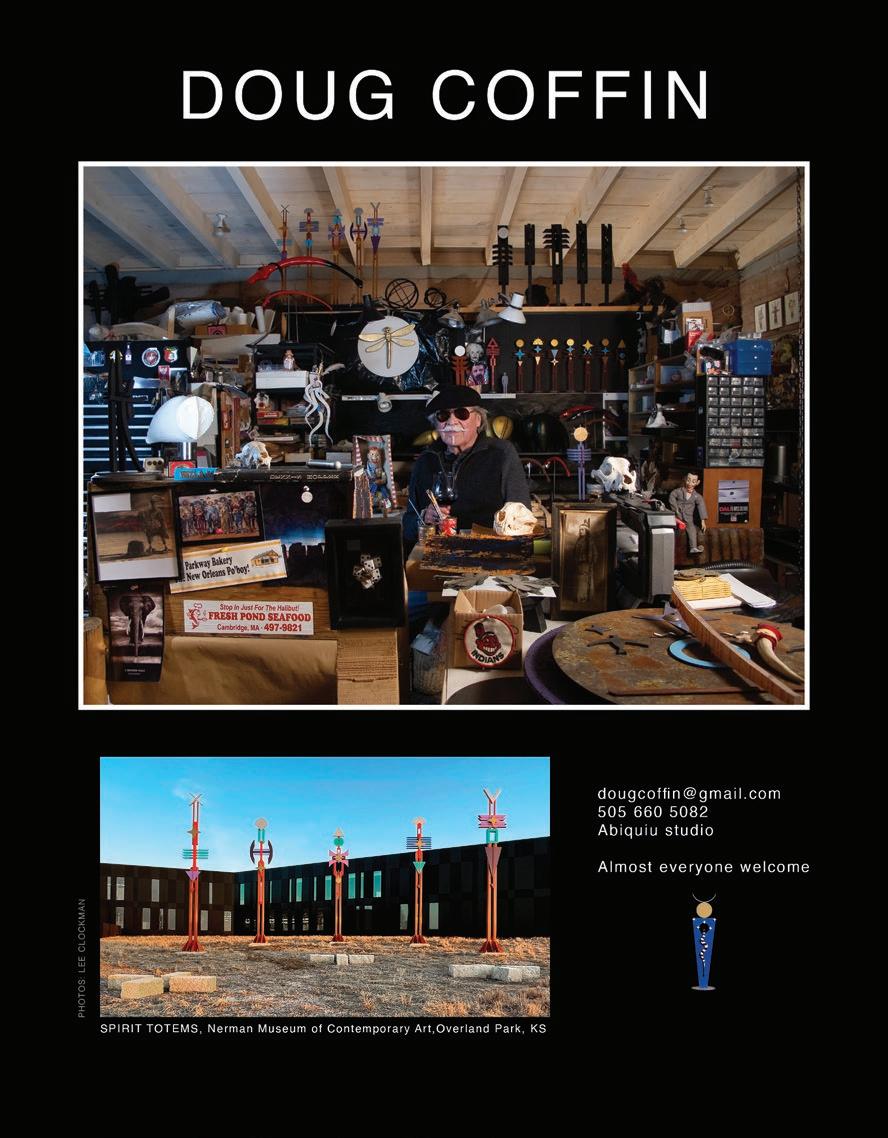
This group of paintings draws inspiration from the high desert of New Mexico. Part of this inspiration involves inner landscapes that take root in the imagination when one is within one of these places. These “inner landscapes” are a dialogue with dreams, memories, thought fragments, and streams of consciousness. By the contextual placement or overlay of inner and outer, I hope to convey my own thoughts about the nature of imagination and to achieve a sense of the imagination’s movement against a relatively unchanging environment.
I’m interested in calling attention to the act of painting as well as to how one understands visual conventions by combining self-referential marks and forms with more traditional rendering. I hope these juxtapositions enliven the surface and create an ambiguous space that causes the viewer to question his/her notions about perceptual space. With these works, I hope to provide the viewer choices that lie between dualities, like cultural and natural, perspectival and encompassed, near and far, representational and abstract, mythic time and geologic time, movement and stillness.










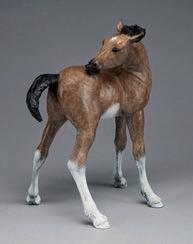

















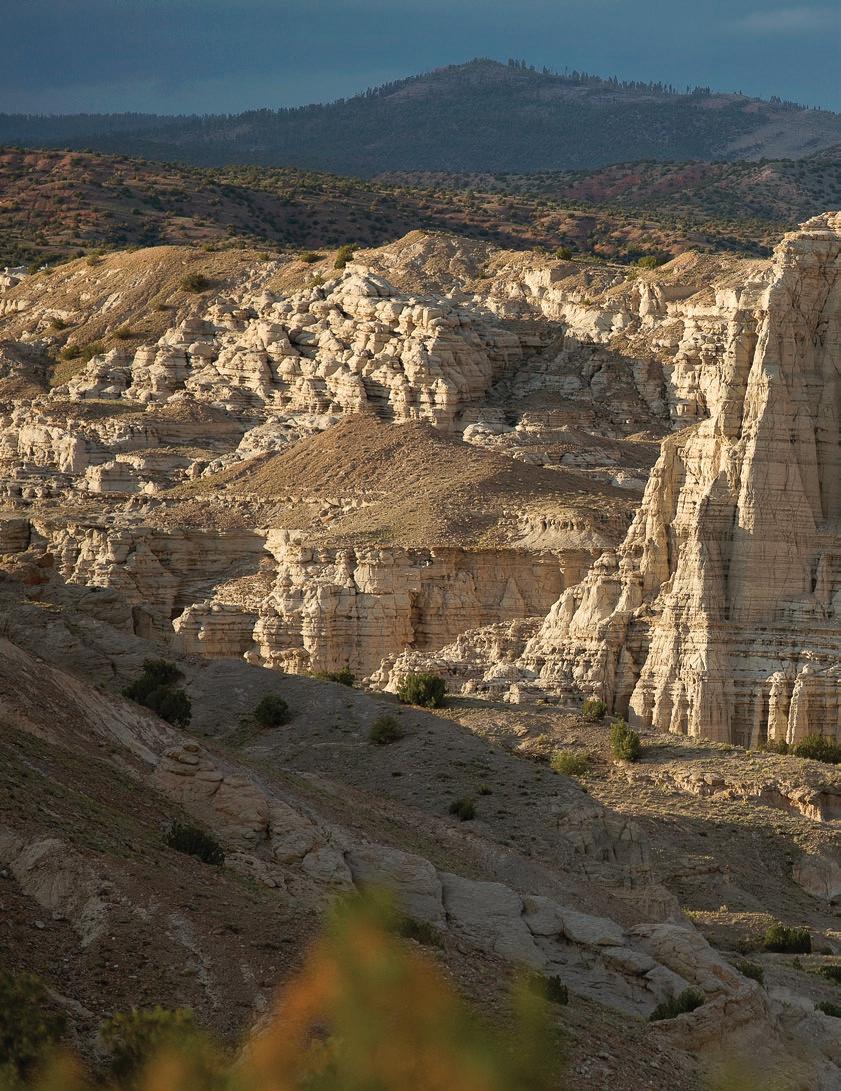
BY WESLEY PULKKA | PHOTOS BY KATE RUSSELL
Just as sculptor and painter Doug Coffin and his filmmaker wife, Kaaren Ochoa, fell in love with each other 23 years ago, they also fell in love with the gorgeous views from Coffin’s small rented house on a hillside near Abiquiu.
“We tried to buy this place from the owner for nine years, but she wouldn’t sell,” Coffin says. “Finally, while Kaaren was on location shooting Proof of Life and we had already planned to build a new house elsewhere, the owner told us the property was on the market and we had a week to make an offer.”
Never mind that it had to be redesigned, reconstructed, and expanded to fill their needs. The stunning views overlooking an idyllic valley surrounded by distant mountain ranges trumped everything.
The first expansion of the original 1,000-square-foot building was a yearlong project that began in 2001. It added a guesthouse and Coffin’s spacious, high-ceilinged studio. The final expansion, now nearing completion, began in July 2012 and houses Ochoa’s office, an impressive ethnic art collection, as well as beautifully appointed living quarters for the couple and their guests—in total, 4,500 square feet of space, not counting a comfortable portal.
Entrance to the home is through a rough-hewn antique front door that opens into a kiva-shaped foyer dominated by one of Coffin’s signature totemic sculptures, a heroically scaled abstracted figure integrating solar, lunar, and Anasazi symbolism. To the right of the foyer is the living room, whose
steel gray walls and concrete floors lend an air of stylish urbanity to a space that could rival luxuy apartments in some of the world’s great cities. Some notable pieces in the art-filled room include an African Bobo mask from the Ivory Coast, an elegantly carved African antelope sculpture with upward sweeping horns, Dan Namingha’s mixed-media painting titled Montage #6, and a shelf holding painter R. C. Gorman’s first ceramic piece, a lustrous black vase enhanced with one of the artist’s signature Navajo women. A longtime friend, Gorman traded Coffin for the piece.
The rest of the home follows suit, mixing contemporary and classic New Mexican architectural and design elements into a sophisticated yet welcoming space perfect for living, working,

The spectacular views from the couple’s backyard reveal an ever-changing play of light and color against the jagged cliffs and rolling hills.
and entertaining. “When we first purchased the property, it was a hippie homestead sorely in need of an upgrade,” says Coffin. Now, it’s the realization of their dream home.
With the assistance of architectural designer John Johnson, Ochoa on board as a design consultant, and enormous help from Coffin’s oldest son, Brian, an artist and master builder, the couple was able to effect the transformation of the original space into something they truly love. “We began with a series of my computer sketches outlining what we were after and then showed them to John, who sorted through structural requirements while adding ideas and suggestions of his own,” Ochoa says. “When he brought the drawings back with his additions and details, we loved how it all came together.


During the planning stages, Doug and I would often come to the same conclusion without discussing things, so the whole project was pretty harmonious.”
For Coffin, their house, with its hand-carved doorframes and myriad custom touches, has become an expression of their relationship. And thanks to the space now available to safely and beautifully accommodate their art collection, the home is also a sanctuary for their artistic legacy. “These objects are markers along the path we have taken, and each one represents a story about our experiences,” Coffin says. “Now that they are out for everyone to see, they will be able to tell their stories.”
The renovation required a level of sacrifice on everyone’s part, especially Coffin’s, who lost almost a year of studio time. “But Kaaren and I need these peaceful and beautiful surroundings to control and focus our creative energies,” he says. “The serenity of this beautiful place allows me to absorb architectural concepts, cultural artifacts, and universal symbols, as well as phrases from jazz or blues music. As I spend time in the studio, everything becomes a rhythmic play of color and form.”
That music could serve as a catalyst for his work was a discovery Coffin made several years ago, when he started painting while listening to his favorite Duke Ellington album. Since then he has collaborated with pianist Roger Kellaway and clarinetist Eddie Daniels, who once brought their music to the Coffin-Ochoa home for a private concert. In August 2013 Coffin was invited by Daniels and Kellaway to paint while they played together at the Detroit Jazz Festival.
Of inspiration in general, Coffin says, “I throw the dice every time I walk into the studio. I’m always looking for something new, and I never know how a piece will end up when I begin. I use books, music, and other artists’ work in order to find new symbols and elements to fire my own imagination. My work also draws inspiration from the land, the culture, the people


Three 12 x 12-foot pieces of steel that had been sitting in Coffin’s welding shop were used to create the portal at the guesthouse entrance.
Top left: Eight feet in diameter and three feet deep, the couple’s adobe wine cellar maintains a temperature of around 55 degrees and can hold up to 60 cases of wine. “Until our friends show up, that is,” Coffin jokes. Top right: The entryway to the home opens onto a foyer holding Coffin’s mixed-media sculpture Sun/Moon Shaman
and their attitudes, and the natural beauty of New Mexico. I’ve found a home here.”
Coffin grew up near Lawrence, Kansas, and is of Potawatomi and Creek heritage. At the age of eight, he had a paper route that took him through the Haskell Indian boarding school campus, where his father was an athletic coach. The school owned the large-scale sculpture by Chiricahua Apache artist Allan Houser titled Comrade in Mourning, completed in 1948. Rendered in white Carrara marble, the work honoring Haskell students who died in World War II was Houser’s first major public sculpture commission. “I was awestruck by that piece and couldn’t imagine how it was made,” Coffin says. “Later on I was thrilled to
When

on
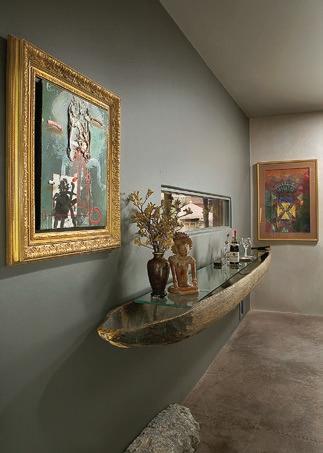
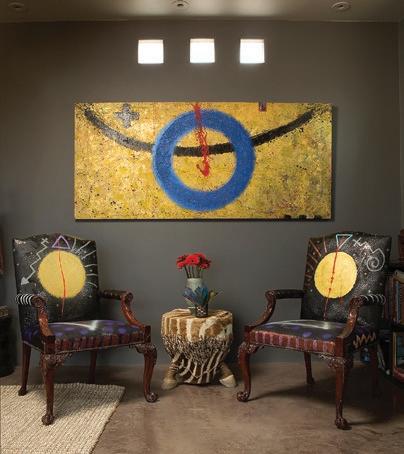

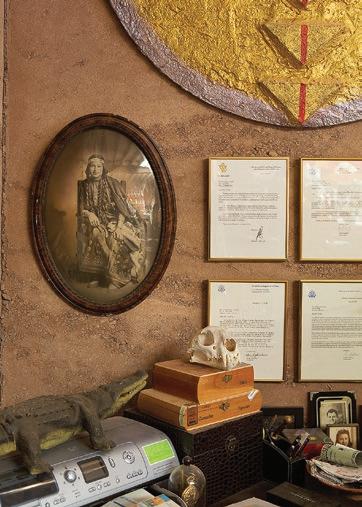
meet Houser and his son Bob Haozous when I was casting at Shidoni 35 years ago. Houser and I actually worked together on his sculpture, and we became friends.” The trio also spent time together when Coffin taught classes at the College of Santa Fe in 1979 and the Institute of American Indian Arts (IAIA) in 1980.
Coffin majored in sculpture at the University of Kansas and earned a master of fine arts degree in metalworking at Michigan’s prestigious Cranbrook Academy of Art, founded in 1932 by Finnish architect Eliel Saarinen and Detroit philanthropist George Gough Booth.
Though Coffin was originally inspired by an encounter with a single artist’s work, he considers himself a mainstream artist who learns from all masters—Michelangelo to Henry Moore— as well as from the ethnographic arts of Africa, Europe, Asia, and the Americas, which he collects with such passion.
“I study power objects from tribal cultures around the world, including breastplates, medicine and war shields, totem poles, icons, and other objects that are designed to create a sacred space in the mind of the viewer,” Coffin says. “I treat these things with a great deal of respect for the intention of their makers.”
Coffin’s affinity for the universal language of symbols has brought his work before an international audience and clientele, and has resulted in shows and commissions in Italy,
Ecuador, Paris, and throughout the United States. Honors include his 1997–2002 participation in the U.S. State Department’s Art in Embassies program and exhibits at the National Museum of the American Indian in New York. Coffin also displayed a monumental painted steel totem in Twentieth Century American Sculpture at the White House: Honoring Native America, a 1997 Rose Garden exhibition of 12 American Indian artists.
His partner in love and the arts, Kaaren Ochoa, has been employed in the film industry for more than 30 years. She began her career as a screenwriter, has worked in sound and lighting, and has served as an editor and grip. She is credited as assistant director of more than 33 films, including The Milagro Beanfield War, Crazy Heart, and A River Runs Through It. Her television series credits include Breaking Bad, Law and Order, ABC’s Murder in the Heartland, and the Lifetime Television film Georgia O’Keeffe. Although she has enjoyed working on feature films and television specials, Ochoa says her true passion is writing, directing, and producing documentaries. “You are essentially writing
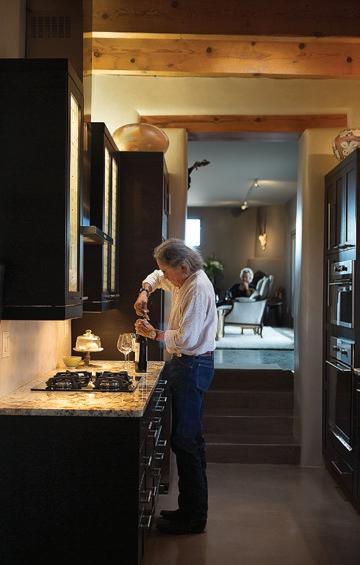
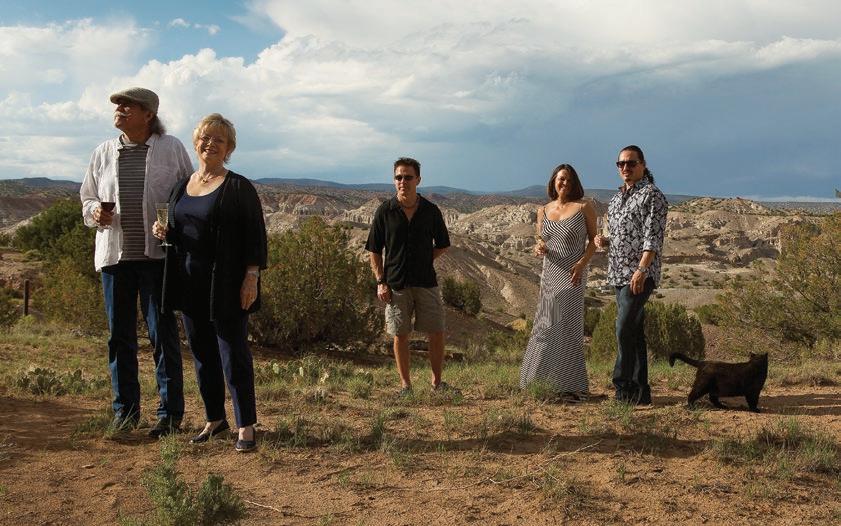
a story with all of the attendant research, fact checking, and educational potential of a book,” she explains. “But in film you have the ability to tell a story visually, to show people a broader perspective than they may be comfortable discovering on their own. If we do our job well as artists, we have the ability to uplift, educate, and inspire people to build a better community and eventually a better world.”
One of her favorite early projects was The Alien Game, a 1978 documentary on migrant workers that exposed the falsehoods surrounding immigration from Mexico and the true economic impact of illegal workers. The film was part of ABC’s La Raza series and was nominated for a Peabody Award.
Since the late 1980s, she has partnered with her daughter, Chemen Ochoa, on a number of projects, including Gettysburg and The Milagro Beanfield War. They are also currently working on an as-yet-unnamed film that is still in the works. “I love working with Chemen because she is a professional who has a true understanding of the task at hand, and we just key off one another very smoothly,” says Ochoa.
Now 42 and married, Chemen moved to Santa Fe after graduating from New York University at age 21, with the hope of working with her filmmaker mother. “We are the first successful mother and daughter directing and production team since Ida Lupino and her daughter, Bridget, broke the glass ceiling four decades ago,” Chemen says. “We work on the set with such
synchronicity that production people seldom know that we are related.”
Ochoa also has a son, David, who likewise works in the film industry. (In addition to Brian, Coffin has two other sons, Erik and Gabe.) The inception of this big, happily blended family— as well as Coffin and Ochoa’s shared dynamic vision—occurred on an icy January evening in Santa Fe in 1990. The two were escaping the winter chill inside the comforting warmth of El Farol when a mutual friend, the actor and musician Frederick Lopez, introduced them. Ochoa says she and Coffin chatted for a while and then got up and danced the night away. A shoot in California interrupted their budding romance until that April, when they began dating in earnest.
“What makes it work between Doug and me is that we both understand the focused dedication it takes to create something of value,” says Ochoa. “When I’m on a set, I have to track every detail and coordinate the cameras, support personnel, and action in front of the cameras. Doug can visit the set and enjoy what I and the others are doing without interrupting the flow.”
Coffin is looking forward to getting back to his full-time studio endeavors in a space filled with artifacts, early pieces, travel memorabilia, and several new works in progress. The shelves are laden with bits and pieces of colorful materials, tools, bottles, and other objects of interest, all reflecting the intricacies of Coffin’s imagination.

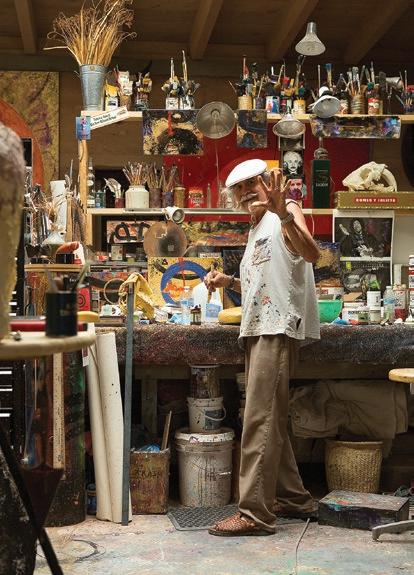
Coffin in his studio, working on the finishing touches to Sun/Moon Shaman. “I put my focus and energy into getting this house completed,” he says, “so for about a year I didn’t make any art. Now that our dream come true is done, I get to be an artist again— but on a different level. We actually have closets, actually have a kitchen that works. It’s very comforting and allows me to have a more pure vision.”
“I owe whatever success that I’ve had to my mother and father, who truly supported my dreams,” he says. “After my father passed away, my mother helped me in many ways to earn an education and to follow my heart. They left me with wonderful memories that carry me through the day.”
Though now in their mid-sixties, the couple has no plans to slow down. Ochoa is hard at work on a new script for a one-hour pilot set in New Mexico in 1949, as well as the screenplay adaptation of crime noir writer Charlie Newton’s novel Start Shooting.
Coffin and Ochoa’s beautiful dream home and studio on the hillside overlooking a tranquil valley continues to burn inside with the creative fires of two people who love what they do and where they do it. R
From the Fall 2013 / Spring 2014 issue


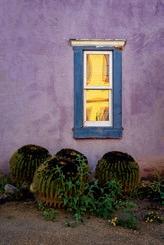




When you visit Madrid, New Mexico, be prepared to slow your roll. And that doesn’t just mean watch your speed, although you’ll need to downshift to 20mph once you hit the town limits. Nestled in a canyon between towering hills once rich with coal, Madrid is one of the most picturesque communities in the country, and it’s worth spending at least a few hours, if not a day or more, to take in its local color.
Located halfway between Albuquerque and Santa Fe along the Turquoise Trail, Madrid was established in 1890 as a coal-mining town. At the height of its boom, during World War II, it was home to nearly 3,000 people, most of them working to help meet the rise in demand for coal as a result of the war. By the end of the 1950s, however, the boomtown went bust, its mine abandoned, its residents off to greener pastures. For nearly two decades Madrid languished, a relic of a bygone era.
Then, starting in the 1970s, artists and various intrepid “dropouts” began to reclaim the abandoned buildings, first as places to live and then as places of commerce. It wouldn’t be long before visitors were drawn to Madrid’s quirky, iconoclastic vibe, a destination for day trippers looking for a stop along the scenic “backway” to Santa Fe from Albuquerque.
Today, people from around the world flock to Madrid to tour its galleries and curio shops, to buy jewelry made from the famed sky blue turquoise that is still mined in nearby Cerrillos, and to explore the town’s unique architectural history, which includes original 19th-century miners’ homes and a 1920s ballpark that was renovated a decade later as a WPA project—still the site of rousing community baseball games. Culinary options abound as well, including at the Mineshaft Tavern, long a favorite spot for burgers, brew, and boogying.
Yearly special events include a crawfish and blues fest in May, Gypsy Fest in July, and an art tour held over two weeks each September. Christmas is an especially spectacular time to visit, when the entire town decks the halls with ornate decorations and over 150,000 lights. Festivities kick off with a parade on the first Saturday in December and gallery open houses that extend to every weekend throughout the month. And be sure to check visitmadrid.com for special events held to celebrate the town’s 50th anniversary in 2025.
Perhaps no other tourism hot spot has grown so organically out of the desire to reclaim community from the ravages of history. To walk the streets of Madrid is to experience a part of that history, but also to marvel at its reinvention as an ongoing art project, a testament to the power of creativity, tenacity, and communal spirit.


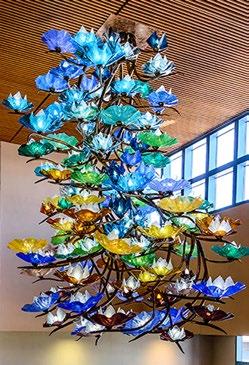
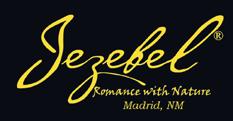








BY WESLEY PULKKA | PHOTOS BY ROBERT RECK


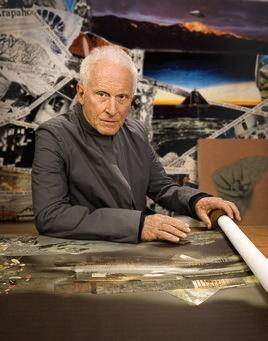
nternationally renowned architect Antoine Predock moves through his life and work like a romantic time traveler, incorporating geology, geography, cultural artifacts, current events, weather patterns, astronomical cycles, personal experiences, and the history of architecture into each design.
Though he maintains satellite studios in Los Angeles and Taipei, Taiwan, Predock has been living and working in New Mexico for more than 50 years. His 12th Street studio near downtown Albuquerque is a complex of interconnected rooms, a large patio, and outbuildings filled with computer workstations, an array of printers, three-dimensional replicating machines, a 20-member design team, a museum-quality collection of restored antique and classic motorcycles—all in running condition—and countless clay, plastic, balsa, and foam-core models, drawings, and collages.
Predock’s physical surroundings reflect his complex romantic vision, reliance on intuition, and openly intellectual approach to collaborative and meticulous creativity. All these factors have made him, at a youthful 73, the recipient of countless architectural commissions, honors, and awards, including the prestigious American Institute of Architects 2006 Gold Medal for his lasting influence on the theory and practice of architecture, and the 2007 Smithsonian Cooper-Hewitt, National Design Museum’s Lifetime Achievement award.
From his iconic La Luz Community project (1970) on Albuquerque’s West Side to the New School of Architecture + Planning Building on the University of New Mexico’s Albuquerque campus (1999–2007), Predock has shared his inspiration garnered from the desert.
“New Mexico has formed my experience in an all-pervasive sense. I don’t think of New Mexico as a region. I think of it as a force that has entered my system, a force that is composed of many things,” Predock says. “Here, one is aimed toward the sky and at the same time remains rooted in the earth with a geological and cultural past. In Australian Aboriginal dreamtime, song lines traverse the land and describe the geography in a way that is totally rational and yet mystically poetic. Similarly, the elemental power of this place is inescapable. Lessons learned in the American Southwest apply anywhere in the world—my ‘regionalism’ is portable.”
“The collage allows us to focus our attention while embracing a new set of problems and challenges,” says Predock. “Following the cultural and geographical immersion, quick sketches will emerge, leading to the clay model, which becomes the actual building.”

To Predock, the spirit of his work is the enigmatic quality of the desert. “You think you’ve got it; you think you understand,” he says. “Then you turn over a rock or crawl under a larger rock and you discover other worlds, other realms within.”
In a section cut from a highway, for example, a sectional diagram of the earth is revealed: At the bottom is pre-Cambrian granite, overlaid with limestone. In geologic time, other sedimentary strata such as sandstone and ocean-bottom fossils turn up. Then cultural artifacts emerge in just a fraction of an inch—compared with miles of geologic datum. In the Southwest, this cross section first offers
traces of the Anasazi, followed closely by remnants of later cultures: the Spanish conquistadors, 1930s hubcaps, then beer cans, McDonald’s wrappers, and the residue of future technologies. For Predock, that cut is a poetic diagram of time and the impetus for an investigative process leading him to his creations.
Predock began his studies in engineering at the University of New Mexico’s School of Architecture and Planning, which was just beginning to grow into the major component of the university that it is today. At the time, professor of architecture Don Schlegel was also teaching engineering and caught Predock’s attention with his
absolute passion for architecture. Predock credits Schlegel with lighting the flame that moved him into architecture. Eventually, Predock left UNM, with Schlegel’s blessing, for more intensive studies at Columbia University’s graduate architecture program in New York. After that, he returned permanently to New Mexico.
Through his studies, Predock was inspired by the projects of Frank Lloyd Wright and worked during the summer of 1958 in Texas with Charles Adams, a Wright associate. From Adams, Predock learned to pursue details born of larger ones. Predock was also inspired by architects Mies van der Rohe and Le Corbusier and wished he’d learned more about Alvar Aalto. Louis Kahn became a focus and, eventually, along with Wright, Predock’s strongest influence. But, he says, nothing would have happened without Schlegel’s early inspiration.
While studying at Columbia, Predock became a student of dance greats Jennifer Masley, Merce Cunningham, Yvonne
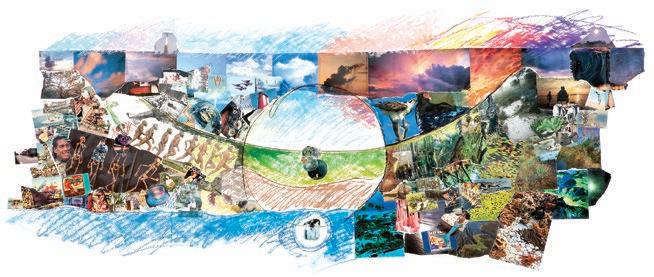

Rainer, and later Anna Halprin. Through the profound experience of witnessing and participating with bodies moving in space, Predock learned to see his buildings as processional events, or choreographic events that become an accumulation of both perceptual and experiential vantage points.
Predock’s love of choreographed movement explains a bit of his passion for motorcycles, too. He has ridden bikes since the 1960s and has been known to take trial runs aboard full-bore racing bikes on the highway. Predock owns, among many other wonderful machines, a 1929 Indian Scout that is nearly identical to one highly modified by New Zealander Burt Munro, who set the unbroken 1967 world record for an Indian motorcycle on the Bonneville Salt Flats in Utah. Predock has a photograph hanging in his studio of another Bonneville record attempt, which shows the rider lying prone on the motorcycle at top speed with his legs outstretched behind him to reduce wind drag.
“Architecture is a fascinating journey toward the unexpected. It is a ride— a physical ride, and an intellectual ride. I like to think about machines and technology in relation to landscape and architecture,” Predock said during a discussion of his design of the Nelson Fine
Arts Center on the Arizona State University campus in Tempe. “The idea of a motorcycle in the landscape confirms a kind of closure for me, a technological, experiential closure.”
It is that collapse of time and compression of cultural history in Predock’s work
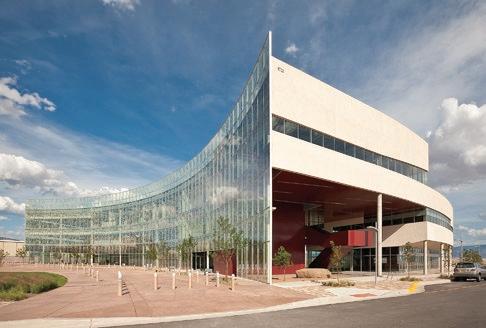
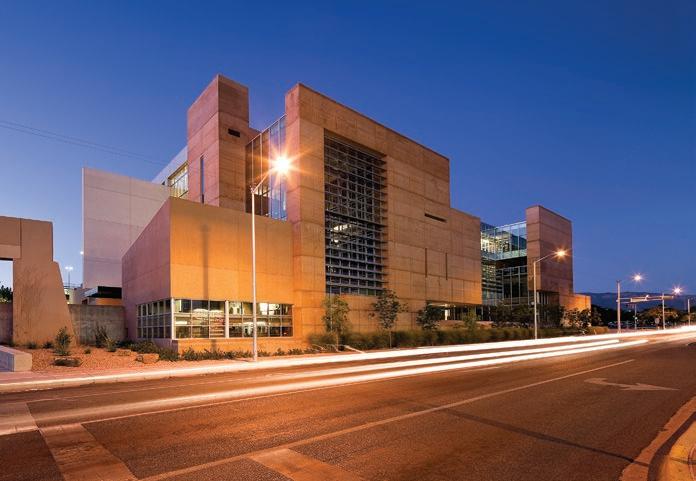
that makes his buildings instant classics no matter how modern, contemporary, or futuristic they might appear at first glance.
To begin architectural designs, Predock creates a great collage to illustrate the history of the site, its cultural roots, and current events. Predock and his team consider the topography, geology, climate, political history, and every other aspect of the site.
“The collage allows us to focus our attention while embracing a new set of problems and challenges,” he says. “Following the cultural and geographical immersion, quick sketches will emerge, leading to the clay model, which becomes the actual building.”
Predock explains that when he and his team are working on projects—he asserts the importance of the collaborative component in his work—they remind themselves that the project is a timeless encounter with another place, not just a little piece of land. All the readings accumulated and assimi-

lated there, even those imagined in the past or the future, collapse in time and become the raw material with which they interact.
Two of Predock’s latest projects are the World Mammoth and Permafrost Museum in Yakutsk, Republic of Sakha, part of the Russian Federation; and the National Palace Museum branch in Chiayi, Taiwan.
An excerpt from Predock’s Mammoth and Permafrost Museum proposal explains, “The museum is a landscape abstraction from myths of Sakha cultures and their spiritual predecessors. The building expresses the seasonal cracking and shifting of the ground plane that continually reawakens the memory of previous epochs beneath. The silhouette of the building suggests the sheer power and bulk of the mammoth and marks the vast Siberian landscape with an iconic and lasting symbol.”
Predock’s museum design includes transparent walls and ceilings that appear


“Lessons learned in the American Southwest apply anywhere in the world— my ‘regionalism’ is portable.”


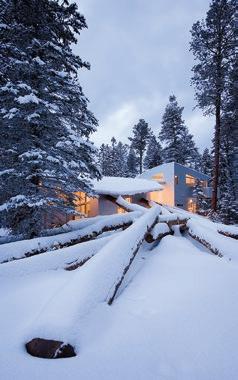
to be made of ice, referring both interior and exterior to the environment of the mammoths, the permafrost that preserves their remains, and the crystalline glaciers that led to their demise.
In the design of the Palace Museum, Predock amplifies the meeting of water and land with a long walkway across water leading into the building. And the structure itself seems to rise from the morning mists in its symbolic linking of the Mountain of Longevity and the Sea of Happiness.
Predock is fascinated with the sudden and long-term cultural changes that might completely alter the use of a building, such as ancient pagan Greek and Roman temples being converted to Christian churches virtually overnight.
“Once a structure is built, one loses control over how it may be used sometime in the future,” he explains. “If designed well enough, one hopes a building will retain enough of its original content and aura to maintain its original presence.”
Predock takes those initial design parameters very seriously. The New School
Predock is fascinated with the sudden and long-term cultural changes that might completely alter the use of a building, such as ancient pagan Greek and Roman temples being converted to Christian churches virtually overnight
of Architecture + Planning at UNM was conceived as a building that would not only provide space for classrooms, lectures, and related events but also provide inspiration for architecture students.
Predock believes students can be engaged and actively learn from the intrinsic qualities of the spaces in which they work. His UNM building features solar apertures that align with equinox and solstice events throughout the year. With its exposed infrastructure and built-in cosmic
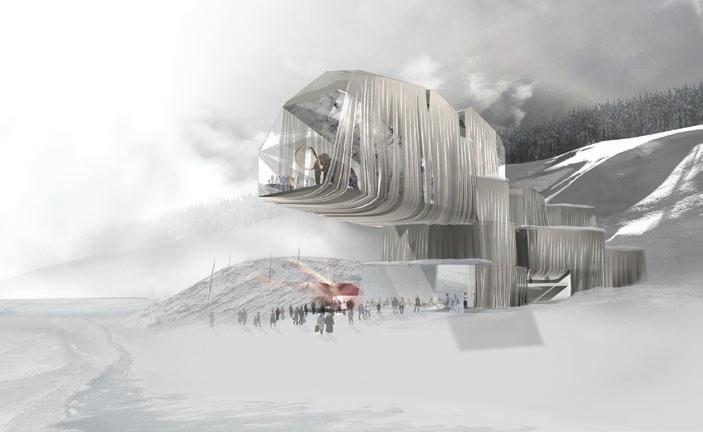
clock, the building might also teach future architects to collapse time and compress cultures as they spend creative hours within its walls.
Predock is married to sculptor and painter Constance DeJong, whose work echoes, in the broadest sense, Predock’s penchant for romantic monumentality and time transcendence. DeJong sculpts in a variety of metals and in sizes described as reductive minimalist. She enjoys an austerity of form with a deadpan presentation. Her ambitious, architectonic works are often lit from within by carefully placed polished surfaces. That radiant inner glow beckons viewers to suspend thoughts of scale and place, and even the consideration of overall design. She wants the viewer to surrender to the fleeting yet timeless moment that allows one to fill the occupied space, no matter how grand or diminutive, with a contemplative silence.
DeJong’s sculpture and chemical “paintings” on metal integrate organic and geometric patterns, shapes, and lines in a way that activates the viewer’s
eye, lending the work, though physically static, a sense of movement.
In a 2003 interview with Gus Blaisdell for his book Constance DeJong Metal, the artist described meditation as a conduit to reality. She said her meditations are neither spiritual nor religious. She finds the practice to be a way to see through the nonstop fiction of one’s thoughts to what is actually occurring.
Both DeJong and Predock seek a truth in their chosen art forms and approach creativity with a strong sense of integrity and respect for the entire process. To assimilate their work, the artists truly embrace the tactile and visceral experiences inherent in their methods.
“When I am involved in making something, an object, the making has a quality of innocence,” says Predock. “The gestural aspect of, say, making a clay model has an affinity to one’s handwriting with the presumed innocence of one’s signature. That signature is part of the physiology of making something. In my case, whether it is
a painting, a clay model, or a collage, it becomes the beginning, the source of the project. My process remains connected to spirit through the body and to the personal space that the body defines.
“The trick,” he continues, “is to get through the thicket of what [Louis] Kahn called ‘the measurable in the making of a building’ to come out the other side so the built work expresses that initial physical and spiritual impulse.”
Predock’s complex philosophies and his treatment of time are both fleeting and expansive. That roar you hear fading into the background? That’s Predock as he accelerates toward his 1950 Vincent Black Shadow’s top speed of over 150 miles per hour, hugging the gas tank as he goes. It’s just another wind-in-the-hair ride through desert microclimates, geological time, enervating hairpin turns, and long straightaways for New Mexico’s favorite “regional” architect. Ride on Antoine, ride on. R
From the Fall 2009 / Winter 2010 isssue
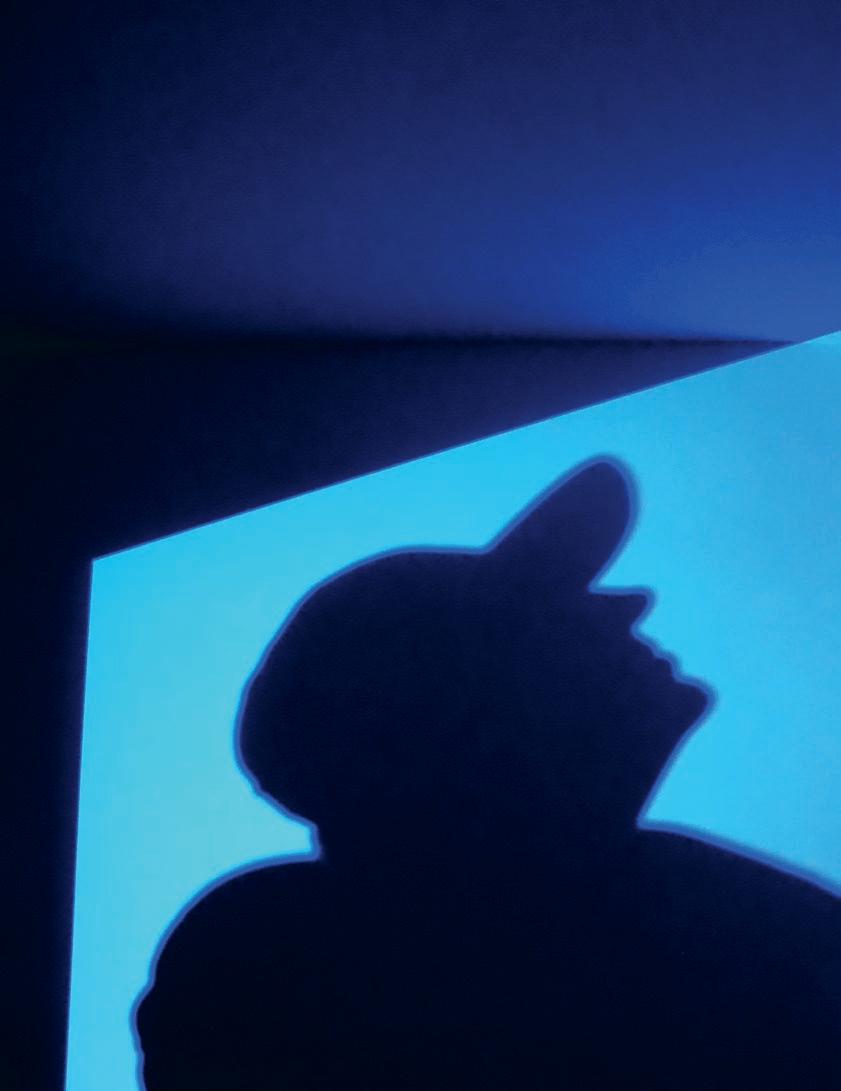

BY DEVON
If you’ve ever seen a Sarkisian film or video sculpture, you know straightaway that there’s very little about his work that’s narrative or even conventionally entertaining. It’s arty, and intentionally so. It’s a heady, one-way journey that plays on opposites. It’s also challenging in a way that can upend our faith in the images moving across the rectangular boxes in front of our eyes, whether on the wall or in our hands.
“We’ve always assumed these images belong in a square,” says Sarkisian from within the big, box-like studio he recently built near his northeast Santa Fe home. “Why does that convention persist? Why are we looking at rectangles? I’m trying to blur the line between the viewer and the image plane in a way that causes the viewer to get involved in a more experiential way. So suddenly the viewer stops staring in this reverie and says, ‘What am I staring at?’”
In his 1999 piece White Water, for instance, we hear liquid-y sounds and see a stainless steel bowl turning to milky water in a whitish room. Out of the bottom emerges a naked woman (Sarkisian’s future wife), who then turns on her side. She seems to smile. After a minute or so, it’s over. The previous year he released Dusted, perhaps his most famous piece, showing a naked couple confined inside a white cube. They wipe at it from the inside and, while an ethereal female voice whispers inaudibly, clear a view into their world. We see into their cell, which rather resembles an orgy as the cube becomes more and more smeared with their hand wipes. The cube is about the size of a love seat, and its dimensionality compels us to peer in, walk around, and perhaps wipe its sides ourselves.
Playing with the form as much as the medium of what we call television, Sarkisian’s videos really just remind us of the enormous plasticity of moving imagery. He shoots most of his films himself. He uses equipment no more sophisticated than that found at the community college. There are amazingly few special effects, if any, in most of his pieces, and virtually no computer-generated sleight of hand. He’s a filmmaker, an artist filmmaker, whose genius resides in how he arranges images and projects them. It’s why his films are as much sculptural as they are digital, and it’s what separates his work from video artists like Doug Aitken and Bill Viola.
The result is works that rely on us being there. Their sense of humor and playfulness, their contradictoriness, come through viscerally. Most have a trompe l’oeil nature and M.C. Escher-like quality that, as the neuroscientist Vilayanur Ramachandran has said of perceptual paradoxes, “titillate our senses and challenge all our notions of reality and illusion.”
When Sarkisian started out somewhat accidentally on his artfilmmaking path a little over 20 years ago, it was well before the omnipresence of the internet and smartphones, before streaming and bingeing, and even before TiVo and DVDs, when television was still in thrall to major networks and advertisers. Back then it was dominated by shows like Murder, She Wrote, Home Improvement, and ER, and MTV ruled the cable television landscape.
In fact, Sarkisian’s anti-TV inclinations came from his resistance to music television. “MTV turned me off from technology,” he says. “That’s partly why I’ve used video—to work against the influence video has on us as viewers. I use it to its own demise. To undermine it.”
The challenge, of course, is not being absorbed, like almost everything else, into TV’s insatiable maw.
As media critic Mark Crispin Miller put it in his essay “Deride and Conquer,” part of Watching Television, a 1986 Pantheon anthology on popular culture, there’s a “spectatorial posture which TV requires of us,” and “our spectatorial inaction is the only sort of action possible.” Or as New York Magazine critic Matt Zoller Seitz wrote just over a decade ago in response, television “had incorporated self-awareness, even a mild pantomime of self-criticism, as a means of defusing distrust and ensuring its own survival.”
Ironically, Sarkisian grew up without electricity or running water, and with a spotty TV that occasionally got PBS (and little else). This was the 1970s in Cerrillos, New Mexico. His parents, painter Paul Sarkisian and sculptor and ceramist Carol McPhee Sarkisian, had relocated from Pasadena to New Mexico when their only child was six. In California, the Sarkisians had a rich circle of friends: physicist Richard Feynman, who played bongos in their living room, as well as curator Walter Hopps, filmmaker Stan Brakhage, actor Dean Stockwell, and artists Ed Kienholz, Llyn Foulkes, and Richard Pettibone.
After a brief stay in Albuquerque, the couple bought Cerrillos’s old schoolhouse. Paul took the gym as his studio, Carol the schoolhouse. The gym also served as a roller skating rink, where Georgia O’Keeffe liked to go when she visited. “We’d roller skate together in our gymnasium, she in her long black robes,” recalls Sarkisian. O’Keeffe would call him “Sonny” and sometimes gave him rocks and colored glass. Carol made some of her black gowns, several of which are now in the O’Keeffe Museum vault, and when O’Keeffe’s vision faded, she went to Sarkisian’s father, who helped her devise a system of painting to compensate for her failing eyesight.
In addition to growing up around colorful folks, Sarkisian found creative stimulation in the New Mexico outdoors. “When you grow up like that your senses are heightened,” he explains. “To have come from that childhood and now working with technology is interesting. It’s a contradiction but it also infuses what I’m trying to do with purpose. To get back to that kind of thinking through technology.”
As a kid he was always in touch with what was happening in nature. There were no screens, literally or metaphorically. Now, though, he’s using screens to come full circle, in order “to create a sense of self-awareness, rather than numbing one’s selfawareness,” he says, echoing Miller and Seitz. “Conventional screens are meant to suspend our self-awareness. And the degree to which they do is their success. I’m doing the opposite of that.”
During his teens the family moved to Santa Fe, and Peter entered Santa Fe Prep (before that he’d gone to all the alternative schools—Sun Mountain School, the Children’s Workshop,

Dusted (1998), painted wood cube, video, and audio, illustrates the interpretive visual experience of



the Brunn School). Things crystallized for him at Prep, where the school’s photography teacher, Alex Traube, became his mentor. “He was incredibly influential to me,” recalls Sarkisian. Traube encouraged his students to be creative. When Sarkisian’s father brought home a Sony Betacam Camcorder one day, Peter and his buddies knew that film would be their calling. Most of them, Sarkisian and Mike Becker among them, went to film school and never looked back. Becker and Sarkisian were especially industrious. By senior year they’d struck a deal with a Mr. Albright, manager of the Commonwealth Cinemas chain. They’d design his theater’s ads, and in return, he’d let them into The Lensic Theater at midnight twice a week to film their own version of Siskel & Ebert. “We got on the mailing lists of all the studios and they’d send us press kits and U-Matic three-and-a-quarter-inch tapes and we’d edit them at La Farge Library,” remembers Sarkisian, laughing. “We also had a newspaper, The Paper Screen. We got into every movie for free.”
Sarkisian then went to the California Institute of the Arts for film. After graduating, he returned to Santa Fe and made a film for admission to the American Film Institute and its directors program in Los Angeles. He was the youngest student they’d had. “I went there because David Lynch had gone there,” he says. But Lynchian it was not, and whereas “CalArts was all about discovering and finding your own answers,” he recalls, “AFI had all the answers.” Nevertheless, “It served a purpose with regard to Hollywood and L.A.”
After AFI, he again returned to Santa Fe, where he wrote films, made some award-winning avant-garde shorts, and went to festivals. In 1994 he did a show in Santa Fe with Zane Fischer, Michael Lujan, and Zoe Nauman, called Triskaidekaphobia. “I realized immediately—Wow!” says Sarkisian. “What I struggled with in L.A. was that predetermined structured narrative. You can’t veer from it, and it pulled toward this inevitable destination. Triskaidekaphobia showed me one of the ways to subvert that is spatial—get away from the frame, nothing’s predetermined.”
Linda Durham’s gallery snatched him up, and shortly afterward, SITE Santa Fe curator Louis Grachos discovered him while visiting his father’s studio, when he noticed one of Peter’s pieces in the corner. Since then, he’s been in demand, and only last year wound down a four-year inter-






national tour of his latest show, Video Works: 1996–2011. His work is represented in San Francisco’s Modernism, New Orleans’s Jonathan Ferrara Gallery, and New York’s Bryce Wolkowitz Gallery.
Yet he’s part of a limited number of artist-filmmakers, an eclectic group that consists of Nam June Paik, Godfrey Reggio (a fellow New Mexican), and Matthew Barney (aka the ex-Mr. Björk). Sarkisian largely works solo, calling on people like Becker and some other longtime film friends when he needs a crew. But because the medium is so technological, “I can’t be in a gridlike environment,” he says of his choice to do what he does here in New Mexico and not in L.A. “When I go outside, it all washes away. So there’s a nice tension.”
Still, he admits to being a frustrated filmmaker, having written a somewhat narrative feature that he hopes to make someday. “I wear two hats,” he explains. “One gets all the attention. One gets no attention. So on the one hand I love what I do, and on the other I miss the filmmaking process—the mix and jumble of ideas. But I’ve got so many irons in the art-installation world right now.”
Those art films allow him to make more of a statement, and even though he’s seemingly juggling just one ball in the air, “that doesn’t make it simpleminded,” he says. “If anything, it makes it more complex.”
Complex for him means complex for viewers. Which is partly why art films have such a tough time getting out of the galleries and museums—and even into galleries and museums.

“Museumgoers feel that a TV in the gallery is an abomination,” says Sarkisian. “When I started showing, I got a lot of antagonism from viewers. Why am I using this medium? What’s the difference between this and what I have at home? That’s a big question.”
It’s one that forced him to dig deeper, although truly, he considers the question unanswerable. Questions will and should always be asked, believes Sarkisian, and answers should always change. He references the ability of the screens we use to inform our sense of reality and even shape the logic we carry back into the world. “You get lost in some very carefully constructed narrative that somebody put together,” Sarkisian says. “So the last thing we do is snap out of it and say, ‘Whooo, I feel so alive.’ ”
Whereas with his work, “The fact that everyone wants to reach out and touch it says that it’s working on some level,” he stresses. “To see kids do that is very gratifying.”
It’s something some of his friends from CalArts, the ones now with Pixar, have been able to achieve as well, though in a very different way. “I’m using a medium,” says Sarkisian, “that is at the center of the topic we should all be talking about.” It’s one he’s using to make work that lures us, if not to talk, perhaps to touch, think, or feel. R From the Summer 2016
BY LYNN STEGNER
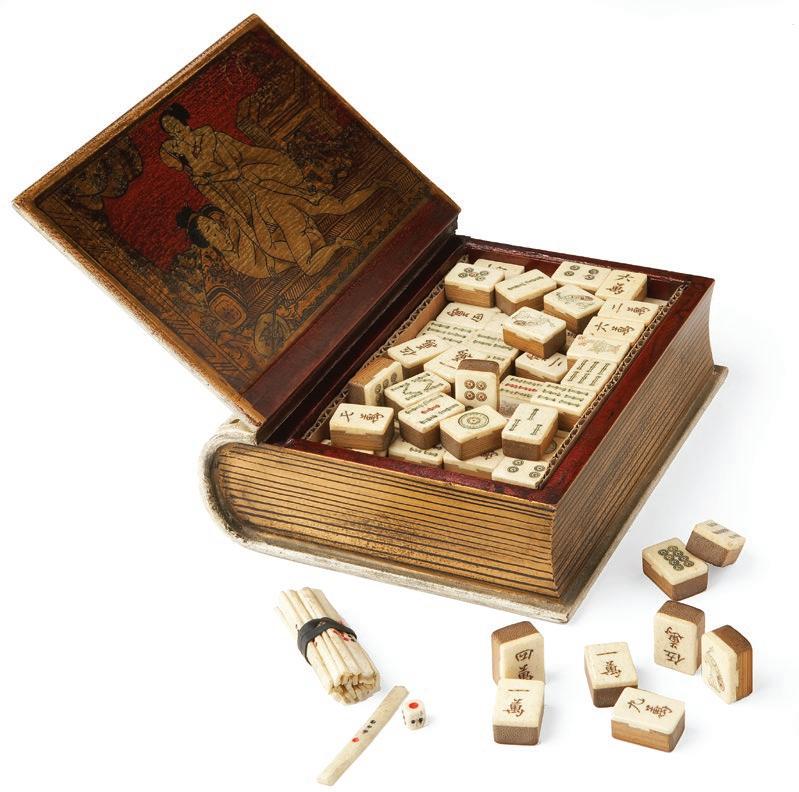
When art and literature converge, the result is a unique and compelling aesthetic experience

For someone who writes books, it’s a little disconcerting to discover that there are booklike objects out there whose literary content is not their raison d’être. Sometimes text is merely equal to other components, or it serves to inform image. And sometimes text, however meritorious, is ornamental, a fate actually worse than not being present at all. When is a book not purely a portable delivery system for an intellectual or aesthetic experience through language? When and how does the book become art unto itself?
What’s important and consoling to realize is that the operative word is narrative, and narratives do not rely exclusively upon words, although frequently books and words are mistaken for the same thing because they reside together within the same holding environment. The Nara ehon, or Nara picture books of 16th and 17th century Japan, are stunning early examples of this broad characterization. Nara ehon is an illuminated otogi zoshi, a genre of fabulous short narratives popular in medieval Japan. The authors were anonymous and the illustrations unsigned but thought to be the work of Buddhist painters. Graceful, fluid calligraphy alternates with vividly pigmented, delicate, and meticulously painted interpretations on rice paper embellished with gold and silver foils. Vermilion and a particularly intense turquoise-green were favored colors, while most often the bindings were navy blue, with designs of autumn grasses in gold. Nara ehon are theatrical in both intent and presentation— indeed, some of the tales whose themes concern the origins of
shrines and holy places were believed to possess talismanic powers; reading the book was analogous to making a pilgrimage.
Of course, there are thousands of rare old volumes going back 500 years whose textual contents have long since been rendered completely—and, in some cases, comically—wrong, but whose historical importance, artistic beauty, or sheer virtuosity of craftsmanship elevate them to the status and capacity of art. Quite often the most talented artists of the time were hired to contribute to the book, so that the illustrations and woodcuts tended to preserve the book’s value, while time and scarcity worked their cumulative monetary magic.
Fore-edge painting, a novelty embellishment cultivated among the British around the middle of the 17th century, was briefly popularized during a 60-year period in the late 18th and early 19th centuries. Initially, fore-edge markings served a practical purpose: Because they were often considerable in size and bulk, medieval books and manuscripts were stored horizontally, with the title or owner’s name recorded on the fore-edge to spare the librarian undue exertions while hunting down a specific tome. With better bindings, the books went vertical and the title migrated to the spine, leaving the fore-edge for less functional matters, like delicate watercolor paintings. The technique was deceptively straightforward: The artist fanned the edges of the book, slightly and evenly, securing them in that state with a vise; he then painted the image on the fanned edges, let them dry, released the book from the vise, and made flush its pages. The last step was gilding the edges, which effectively concealed the painting.


Santa Fe resident Susan Foote collects these intriguing books, among them single, split, double, and the remarkable panoramic fore-edges, in which the miniature painting wanders from top to fore and around the bottom edge. The double is considered the most collectible, Foote explains, as it reveals a painting when the pages are fanned one way, and an entirely different scene when fanned in the opposite direction. Nearly half of all the fore-edges produced were volumes of English poetry, though the paintings did not always relate to the book’s content—“a golfing scene on a book of poetry, for instance, or even erotica”—and these Foote finds far less compelling than watercolors that articulate aspects of the narrative within. “Some of them were mass-produced, pastorals, for instance. The secret picture was a novelty, maybe intended to increase sales. They even had people sitting in shop windows painting fore-edges.”
Toward the end of the 19th century, a French art dealer, Ambroise Vollard, contrived a hybrid presentation known as a livre d’artiste, which sought to promote the careers of Parisian artists, some of whom went on to become the 20th century’s most celebrated modern painters—Bonnard, Matisse, Miró, Chagall, Ernst, and Picasso, to name only a handful. Vollard was joined by other publishers, among them famed art connoisseur Henry Kahnweiler, and the deluxe editions strengthened and expanded the art market from which they had evolved. The books featured alternating text and image, and though they may have been complementary in a somewhat detached manner, there was no deep communion between the two; in fact, more often than not, the artist and writer
never met. The structural components of the books themselves were made according to the editor’s impeccable taste, with high-quality materials. But there was nothing that took into account the form of the book itself as integral to the overall artistic expression, and that is what distinguishes these productions from the “creations” of what are known today as “artists’ books.”
In today’s pixeled, digitized, disposable culture, there is something refreshingly atavistic about 21st and its commitment to the slow, handmade, hard-earned path to beauty
Artists’ books bring together several major traditions and trends among bookwrights: fine printing (letterpress, handset type, and limited editions), livres d’artistes, bookbinding and other structural elements of the codex, serious literature, serious photography, and sometimes even musical accompaniment. Probably the earliest artists’ books were created by William Blake (1757–1827). For instance, in The Marriage of Heaven and Hell he wrote the text, made the illustrations, and printed and handcolored the pages. In doing so, Blake was a hundred years ahead of his time. Today, there are countless fine presses and publishers around the world making books that are unmistakable objects of art and that sell for commensurate prices. Typically, they are intensely synergistic projects involving collaborations among author, translator, artist, typographer, printer, and binder.
Felicia Rice, who owns and directs Moving Parts Press in Santa Cruz, California, notes that “things are really exploding in the artists’ book industry.” With 30 years’ experience as a typographer, editor, designer, and publisher, and with books in collections ranging from the Bodleian Library of Oxford, England, to the Whitney Museum in New York, Rice is considered one of the best. “People have been moving a long way from the traditional
idea of a book, exploring structures and sculptural aspects. Often content is almost an aside. But,” she insists, “I’m a content person; I’m not ready to leave that behind. Structure is form plus content.”
Historically in America there have been plenty of merely beautiful books—handset type, gilt edges, marbled pages, elegantly crafted bindings, and classic or literary texts. These books were about methods and quality of production, but not the exploration of what may be called the conceptual space of bookness. Rice’s most recent project, Codex Espangliensis, is a performance text revolving around the great Mexican crisis in California, taking up issues such as NAFTA, globalization, pop culture, and border identities and politics. Guillermo Gómez-Peña contributed texts and poems that were integrated with collage imagery by Enrique Chagoya, while Rice structured the book as an accordion-fold, using letterpress and photoengraving. “My job was to incorporate everything into a unified whole. The pages are dynamic,” she says. “The book performs the text.”
Farther north, in Berkeley, Julie Chen, of Flying Fish Press, focuses on the sculptural aspects of bookwork, playing with nontraditional shapes and laser cutouts that result in displayable books that she has both written and crafted. Though the books can be read, they land clearly on the form, rather than the content, side of the equation; many don’t even resemble books. Bon Bon Mots conjures a box of chocolates, but instead contains five bookworks, each distinctly shaped with letterpress text and images. Ode to a Grand Staircase, whose text is not words but an Eric Satie score,
is constructed in a layered, vertical, French-door format, and sells for $525. These pieces—book sculptures, they might be called— while artistic in vision and design, are clearly intended to engage one’s fancy, if not one’s bank account.
Suzanne Vilmain, of Santa Fe, who worked in the field of graphic design for years, now makes one-of-a-kind objects in which books have been assimilated or merged with other media. “I want to turn book forms around,” she says, “to take found objects and transform them into booklike forms.” One of her pieces is a woman’s handbag that opens to the pages of a book; its base can be released as well, exposing another set of pages. “But content has to speak to form,” explains Vilmain. “I conceived of the purse as a woman’s psyche, her private territory. I used the actual contents of my own handbag, dumped them onto a Xerox machine, and made images. So there was interplay between what is traditionally offlimits or taboo—the private world of a woman’s handbag—and rendering it readable.” Vilmain has also created a chrome toaster whose sides fall open to expose a book made of old newsprint that is theoretically destined to be burned, a thematic gesture toward the book-burning scene in Fahrenheit 451. “It’s a performance piece,” she says. “Except it’s never performed, never actually burned.”
Photography is a latecomer to artists’ books for the simple reason that it is a relatively new technology. After Alfred Stieglitz’ Camera Work (1903–1917), there’s 21st: Publishers of Fine Art Photography Books, which began in 1998 as 21st: The Journal of Contemporary Photography. Intended to present a survey of

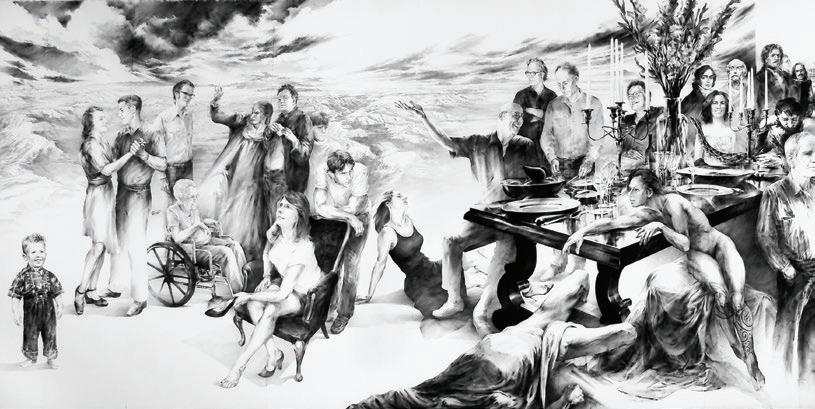
the current status of photography in the world, the Journal anthology appears only every few years in order that it might “look at the larger sweep of things over time,” according to Lance Speer, a contributing editor and one of 21st’s three partners. 21st produces books that are “truly a synergy of three elements—photography, text, and bookmanship,” Speer states. They’re interested in “how a literary voice can resonate with a photographic voice,” and indeed, viewers of any one of these books can’t help but sense an intensity of thematic commerce among all the players.
Though they publish a trade version of the Journal, above all they’re dedicated to the creation of strikingly beautiful limited editions that sell for equally striking prices. The museum edition, which can take years to produce, is priced at $9,000. Of the collaborations and single-artist monographs, there are several levels, the platinum series being the highest, many of which sell out before they’re even available. These books offer not only an aesthetic experience but a sensual one. “When you open one of our books, the room is filled with the smell of ink, leather, paper,” Speer explains. “There’s a tooth to fine paper, a feel, a sensibility to it.”
In today’s pixeled, digitized, disposable culture, there is something refreshingly atavistic about 21st and its commitment to the slow, handmade, hard-earned path to beauty. Sally Mann, a recent offering, is, in a word, magnificent: Mann’s poems breathe into her photographs and seem to animate a subliminal impression of drapery actually moving against and around the natural fluidity of the human figure. The platinum prints are tonally so lush and soft, and yet so deeply detailed, that they resemble images from a dream just slipping away. From the
Twinrocker paper ($8 per sheet) to the vellum spine to the signed archival prints, Sally Mann is probably a bargain at $10,000. The book captured a prestigious Lucie Award in October 2005 for the company, which was named Best Photography Book Publisher of the Year by the International Photography Awards Committee. The newly released volume will go to collectors, special-collection rooms of libraries, museums, and the like. “I’m not even my own demographic,” Speer admits. “Our blessing and our curse is that nobody really knows what our books are like until they stand in front of them. And when they do, they enter a kind of virtual museum.”
Moving away from both the physicality of the codex itself and the book as an artistic space containing image and text, there are new adventures with books that have broken boundaries to present “an experiential work of art,” as Frans Lanting describes it. Lanting has been called the world’s premier wildlife photographer, and with ample reason—16 books, two dozen international awards, including a knighthood from his native country of the Netherlands, plus inclusion on a list of best nonfiction books of the 20th century. The listed book, Eye to Eye: Intimate Encounters with the Animal World, is a largeformat trade edition composed of full-page photographs. What makes the encounters “intimate” has to do in part with the sheer scale of the photos, the forced, in-your-face contact, and in part with Lanting’s marvelous ability to visually cross perimeters and reach into the personal space of the animal, to capture mood and individual personality. Lastly and most intriguing, there is the choreography of the book.
“I hear music when these visual possibilities are before me,” Lanting explains. He carefully selected images on the basis


When is a book not purely a portable delivery system for an intellectual or aesthetic experience through language?
When and how does the book become art unto itself?
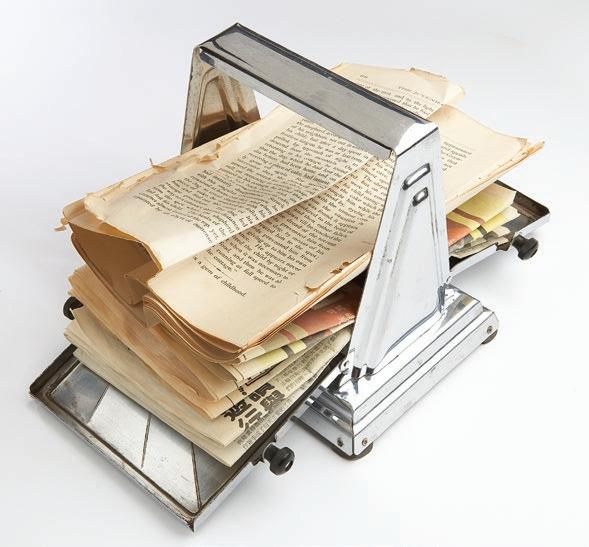

The edge between bookness and otherness has been grafted and pushed and blurred during the past 50 years to such an extent that, in some cases, the word book is an adjective and not a noun
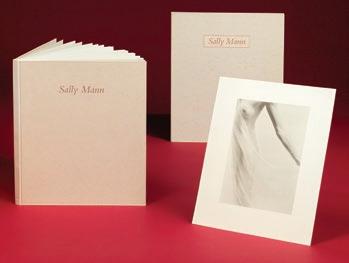

of color and substance, then sequenced them in such a way that the very process of moving through the book, spread by spread, actively engages the viewer in what Lanting calls “a kind of cinematic, rhythmically unfolding experience.” Except for a few discreet captions, text was shifted to the back of the book so that there would be “minimum interference from the rational side of the brain.” The pages turn and pass, much as musical phrases, while the three major sections of the work function as symphonic movements in an overarching narrative about the continuity, the deep connectedness between humans and other animals. At the same time, Lanting tried to “develop a visual language. The images
need to move people emotionally and aesthetically,” he insists.
In Lanting’s newest project, titled Life: A Journey Through Time, there will be audible music: Philip Glass is composing a onehour score to accompany the viewing of the book, seven movements corresponding to the seven sections, which in turn correspond to the major eras of life. “Our sense of time is so short,” Lanting says. “I wanted to look at nature across and through time. My mission has been to separate the layers, from the Big Bang to the present.”
In spring 2005, SITE Santa Fe exhibited James Drake’s City of Tells. Drake is a widely known artist living in Santa Fe whose work over the past 30 years has evolved from postmodern welded-steel


four large-scale charcoal-on-paper drawings, one of which is heroic in size and conceit—a 12' x 32' group study that takes in Drake’s family and friends as well as characters from art and history. Then there is a video triptych projected on the wall in a 15-minute loop that features, among other things, feral hogs ravening a banquet table groaning with holiday fare, which Drake set up and filmed in the wilds of Big Bend, Texas. Finally, a limited-edition book sits on a pedestal before the largest of the drawings. “It just made sense to do the book,” Drake remarks. “There is the expansive mural component of the experience. I call it ‘walking the drawing.’ The book becomes the intimate part of the experience.”
So what is it exactly that makes a book an object of art? Its structure, the nature of its physical components, the quality and
originality of its images, and the way these images converse with text; the paper, the ink, the boards, the typography; even the leftover space on the pages or spreads, and the way it articulates with used space. Also, the sequencing of the pages and the estimated rate at which they might be turned and, ultimately, the sensuous beauty of the thing itself—these are some of the criteria.
The edge between bookness and otherness has been grafted and pushed and blurred during the past 50 years to such an extent that, in some cases, the word book is an adjective and not a noun. Even lettering has morphed into other forms: Toko Shinoda, one of Japan’s master calligraphers and an internationally acclaimed artist, has for decades been making abstract paintings and lithographs based on Japanese characters.
The book has evolved from a relatively durable, lowmaintenance, movable repository of knowledge, often artfully expressed, beautifully illustrated, or handsomely made and decorated. It has become a type of artistic space: like a canvas, though in some ways far more complex; like the orchestra pit of a symphony hall, though there are fewer players; and like a theatre performance, but private and endlessly repeatable. It is a place where art can happen, either individually or collaboratively. And while the fundamental, hinged, multiplanar structure of the book has proven to be fairly mutable, the vitality of bookness is irrepressible. R
From the Winter/Spring 2006 issue

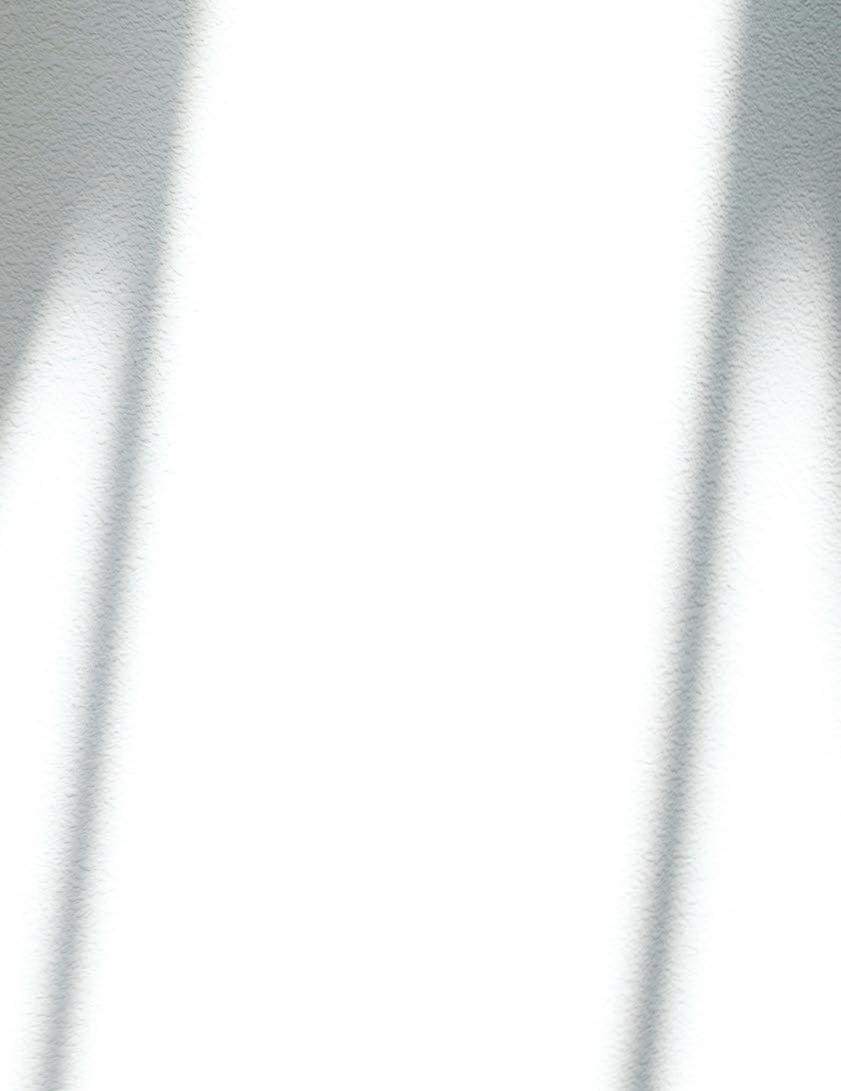
Riva Yares likes big. Big men. Big cars. Big spaces. Big personalities. She herself is not big. She’s got big hair, but she stands at five foot four. Nor is she demonstrative or overbearing; at least, not so much anymore. And while she can do demure, she’s hardly shy.
Owner and director of the Riva Yares Gallery in Scottsdale, she has curated major exhibitions for many important artists of the 20th century, from Milton Avery and Morris Louis to Jules Olitski and Roberto Matta, among many others. This fall, her son, Dennis, opens a new Yares gallery in downtown Santa Fe. It’s a new chapter for the Yareses in Santa Fe, as Riva ran the former Yares Gallery, which opened in 1991 and had to give its space back to the O’Keeffe Museum several years ago. Committed now to her Scottsdale gallery—she built herself a penthouse atop it—her focus lately has been film. She’s adapting her 2011 quasi-memoir Sleeping with Dogs into either a full-length feature or a TV series. One she hopes to direct someday.
In person, she will welcome you into her lovely high-ceilinged home in Santa Fe, where she can watch Zozobra burn in the fall and listen to the crack of Fuego’s semi-pro baseball bats during the summer. She will offer you a drink. A tour. A bowl of cherries. She’ll look you in the eye and show you pictures of Just Seconds Apart, a threemember band consisting of her son’s two sons and daughter.
She will dote on India, her tennis-ball-hawking poodle, who is her most recent love in a long line of canine companions. She will show you Tutu, her massive brass elephant in the backyard, a dignified-looking East Indian artifact that’s so big it had to be airlifted into place. Then she will show you some one-of-a-kind furniture, particularly four chairs designed by the Swiss-French architect Le Corbusier. “When I was in Paris I visited his studio,” she says. “If I had my life to live again, I’d be an architect.”
And she will show you the casita where her
BY DEVON JACKSON
PHOTOS BY KATE RUSSELL
son and daughter and their respective families stay whenever they visit, which is also where E.L. Doctorow and his wife stayed when she had them out for the premier of her film, Jolene (based on a Doctorow short story).
Meanwhile she’ll answer whatever question you ask, offering up not so much judgments or opinions but information and statements that are brief and self-aware, but never dwelling, with no regrets. In a moment you’ll catch the faintest hint of a little girl brush across her face, followed by a stern earn-your-mother’s-love matron the next. But here’s the thing: you may be big as all getout (in size, stature, self-importance), but if you’re not interesting, Riva Yares may not remember you the next time you meet. Because Yares isn’t so much a size queen as she is an interesting queen, and why shouldn’t she expect others to be interesting? She’s been interesting since she was three years old—when she was chosen as the poster child for the newly constructed port of Tel Aviv, the city of her birth in Israel.
As the only child of Sala and Fishel Kilstok, Zionist emigrants from Poland who moved to what was then Palestine in the early 1930s, Yares seemed destined if not for greatness then for interestingness. By age 11, she’d been recruited into the Irgun, Israel’s paramilitary Zionist group whose tactics, according to historian William Cleveland, “appealed to a certain segment of the Jewish community that believed that any action taken in the cause of the creation of a Jewish state was justified, including terrorism.”
As Yares states in Sleeping with Dogs, when she was asked by a friend how she could have been brainwashed to become a terrorist at such a young age, she said: “Children of 11 or 12 believe that when they are asked to give the last drop of blood for their country—they really believe that the blood comes out of their body—that you sacrifice yourself for your country.”
By 15, though, the oldest allegiance of all took hold, and it was one Yares would succumb to

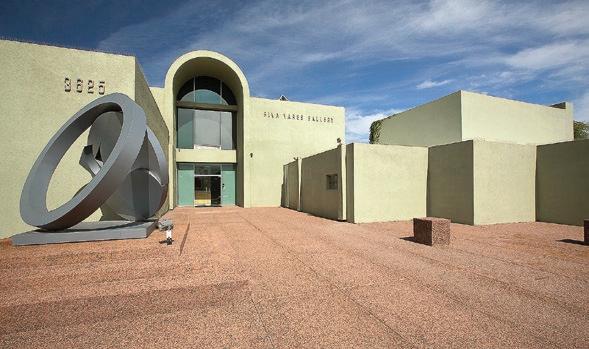
Previous page: Yares with India.
in front of

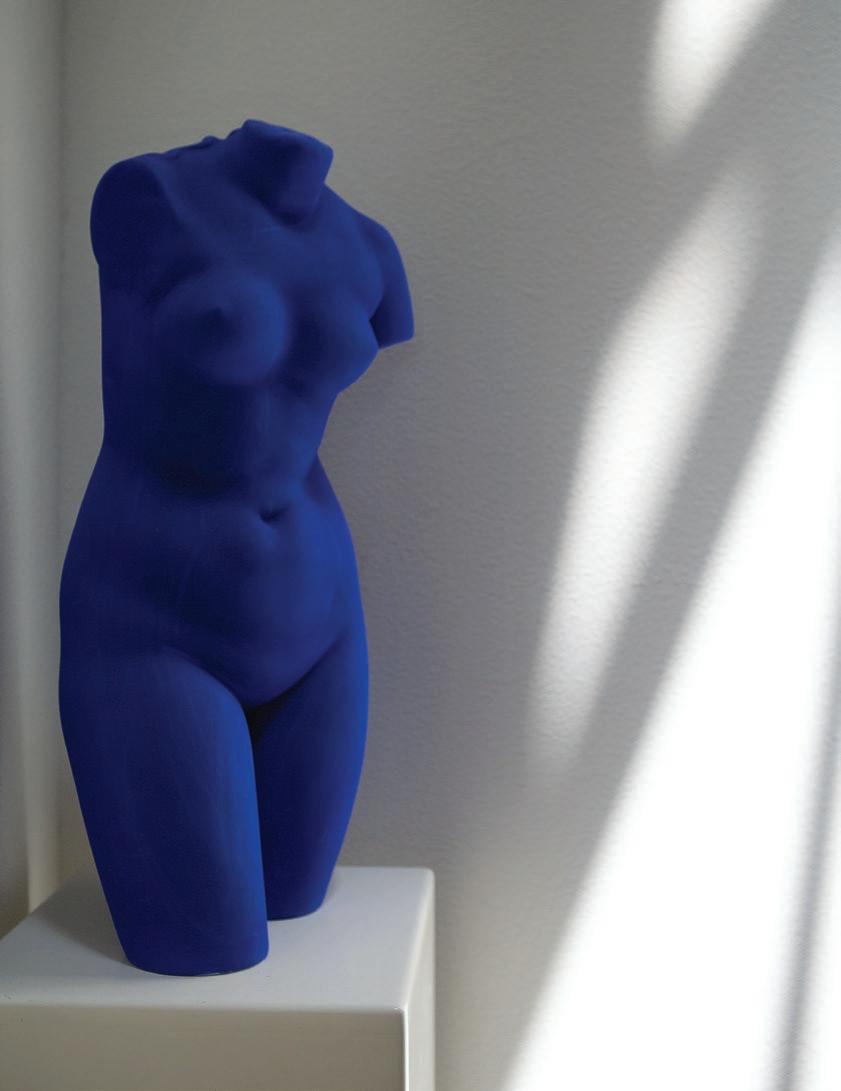
again and again. She’d fallen in love with a bodybuilder nearly twice her age, and he ran a “big gym,” as she put it, in Tel Aviv. As she points out in her memoir, no doubt in her typically flat Joe Friday voice (in a line that becomes almost comical because of the number of men it applies to throughout her life): “He was married and had three children.”
Two years later, she met Sam, the first of her three husbands. Still a teenager, she’d taken a summer job at the American Jewish Joint Distribution Committee. Sam, whose last name she forgoes in both the book and in person, was an economics advisor and a Rutgers University professor. To Yares he looked like Alan Ladd. “I liked the power he had,” Yares recalls. “And I liked that he drove a big white Ford.” (There weren’t a lot of Fords in Israel back then.) Sam, though, was married with three children. Ba-dumpbump. No matter. He divorced his wife and married Yares. She was 18, and he was 38. Their marriage lasted six years, but out of it came a son, Dennis, and daughter, Shelli. “I’d commute to art school in Jerusalem,” says Yares of that period, “so I didn’t have to be married all the time.”
Eventually eager to get a divorce, even if her mother said she’d kill herself if she did, Yares decided that a move to the U.S. would be the easiest way to do so. After seeing a copy of Arizona Highways at someone’s house in Israel, she says, “I thought that that would be a good place to move to. If I went there, not New York, I thought nobody would ever really know.”
So the family moved to Phoenix, and Yares got her divorce, along with custody of the kids. Suddenly a single mom, she realized she needed money, so she took a job as head of a Hebrew school, part of a reform synagogue. As Yares says, again with her typical anti-flair, “I liked the rabbi. I slept with the rabbi. He was fired. I was fired. And they closed the synagogue.” Of course, the rabbi was married and had children.
Again jobless, Yares found refuge at the Phoenix Little Theater, where she could take the kids, who hung out
onstage while she was acting or working on set design.
“There was a group of about ten of us who were very interesting,” she says. “They helped me a lot.” One she became especially close to was Nick Nolte, who was still a decade or so away from acting in Rich Man, Poor Man, The Deep, and 48 Hours. Back then the two became close enough that it was a serape-clad Nolte who served as her witness at her swearing-in ceremony for U.S. citizenship. All she’ll say about him now is, “How sad,” and she leaves it at that. Which is true, and respectful.
Not long after, she would meet Clare Yares, a single father of four boys and at the time the studio manager for Phoenix’s KPHO-TV. (He’s now a master jeweler). Aside from taking his name permanently, Yares opened the Yares Gallery
truly meritocratic industries. A dealer’s success is determined not by gender or ethnicity, but by their ability to source the work that collectors and museums want.”
Or, as British gallerist Maureen Paley tells Rawsthorn: “Art is one of the last unregulated markets. There are no male gatekeepers and you are not confined to traditional alpha-male values. That makes it very attractive to a certain type of woman with a strong personality.
“It attracts,” adds Paley, “larger-thanlife figures, individuals, and eccentrics.”
In other words: the interesting. As for being a woman in a profession still dominated by men—male artists, male museum directors, male curators, male gallery owners—Yares waves off such issues. “I don’t care if it’s women or men. I never had a problem,” she says dismissively. “I didn’t play a woman or a man,
“My dealings with artists and collectors are very intuituve. One cannot go to school to learn how to be an art dealer.”
in Scottsdale with him in 1964—which was the one thing she wanted when they divorced. It was, as she writes, her past, present, and future. Along with the scare of having her children briefly taken from her by her first ex-husband—which required a dramatic flight back to Israel to reclaim them from him—it’s this period that probably galvanized the determination Yares is known for.
Not that she had any idea how unthinkable it was to want to run a contemporary art gallery 2,400 miles from New York City. “I was at the wrong place at the wrong time, but I had no idea, and I did it anyway,” Yares says of opening the gallery. “But I’m not interested in what other people do. I do my own thing.”
As the astute British design critic Alice Rawsthorn observed in The Guardian several years back, female gallery owners are largely allowed to be themselves. “The cutthroat economics of the market,” writes Rawsthorn, “make contemporary art dealing one of the few
just a gallery owner.” What she played, and what she has, is charisma. Especially when she finds you, or your art, or whatever you do interesting. What interests her, she pursues. What doesn’t interest her, she passes by.
But don’t think her merely lucky, or naïve. Yares may not have had the traditional education, or the aristocratic upbringing, but she is smart, sophisticated, and informed—in addition to having a great eye, charm, and, well, chutzpah. “My father collected art,” she explains, reiterating what she’s written in her book. “My dealings with artists and collectors are very intuitive. One cannot go to school to learn how to be an art dealer. I never worked in a gallery or art institution. Growing up with paintings and going to art school in Jerusalem were my education. All this led me to have great respect for art.
“You don’t have to know how to do it; you just have to have one good eye,” she says matter-of-factly. “And the artists


Yares’s penthouse, above her
includes such
as
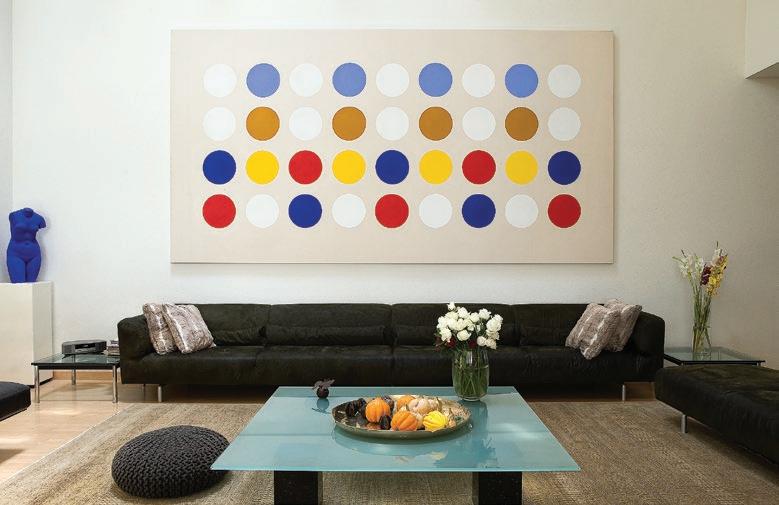
“It is almost entirely due to Riva Yares that Matta saw the revival of his career in America.”
trusted me because I was an Israeli, tough and pretty.”
She also wasn’t in New York, which worked in her favor. “I didn’t know any different,” she says. “I didn’t know Arizona wasn’t the place to have a gallery. And some of the really interesting, the great, great artists didn’t want to show in New York,” explains Yares, who also speaks Hebrew, Arabic, Polish, and German. “But out here it’s the Wild West. So, I went after international artists.”
These include Jules Olitski, Roberto Matta, Milton Avery, Kenneth Noland, and Jean Tinguely. As her son, Dennis, succinctly puts it in her memoir, “She has said that the secret of her success lies not in selling paintings, but rather in her
ability to obtain great paintings, for great paintings sell themselves.” Which was only sort of true. Because, as the art critic Edward Lucie-Smith stated in the book’s introduction: “It is almost entirely due to Riva Yares that Matta saw the revival of his career in America.” Back then, though, the art world was different. For example, Yares tells the story of visiting the art dealer Andre Emmerich in New York. He told her: “You can have anything you want in my gallery. When you sell it, pay me.”
While the Scottsdale gallery boomed, she decided to make a go of it in Los Angeles, with the Riva Yares Gallery of Israeli Art on La Cienega Boulevard in the early ’70s, but between the earthquakes and what Yares describes as the duplicity of the
Angelenos, she left after a year. “Unless you’re from Los Angeles, it’s very hard to get along with people there,” recalls Yares. “I was lucky it didn’t work. I put the tail between my legs and left.”
Nevertheless, she opened the Yares Gallery in Santa Fe in 1991, shortly after buying the house she’s in now. Her son ran it, closed it while working on Jolene (he wrote the script), and is now building a new one downtown. She also gave marriage another try—not for love but out of sympathy—to a younger man who was
HIV-positive. Through the years, Yares has been active philanthropically, in particular with organizations dedicated to those who are HIV-positive or who have AIDS. “I must have turned into Mother Teresa,” she wrote. They divorced within a year.
Surrounded by art, most of it from artists in her gallery, and splitting her time between Scottsdale in the winter and Santa Fe in the summer, Yares has neither retired nor settled on her next incarnation. She still oversees her Scottsdale gallery, and she’s intrigued to see Sleeping with Dogs take to the screen. As for her gallery, and art in general, “Most artists I have any interest in,” she laments, “aren’t alive anymore.” About the tastes that drove her interests over the years, in art as much as music and literature, she comments: “It was very personal. But the art business doesn’t interest me anymore.”
Her home in Santa Fe feels like a cross between a conservatory and a gallery, populated with plants, paintings, and sculptures. Light-filled, colorful, and high-ceilinged. Many doors and windows create the illusion of the outdoor garden entering within. “I like Santa Fe because people leave me alone,” says Yares, who’s been entertaining friends in her home and enjoying the Santa Fe Opera. “I feel good in Santa Fe. I like the air, the trees. I can breathe. It’s a very special place.”
Jolene may have soured her somewhat on filmmaking—“I liked making the movie,” she admits, “but I didn’t like the side effects. I put $8 million into that, and I lost $8 million.” But not entirely. Who knows? She could end up making a movie about the French novelist Marguerite Duras. Writes Yares: “I thought about making a film called Marguerite Duras and Me. I was so intrigued by her. . .
I wanted to . . . maybe become her.”
Doubtful. What’s not doubtful is that Yares will remain interesting, and interested. She seems to be biding her time until the next project. Meanwhile, the flowers that fill her living room were bought specifically to complement each art piece. The dark-pink gladiolas on the long table beneath the gigantic, mostly gray, 15’ x 25’ Olitski painting match the faint streaks of purplish-pink in the upper left corner of the canvas.
“I live with dead people,” she says, uncharacteristically dramatic. She’s talked enough. She’s ready to move on. Yares sets her glass of water on the large Plexiglas table, which contains a two-inch layer of Yves Klein’s patented blue paint powder, and ushers you to her front door. “I buy flowers for their paintings.”
Brief, self-aware, charming, and firm. Interesting. R From the Fall 2015 issue
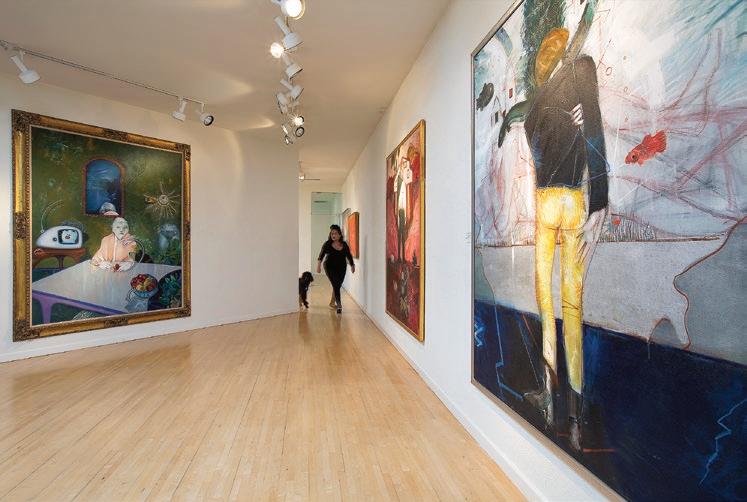
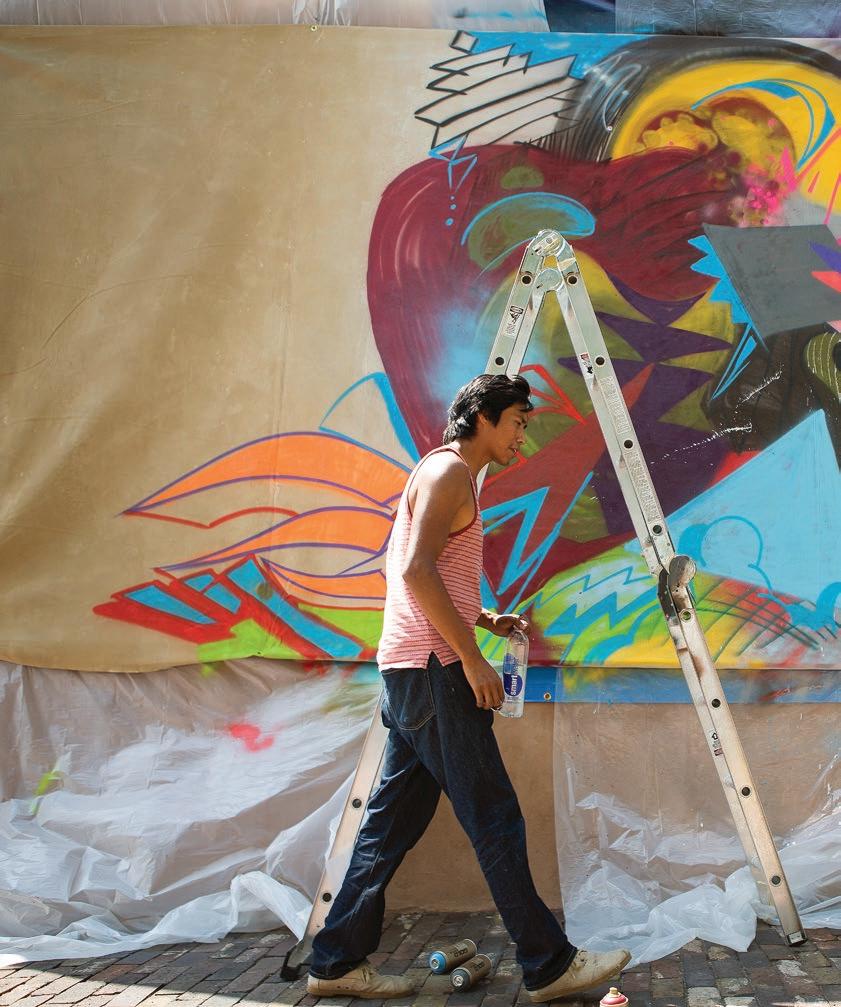
Native American street art sparks a dialogue about cultural and environmental issues
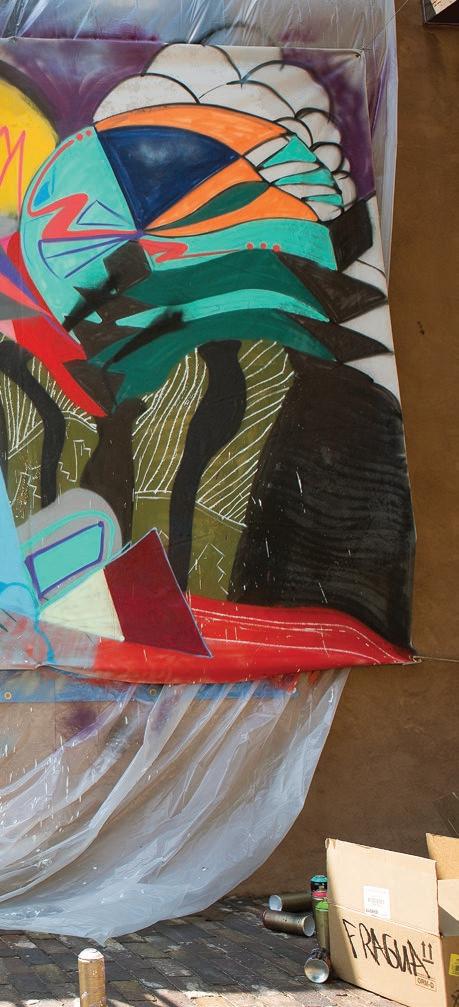
BY NANCY ZIMMERMAN
ack in the mid ’60s, when Simon and Garfunkel sang that “ . . . the words of the prophets are written on the subway walls and tenement halls . . . ,” graffiti was perceived by the Establishment as vandalism and its purveyors as criminals. Fast-forward a few decades, and the landscape has shifted a bit. Simple graffiti phrases—from “Kilroy was here” to “U.S. Out of Vietnam” to “No Blood for Oil”—are still seen by many as an urban blight, but enough graffiti writers have revealed themselves as witty and talented provocateurs to establish the practice as an art form.
Add to that a recent proliferation of highly creative murals, billboards, posters, T-shirts, and performance pieces conveying political statements and cris de coeur, many of them produced by formally trained artists and graphic designers, and what was once a crime has become a movement. This outlaw activity has since moved into the salons and galleries of such highbrow bastions as Art Basel Miami and the Venice Biennale, and street artists like Shepard Fairey, Banksy, and the late Jean-Michel Basquiat have become household names.
But even as public understanding of its importance and quality as an artistic expression has grown, street art has managed to retain its youthful, gritty immediacy, along with its power to shift the collective conversation to new modes of thought and aesthetic appreciation. And it’s no longer a purely urban phenomenon: now it’s come to the rez.
The remote expanses of South Dakota’s Pine Ridge Reservation and the Navajo Nation, which straddles New Mexico and Arizona, might seem unlikely venues for street art to flourish, given their lack of population density, few roads, and even fewer buildings. But flourish it has, and the messages conveyed by its practitioners now resonate with an urgency that extends far beyond the confines of the reservations.
“Native American graffiti has actually been around forever,” observes Jaque Fragua, who was raised in New Mexico’s Jemez Pueblo and currently resides in New York. “My first inspiration as an artist came from my people’s ancient petroglyphs and pictographs. They were so minimalist in their expression, getting to the core values of life and speaking volumes in their simplicity and beauty.”
Moving from the rustic canyons surrounding his pueblo to the concrete canyons of the city was a natural leap for Fragua, who began his foray into public art as a teenager, dodging the cops while writing graffiti in
Denver. “Graffiti was a challenging boot camp,” he says. “I had to represent and defend myself, and fight off the authorities and other graffiti writers.” While he acknowledges the adrenaline high of evading detection while asserting his message, he soon tired of the arrests and confrontations, and sought other media to give voice to his Native perspective on issues of identity, cultural appropriation, and institutionalized inequality.
“It’s about educating people who are ignorant of the fact that there are highly developed cultures that have existed within the Americas for hundreds of years,” says Fragua, who studied at the Institute of American Indian Arts (IAIA) in Santa Fe and has led community-based art workshops, mural projects, and studio classes in figure drawing and painting. He also has helped create exhibits highlighting Native issues for the Smithsonian’s National Museum of the American Indian in Washington, D.C., and the Museum of Contemporary Native Arts and the Museum of Indian Arts & Culture in Santa Fe. “Our differences need to be not just tolerated, but celebrated,” he adds.
A major subject of Native street art is cultural appropriation, the general public’s tendency to freely adopt Native themes and symbols without permission, attribution, or, indeed, any real understanding of their meaning to the people from whom they’re taken. From the sports world to the movie industry to history textbooks, Native identity has been exploited in ways few other ethnic groups have endured. After several centuries of watching the Anglo world distort cultural icons, perpetuate insulting stereotypes, and appropriate images for monetary gain, Native Americans are now wielding their power as street artists to reclaim their identities and assert their self-respect. Although galleries and museums around the country and beyond are increasing their recognition of fine art produced by Native Americans, Fragua feels that the art’s inherent messages of cultural autonomy need to be disseminated more widely—and that’s where street art comes in.
a freeway or on a building, we can speak to people directly on both a spiritual and intellectual level.”
To that end, some of his colorful posters bear tersely worded messages that would be difficult to misconstrue: “Sovereignty,” “Stop Big Oil on Tribal Soil,” “Protect Mount Taylor.” All speak to the assault on the integrity of Native lands, while informing and engaging people in struggles that ultimately affect all of us.
Honor the Treaties (HTT) is a loose collective of street artists that came together organically around 2010 after internationally renowned photojournalist Aaron Huey began exploring the issue of the 1868 Fort Laramie Treaty, which preserved 27 million acres in the Black Hills of South Dakota for the Sioux Nation. The land was illegally usurped and opened up to prospectors and homesteaders despite the treaty, and the Sioux Nation sued to enforce it. Litigated until 1980, the case became the longest-running lawsuit in U.S. history. The Supreme Court finally acknowledged the land theft but awarded the tribe a mere $106 million in compensation. The Sioux refused the payment, declaring, “The Black Hills are not for sale!”

Street art is no longer a purely urban phenomenon: now it’s come to the rez
That rallying cry fueled a movement to publicize the injustice of the court’s decision after Huey gave a TED talk on the topic, and renowned artists Ernesto Yerena, a Yaqui/Chicano originally from California, and Shepard Fairey, best known for his 2008 Obama “HOPE” poster, collaborated on a street-art campaign to plaster hundreds of walls throughout the country with posters bearing the slogan.
“Cultural appropriation is kind of an entry-level issue, something a lot of people can understand,” he says. “There are millions of people who never set foot in an art gallery, but they see billboards along the highways and murals and posters on the walls of their city,” he says. “When we put our message beside
Since then the HTT collective, directed by an advisory board whose members include Native American civic leaders, lawyers, educators, musicians, and entrepreneurs, has brought together a diverse group of Native street artists who use their talents to further the effort to protect the culture, water, air, and land by pursuing enforcement of treaties that have been systematically breached. Fiscally sponsored by the Lakota People’s Law Project, the group promotes individual ventures as well as collaborations among Native artists and advocacy organizations.
One such effort is the Painted Desert Project, which came into being initially when African-American physician James “Chip” Thomas, a longtime resident of the Navajo Nation, began venturing out into the reservation to photograph the Navajo residents
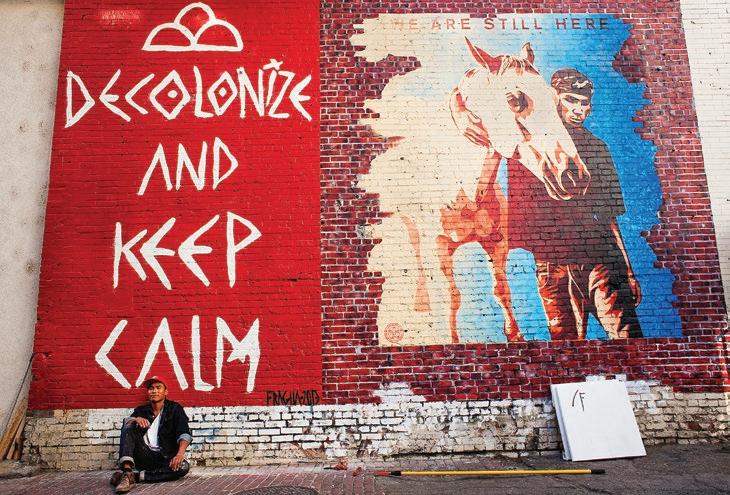
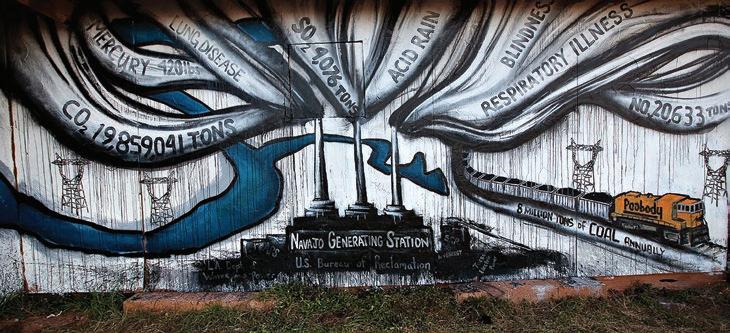
Tom GreyEyes addresses the degradation of the environment caused by coal-fired power plants with a mural at the Inscription House, a clinic at the junction of Highway 98 and Indian Route 16 in Arizona. Top: The mural is the message—Jaque Fragua collaborated with Shepard Fairey to create poignant but pointed wall art in Los Angeles’s Indian Alley. Opposite: A detail from Nani Chacon’s billboard on Central Avenue in Albuquerque, which urges viewers to “Save Mount Taylor.”
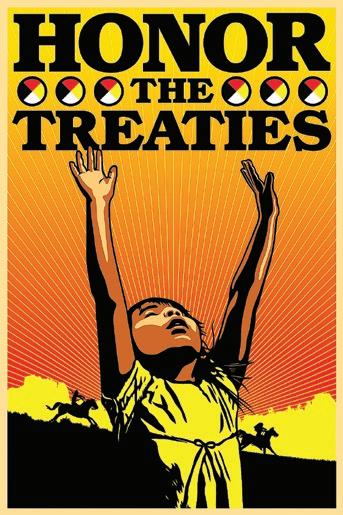




as they went about the business of their daily lives. In 2012 he decided to turn his hobby into a public art project by enlarging the photos and wheatpasting them onto buildings along the roads that wound through the reservation. The idea was to create cultural and environmental messages that could be seen by the local residents as well as visitors traveling through the area.
Among those participating in both HTT and the Painted Desert Project is Navajo artist Tom GreyEyes, an Arizona resident and recent college graduate who has already achieved acclaim as an artist, teacher, and social activist. In 2012 he was awarded the Phoenix New Times’s Big Brain award in visual art, and he used the prize money to participate in a training camp for nonviolent, direct activism.
“I believe in the power of art as a political megaphone,” he says. “It can break through language barriers with visual statements, and it becomes almost a language in itself. Chip Thomas was my introduction to the street-art community, and those artists involved in the Painted Desert Project have taught me a lot. You need stamina and commitment to create art in remote locations, to withstand the hot sun and the dust storms, and the artists really impressed me with their passion for their work.”
While the project is directed toward the residents of the Navajo Nation, designed primarily to inspire the younger generation by giving them a positive way to see their culture, GreyEyes observes that both this art and street art in general offer important means of speaking back to power in addition to speaking to each other.
“We’re trying to build a movement to inspire people and to engage in dialogue about issues important to our survival. Neocolonialism is still alive in this country,
“We’re trying to build a movement to inspire people and to engage in dialogue about issues important to our survival.”


From the sports world to the movie industry to history textbooks, Native identity has been exploited in ways few other ethnic groups have endured
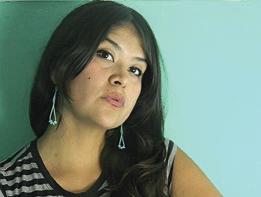

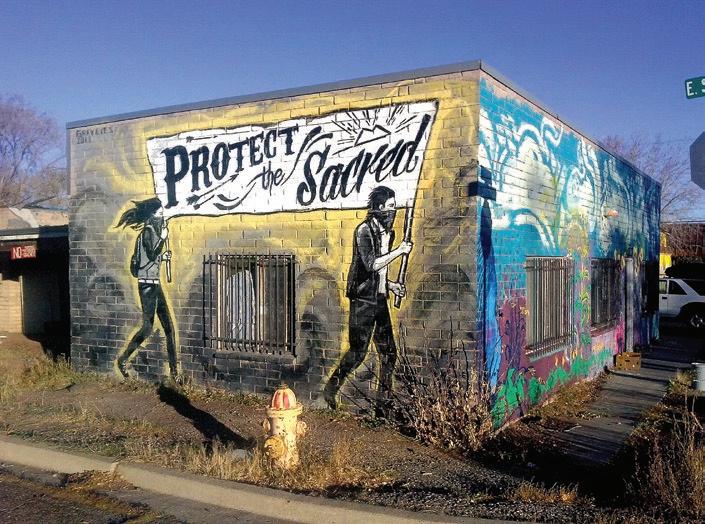

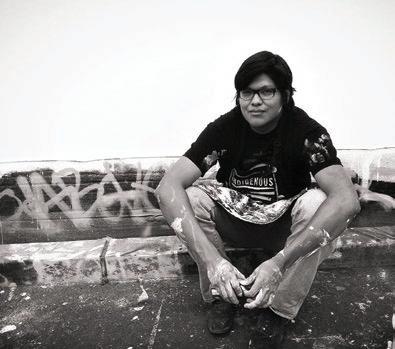


and cultural appropriation is a big issue. Through our art we can make critiques and propose solutions; we can offer a vision of how things could be.”
GreyEyes approaches his forays into issue-based street art as research projects, first steeping himself in the back ground and details before engaging his creative skills. He cites his work with Save the Confluence, a movement orga nized in response to the proposed Grand Canyon Escalade project, which has split the Navajo Nation and occasioned a groundswell of protest. The project is a multimillion-dollar tourism development that would brings tens of thousands of visitors to the eastern edge of the Grand Canyon, threat ening a fragile ecosystem and displacing people from their homes in the process. “I did a mural about the political issues surrounding it, but I first had to get information from everyone, read the environmental impact report, and learn the details of the project. Once I had the information, it was up to me as an artist to conceptualize it, create it, and disseminate it.”
Another HTT artist, Navajo/Chicana painter and illustra tor Nanibah “Nani” Chacon, also paints murals with a mes sage. Raised on the Navajo reservation and now living in Albuquerque, Chacon says her intention is to create a con nection between traditional culture and contemporary social perspectives. She accomplishes this through abstracted illustrations featuring a character for whom she crafts a visual narrative.
“I really want to create pieces that make a state ment that brings Native philosophy into a contemporary context,” she explains. “I feel that the only reference for Native philosophy has been an archaic culture, a relic of the past. I want to show its contemporary relevance through my art.” Her mural She Taught Us to Weave, which was commissioned in 2012 by the City of Albuquerque for the Interna tional Symposium on Electronic Art (ISEA) to adorn a railroad corridor in downtown Albuquerque, stars the archetypal Spider Woman and addresses her rela tionship to technology and the responsibility that goes with it. “In our creation stories, Spider Woman taught us to weave, and to weave with beauty and harmony,” she says. “At the beginning of the mural, the pattern around Spider Woman resembles a rug motif. As it proceeds down the wall, the pattern appears as a cir cuit board, raising the question, ‘How will we now use the modern technology we have?’” In addition to incorporating elements of traditional textile patterns into the story, Chacon also likes to use the architecture of the building to make each mural site-specific.
“My work is definitely different in the respect that I focus on the beauty, the compassionate side of the cultural issues. I believe battles will be won with positive messages. And I feel a sense of responsibility about what I paint because once I put it

out there it no longer belongs to me. My particular interest is in reaching young people with my HTT work,” she adds. “We’re not always going to change the world, or even change a law, but we can open the dialogue.”
A more confrontational but wryly humorous approach can be seen in the performance art of Gregg Deal, a Pyramid Lake Paiute painter and graphic artist originally from Utah who now lives in Washington, D.C. His trenchant social commentary is ironic in tone as he explores the misappropriations of Native culture that go back centuries, as seen in his The Last American Indian on Earth
For this performance piece, Deal dresses up in a stereotypical Indian costume complete with headdress and feathers, then positions himself around town doing ordinary things like buying coffee at Starbucks, mowing the lawn, or visiting the Washington Monument. Video and still cameras record people’s reactions to seeing this Hollywood-style Indian in their midst, and Deal reports that the stunt has occasioned a wide variety of responses and conversations.
“The perception of indigenous people in and out of Native culture needs to change,” he says. “We need a dialogue. I take stereotypes and regurgitate them, take relics and place them in the modern world, and people are forced to reconcile the odd juxtapositions. Irony and humor can get through in ways that earnest exposition can’t. Being angry and defensive all the time doesn’t work.”
Deal underscores the difference between honoring a culture by borrowing positive elements and acts of true cultural appropriation. “With appropriation, you don’t have a conversation,” he points out. “No one’s asking for permission or even an opinion. Some argue, for example, that naming the city’s football team ‘the Redskins’ is a way of honoring us, but it only ‘honors’ romanticism, the nostalgic notion of an Indian that never actually existed.”
Despite the frustration of having to counter these notions—“On the East Coast, the novelty of being Native American is alive and well,” he says—Deal believes that the digital age is “a good
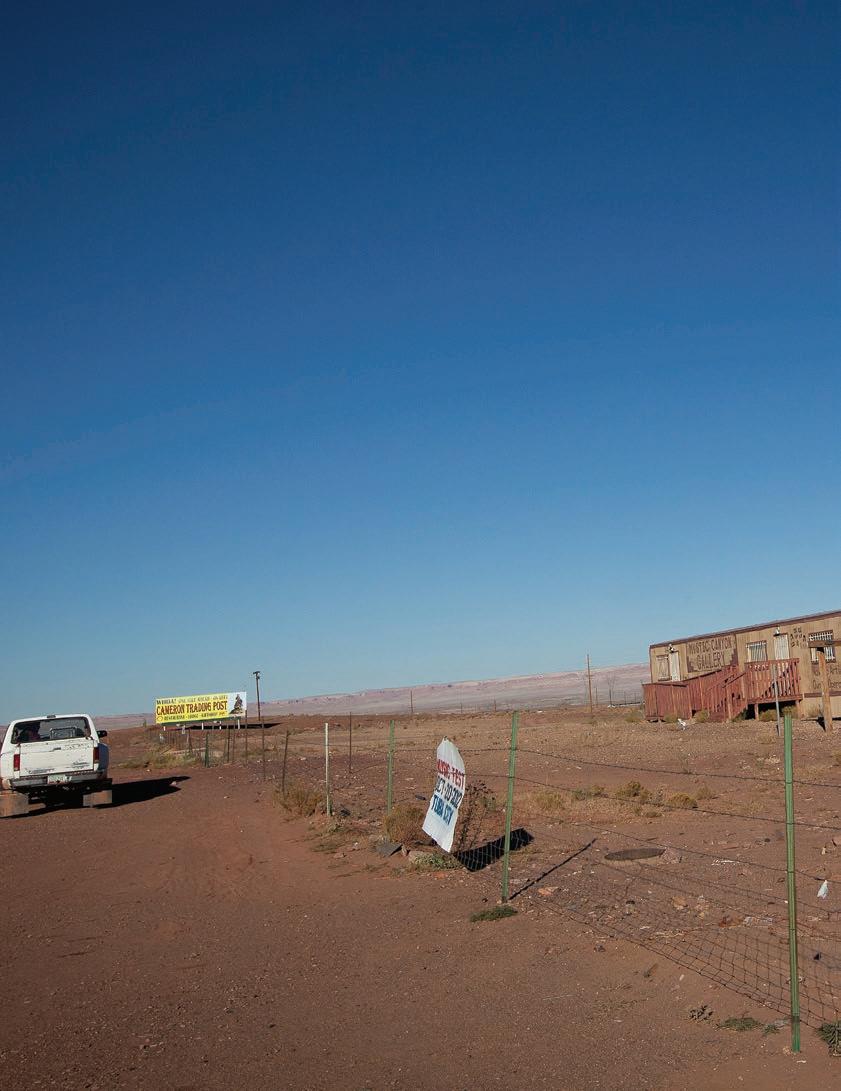
believes that the digital age is “a good time to be Indian. With the advent of social media and the Internet, hashtags, posters, and stickers, we can reach more people than ever before in new, more immediate ways.”
The movement continues to spread, not just via the streets and social media but also through film, television, and music. It has attracted support from such notables as Neil Young, who performed a concert to fund a lawsuit against the Tar Sands development in Canada that featured Fragua’s poster and T-shirt designs.
“The artists are the ones leading the way for how we see things,” says Fragua. “We connect the issues with the external world to get the message out at the same time that we internalize the message for the Native communities.”
Important as it is to Native Americans for the process of decolonization to continue, it is, in fact, equally important to the culture at large. By reclaiming and reasserting their true identity as a people, Native artists open up and share a world that broadens everyone’s understanding of human history and the human condition, and exposes us to a new aesthetic and worldview. Likewise, by drawing attention to the environmental degradation that threatens traditional lands, air, and water sources, they fight for environmental integrity for everyone. Beyond the hip visuals and edgy messages, the Native street-art movement presages a saner, more inclusive world that benefits us all. R
From the Summer 2014 issue


The Painted
Project sprang from Dr. Chip
photos of
residents. With the help of volunteer artist crews (opposite), he wheatpasted the photos onto structures throughout the reservation, offering positive images to bolster the Navajo sense of identity.

Spanish Colonial arts reach a crossroads

BY KEIKO OHNUMA | PHOTOS BY PETER OGILVIE
MModern impulses are banging down the doors at Spanish Market, and for the first time in its 60-year history, the guardians of New Mexico’s traditional Hispanic art forms are allowing the purity to crack open—a little. A new category is being introduced this year by the Spanish Colonial Arts Society, which sets the rules for what can and cannot sell at market: They’re calling it “Innovation Within Tradition.” Established artists may now count on seeing some nontraditional work get past the jurors. Many observers scoff that this is no more than very late recognition of what has already been happening since the 1800s, when homegrown arts such as the painting and sculpting of saints (santos) reached its height. How can anyone, in fact, be called a “colonial” artist in 2011? The label is fraught with contradictions, referring sometimes (as in the case of tinwork) to media that emerged only after the colonial era. Is it any wonder that some of the several hundred artists who show at Santa Fe’s two annual Spanish Markets would want to break out of the mold—show a saint in a modern setting, for a change, or use pigments out of a tube?

The 82-year-old Spanish Colonial Arts Society (SCAS) still requires market artists to be at least a quarter Hispanic and to have family roots in the region. Within its 20-plus selling categories (the best known being colcha embroidery, straw appliqué, tinwork, furniture, santos both two- and three-dimensional), exacting requirements have earned its stan dards committee the nickname “art Ge stapo” among sellers.
Typical orthodox imagery is how most saint-makers ( their craft, but nearly all the top art ists have since moved on, using new techniques and subject matter for off-market sales. “How many Saint Anthonys can you do?” ex claims Marie Romero Cash, one of the first women to break into the field in the 1970s. “If I were still doing the same things, I’d be taking Xanax.”
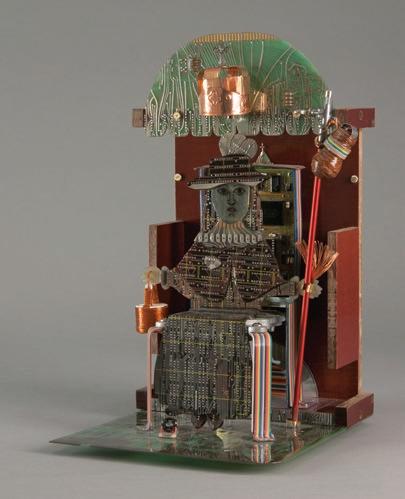

Even a traditionalist like Charlie Carrillo, who was widely criticized for helping to tighten the rules for santeros in the 1980s because of his insistence on using hand-ground pigments, now advocates for contemporary iconography. His series of saints driving pickup trucks has proved popular enough that market director Maggie Magalnick points to them as a perfect example of what is meant by “Innovation Within Tradition.”
For Carrillo, an academic as well as a santero, the key lies in telling a saint’s story accurately. He believes that variations in setting, style, and technique are acceptable interpretations; it’s when santeros start using the aesthetic language to comment on social issues that tradition gets left behind.

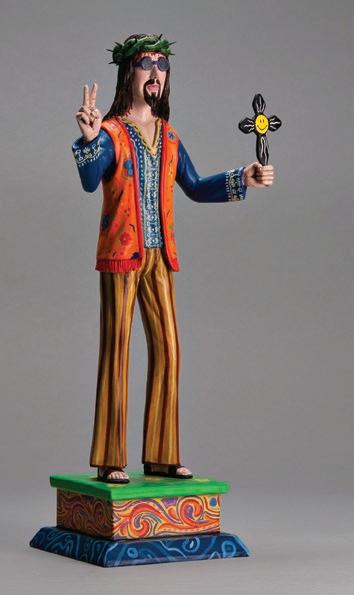
His contemporary Luis Tapia is perhaps the best-known example of that divergence. One of the few santeros to cross over into contemporary art museums, Tapia broke ground early on, painting his santos in bright colors and using them to address such contemporary dilemmas as illegal immigration and sexual abuse. Before long, he was asked to leave Spanish Market.
Tapia says his work still deals with religious themes, so he remains grounded in the santero tradition—though he calls himself a sculptor now. He believes it’s natural for culture to evolve: “Stagnant water is not healthy,” he says. The SCAS may have had the noble goal of preserving culture, but “from my point of view they were destroying it—suppressing feelings, suppressing life. How can you ask someone to express life as it was 200 years ago?”


Their motivation, he suspects, is economic: Many santeros have made good money churning out traditional saints—the most successful of them selling out within minutes—and they don’t want to change. “And those same artists,” Tapia notes, “are now going in the direction that I took.”
Pressure to allow more innovation may itself be driven by market forces, Cash suggests. She says she increasingly overhears buyers at market complain about homogeneous nature of the work, which puts pressure on artists to demand change. The paradoxical position at which the SCAS finds itself—advocating both innovation and tradition—lays bare the contradictions inherent in its mission to both preserve and commodify tradition.

Popular legends notwithstanding, New Mexico’s santeros of the 1700s and 1800s hardly sprang up in the cultural vacuum that their admirers like to claim. Studies have found strong evidence of Native design motifs, as well as borrowings from a range of imagery, techniques, and art supplies introduced by trade.
Moreover, what is now considered “traditional” Spanish Colonial is often a more recent hybrid. Nicolasa Chavez, curator of Spanish Colonial and contemporary Hispano/Latino collections at Santa Fe’s Museum of International Folk Art, notes that straw appliqué, for instance, was never used for religious subjects before the master revivalist Eliseo Rodriguez in the 1930s—after which everyone started doing it. The same is



true for retablos in tin frames, as the two media appeared in different time periods. Yet such 20th-century innovations are regularly seen at Spanish Market. In fact, folk art itself has a history of innovation, Chavez says, with the most famous “masters” being typically the ones who pushed their medium to a new level.
Tey Marianna Nunn, a scholar of Hispanic/Latino art, offers the additional caveat that categories such as “traditional” and “folk art” tend to reflect the cultural biases of the Anglo art intelligentsia. The Hispanic community itself, she says, often has a very different relationship to its “art” objects.
Santos, for example, started being made by local craftsmen in the 1700s to fill the huge demand for religious objects needed by Franciscan missionaries in their goal of converting the Native population. Production peaked in the late 1800s, then died down quickly with the arrival of imports by railroad.
Archbishop Jean Baptiste Lamy (1814–1888) also contributed by ordering churches to destroy the homegrown saints, which he found grotesque and barbaric, and replace them with prints and plaster imports—though many remained safeguarded by the Penitente Brotherhood, an influential lay confraternity also suppressed by Lamy.
With the influx of Anglo artists and intellectuals in the 20th century, the santos took on a new meaning. Fascinated with folk arts as a hedge against the dawning “machine age,” influential newcomers such as Frank Applegate and Mary Austin seized on the village crafts they found in New Mexico in the 1920s as symbols of an endangered past. It was in this same period that Indian Market was created—a parallel effort to turn cultural objects into collectible art, thus “rescuing” culture by commodifying it. The term “Spanish Colonial art” was born, along with
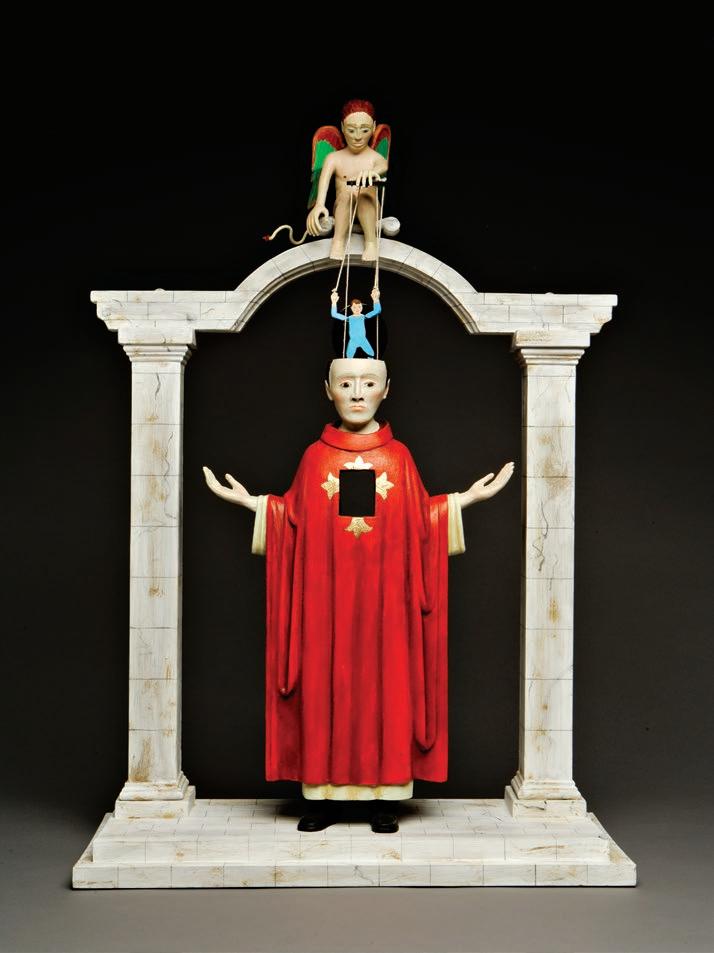


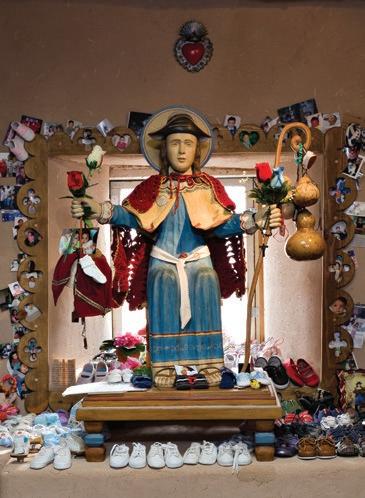
programs (such as those created by the federal Works Progress Administration in the 1930s) to promote a renaissance of village arts that would generate both producers and collectors.
In 1929 a group of influential Anglos founded the SCAS, borrowing use of the label “Spanish” to describe New Mexico’s poor, brown population—a rhetorical strategy applied since the drive for statehood to distinguish them from the distrusted “Mexicans.” As Charles Montgomery quips in his 2002 critical history The Spanish Redemption: “The cachet of ‘Spanish colonial arts’ could attract a following . . . in numbers that ‘Mexican crafts’ could not have matched.”
Like other labels re-appropriated from the dominant social group, this one ironically became over time a badge of identity and cultural pride for New Mexican Hispanos. To call oneself a Spanish colonial artist in the postmodern era is “a very political and deliberate way of communicating power, place, and identity,” says Nunn, who is now visual arts di -
rector at Albuquerque’s National Hispanic Cultural Center. It reflects “clever positioning” by contemporary santeros, she says, originating from the time when many of them took up carving—during the civil rights era.
Carrillo, Tapia, and Cash all started making santos in the 1970s, and all of them are self-taught. When they discovered the anemic Spanish Market under the portal at the Palace of Governors, it consisted of a couple dozen souls who eked out extra income selling unpainted wood carvings for around $35. All three artists say they were drawn by a desire to investigate and validate their little-understood Hispanic heritage. Refused by Santa Fe’s fine arts museum to exhibit their work, a group of these artists started mounting their own shows, says Nunn, which sparked collector interest. The revitalization of Spanish Market in the 1960s and ’70s after decades of dormancy was
thus driven by artists themselves. And these artists have always strived to “stretch,” says Nunn, as artists do by nature— though not necessarily in the easily recognized, boundless way of contemporary art.
For example, both Carrillo and Felix Lopez, another highly respected santero, researched the use of pigments, gessos, and varnishes from natural sources; both speak of it as a conscious refusal of things modern to resurrect a past that had been nearly lost. Growing up in the 1950s, says Lopez, “we were not taught the history of this area”—meaning the upper Rio Grande Valley, where he still lives. “No one taught us anything about the history of New Mexico. They were trying to teach us American history, about Washington and Lincoln.”


Lopez resented the call to set aside his culture, and in a spirit of protest he earned a master’s degree and chose to teach Spanish language at Española Valley High School for 21 years. With the death of his father in 1975, he changed direction and began to carve saints.
It was not a calling to art per se, nor to the medium of wood, but rather a mission that arose out of his strong Catholic faith, to honor his cultural traditions and do something deeply meaningful with his life. Unlike most santeros, Lopez will not sell to anyone he has not met, or without a compelling reason. Mostly he takes commissions for church sculpture and restoration of antique santos.
A soft-spoken, thoughtful man, he has been at work for three years on a life-size Christ effigy in an open monument for the Santuario de Chimayó. He credits his parents for strong grounding in the faith that used to hold together family and community in northern New Mexico against widespread, relentless poverty. Money still does not interest him, he says. He would prefer to be, as in his childhood, “rich in other ways.”
It used to be that all santeros aspired to holy lives, the better to
carve powerful santos. These sculptures were treated as members of the family and community, spoken to and dressed according to the seasons. For Lopez, this is the crux of tradition: reconnecting to a time when community and religious life were one. The choice to create santos traditionally—as sacred objects—thus represents a quiet but powerful form of cultural resistance. It overturns the Modernist definition of art as a practice in and for itself that upholds individual expression above all else. That his highly refined sculptures continue to fly under the radar of the art-loving public appears to be just fine with Lopez.
But what does it say about the place of art in contemporary society? Banished to the ghettoized category of “folk art,” Hispanics who do creative work within their tradition, like many others around the world, suffer from the same type of stereotyping as in society at large, says Nunn. Their art is immediately perceived as being not quite important enough to be studied or shown. “Eighty percent of artists represented in Santa Fe galleries are not residents of this state,” Nunn says heatedly. “I think it has a lot to do with the perception of Hispanic art and the people and the community it comes from. It gets condensed down to what museums and galleries think, as opposed to the artists’ dreams of what they could do.” Indeed, those two impulses are now poised to meet in the fight for the soul of Spanish Market—which is “taking us out of our comfort zone,” admits the market’s Magalnick. Who or what does Spanish Market serve today? Is it the demands of Santa Fe’s tourism economy, individual artists’ need for recognition, or the preservation of an endangered culture?
Says Carrillo: “‘Innovation Within Tradition’ has opened the floodgates.” R
From the Spring/Summer 2011 issue

hen you heat iron to a certain point, it moves like water,” says Tom Joyce, whose 45-year career could be seen to span several lifetimes— each a current of multidisciplinary investigation into the core substance that lures him. When he speaks of iron, you can hear the reverence in the voice of this soft-spoken artist, who will set you at ease as quickly as he’ll surprise you with the quiet brilliance that earned him a MacArthur Fellowship.
Joyce works with iron, and that is to say he grapples daily with an element that defines us. Iron oxygenates our bloodstream, he marvels, and has a 4.5-billion-year-old connection with the planet’s earliest days, having formed much of Earth’s core and provided the gravitational pull that would one day keep humans tethered to the planet. It was iron that the ancient, single-cell cyanobacteria consumed in the primordial sea, releasing the oxygen that allowed incipient life to crawl onto the earth and eventually animate the frontal cortex of our species.
Which, for all its biological success, is a species unique in its self-awareness, preoccupied by wonderings about how and why we’re here. These are questions that Joyce poses with his sculptures that, through his use of iron, reference ancient origins and the potential for new life. He uses every tool available—from the basic sketchbook or anvil and hammer of his blacksmith’s training to computer-assisted design, CT scanning, 3-D printing, and forging on an industrial scale in factory settings—to illuminate the metal’s rare character.
As influential in blacksmithing communities and academia as in the art world, the artist, who turns 60 this year, moves fluidly through his Santa Fe studio. It’s brimming with hundreds of hand-forged tools, all made to their maker’s touch and hung like comrades’ swords on the wall. Next to the forge sits a pile of iron “boulders,” which will be filled with soil collected from 4,800 battlefield sites from around the world as part of a peace memorial Joyce is crafting called Iron Cairn.
It’s in this studio that Joyce spent some 30 years training smiths and artists in an apprenticeship program he started in 1979. Now he juggles life between Santa Fe and Brussels, where he met his wife, Anne-Marie Bouttiaux, an art historian, anthropologist, and former chief of the ethnographic division at Belgium’s Royal Museum for Central Africa.
Wherever he may be, Joyce is a whirl of activity, driven from near dawn to midnight each day like a madman in love. “In a lot of ways it’s like waking up in a dream state,” Joyce says. “There’s this place I go inside the work where time collapses and it feels as though in this moment there are thousands of years of process and people sweating over this heated material to coax it into the forms we desire.” Most of Joyce’s source iron and stainless steel is scrap left over from large-scale manufacturing, and he often incorporates fragments of his former works into new alloys. “Everything from the past is pulled into the future,” he says. “There’s this unbroken thread. It’s the same overarching sense that I have about picking up a hammer.”
BY CHRISTINA PROCTER | PHOTOS BY PETER OGILVIE
“ In a lot of ways it’s like waking up in a dream state. There’s this place I go inside the work where time collapses and it feels as though in this moment there are thousands of years of process and people sweating over this heated material to coax it into the forms we desire . ”
Imagine the hammer capable of shaping 20,000 pounds of stainless steel sculptures above the subway at New York City’s Columbus Circle, where Joyce’s folded Two to One sculptures reside outside the Museum of Arts and Design. Or the responsibility Joyce shouldered when the National September 11 Memorial & Museum sent him sifting through a hangar of contorted debris from the former World Trade Center in order to forge from the collapsed structures’ iron beams a 60-foot-long excerpt from Virgil’s Aeneid in the museum’s lobby: “No day shall erase you from the memory of time.”
Were it not for the maker’s pacifism, his sculptures’ tactile allure might feel like a trap—whether it’s the curved, too-soft-tobe-metal surfaces with a patina that emerges over time, or an achingly hard piece like Aureole that pushes the material to its brink at inferno temperatures—it’s as if something is holding its breath on the other side. Joyce’s sculptures activate the sense one might get just before walking into a room of whether it’s empty or not. Beyond the jolting proportions, cohesive distortions, and textural extremes, there’s the impression of something hidden.
Joyce was born in Oklahoma to a quilt maker and an archaeologist, both of whom taught him that every part contains a clue to the whole, whether that’s a color, shape, or artifact of civilization. Joyce found his medium when family affairs took his mother and siblings to El Rito, New Mexico. An empathetic third grade teacher there changed the course of his life when she allowed him into the pottery studio one day after school, gave him a lump of clay, and let his hands do the talking.
At a time when blacksmithing was nearing extinction, having declined steadily since World War II, rural Northern New Mexico was probably one of the few places in America where a teenager could stumble into a letterpress printmaking studio and blacksmith shop. At 13, Joyce wandered onto the premises of Peter Wells, who was restoring historic printing equipment for the Museum of New Mexico. Wells decided to give the earnest kid a shot, and Joyce ended up with a summer job.
“When Peter handed me that first piece of iron, it felt strangely familiar in my hands, as if I already knew what to do with it,” Joyce says. “There was no fear—only a sense of calm, like I was standing in precisely the right place. The older I get the more I
realize that it’s such a mystery,” he adds. “I can’t begin to understand why we’re called to certain things, but boy, when it happens, don’t look back.”
When Joyce was 16, he moved out on his own and spent long hours toiling alone, learning all he could about hot work with iron. He cites various people who offered him mentorship, shelter, surrogate familial love, “and generous knowledge in lieu of a conventional upbringing and education path.” Joyce was raised by the community he found in Northern New Mexico, one that in the 1960s and ’70s, he says, “had become a hotbed for the so-called crafts revival, both through indigenous roots and from those migrating from elsewhere.”
Back at the shop, Wells must have recognized the signs of a master smith, because one day he handed Joyce the shop keys and left with the letterpress. Joyce kept up with a stream of commissions for farmers, ranchers, and anyone else in need of useful items forged in iron. He dropped out of high school, set to work full time, and struck a deal with the Museum of New Mexico to let him spend hours in their basement with Spanish Colonial objects that he refers to reverently as “teachers.” He learned techniques by tracking the marks made by smiths, and built a canon of potential design solutions.
In his early 20s, Joyce moved to Santa Fe and opened his own shop. Graduating to more demanding custom architectural metal work, he continued to seek out teachers. While visiting communist Czechoslovakia in the 1980s, he was invited to aid sculptor Alfred Habermann with a Renaissance building restoration, an experience that made an indelible impression. “I went to his studio and realized that his scrap pile consisted of almost nothing. You could hold it in your hands. Everything was reused, every little fragment turned into a rivet or nail.”
Joyce worked out of the mud-plastered adobe studio that his family and friends helped him build from the ground up in Arroyo Hondo, then later in an adjacent house. By the ’90s, his commissions had shifted to art and public pieces, including folded bowls based on the Fibonacci sequence, a church’s baptismal font pieced together from iron objects contributed by congregation members, and the Rio Grande Gates for the Albuquerque Museum of Art, forged from refuse retrieved along the river.
Fascinated by the terrestrial and celestial forces that create “violent upheavals, compression and expansion, extreme temperatures, and incessant erosion” in nature, Joyce forges under similar dramatic conditions to create sculptures like Fissure (2015), forged stainless steel and concrete, as well as Berg XV (2013/2014), forged high carbon steel (previous pages).
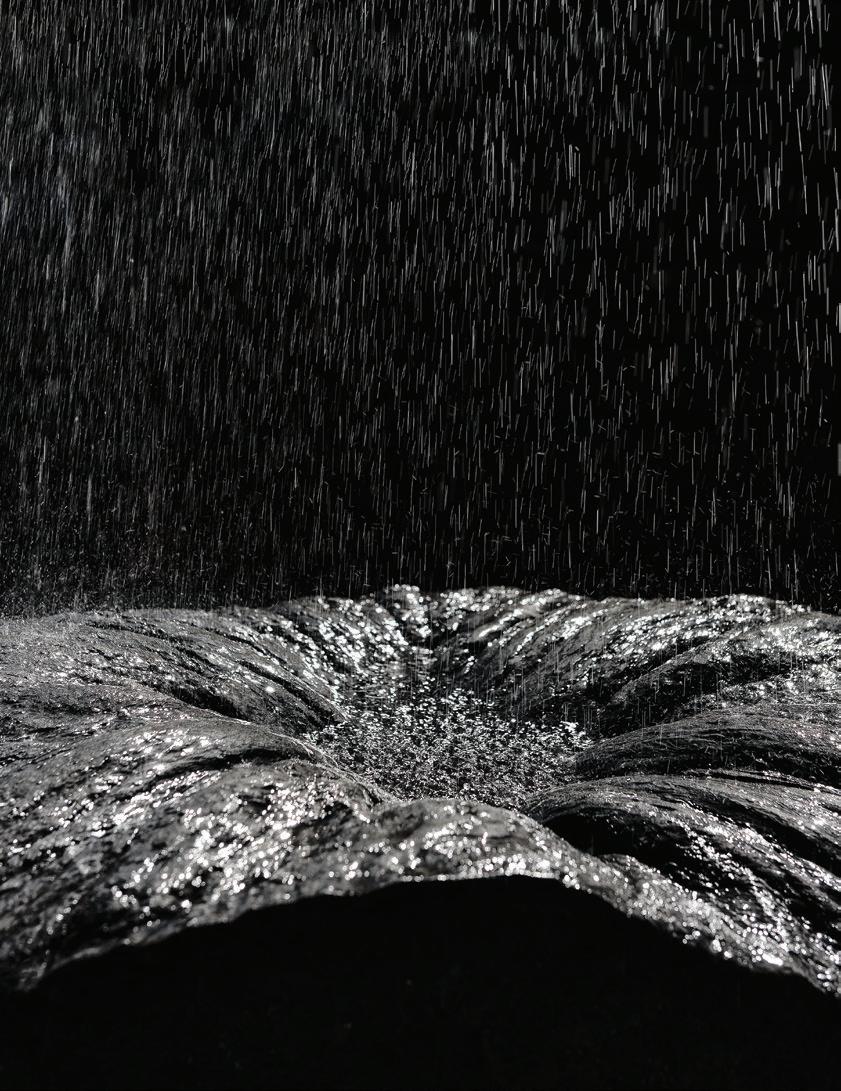

Reusing, tracing, and planting source material were early considerations for Joyce. “A lot of times a Fibonacci bowl would have something hidden within, like iron folded around a fragment from an experiment that didn’t quite work out, but which I knew had potential. Kind of like a little reliquary, a place where the idea can be mulled over. You still send it out into the world, but it’s a hidden idea.”
It’s been decades since he created these works, but Joyce is still finding new tools to help him hide his ideas or expose them. He used casting to create Core Negative sculptures from a mold first designed by sand-cast 3-D printing. “It’s a subtractive process where I make a simple geometric shape, in this case a cube of sand, and I’m excavating it in all these different directions to create a hollow space.” This was then filled with molten iron. “I wanted to make the most complicated interior shape, one absolutely impossible for me to build from a fabrication standpoint using just blacksmithing technology.”
This mold was CT-scanned to create images projected as part of Aftershock, Joyce’s show last summer at James Kelly Contemporary Gallery in Santa Fe. He describes imaging the in-
terior of the sculpture, and being able to explore the materiality of iron itself, with fresh marvel. “I used a lens that could get inside the human body, and what I saw was this circulatory system that played with the light coming in from these different channels. It started to feel like this micro scale inside the body, but also a macro scale, like what we might experience with grand architecture or interstellar activity.”
For the past decade, Joyce has taken his work to an industrial scale through a rare relationship with a large factory outside of Chicago, which is bound by a strict confidentiality agreement that forbids Joyce to identify most of what he sees made there. Instead of anvil and hammer, a hydraulic press exerting 5,500 tons of pressure and truck-operated monster tongs manipulate metal at some 2,600 degrees Fahrenheit into the massive sculptures Joyce creates out of “scrap” left over from the 250 million pounds of metal processed by the factory each month.
“It stems from taking a precious material that’s been developed for a specific purpose—and often that purpose is something that gives me pause, whether it’s a dam or a mine or a spaceship,” Joyce says, though he is obviously pleased about working with
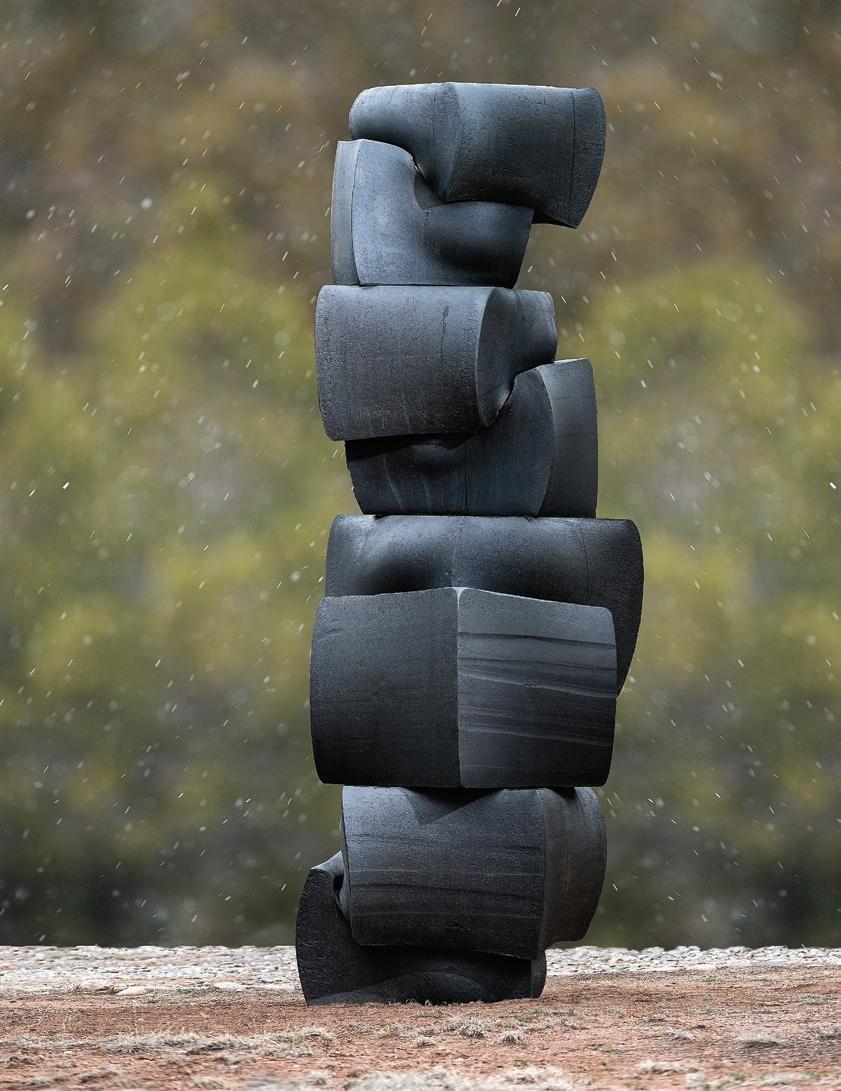



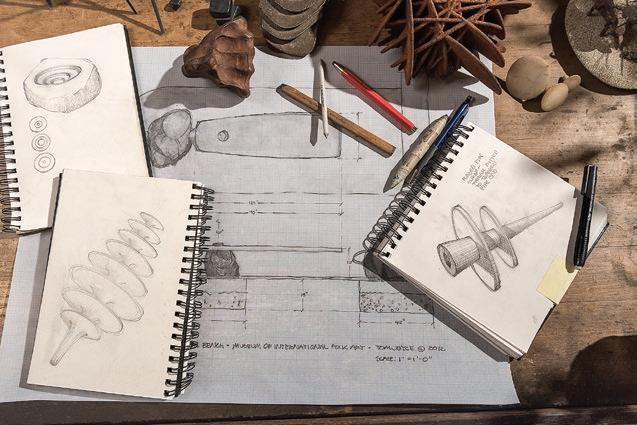


such technologically advanced alloys. “Whether it’s for defense or space, you’re on the edge—the furthest reach that humans have been able to achieve using three thousand years of knowledge to get to the next step.”
His Berg sculptures were cut from such “parent” material, which was more likely to be from a nuclear warhead than, say, a massive solar array. “Berg refers to the tip of this larger thing, but I have the offspring, the remnant material, that holds all of the ferrous ‘DNA,’ really, of that parent doing its job,” Joyce says.
To create the distorted cube sculptures that appear to be in motion, folding inward, he directed the press operator to make four angled cuts in the cardinal directions, based on a clay model he’d executed previously in his studio on a small scale. “I breach the grain,” Joyce explains, “and that breaches the structural integrity of the material. It was made to be the strongest material in the world, and with one cut I’ve rendered it useless for the purpose for which it was intended.”

Almost like the severing of an umbilical cord or a circumcision, there’s an element of ritual that one might perceive in the tensions of Joyce sculptures, which resonates with his many years of research into the smithing practices of various groups in Africa, including the Bobo and Mossi of Burkina Faso, the Dogon and Bamana of Mali, and the Ewe and Kabre of Togo. “There’s an idea that the smith tries to produce with a certain frame of mind, so that an object will have the best chance of being used in the proper way out in the world,” explains Joyce. “When they’re making something intended to harvest grain it could also be used to slit someone’s throat. That kind of responsibility is considered when someone sits or stands at the anvil.”
Procreative terminology is used to describe the smelting process, and some groups use furnaces sculpted like female torsos. The bloom—which is the industry term for the point when hard iron becomes a spongy, workable mass—is considered a
fetus, and it is “delivered” from the furnace chamber by master smelters.
Joyce has partnered with ethnomusicologist Stephen Feld to record footage of smiths in Ghana and Togo, work that will become just one part of a traveling exhibition of African art by blacksmiths that he’s co-curating for the Fowler Museum at UCLA. This survey will open in spring of 2018 and will make several stops before ending up at the Musée du quai Branly in Paris.
Fowler Director Marla Berns has been working with Joyce for years in preparation for the exhibit. “He can show you a piece of iron and tell you what makes it virtuosic. He can even identify the blows still evident in the material and explain what in the form reveals its mastery of the forging process,” she says, citing Joyce’s infectious reverence. “What makes him so significant to the field, and so important to this exhibition project,” she adds, “is what we can learn from him that others can’t see.”
The Berg sculptures that sit outside his home weigh many thousands of pounds. Their weighty curves suggest closed lips, secrets kept. “You’re not sure if it’s clay or iron,” says Joyce. “It has all the soft qualities of what happens inside the center of the Earth when things are moving. There’s a violence, too, but there’s a calm, finished object.”
As for what’s to come, whether it’s new collaborations with industries or different tools in his hands, Joyce will continue to track, pantherlike, the character of iron, which also means he’s tracking ourselves. “I think our genetic code is much more than what’s in our bodies,” he says. “I think our environment forms us, and if there’s all this space around these subatomic particles, why wouldn’t we be completely absorbent in our osmosis of everything around us?”
Perhaps his sculptures hit us so viscerally because they are, like us, suspended in potential, but earthbound. R
From the Summer 2015 issue
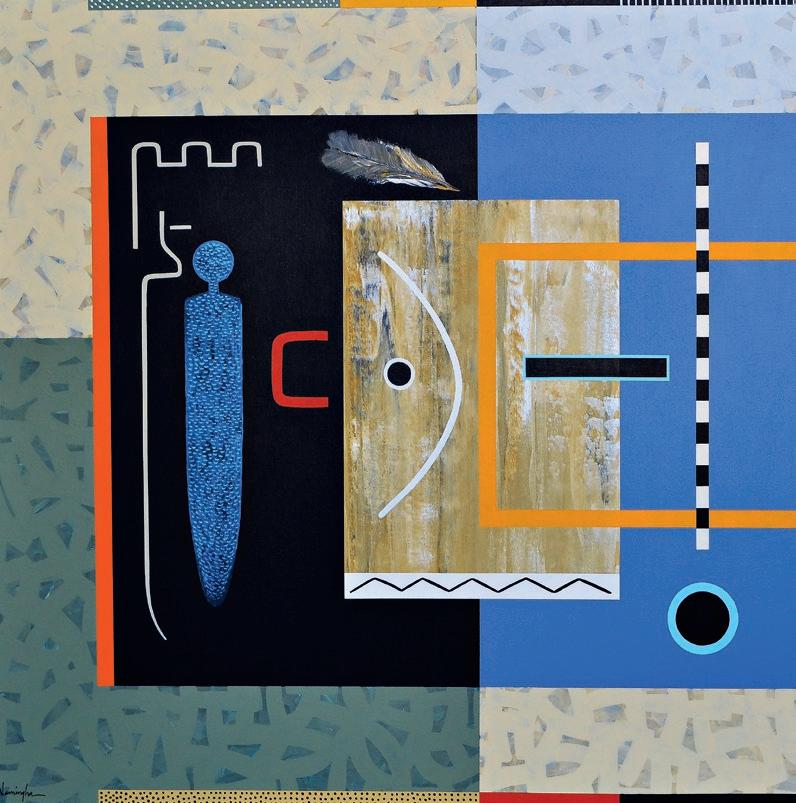

BY NANCY ZIMMERMAN | PORTRAITS BY KATE RUSSELL
Imagine a world without time, where past, present, and future merge seamlessly to form a never-ending circle of life, its gentle rhythms guiding us, sustaining us. Such is the world of the Hopi, descendants of the ancient Sikyatki people whose artistic achievements rival the finest from any culture, anywhere. Their designs were so sophisticated that they don’t look out of place today in a contemporary gallery or museum, despite having been created with rudimentary tools and materials. Ask a Hopi how it is that this ages-old artistry manages to be simultaneously historic and current, and you’ll probably get a patient smile in response. To Western civilization, obsessed as it is with measuring, saving, and spending time, it seems impossible that the intricate, abstract Hopi designs could have been created in a prehistoric world that predated the modern impressionistic, cubist, and abstract art forms they often resemble.
But to the Hopi people, who still occupy the lands of their ancestors in Arizona, there’s nothing surprising about it. “In our culture, we believe that the past is the future, the future is the past,” says Santa Fe–based Dan Namingha, an award-winning contemporary painter and sculptor.
Namingha is part of an extraordinary family of artists who descend from Nampeyo (c.1860–1942), the Tewa-Hopi woman who single-handedly revived the distinctive pottery of the Sikyatki people and who is considered one of the finest artists of her time. Nampeyo’s talent lives on in her descendants, who have taken their art to new heights in a variety of mediums while honoring their creative heritage, one born of a cosmology that celebrates the connections among all things on the planet.
Namingha was first exposed to design and color by his mother, Dextra Quotskuyva, Nampeyo’s great-granddaughter and a renowned potter who has continued to refine the unique designs of her forebears to create works of exceptional beauty. Now retired, she has received numerous awards throughout her life, among them the designation of Arizona Living Treasure in 1994, the Arizona State Museum’s Lifetime Achievement Award in 1998, and the Southwestern Association for Indian Arts (SWAIA) Lifetime Achievement Award in 2004.
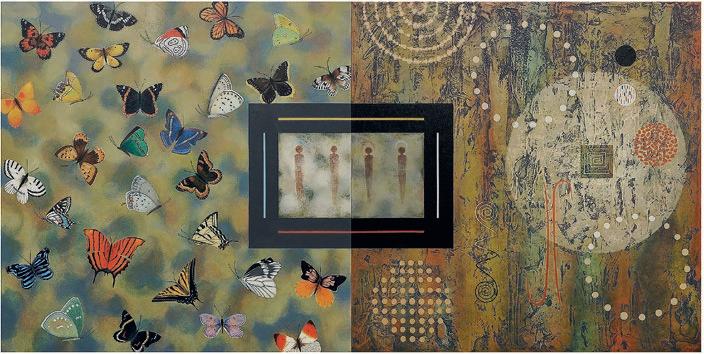
Namingha was also influenced by his grandmother, Rachel, who was a talented potter, and his grandfather, Emerson, a farmer, rancher, carpenter, stonemason, and composer of songs for Hopi ceremonies. He was raised primarily by Rachel and Emerson during his early life while Dextra, a trained nurse, left Hopi to work at the hospital in Winslow, Arizona. “I recall my grandmother giving me some of her clay to play with,” he says. “I must have been about six. Instead of doing ceramics I ended up making sculptural figures like horses and cows and chickens. I was intrigued with color. My grandfather would take me to his kiva in Middle Village and I’d watch the katsina ceremonies. It made a strong visual impression on me.” To this day he creates sculptures, working in bronze and steel rather than the clay of his early boyhood.
His introduction to painting came while he was attending elementary school in the village of Polacca on the Hopi reservation. His teacher, Lillian Russell, was a painter herself, and she provided the kids with watercolors, oil paints, charcoal, and casein in powder form, and set up a studio at the school for the kids who had an interest in art. “She would reserve an hour for all the kids to come in early and have a session with the materials. She basically instructed us in how to use them, but then left it to us to experiment with them as we pleased. That was my motivation to get up extra early, just to get to school and fiddle around with the materials.”
Since those early days, Namingha has remained true to his influences while creating a body of work that’s astonishing in its breadth, subtlety, and seemingly effortless artistry. He first studied at the University of Kansas, then later at IAIA and the American Academy of Art in Chicago. Among his numerous
awards are an honorary doctorate from IAIA granted in 2009 as well as that organization’s Visionary Award, conferred in 1997. He received New Mexico’s Governor’s Award for Excellence in the Arts in 1995 and was honored by the Santa Fe Rotary Foundation as Distinguished Artist of the Year, also in 1995. In 1994 he received a special tribute from the Harvard Foundation and Harvard’s Fogg Art Museum, and he has been the subject of two PBS documentary films and a segment of CBS’s Sunday Morning with Charles Kuralt. Thomas Hoving, the former director of New York City’s Metropolitan Museum of Art, was a devoted fan of Namingha’s work and published a book, The Art of Dan Namingha, in 2000.
In many of Namingha’s paintings he takes a minimalist approach to his subject matter, distilling the physical features of the landscape down to their essence and breathing life into the lines and curves, creating shapes reminiscent of the abstracted symbols found in Hopi pottery. “I make a landscape that’s very realistic,” he says. “I then break it down into an impression, then break it down further into an abstract form, then even further into something completely minimal. I’m trying to get to the core of the form of the landscape, and then everything else fits in. It’s like a haiku— it still sustains itself and has a sense of power and strength even though it’s very minimal.”
But it’s not all abstraction and minimalism. “I did a painting recently that’s based on butterflies,” he says, “with one side of it butterflies, the other half symbols. In the center are four figures that are referred to in Hopi as the Cloud People. My mother once told me that butterflies were a form of healing, so I wanted to do something with that.” Namingha’s younger son, Michael, had shown him a photo of a Syrian butterfly

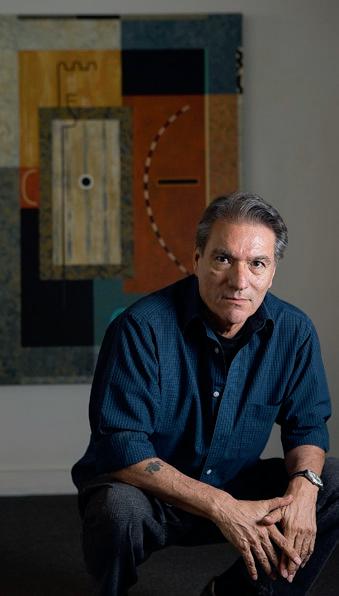

that’s on the verge of extinction, so he incorporated it into the painting and surrounded it with other butterflies from Latin America all the way through to Alaska. “I put it there because of all that’s happening in the Middle East, and the exodus of families from Syria,” he explains. “Fixing that is a long-term process, so I used their butterfly to try to heal that place.”
Namingha’s heart is never far from the ancient civilization whose life lessons and artistic expression inform his work. “In my paintings I often put a spiral in the center, which is referred to as a sipapu, the center of the world, a place of emergence based on our creation myth,” he says. “We came out of that place, that spiral, and then began our migration. And then it continues with another spiral, when we’ve reached our current home.
“The two spirals are connected, the beginning and the current place,” he says, “by the frequent pilgrimages Hopis still make to their sacred places, back to the past and the future.”
He explains that these connections have a profound influence on the culture. “There are different points throughout the Southwest that are important for the Hopi, points that connect us that we refer to as the Domain. They’re shrines that are not really visible to most people—they’re very lowkey, which protects them. They’ve been there for centuries.”
Namingha still speaks fondly of the teacher who first let him loose with art materials, and he emulated Russell’s laissezfaire approach while his own sons, Arlo, 43, and Michael, 38, were growing up. “It was a fortunate introduction to the arts for us,” says Arlo, who was honored with the Mayor’s Award for Excellence in the Arts for 2016. “Our father’s studio was open to explore, but we were never told what to do or how to express ourselves. We were free to experiment and do things our own way.”
Arlo’s work shares the minimal aesthetic of his father, but his materials of choice are wood, clay, stone, and bronze. “I prefer working with natural materials,” he says. “You create

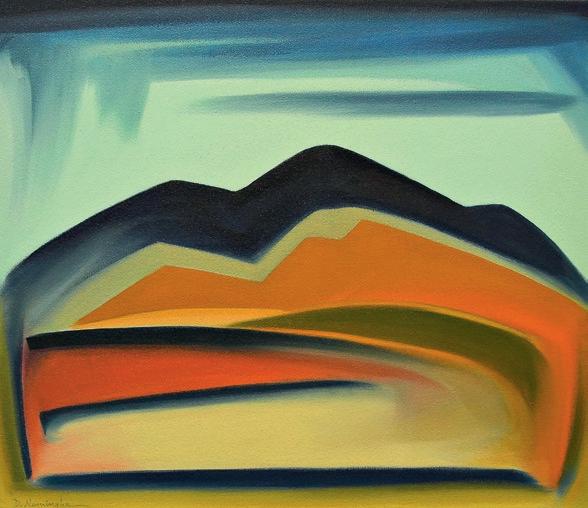

a relationship with them—you have to accept their nature because you don’t always know what they’ll do. Mother Nature always wins, so that keeps me humble.”
Ever ready to experiment, Arlo says he is constantly exploring new ideas, and he even re-engineers his tools to “make them do what I want them to do.” Many of his sculptures are interactive, with parts that can be detached, rearranged, and turned on their sides to form a variety of different sculptures, all from the same basic pieces. Simultaneously playful and profound, their reductive lines
and curves reflect the ancient Hopi designs in what Arlo calls a “dialogue through form,” conveying an earthy sophistication that connects the natural world to a subtly cerebral worldview. “I address issues by playing on mythology and current events,” he says. “My work has become more and more minimal, but there’s always a hidden element of symbolism, a little glimpse of the culture.”
The relationships and connections among the components of his sculptures speak not only to humanity’s relationship to the planet and each other but also to the infinite possibilities this relationship inspires, achieving a kind of universality that has worldwide appeal. It’s thus no surprise that his work, a uniquely American expression of creativity and inclusiveness, is especially popular among U.S. embassies, where it’s displayed in places as disparate as Switzerland, Uzbekistan, Cambodia, and the Central African Republic.
His brother Michael’s conceptual work using digital inkjet images printed on canvas, paper, Plexiglas, and vinyl evinces a similar sensibility, but with an edgier, more urban vibe. “I work with text—sayings and words,” he says, and he particularly likes working with vinyl. “I was frustrated with problems of scale, but vinyl lets me shrink things or blow them up. I was looking for a way to do something unique.”
When he studied at Parson’s School of Design in New






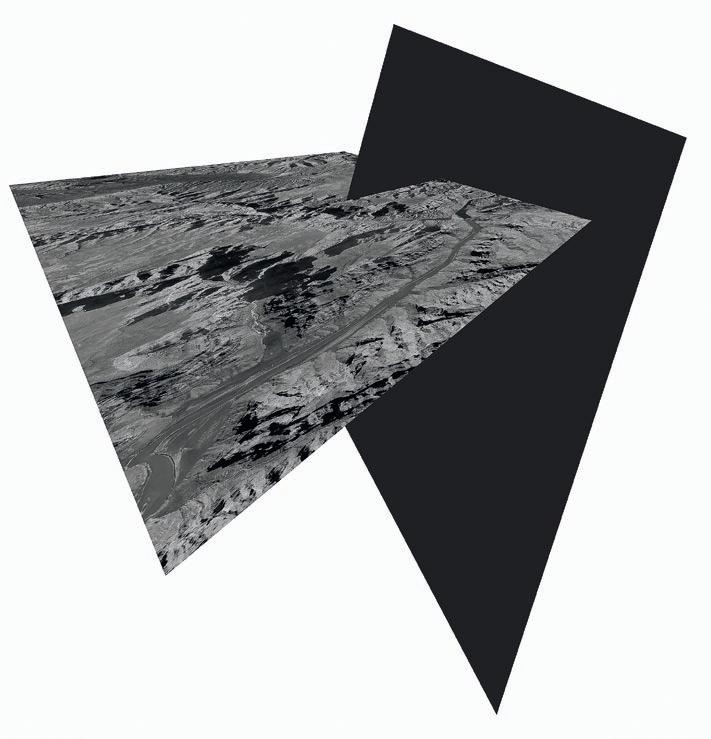
York City, Michael first explored architecture and design, and he started out by creating branding concepts that targeted consumers. “My work doesn’t relate so much to Hopi culture,” he says. “It reflects my own experience.”
That experience includes having lived through the trauma of 9/11 during his time in New York, something he’s still coming to terms with, and his fascination with all aspects of pop culture. Although he now is back in Santa Fe, his hometown, he still makes frequent trips to New York for inspiration. “I love spending time there, going to the galleries, museums, and concerts and just wandering around the city. Then I come back to Santa Fe to process it all,” he says.
During one recent trip to New York he stumbled across
proof that his Hopi ancestors would have felt right at home in today’s contemporary art world. “I was at the Met one day and I saw Salvador Dalí’s Christ of St. John of the Cross next to a Nampeyo pot!”
The minimalism that characterizes the work of his father and brother is evident in Michael’s work as well, and its apparent simplicity belies the complexity of his social commentary, which manages to convey multiple ideas in very few words, sometimes in just a single word. The message is delivered so quietly that the viewer is inclined to linger a bit to ponder the work, letting the message sink in slowly.
As different as his work is from the others, there’s an unmistakable quality to the art of all three that suggests that, in


addition to an underlying Hopi aesthetic, there’s a Namingha aesthetic as well, one that persists through the generations. “My sons have their own vision of how they see things and how they want to project that,” says Namingha. “It’s built into our name, in fact. ‘Na-ming’ means ‘by itself,’ and ‘ha’ means ‘growing.’ It refers to a volunteer plant that grows without being nurtured. My sons spent time in my studio and fiddled around, just as I did as a kid. As a metaphor, they’ve grown on their own. This is why I think our work stands alone, each different from the other but at the same time complementing one another.”
It all comes together at the gallery, Niman Fine Art, which Dan and his wife, Frances, established in Santa Fe in 1990. The gallery is run by Frances and Arlo’s wife, Nicole, both of whom hail from Ohkay Owingeh Pueblo and have a background in
business. Their assiduous stewardship of the commercial side of the enterprise affords Dan, Arlo, and Michael an enviable freedom to concentrate on their art, and the family’s closeness and obvious enjoyment of one another’s company makes this division of labor as much an expression of love as it is a practical allocation of individual talent.
“The culture is our foundation,” Namingha concludes. “I tell my sons that beyond that you can do anything you want because you’re a part of this planet and a part of the family of humanity. Whatever you apply through your medium doesn’t necessarily have to be Native American, but it can be something that covers the planet and all its inhabitants because you are part of that family. We’re all connected.” R
From the Fall 2016 issue
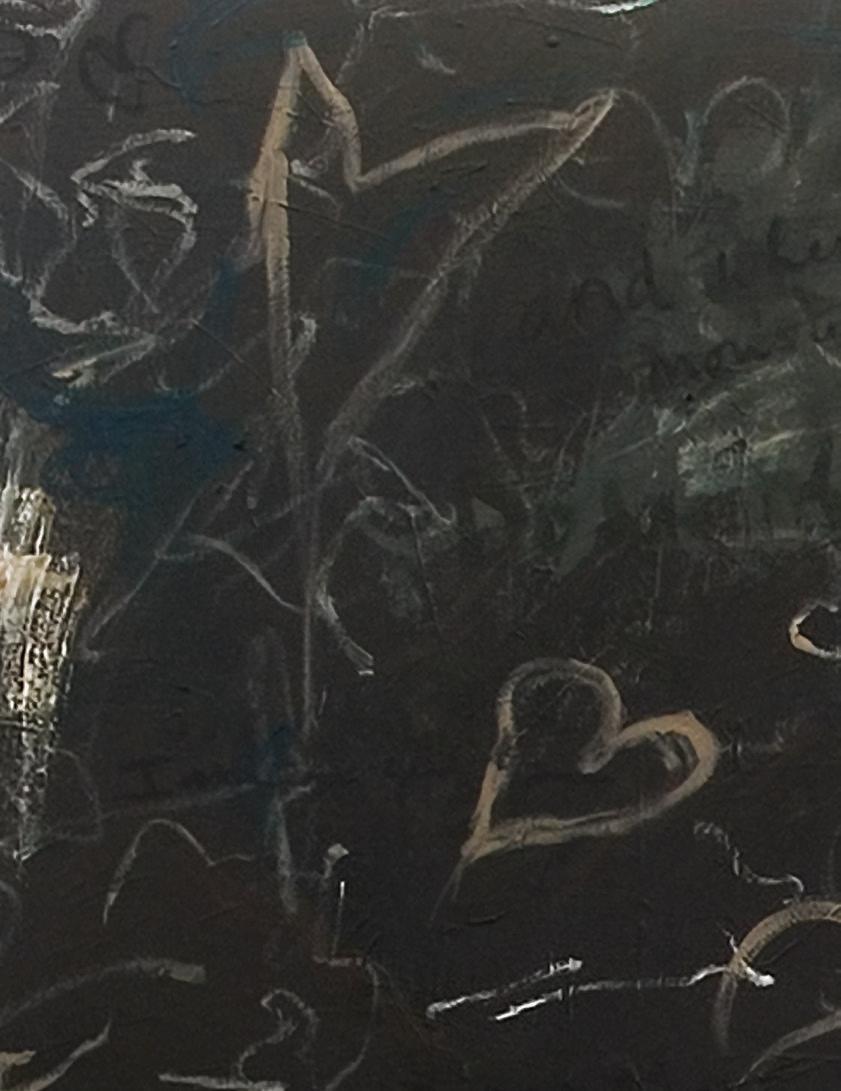
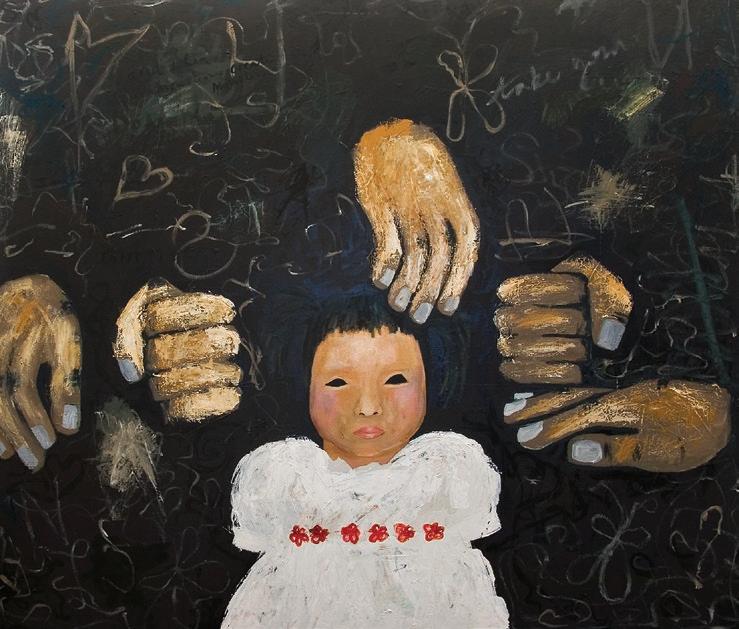
BY PEARL TIRESIAS PHOTOS BY BRENDA KELLEY
Art patrons tend to keep Indian artists in a cultural box that marginalizes their talents
Gregory Lomayesva remembers all too well the pain of his first show of contemporary paintings. In his late twenties and already a successful woodworking artist, Lomayesva was accustomed to selling out during a show’s opening night— to seeing a long row of red dots on the walls behind his masks and dolls. As a young artist, Lomayesva took the artistry of his Hispanic mother’s santera tradition and blended it with the iconography of his father’s Hopi tribe to make hybrid work that was at once traditional and unique. But while Lomayesva was making a fair chunk of change with these pieces, he wanted to break free from the role of Native American craftsman and make a name for himself as a contemporary fine artist. And that first show wasn’t the vote of confidence he was hoping for. “No one likes to lose,” says Lomayesva. “But when the night was over, nothing had sold. Nothing.”
At the time, Lomayesva’s paintings were whimsical creations in a bright palette that generally featured stylized kachina dolls surrounded by silk-screened images from pop culture—anime figures or corporate logos like those of Ferrari and Chanel—to illustrate his own personal crossroads of cultural experience: Hopi cosmology on the one hand, MTV on the other. Having watched collectors snap up his more traditional works as soon as he could finish them, Lomayesva couldn’t understand what had happened. And then it occurred to him that it just might be that the hybridization he’d created for himself left him neither here nor there—a cipher in an in-between world where he wasn’t really a traditional artist, but he wasn’t truly a contemporary artist either.
Lomayesva’s experience isn’t unique. Even in a town like Santa Fe, where Native Americans of many tribes and artists of all stripes are ubiquitous, many art-world types can’t cite more than a handful of Native American contemporary artists. The well-known artists sometimes don’t advertise their ethnicity—or they have Anglo or Hispanic surnames that conceal their heritage. Mixed-media artist Michael Lujan falls into both these categories. A graduate of the Institute of American Indian Arts (IAIA), Lujan, who is represented by the Turner Carroll Gallery, doesn’t address his heritage within his work at all, choosing to engage himself strictly in the dialogue of mainstream contemporary work.
“When I was at IAIA, there was so much emphasis on traditional crafts—and I knew I wanted to do contemporary art,” says Lujan. “The attitude about contemporary art ran along the lines of ‘Why work on something risky that might not sell, when you could crank out one “woman-in-blanket” after another and make $20,000 in a weekend at Indian Market?’”




But the justifications for making traditional art objects aren’t always quite so crass: It’s important to remember that Native America comprises hundreds of cultures that were both conquered and oppressed for centuries, and that have used ancient crafts as a way to maintain group and tribal identities.
On the other hand, contemporary aesthetics afford artists the opportunity to express themselves as individuals unbound by traditional rules. “What contemporary art really offers the maker is an individual voice that allows you to move beyond the tribe,” says Lomayesva. “As a Native artist, I’m proud of my heritage, and there’s no way I could have financed my fine-art work without my traditional work to fall back on. But, at some point, you really do want to leave behind the need to be a ‘Native artist’ and just be a person, with your own name and your own voice.”
Despite the fact that traditional Native art may be easier to bring to market, contemporary art is on the move at IAIA, with charismatic president Della Warrior leading the charge. If you were to walk the school’s hallways, you might see model dioramas of traditional village life vying for space with modern ceramic masks featuring the likenesses of Marilyn Manson and other iconic figures of the pop imagination, signaling that while traditional work is alive and well at the institute, contemporary expression is also edging its way to the forefront.
“There’s an evolving recognition here that we are the premier training ground for Native American contemporary art,” says John Villani, director of communications for IAIA. “We offer an environment where to be Native isn’t to be a minority, but in the mainstream.”
Indeed, during any given semester, up to 80 tribes might be represented at IAIA, which makes the campus feel like a kind of Native United Nations, where the differences in cultural traditions, customs, languages, geography, and, of course, art, are probed, discussed, written about, and explored in any number of media.
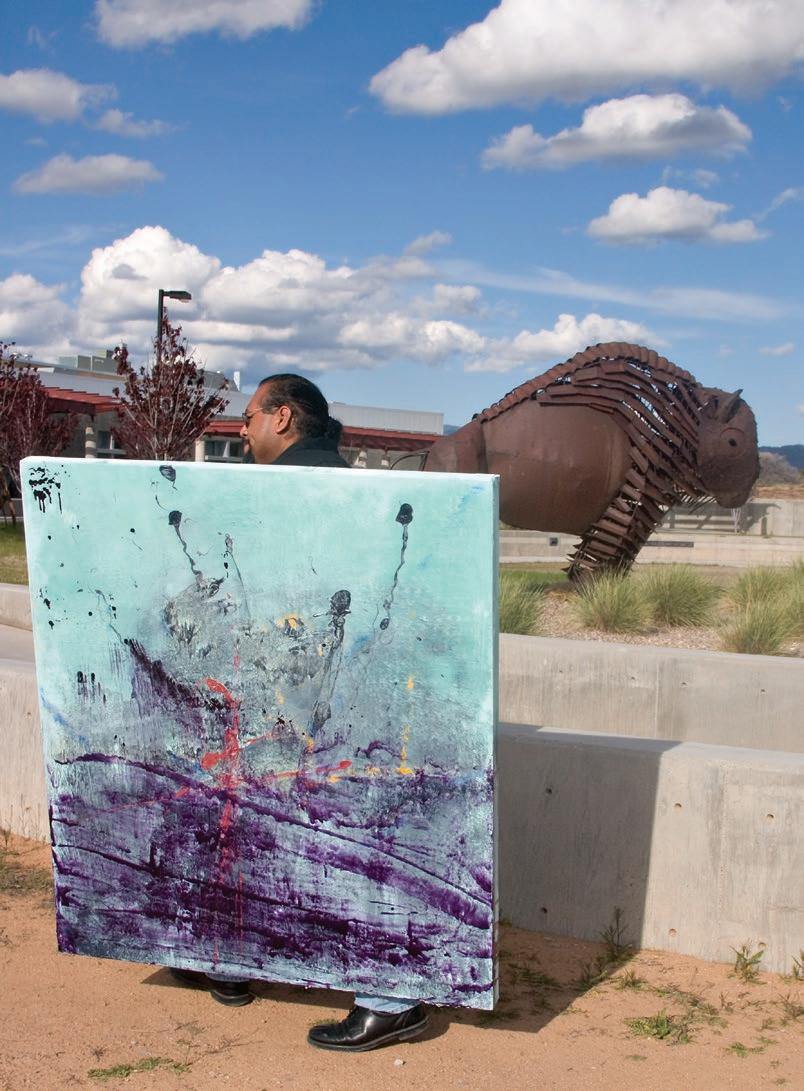
Contemporary Native American artists who incorporate traditional crafts often find themselves dismissed as “regional” artists, relegated to the fringes of a mainstream art world

David Moreno is one artist who completely changed his approach to art as a result of attending the institute. A member of the Pascua Yaqui tribe, located near Tucson, Arizona, Moreno grew up steeped in the cultural context of his nation and learned many Native crafts, including beading, dancing, and instrument-making. A mature student of 37 years, Moreno chose to attend the institute after serving as an instructor in a tribal-arts program for youth.
At IAIA, Moreno was exposed to a vast range of art-making possibilities, studying tribal traditions from around the nation as well as European art history. The method he ultimately embraced as his own was abstract expressionism. In his studio hang canvases holding rich textural layers of acrylic, as well as some figurative work depicting the deer dancers for which his tribe is known.
“The plan now is to go to graduate school,” Moreno says, “so I can further explore this particular method, and perhaps to teach again in the future.”
Diné artist April Tsosie, 28, graduated from the University of New Mexico, then applied to IAIA at the suggestion of a family friend. “My earliest work at UNM contained Native imagery,” she says, “and I seemed to spend a lot of my time educating people about that, rather than getting the critiques I needed about the work itself. At IAIA, people are less concerned with the content and more interested in how the colors work, if the painting has any direction or completion. I get a real art critique instead of a critique of my cultural background.”
After three years at IAIA, Tsosie’s work has progressed to where she’s less inclined to make the “pretty pictures” that brought her
Native America encompasses hundreds of tribes—each with its own tradition and culture— but governments and galleries attempt to lump this diversity into one neat category
there, with more of her work focusing on social commentary. For the past two years, Tsosie has successfully sold work at the Heard Museum Native American Student Art Show, and she’s been accepted at this summer’s Indian Market.
“For a Native artist, Indian Market is a really coveted show, a point of arrival,” she says. But while acceptance into Indian Market was a dream for Tsosie, she feels that what that venue wants from artists is a certain kind of work that may serve to perpetuate stereotypes about Native life.
“We hear concerns about everything at Indian Market,” counters Staci Golar, development assistant at the Southwestern Association for Indian Arts (SWAIA), the organization that stages the annual market, now in its 84th year. “Traditionalists complain that we’re showing too much contemporary work; contemporary artists think we don’t show enough. What we don’t do is segregate ‘contemporary’ work—it’s thrown into the mix along with everything else, and we try to be inclusive about what gets shown.” Ultimately, however, the very nature of Indian Market—an open-air bazaar where artists display their pieces at little booths on the street—doesn’t lend itself to showing experiential, conceptual, or installation-type work. “The key word is market,” says Golar. “We’re here to provide a venue for Native artists to sell their work. It’s not that contemporary art doesn’t sell here. It does. But some contemporary work isn’t meant to be sold in the first place—installation art, for example.”
Works like installation or performance art, which are primarily conceptual in nature, aren’t on display in commercial galleries, either.
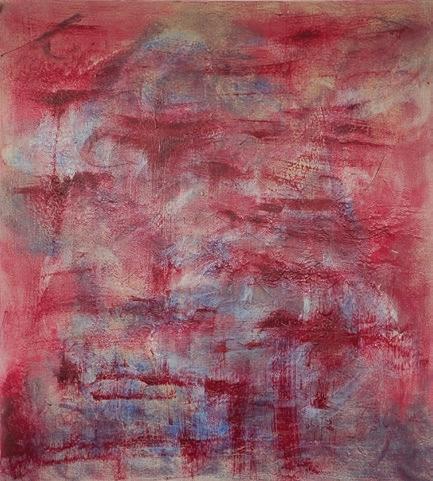
So it falls to universities and museums to show such art, and Native Americans now have several museums of their own. Most of them, like the Heard Museum in Phoenix, the Museum of Indian Arts and Culture in Santa Fe, and the Smithsonian’s National Museum of the American Indian (NMAI) in Washington, D.C., have exhibition agendas that extend beyond just the arts to include Native history and culture. “There’s a real commitment here at NMAI to present Native Americans as a living people, and that means a commitment to contemporary art and artistry,” says spokesperson Amy Drapeau.
NMAI exhibits reflecting that commitment include the recent “Reservation X: The Power of Place,” which featured seven Native artists examining the issues of place and identity. In summer 2005, performance and installation artist James Luna will represent the museum at the Venice Biennale. Luna, whose work has also been shown at the Whitney Museum, is perhaps best known for The Artifact Piece, in which he placed himself inside a glass-lined display case as a commentary on how Native Americans are put on display in anthropology museums.
Contemporary Native American artists who incorporate traditional crafts can often find themselves dismissed as “regional” or “outsider” artists, relegated to the margins of a mainstream art world dominated by Eurocentric symbolism. Within this European culture, the basic understanding that Native America encompasses hundreds of different tribes—each with its own distinct traditions and culture—is often lost, as entities ranging from governments to galleries attempt to lump this diversity into one neat category. To understand the problem in mainstream
cultural terms, imagine that the French, Spanish, Finns, and Italians were told they were all “just Europeans,” and that their major cultural works—from Leonardo’s The Last Supper to Bosch’s Garden of Earthly Delights —were “regional” and “outsider” because they contained iconography of local religious rites rife with superstitious ideas. You can see the absurdity of such distinctions.
It’s not just artists who need to be concerned about the effects of such labeling. While Santa Fe may be one of the largest art markets in the world in terms of gross sales, the general perception of the art here is that it’s about as cutting-edge and compelling as Santa Fe style: rife with the kitschy, “Wild West” images of gunslingers, sunset-besotted landscapes, buffalo herds, cowboys, and, um, Indians. Santa Fe gallerists who want to identify themselves with the capital C, capital A Contemporary Art world may actually be going to great lengths to avoid Native works that incorporate cultural iconography. When this occurs with much frequency, it’s no leap to see that Native artists might more easily get their work into Chicago, Kansas City, or Dallas galleries.
That is, of course, unless Native Americans open their own Santa Fe venues. A few have done so, but they tend to be artists already enjoying successful careers. An upstart enterprise aligning itself with both Native and contemporary art risks marginalization—a frustrating outcome for an indigenous community whose artistic expression deserves to inhabit more than just the art scene’s fringes. R
From the Summer/Fall 2005 issue









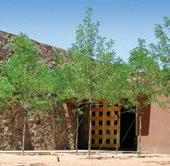
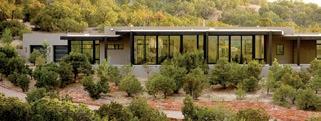
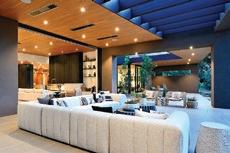

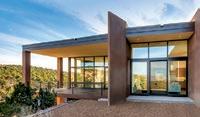



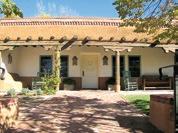
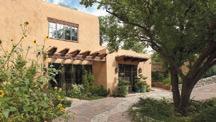




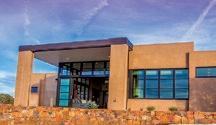








Inspired partnerships inform Santa Fe’s built environment















Fine Cabinetry • Renovations
Serving Santa Fe since 1997, DMC proffers custom design and licensed General Contracting services. From full home renovations to historic restorations, new construction, and fine cabinetry, we celebrate and elevate Southwest Design, transforming the home with intention.
Harmoniously joining classical, traditional designs with modern, contemporary finishes, DMC endeavors to keep pace with industry trends while thoughtfully designing for longevity. Our creative design team and knowledgeable craftsmen work together to provide value, efficiency, and thoughtful solutions.
DMC is dedicated to manifesting our client’s visions. Our world-class showroom provides the opportunity to experience our full suite of domestic and imported cabinetry offerings. Representing Leicht of Germany, as well as our own domestic product lines, DMC offers a complete package of cabinetry selections.
Throughout our custom or semi-custom design process, we carefully tailor our services to exceed client expectations, seamlessly transitioning visions to reality. Our thoughtful team of project managers and custom installers are committed to honoring our clients’ lifestyles.
505-992-8382
dmaahsconstruction.com
Showroom by Appointment
1570 Pacheco St. Suite C-1
BY ELLEN BERKOVITCH |
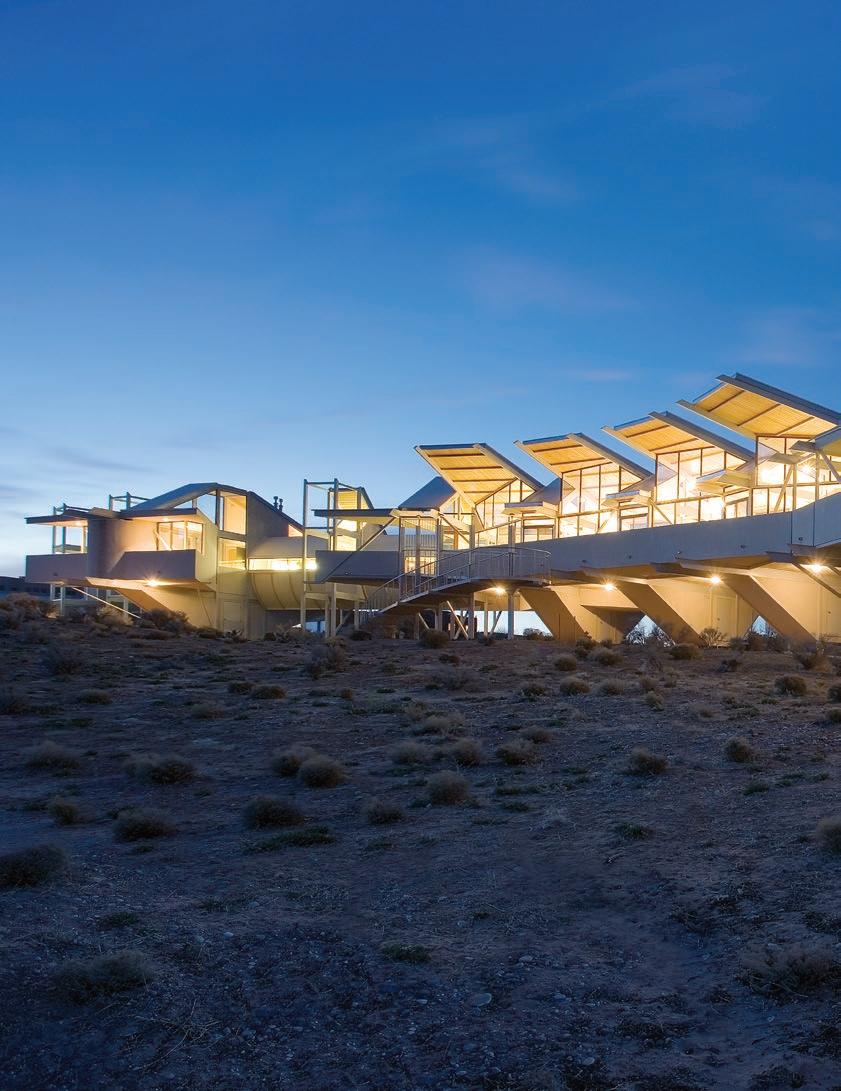
RECK


Try to label architect Bart Prince, and you may find yourself pondering whether the concept is protractors or Pixar. A vigorous animator of space, the New Mexico native (his great-grandfather LeBaron Bradford Prince was governor) has made a career of designing houses that mere mortals cannot visualize until they are manifest on the ground—strange, snaking geometries on a lunar landscape; odd consorts of materials; ribbed interiors with bone structures as complex as exoskeletons, and frequently, names.
Names? Yes, names—the snake house, the snail house, the Smurf house, an “A-frame on acid” (from a critic at Architectural Record, reporting on a Prince house in Mendocino, California)—are just some of the personifications assigned to Prince houses, dubbed by onlookers who, Prince acknowledges, always tend to anthropomorphize his architecture.
The architect saw his first houses built on Albuquerque city lots (by builder Fred Hill) while he was still in high school. Knowing from childhood that architecture was his vocation, he graduated from Arizona State University, where he met his mentor, Bruce Goff, and spent time visiting Paolo Soleri’s Cosanti. He returned to Albuquerque and set up architecture shop in 1973.
Yet any hint of regionalism ends there, and the world for Bart Prince opens into a practice that offers buildings so constantly surprising as to be solely ascribable to the architect’s compulsion to make a new architecture for our times. “I’m not interested in developing one style or one visual idea,” Prince says. “Materials are available to everybody. Geometry

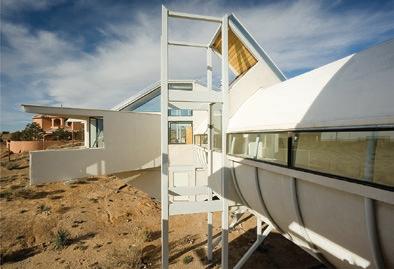
Photos, clockwise from above: A view of the snake house looking west (top left), the south elevation of the master bedroom (top right), and the northeast side of the master bedroom (bottom). The site plan at right shows the house sprawling vertically down the lot. Opposite: Gallery spaces in Prince houses (top) serve as connecting elements that provide owners a place for displaying collections or housing books. Structural curved pipes in the sunken living room (bottom) run the length of the house. Preceding pages: Snake house at dusk. Passive solar access draws sunlight deep into the space, while the overhanging roof panels shade the house in summertime.




Looking
exists in the general domain. My interest in architecture is how it becomes a work of art.”
Prince’s name now—a signature on houses whose forms are unmistakable yet never replicated (“I tell people that even from an early age I was always trying to get rid of gravity and the horizon line,” he says)—is cited regularly in international architecture circles as being heir to Goff, and, in turn, to Frank Lloyd Wright, with whom Goff first corresponded in 1916. Goff was 12 then, and he received in return a signed Wasmuth portfolio of drawings from the elder architecture maverick whose Wisconsin home and studio, Taliesin, had been burned down by arson two years earlier.
The modernist years for 20th-century architects were a time in which patrons made actual architectural aspirant’s ambitions. The dynamic over whose patron was whose sometimes led to arguments. One such snafu that got Wright fired up—according to stories that Prince heard from Goff, which he relates with gusto, clearly relishing the memory of his friend (who died in 1982) in the retelling—was over the patron Joe Price. The Price family in Oklahoma had built the Wright-designed Price Tower (Wright’s first skyscraper, 1956, in Bartlesville, OK), but Joe Price in turn commissioned Goff to design his first house. That irked Wright, but it was through this sort of knighthood of the moderns that Prince got his jump start too; beginning in the late 1970s, he and Goff collaborated on Goff’s last—and Prince’s first—major building, the Pavilion for Japanese Art (to house the Shin’enKan collection of
Joe and Etsuko Price at the Los Angeles County Museum of Art), completed in 1988. The Joe and Etsuko Price house in Corona del Mar ensued as a private project for Prince—and made Joe Price’s name synonymous with patronage of the avant-garde.
The tag “neo-organic” that has followed Prince through his career tracks a dotted line back to Wright and the Prairie style, implying a signature integration of materials and site. Yet imitation is anathema to Prince, who trumpets the “make it new” injunction across his entire body of work.
“I was interested in Wright from a very early age,” he allows. “Later on I became worried that [Wright’s] work is so strong, the danger is becoming trapped by it and imitating it. You become really enthralled by such a strong work and you can’t see past it, is the danger.”
Prince’s own house-studio in Albuquerque is a traffic stopper. A crenellated tower of concrete block marks one edge of the site. Wrapped with a spiral staircase, it resembles fantasy architecture from a Giambattista Piranesi engraving. His newest building addition is a 100-foot cantilever jutting into the cottonwood trees above the street like an elevated bowling alley. A perambulator of that corridor—filled with Prince’s painting collection—may note that the walls and floors, of identical rough-sawn plywood, illustrate Prince’s notion that a wall need not end at the floor, nor vice versa.
For the recent house in Mendocino that led an Architectural Record critic to free-associate the design to hallucinogens, Prince created a spacious, undulating plan that from the outside resembles
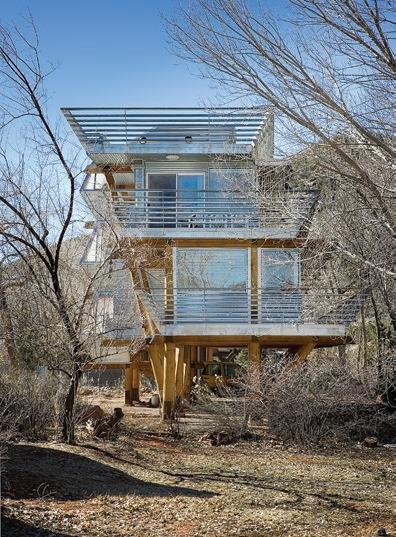

Clockwise from left: The Jemez Springs house is a system of poles designed to deal with the site on a Jemez River floodplain that flows as high as 10 feet— Prince raised the house to create outdoor living spaces underneath; north elevation; a roof terrace opens at the top of a spiral staircase that connects the floors.



into
Right: Triangular wall panels provide lateral support to the house. “I always express what’s going on in the structure,” Prince says. Opposite: The west deck of the living room overlooks the stream. At each end of the house larger terraces open to 360-degree north and south vistas.

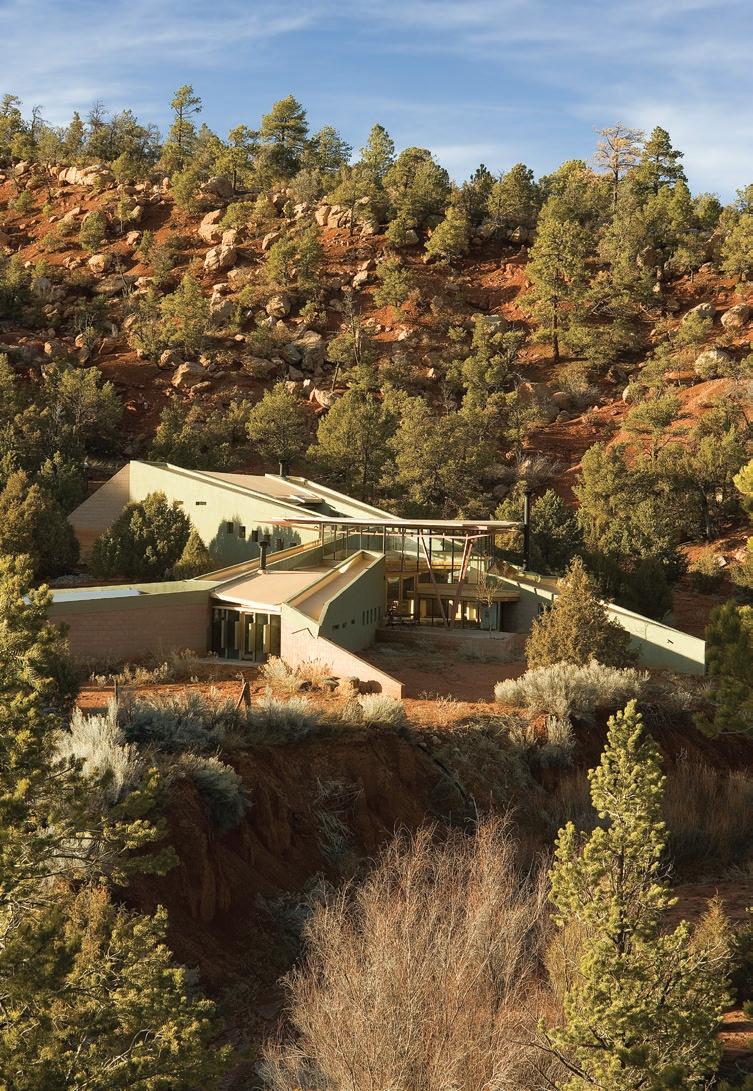
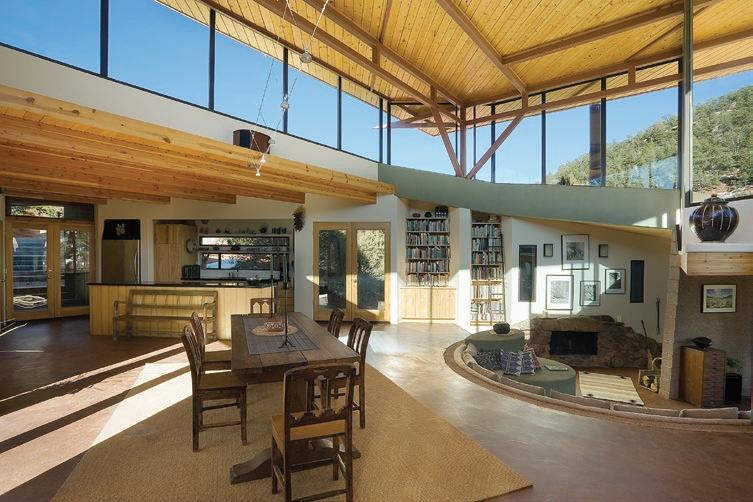
Above: A floating roof over the Glorieta house living room provides a pavilion that lifts the rest of the structure and lets you see to the distant hills. The lightness of the enclosure conveys the impression of the house’s opening to nature. Right: A recessed living area is signature Prince. Under the point of the triangular roof that covers the glass corner of the house, a terrace opens to the south. Opposite: The house’s wings (foreground) extend like arms that enclose the southfacing space to block wind in winter and shield solar gain in summer.
a geometry of compound curves covered in shingles. Inside, an angular and elaborate beam structure—64 feet from one end to the other—scared the contractor so badly he had to be persuaded to take the job.
Prince’s so-called snake house, built on a flood plain in Rio Rancho, New Mexico, coils atop the ground, in an elevated plan, for an owner who enjoys traversing the jointed body of her dwelling—in plan, visualize a shotgun concept blasted madly with kinetic energy that makes the snake writhe. Prince met the client when she attended a lecture he delivered at the University of New Mexico. When she came to the office, he relates, she asked for a house and requested, “Is it possible to stretch it?” He laughs.
A pole house in Jemez Springs—shiny as an art deco breakfront with corrugated steel panels—replaced the owners’ on-site doublewide; Prince punned on the style in cladding a triple stack in space-age material. A cabin under construction in Datil resembles the monocle of a desert-bound Captain Hook. Its part-time resident-owner—who otherwise lives in a distant state—can close it up inside a folding metal sheathe Prince designed. And in Glorieta, a psychologist who had formerly inhabited an old adobe in downtown Santa Fe wanted a house that would work with the adamant red earth of the site, be solar, and break the harsh western winds; Prince
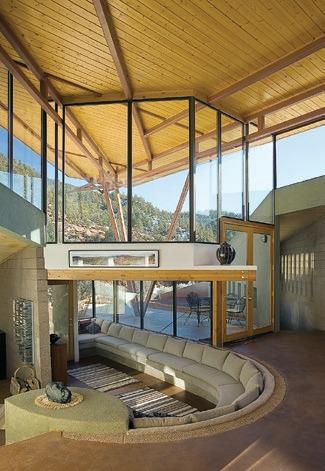
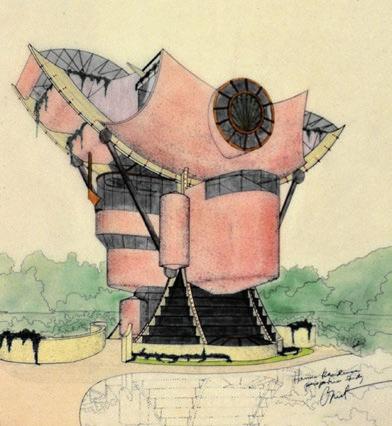
Prince’s drawings are integral to his design process. Above, left: Hanna residence perspective drawing, southeast view (1974). Above, right: In a cross section, a vertical line shows a waterfall cascading through the center of the house. Right: A plan (top) and elevation (bottom) for the Porter-McGehee residence in Cerrillos (1984) shows active solar design making use of adjacent rock walls as storage.


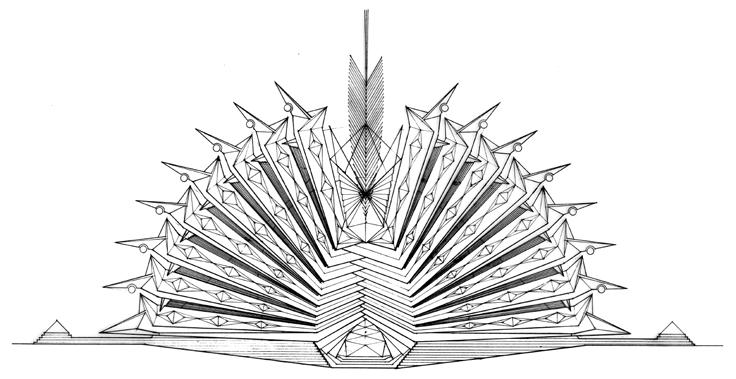
Never before published is Prince’s 1971 ink-on-Mylar drawing of an Indian Arts Center in Taos, an unbuilt project. “I was trying to create a modern expression of the creativity of native peoples without imitating their geometries,” he says. Below: A Datil cabin (2000) is a cylindrical structure secured in a steel armature that permits it to be sealed “like a person-devouring robot.”
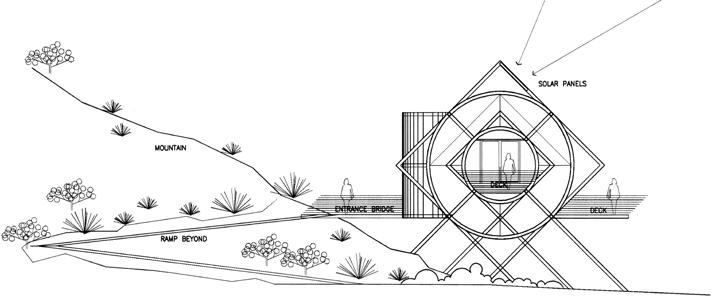
gave her all that in forms that tether to the ground and end in acute angles.
The architect relies in his practice on the word “synthesis”—the concept that plays out in considering site, climate, and clients’ needs. He says he thinks for a long time first, draws second, and constructs models, finally, in order to help clients visualize their projects. “Architecture,” says Prince, “is above all a creative art.”
“‘House’ means to people something very specific. If you show a pitched roof with a door and a couple of windows, everybody is going to say ‘house.’ But when you show them something like most of these, that’s not the first thing that comes to mind—they’ll say ‘spaceship’ or ‘caterpillar.’
“I have people who say to me, ‘You must stay awake nights trying to think of weird things to do.’
“No, on the contrary. I think when you work this way—trying to
work from the inside of the problem, and letting the building grow from that and not trying to force it into a shape—you’re going to end up with a much more creative solution than if you were just trying to think of a form or a shape.”
What ensues, Prince allows, can be radically original: “The idea that you could actually have something for yourself doesn’t really occur to most people. People buy the cars they’re offered and the houses that are built—because they figure that’s what those things have to look like.
“Somebody once asked Picasso to explain a painting, and he said, ‘If I could explain it, you wouldn’t need the painting.’ You know, it’s easier for me to do architecture than explain it.” R
From the Spring 2007 issue
BY NANCY ZIMMERMAN

The late architect Jeff Harnar melded contemporary materials with an appreciation of the natural world

The dominant conversation in Santa Fe’s architecture circles continues to be the debate over preservation versus progress in our local aesthetic. Amid the chatter, one visionary stands out: native New Mexican Jeff Harnar, who in the years before his death in June 2006 at age 52 strove to honor indigenous architectural forms while moving beyond their stereotypes, in the process formulating a distinct vernacular style. While Harnar’s time on this planet was lamentably short, he produced a variety of architectural creations that signaled a bold departure from the region’s ancient adobe tradition.
Like many of his peers, Harnar found Santa Fe’s rigid design regulations stultifying and unrealistic, noting that they originated as a tool to lure tourists by freezing architecture at some arbitrary point in time. “If the original adobe builders were alive today,” he told writer Michael J. Crosbie in an interview in Architecture in 1991, “they probably wouldn’t be building with adobe. They’d be trying out new materials and techniques.”
This he chose to do himself, making use of steel, glass, and concrete to fashion asymmetrical spaces that conform to the landscape rather than imposing on it. While these materials dictate an inherently modern aesthetic, Harnar employed them in accordance with ancient priorities, siting his buildings to harmonize with the movement of the sun and stars, and with the cycles of the solstices and equinoxes. By thoroughly researching the physical environment of each building site, he was able to create an abstracted form of the themes he discovered there—trees, arroyos, the swell of the earth, the sweep of the sky. He also incorporated the views and existing vegetation into his designs, moving walls and even entire structures when necessary to avoid unduly disturbing the landscape. This attention to the natural world accounts for his projects’ relative invisibility: Molded into the earth and tucked discreetly amid trees and rocks, his homes seem to merge organically with the land, their contemporary contours and striking silhouettes notwithstanding.
“Jeff’s mission was to take care of the environment,” says his widow, Lori, “and he believed in constructing homes that required minimal maintenance.” Their own home, still a work in progress at the time of his death, is built of steel, concrete, and fiber cement made of recycled materials formed into 5' x 10' sheets; no drywall, paint, or tile was used. “Jeff always said that the house had to work with the land,” Lori continues, “and he used his exceptional vision to make that happen. He had a talent for drawing, and he drew all the time—designing furniture, a cupboard, entire houses. He’d draw the plans first by hand, then put them into the computer. His ideas were never solely artistic; they were always practical, too. He streamlined all the interior surfaces to eliminate lips or anything that would catch dust, so they’d be easy to clean. And he wanted to have low or no utility bills, so the house is bermed into the hillside for natural insulation. It’s as ‘off the grid’ as it gets in the city.”
Harnar also used natural light as one of his materials, adjusting the building’s design to accommodate the path of the sun. His use of space tended toward unexpected juxtapositions of stairways and walls to create new perspectives. This blend of practicality, artistry, and reverence for the spirit of the land informs his considerable legacy: contemporary homes that seem to hold their occupants in a warm embrace—not unlike their adobe counterparts of old.
From the Fall 2006 / Winter 2007 issue
Hard edges tempered by subtle curves characterize Harnar’s approach to architecture. A garage door of bronze and etched glass is softened by the gentle sweep of stucco and wood and the graceful lines of the statue, Demure , by Robert Holmes, that guards the entryway (opposite).
A preliminary sketch (above) details Harnar’s ability to integrate his contemporary structures with the landscape).
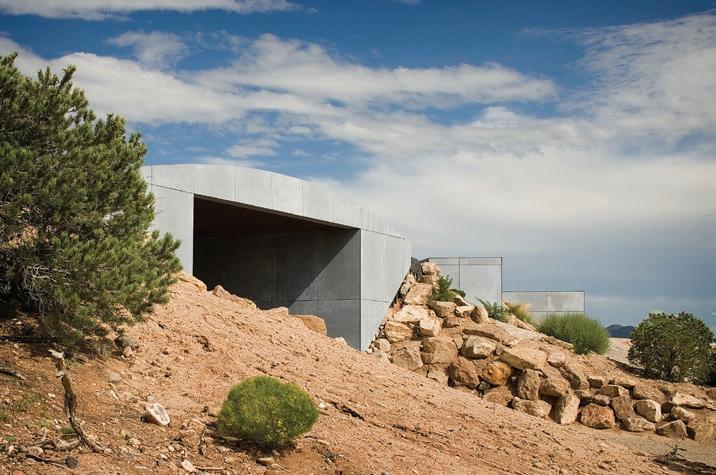

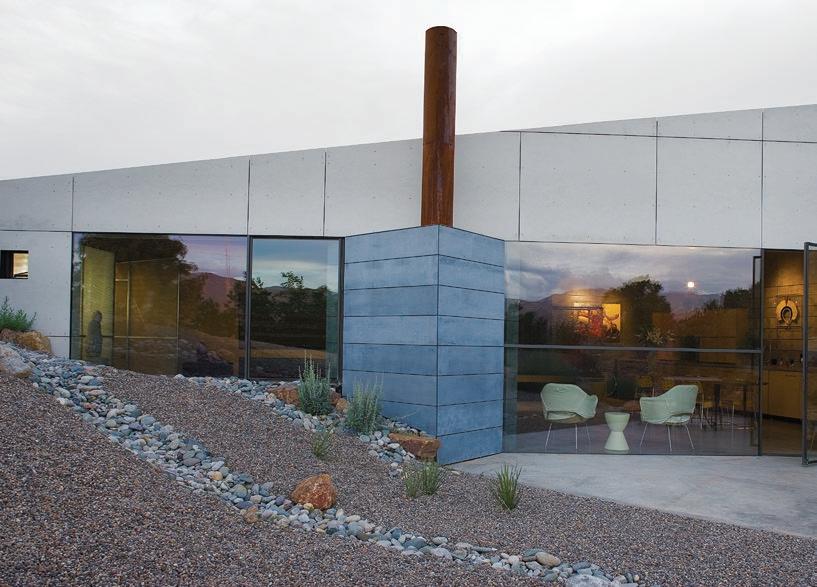
A tunnel leading to Harnar’s own residence is all but hidden by the hillside into which it’s carved (opposite top). Also embraced by the surrounding hillside, the adjacent guesthouse (above) is well insulated in winter and summer. The angular fireplace, which can be enjoyed from both the living space and the bedroom, breaks up the exterior facade to create intriguing angles.
A sculpturelike garage (opposite bottom) was custom color-tinted to mimic the moss on the rocks of the mountainside, minimizing the visibility of the structure when viewed from afar. The steel-laminated door has a unique organic patina that the homeowner created using materials from his garden. The sculptural piece at the entrance to the stairs is structural steel with a solar-screen backing.

For a couple who cooks and entertains frequently, Harnar created a floating wall that divides the kitchen and dining room and contrasts with the clean lines of the whitewashed cherry cabinetry and floor-to-ceiling windows (above). The large, sail-shaped island allows the homeowners to mingle with guests while working in the kitchen; its curves are echoed by the skylights overhead. In another Harnar home (opposite), angles unite in the hallway to make efficient but artistic use of limited square footage. A vertical bookshelf serves as functional art, creating storage in an otherwise tight space. Ceiling and walls are made from the same industrial steel used to create bridges and skyscrapers. The chocolate-brown patina adds warmth, contrasting with the polished concrete floor, maple wall, and fiber-cement paneling.

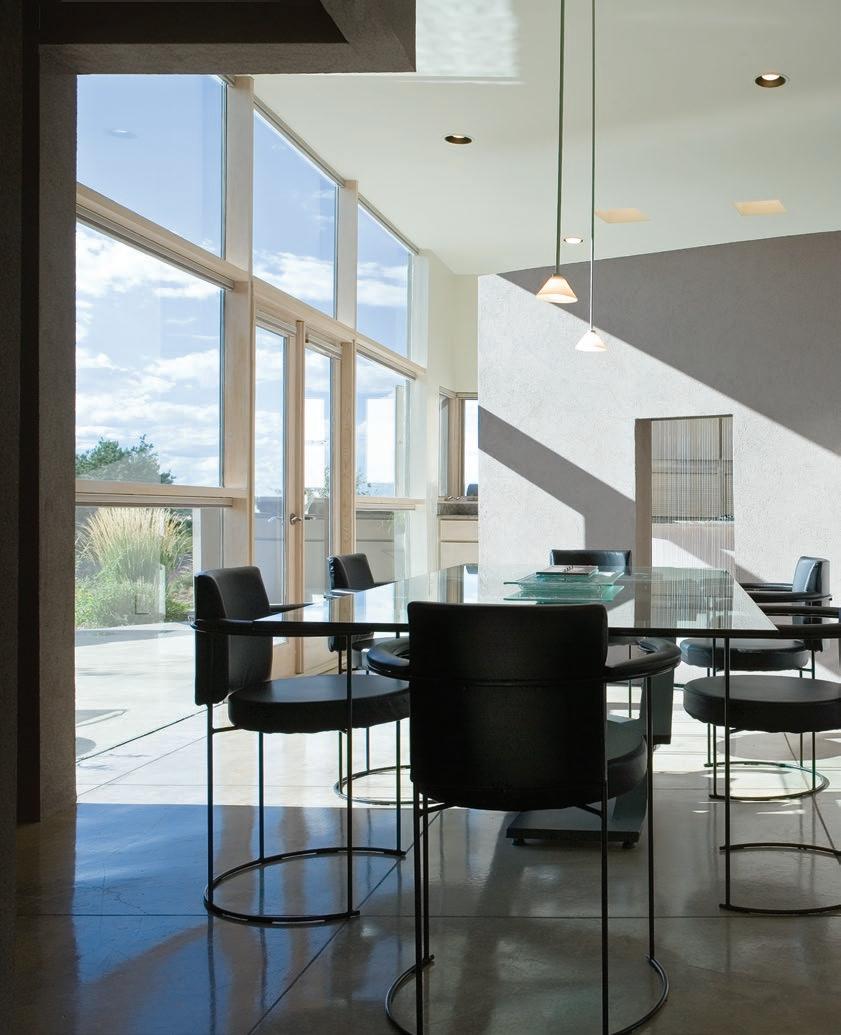

A west-facing glass wall suffuses this dining area with dramatic light. The floating wall that separates the dining space from the kitchen adds a gentle contour to the otherwise rectilinear space. “People ask me why I don’t hang art on it,” says the homeowner, “but it is art!” Her husband, a hydrogeologist, “wanted to bring the sinuous feeling of water into the house,” so he worked with Harnar to create a water feature in the floating wall. After much trial and error and quite a bit of fishing line, they created a system that sends delicate streams of water cascading between the two rooms.

This well-defined outdoor space can be accessed from every room in the house, and all the decks connect (above). The raised fire place (opposite) with a slate hearth adds warmth to chilly evenings as well as visual interest. The square cutouts in the wall bordering the stairs and the curve of the roof overhang create a geometrical tableau, illustrating Harnar’s skillful manipulation of shapes, angles, and asymmetry.


For this solar-heated home (above) sited on steep terrain, Harnar created a design requiring a minimum of building materials—an important consideration since everything had to be ferried up the mountainside either by hand or via a handmade tram. Industrial steel panels with an earthy, organic patina form the ceiling and back wall. Floor-to-ceiling glass in the front of the house takes advantage of solar gain. An entry foyer (opposite) mimics the coiling of a nautilus shell, the spiral getting wider and taller as it opens. At its narrowest point is a six-foot-wide, opaque-glass front door designed by Barry Brukoff of Sausalito, California. The cabinetry and cantilevered bench, also designed by Brukoff, appear to float in space.
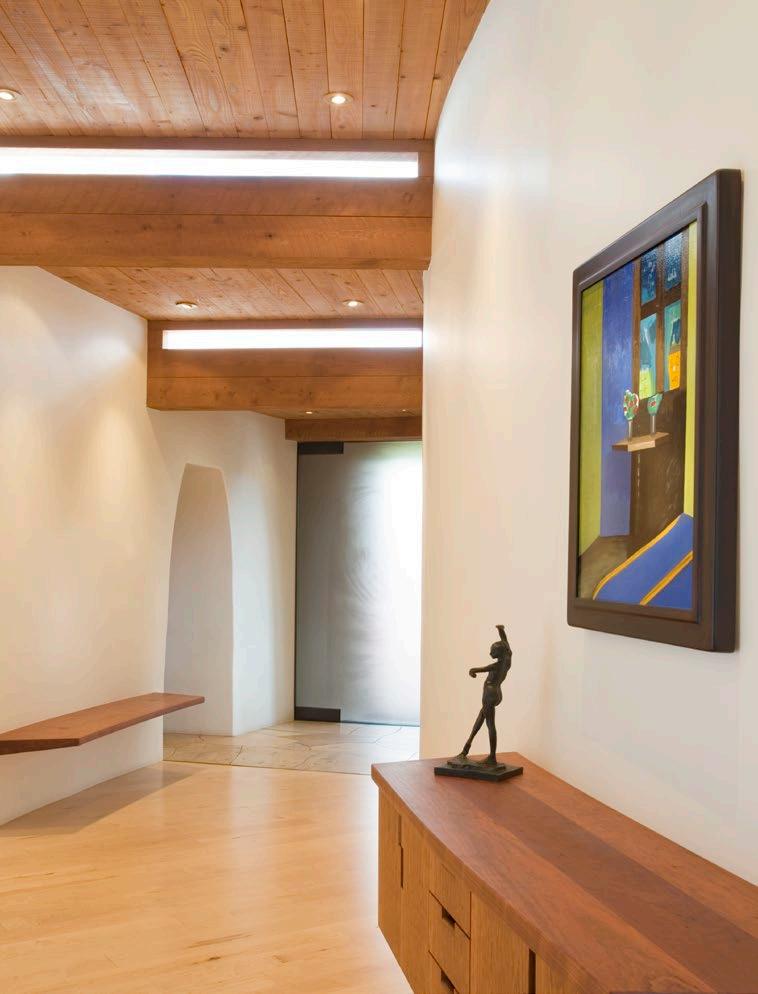
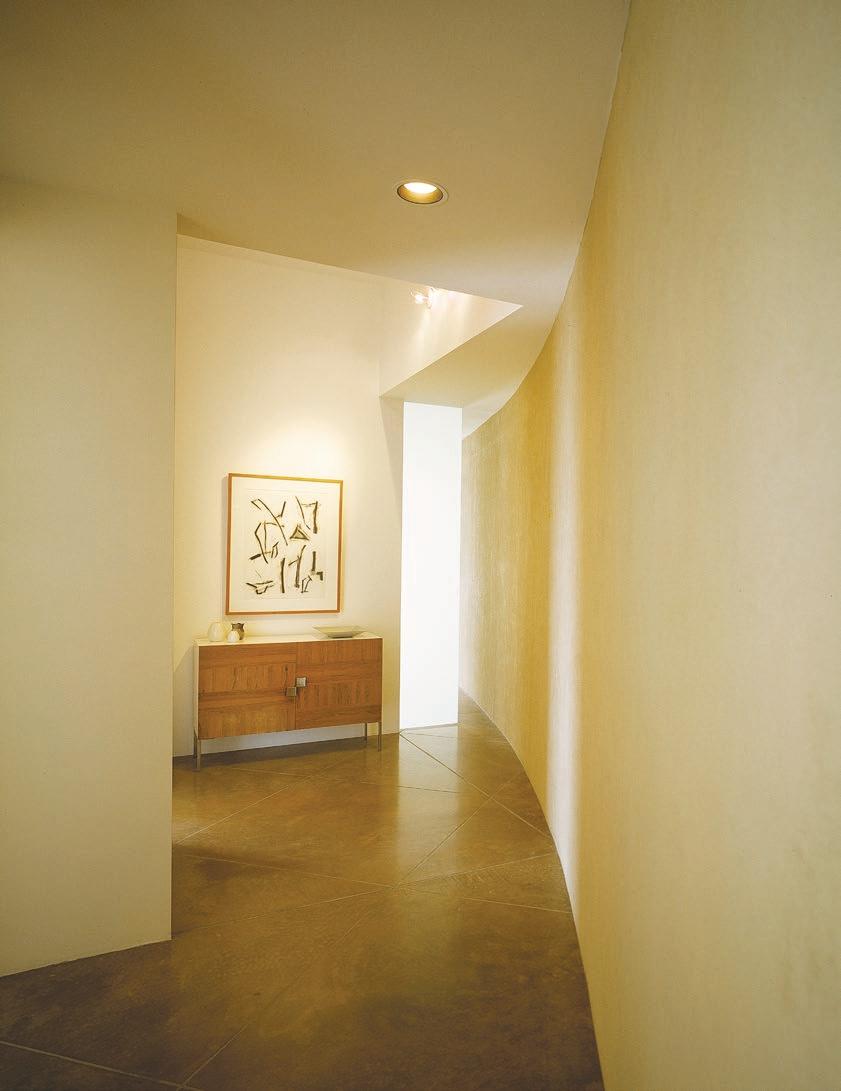

Harnar described this house as all angles and forms (above). It comprises a series of square boxes set against a 13-foot-high curving wall, creating a hidden oasis. The patios feature a koi pond and spectacular views of Santa Fe below. Harnar designed the striking wraparound corner windows of mitered glass. A frameless, laminated-glass pocket door (opposite) seems to disappear into the wall of the gently sweeping hallway. The carefully placed skylight casts a warm glow over the Richard Hogan work that hangs above a 1967 rosewood cabinet from Zurich.
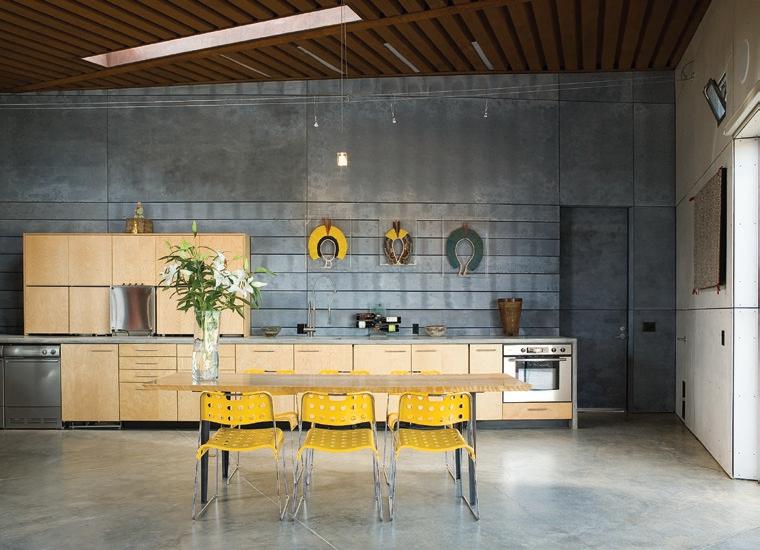
A masterpiece of e ffi ciency, this kitchen’s washer, dryer, dishwasher, and oven are tucked into the lower cabinetry, while small appliances and the stove are hidden in cabinets atop the concrete counter (above). Amazonian feathered headdresses adorn the fiber-cement wall that backs up to the tunnel leading to Harnar’s nearby residence; original 1970s chairs add a splash of color to the minimalist space. Another minimalist room features a contoured fireplace (opposite) whose sculptural design evokes trails of smoke rising from the fire below, a spot of warmth amid cool concrete walls. R


&
When homeowners remodel or build a house, their goal is to create a beautiful place to live. Coronado Paint and Decorating Center has been a trusted collaborator in the process for more than 40 years.
Now employee-owned but still enjoying the same national buying power, Coronado helps both residential and commercial customers curate the perfect paint, flooring, and countertops choices, as well as soft goods like carpets and window treatments. Their expansive showroom always features the most up-to-date and on-trend selections, as well as a nearly unlimited library of products that can be ordered from around the world. This means the materials in your home can be as unique as you are.
“Being local employee-owners also means we are focused on the long term,” says project manager Naomi
Boylan. “Everyone on the team is invested in exceptional customer service, quality products, and workmanship that will last.”
For example, when one customer wanted a modernized, sophisticated desert aesthetic for a historic adobe remodel, Coronado placed terra cotta–like tile on the bathroom feature wall to add texture reflective of our Northern New Mexico landscape. And in another bathroom in the same house, natural travertine and marble soften the contemporary design to make it inviting and comfortable.
So, whether you are working with a blank slate or a complete concept that includes looks and finishes, Coronado’s designers and installers stand ready to assist you, your builder, and your interior decorator in finding the exact materials to fit your parameters and budget.



Architect Michael Krupnick designs “movie sets” for people’s lives that keep nature close
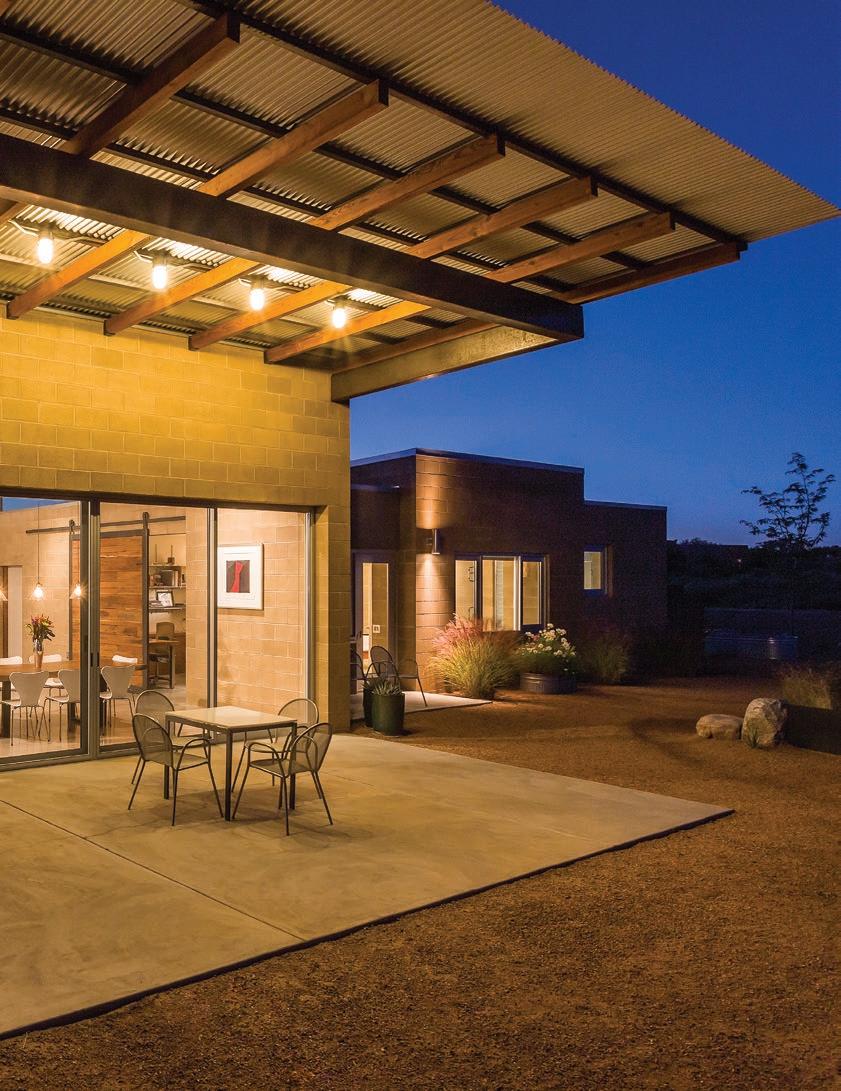
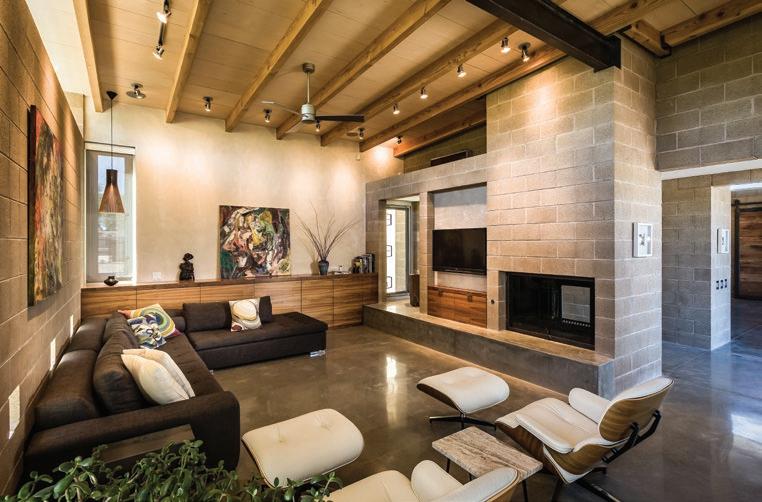
The adobe porch Michael Krupnick designed for a studio in Ojo Caliente, New Mexico, is plain, nearly featureless on its own. In the afternoon sun, though, a shadow splits its wall into two perfect triangles, one light, one dark. It’s the kind of detail that could take months to notice, but it’s key to understanding the Santa Fe architect’s approach: using minimal desert design features to quietly add some drama to the client’s life.
Krupnick’s work, at its most basic level, is a hybridization of the timeless stillness of ancient desert architecture combined with the more modern, minimal-industrial influences one might find in a city loft. But beyond that, his goal is to create a sense of place. The 49-year-old architect thinks of his homes as movie sets where the daily events of the residents’ lives play out. Composition plays a part, too; it’s not just the structure, says Krupnick, but how it enhances, and is enhanced by, the space it occupies.
“What I work on most is the ‘space between,’ how shadow and light interact with the sky and landscape,” he says. “More than the building’s structure, it’s the space between and the negative space the building creates.”
Krupnick, who started his studio with his wife, Kim Ray, in 1995, is a transplant to Santa Fe from Florida. He says he became interested in architecture as a reaction to how unfulfilling his hometown of Fort Lauderdale felt while he was growing up; the developments seemed “uncaring,” he says. He calls it “bad Modernism”—buildings and neighborhoods that spare no thought for the people who inhabit them, buildings with no sense of the space surrounding them. Krupnick wanted to compose spaces, private and public, that improved people’s lives. “I got into [architecture] because I knew I could do better,” he says.
Krupnick first attended the University of Colorado, Boulder, where one course, more about imagination than design, helped him to think of architecture less in material terms and more as a space where the events of people’s lives unfold. He came to study in New Mexico in 1990 and fell in love with the adobe buildings and
Krupnick teamed up with contractor Michael Freeman to design his Corrales, NM, home. LEED platinum certified, its cantilevered roof (previous page) affords a view of the Sandia Mountains and allows morning sun in while shading the patio during the peak of day. Above: This room is a focal point of the house, with a Trombe wall that provides radiating heat.
Opposite: The rustic barn door was crafted from reclaimed walnut that Freeman’s father had saved for years, waiting for its calling. The dining table, sustainably harvested, is certified by the Forest Stewardship Council.
Krupnick’s work, at its most basic level, is a hybridization of the timeless stillness of ancient desert architecture combined with the more modern, minimal-industrial influences one might find in a city loft
the local culture, enjoying the lack of “flash” and the openness and warmth he found in the people here. He decided to stay.
At UNM he was able to study under Modernist architect Ricardo Legorreta and also Charles Moore, whose collaborative Sea Ranch condominium project had an important impact on Los Angeles architecture. And though he didn’t study directly with Antoine Predock, Krupnick and many of his classmates were influenced by his Modernist-industrial work. “He was the local architecture hero,” Krupnick says of the Albuquerque-based Predock. “He was very Modernist-industrial, very much sense-of-place. It’s influenced my work tremendously.”
Krupnick began working as an intern renovating rural New Mexican churches with adobe made from clay collected on-site. At first New Mexico hadn’t struck him as beautiful, he recalls; the desert and its architecture demanded quiet and patience to be appreciated. But in the cracked adobe walls of those old churches, Krupnick learned a subtle style that he uses to this day.
“New Mexico churches are like no other buildings at all, ever,” he says. “It’s not about the building—it’s about the people. Check out the softness of this line,” he says, pointing to an image of a church and observing how its peaked roof sagged and bent against the evening desert sky. “There’s a humanness in putting this out there. Sometimes architecture is so perfect that it takes out the human aspect.”
It was while he was restoring the old churches that he met Kim Ray, who would become his partner in the business for 16 years before establishing herself as a nurse and yoga instructor. In the studio’s earlier days, the husband-and-wife team tackled large-scale restaurant and apartment projects through Fort Lauderdale developer Alan Hooper. Even though Ray has since branched out, she still has input in some of the
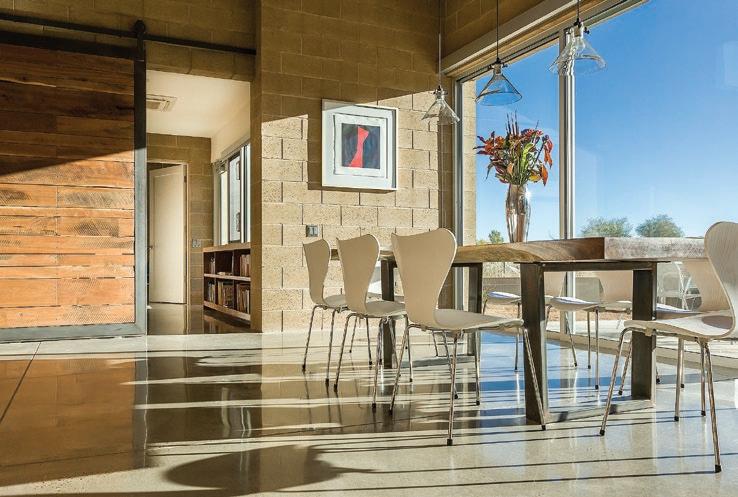

The 49-year-old architect thinks of his homes as movie sets where the daily events of the residents’ lives play out
studio’s projects. “Kim is one of the best designers I’ve ever met,” Krupnick says. “So even though she’s not a full-time part of the firm, she’s always involved.”
Krupnick always makes room for nature, an important feature of his minimal designs. When Carlos Ramirez, a bridal and wedding designer from Miami, hired him in 2013 to renovate a 1940s Santa Fe adobe home that had undergone some slapdash renovation in the 1970s, he put that sensibility to work.
The house sits on a piece of land that faces the mountains, but its original design obscured this view with a utility room and gazebo in the backyard. What followed between Krupnick and Ramirez was a renovation by means of negation. They picked out features of the old home that worked and removed those that didn’t, often choosing to leave space rather than fill it. The utility room and gazebo were among the first to go, and a wall to the east was replaced with a window—the Sangre de Cristos would now provide an unobstructed vista for Ramirez’s dining room. The vigas in the living room were retained and painted white, while the old adobe portal to the home remains, opening onto a foyer with a black limestone floor.
Ramirez says his working relationship with Krupnick was “fluid.” The new design removed the cluttered feeling of the earlier renovation, he reports, and left an open, airy home with a floor plan that flows naturally. “It has a definite feeling,” Ramirez says.
One of the studio’s earliest projects was a home for Edwina and Charles Milner in northeast Santa Fe. Edwina, who’s served



on the boards of several art organizations, wanted to build a home that would showcase her art collection, house a studio for her own work, and be a place where she could entertain guests. When the couple hired the young architect, Edwina was intrigued by rounded homes that were created by pouring concrete over inflated weather balloons. She wanted something that looked similar.
The lot sat on an incline with a view of the mountains to the east, and the home the Krupnicks and Milners designed now curves its way up that hill, with a view of the surrounding desert landscape from each of its five levels. It’s not designed in concrete or adobe, but rather a concrete-ash mix that evokes the look of old New Mexican homes, flawed but endearing. Upon seeing the pocked and bubbling material, Edwina fell in love with its pink-beige color. “It’s so pretty,” she says. “I didn’t let them paint over it at all. I just love that surface.”
The living room, with a large window that overlooks a patio and a view of the mountains, is a set piece for Edwina’s role in the fine-art world. A fireplace sits in the center, with traditional vigas radiating from the curved chimney. Her guests often gather there to listen to speakers and socialize at cocktail parties. The stairway was enhanced with additional windows, providing an unbroken connection to the outside. In Edwina’s art studio, windows open to the hillside slope at ground level. Edwina and Charles were so happy with the work that they recently invited Krupnick back to add a guest room with a private entrance and kitchen.
Another recent addition to Krupnick’s oeuvre, one that draws more heavily on his industrial roots, is a gallery in Santa Fe’s Railyard Arts District. California sculptor Bill Schindler hired him to transform what used to be an auto repair shop into a studio and a gallery space. In the back of the building, where people used to work on cars, Schindler has drills, a workbench, and boxes upon boxes of scrap metal and bent airplane propellers—everything he needs to make his art.
Opposite top: Photographer Kim Jew’s studio is an articulation of space and light in Corrales. Opposite bottom and above: Traditional adobe massing meets rusted steel and reclaimed oak detailing in artist Joyce B. Scott’s Ojo Caliente studio, which has a bermed, below-ground workshop. Left: Krupnick’s urban taste is seen in contractor Andy Joseph’s Santa Fe home.

The gallery area is tidier but doesn’t lose the industrial aesthetic. Steel supports cross the ceiling above a concrete floor nicked with thousands of imperfections. But it’s the 22-foot, triangular steel tower and its canopy at the gallery’s entrance that is most striking. The tower links the gallery to similarly styled buildings near the train station. “It’s a nice sculptural entry,” Schindler says. “Being a sculptor, that’s important to me.”
The majority of the studio’s large-scale development work is in Florida, where Krupnick is also licensed. Ray was there to design some of the earliest entries, and many of these projects utilize the couple’s more minimal, modern influences. They worked together on the Mill Lofts, Foundry Lofts, and Himmarshee Bar & Grille in Fort Lauderdale, often in partnership with developer Alan Hooper. He and Krupnick were childhood friends from Fort Lauderdale, where they used to play baseball and ride bicycles around the neighborhood.
They ran into each other again in 1996 after Krupnick spotted Hooper working on a house on the street where he grew up. They began a conversation that turned into a 19-year working relationship spanning many projects and millions of dollars in development. Hooper says that Krupnick considers everything, from the building’s relationship to the sun to what things will look like at night and how the area will feel for pedestrians.
“We make buildings that look like they’ve been there forever,” Hooper comments. “We’re not as vanilla as most developers. Most developments are the delivery of a box for some sort of user based on square footage, but we go for the cool factor.”
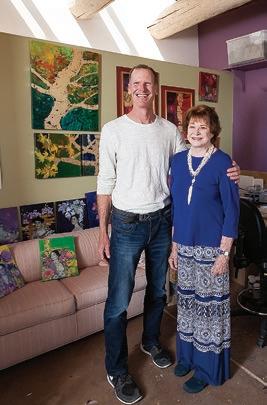
The duo are entering the second phase of a project in College Town, a residential area near Florida State University in Tallahassee with access to food and entertainment within walking distance of Doak Campbell Stadium. The “cool factor” here includes multiple areas for restaurants and bars, wide brick sidewalks that are inviting to foot traffic, outdoor concert venues with canopies supported by steel struts, and a rooftop pool with a view of the stadium.
College Town may seem stylistically removed from the meditative desert homes Krupnick builds in New Mexico, but his architecture-as-movie-set approach is the same. Venues and restaurants along the streets are separated from the sidewalk by railings, but not quite. There’s permeability in this design that can be seen in many of the architect’s projects. When Krupnick was adding these dividing rails to College Town, he was imagining a scenario in which a resident walking on a Friday night recognizes friends at one of the restaurants and decides to exit the sidewalk to join them. It seems natural and unplanned, but Krupnick designed it to feel that way.
His technical drawings of College Town are peppered with similar scripted incidents. For efficiency’s sake, Krupnick often designs on his computer, but he says he reaches a different space artistically when he’s drawing by hand and listening to music. Scattered among hand-drawn plans are little notes he’s left himself, like “sitting on the steps waiting for a friend,” and “cool little pub.” The latter refers to part of the development that doesn’t have much visibility. Krupnick says he imagines someone turning this corner and stumbling across an almost-hidden bar.
It’s this harmony between public and private life, between a structure and the person that inhabits it, that intrigues Krupnick. It’s one of the reasons he wanted to be an architect in the first place.
“It’s not the love of buildings, it’s the love of community building, of public spaces, composition, and drawing,” he says. “Houses are little compositions creating more of a village feel with walkways and pathways. I sometimes like the space between the buildings more than I like the buildings.” R
From the Summer 2015 isssue
Opposite: Edwina and Charles Milner were Krupnick’s first clients.
Contractor Toby Anderson helped bring the sculptural, organic architecture to life in the home designed as a showcase for the couple to display and talk about their art. Below: Along with Alan Hooper and Brad Innes, the Southern vernacular industrial style of College Town in Florida is transforming the area into an arts and entertainment district.

BY STEPHANIE PEARSON | PHOTOS BY CHAS M c GRATH

Classic New Mexico architecture meets the latest in sustainable technology in architect Michael F. Bauer’s high-desert passive-solar villa

“So far this is the most sustainable house that’s been realized in construction in my career,” says Bauer, who has been practicing architecture in Santa Fe since 1971
I“n a few hundred years it’ll just melt back into the earth,” Michael F. Bauer says of his latest realized vision. The Santa Fe architect and I are driving south toward the Ortiz Mountains down a dirt road in the Commonweal Conservancy, a new conservation-based community development near Lamy, New Mexico. We’re scanning the big horizon for a 3,724-square-foot home rooted in the classic architecture of Northern New Mexico and infused with state-of-the art sustainable upgrades and the whimsical, eclectic tastes of owners Dinah and Jarratt Applewhite.
But there’s a problem: The house, with its twofoot-thick exposed rammed-earth walls, blends
into the landscape so well that we can’t find it. Bauer throws his Audi in reverse and we speed back down the empty road until we eventually spot the sharp outline of the Applewhites’ butterfly roof and make a beeline toward it.
From the driveway, the house’s scalloped walls look like earthen waves that float just a few feet above the cholla cactus. We enter the courtyard through a massive, eight-foot-tall gabion-and-steel-framed gate filled with black volcanic rock that was hauled over from the Caja del Rio plateau, into a serene Islamic garden. Three Yucca rostrata grow in a concrete trough alongside a 37-foot reflecting pool and fountain made of poured-in-place concrete.
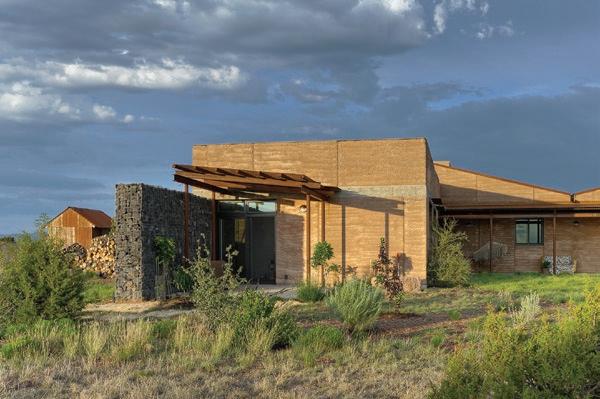

Nearby, a stone sculpture by the late Case Cohn leans precariously off kilter, and seven rusting porch chairs that Jarratt bought on eBay sit under the rusting corrugated tin portal, adding a touch of parched-desert-West-meets-Appalachia.
Surprises abound at the Applewhite house. The enclosed courtyard and 1,640 square feet of portal—the only link between the house’s main living spaces— may faintly resemble classic Northern New Mexico architecture, such as the 1804 Martinez Hacienda in Taos, but beyond those two elements, Bauer and the Applewhites didn’t hem themselves in with tradition.
“Our mantra was ‘Outside in,’ says Dinah. The former interior designer and her husband, an entrepreneur and fineart photographer, gave Bauer free rein to
design the house’s shell, which he did in 2005. Bauer, in turn, stepped back to give the Applewhites space to design the interior.
“We wanted to take advantage of the wonderful views and give the feeling of being in nature,” Dinah says as she opens a sliding door that leads from the courtyard into the main living area, which immediately gives way to an uninterrupted panorama from Glorieta Mesa to the Sandias.
“One of the things we loved most about the lot were the many wild animals that wandered by: pronghorns, coyotes, tarantulas, bull snakes, prairie rattlers, and dozens of bird species.”
The Applewhites also wanted to construct a cost-efficient house that made almost zero impact on its surroundings. At least 30 percent of the building mate-
rials, such as the exposed steel I beams, was salvaged from Denver, reducing costs by more than 60 percent. The cost per square foot was $150.
“So far this is the most sustainable house that’s been realized in construction in my career,” says Bauer, who has been practicing in Santa Fe since 1971.
With 24 solar panels out back that power a 10-kilowatt photovoltaic system, the Applewhites not only furnish all of their own electricity; they get monthly $75 refund checks from PNM. For drinking water they use a community well, but also have a catchment system that stores all of the rain and snowmelt from the sloping roof in a 6,600-gallon cistern, and a black-water treatment system that treats all of the household effluent for a drip irrigation system.
“We wanted to take advantage of the wonderful views and give the feeling of being in nature,” Dinah says as she opens a sliding door from the courtyard, revealing an uninterrupted panorama




For further efficiency the Applewhites turned their backs on the northern views of the Sangre de Cristos, installing almost all south-facing windows instead and adding a few windows at the peak of the butterfly roof to increase light and capture more passive-solar energy.
The Applewhite house passes the eco test. But what makes it stand out among all the other sustainable homes in Santa Fe is Dinah and Jarratt’s ability to turn just about any found item into a practical piece of art.
To wit: The wood-burning fireplace that separates the living room from the dining area is a prefab unit retooled by artist Larry Swann. Working from the Applewhites’ design, he used patchwork perforated steel plate rescued from an old Purina factory and turned the fireplace into a cubist cen-
terpiece. Set into the concrete floor next to it is a medium-size lava boulder, a nod to Mexican architect Luis Barragán.
The kitchen is an amalgam of Ikea and found items: The Applewhites bought their Sub-Zero refrigerator from a repairman who had rescued it from a woman who complained that the door squeaked. And they topped their cherry red Ikea cupboards with zinc counters.
“We thought zinc sounded romantic because they use it in bars in Paris,” says Dinah.
In what she likes to call her “kinky black bathroom,” Dinah lined the walls with black Pirelli rubber flooring and left the concrete floor bare. “I love Pirelli flooring, but hate it when it gets dirty!” she explains.
Between the Applewhites’ whimsical sense of humor and their use of bold Mexican colors—canary yellow in the library, deep mustard in the guest wing, and sky blue near the master wing—there’s a lot to look at. But eventually the eye always wanders back outside. It has to: To reach the laundry room, the master wing, Dinah’s office, or the two guest bedrooms from the main living area, you have to go al fresco.
“We did not want halls,” says Dinah. “It’s such a miracle to have birds and coyotes trotting by that we wanted the comfort of being inside, but to really be out in nature.” R
From the Spring/Summer 2010 issue

Michael Wright’s art/design firm in Santa Fe helps homeowners develop aesthetic and spatial designs that will transform their living spaces. We draw from a wide variety of styles and techniques to customize the look according to the clients’ needs and tastes. Visit our art studio in Madrid to watch as Wright fabricates sculpture, art, and metal design components.
from

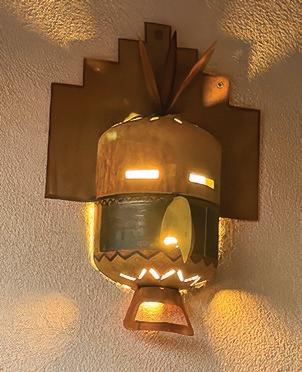


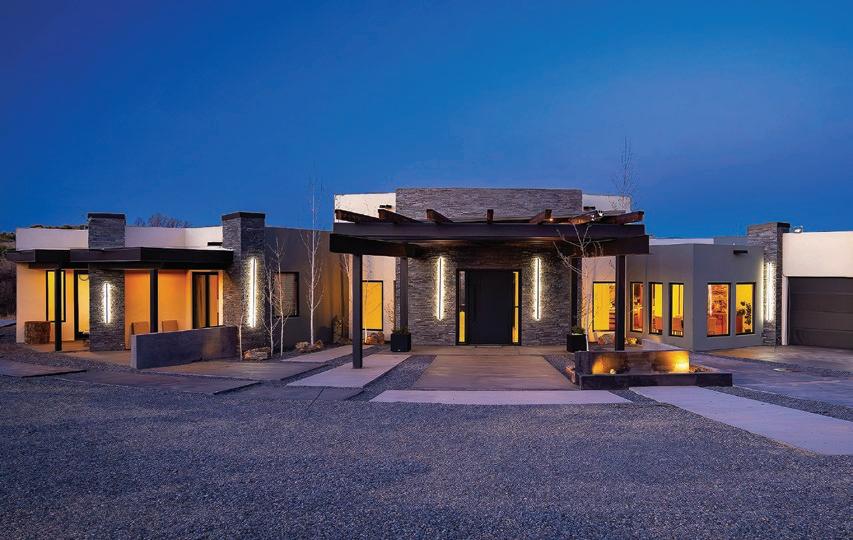



Bring together a trio of architecture, design/build, and construction professionals with decades of experience and what do you get? The Collaboration, a partnership among Lisa D. Martinez Design LLC + B Constructiv LLC Design, Louis Martinez of Martinez Design Group, and Louis’s son Daniel J. Martinez of Five-Ten Architecture + Design. And while Lisa is not related to Louis and Daniel, the three have achieved a synergistic connection that results in extraordinary structures for their clients in styles ranging from traditional northern New Mexican and Santa Fe Pueblo to more contemporary designs.





Projects:
Design:
Alameda
Lisa

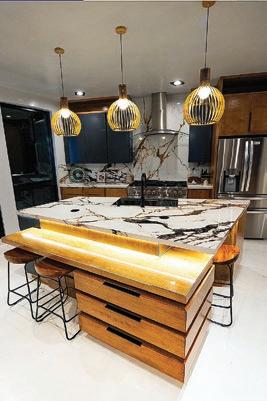
Between our companies, clients get a great team that puts together all the pieces of a commercial or residential project,” Lisa says. “I can start with land-use consulting, development, and site planning, then bring in Louis and Daniel for architecture, design, and construction. I also design and manage construction.”
The Collaboration has earned accolades for its projects, too. In 2022 Lisa won the Santa Fe Area Home Builder’s Parade of Homes Best Design award for a boutique fitness facility. The group’s 2023 commercial project, State Employees Credit Union Mortgage and Commercial Center, won the National Association for Industrial and Office Parks’ New Mexico Commercial Real Estate Development Eagle Award. Daniel and Louis co-designed the structure; Lisa acted as co-designer and construction manager.
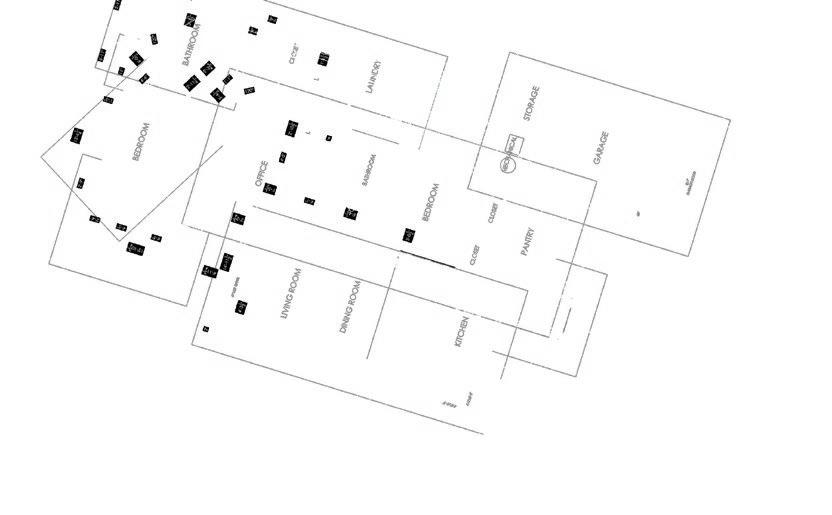


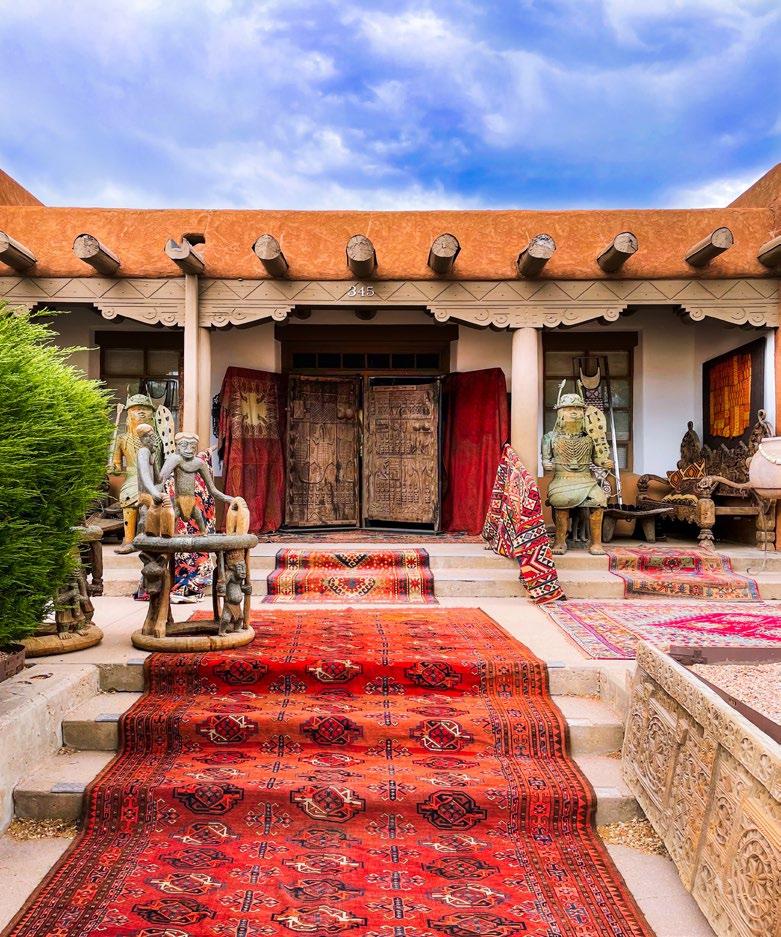










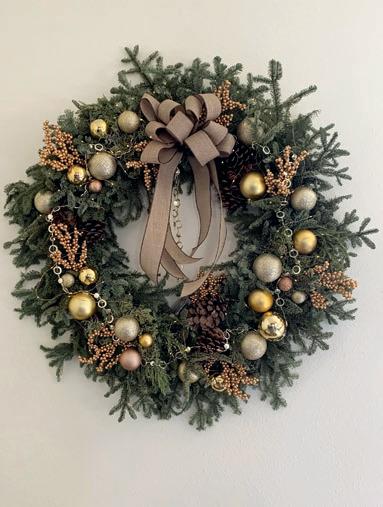























Elizabeth’s mind was too full for conversation, but she saw and admired every remarkable spot and point of view. They gradually ascended for half a mile, and then found themselves at the top of a considerable eminence, where the wood ceased, and the eye was instantly caught by Pemberley House…. Its banks were neither formal, nor falsely adorned. Elizabeth was delighted. She had never seen a place for which nature had done more, or where natural beauty had been so little counteracted by an awkward taste. They were all of them warm in their admiration; and at that moment she felt that to be mistress of Pemberley might be something!
Jane Austen, Pride and Prejudice


Gardens are not just a stop to smell roses for award-winning landscape architect Edith Katz.
Picture Katz, 5'4'' tall, with black hair and olive skin, posed in one of the Santa Fe gardens she designed, wearing a lemon-yellow silk shantung coat by Calvin Klein. It was the outfit that a stylist for House & chose for her to wear in a portrait in a 2006 issue as one of 50 U.S. designers to watch. And while, in the picture, the coat Katz is wearing closely matches the Oklahoma redbud she is standing beside, the designer is also wearing a slightly amused expression.
For, while many people might read the coat as culture and the tree as nature, Katz doesn’t see the distinctions as being so polarized. On the contrary, she envisions a good part of her work—when she goes to client meetings, laptop and a history of landscape architecture theory honed at the Harvard Graduate School of Design close at hand—to be the necessity of educating clients as to what landscape in its full scope (ranging from a picturesque view in Pride and Prejudice to a mining site reclaimed as if from a scene in Blade Runner) really implies.
“Landscape,” Katz says, “includes all the activities of man that affect what we call the landscape. A subdivision is a landscape. An industrial park, a highway, are landscapes. I put the word up there on a screen when I present to clients, so they get away from always thinking landscape only means pretty scenery or a perennial garden.”
Katz mines for her designs influences as diverse as Lawrence Halprin, Roberto Burle Marx in 20th-century Rio, ancient Japan, the “theme park” architecture of today’s Las Vegas, and Santa Fe’s
own vaunted histories. As for Santa Fe, the fact that those of us who pitch stakes on the prairie do so in part to grab distant views impels a landscape designer to think about what is being framed in the distance and what is being sited in the near-ground of the “garden”—in short, to think edges.
Such questions as whether new landscapes “fuse into” or separate from the prairie are ones Katz tosses around in conversation, while foaming milk for cappuccino. She says that her work has changed appreciably in recent years—in part because shifts in the profession now put her, as the landscape architect, closer to organizing plantings in concert with drainage issues that were once the province of civil engineers. Along the same lines, her work now has different obligations here because, in response to the drought, Santa Fe County changed building requirements, so that new buildings must provide systems that make storm runoff available for gardens.
That is a very good thing, she asserts, while acknowledging that “sustainability” is one issue among many that drive her gardens
She urges, “So many people—architects and nonprofessionals— refer to ‘landscaping’ when they mean planting. Plants are one layer of a landscape, but some landscapes have no plants at all. There is no chance for ‘sustainable landscape’ to go forward as a concept in the popular imagination until this decoupling occurs.”
No plants?
“It would be a considerable educational coup if you could present, through Trend magazine, the radical concept that landscape is not only plants.”
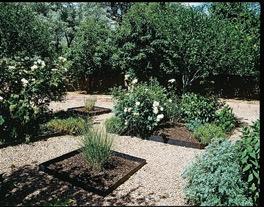

In designing an all-white, walled garden on the east side, Katz used the dimensions of the house’s John Gaw Meem portal to throw out on the ground plane a grid of planting beds that contain a palette of white- and buff-colored plants. White climber roses, white candytuft, and white butterfly bushes impart a romantic note to the garden, which is irrigated in part by water captured off the roof.

The days are all alike; the summer is long and immobile. In the late afternoon immense black clouds boil up to the zenith, and then some small portion of the hot and thirsty landscape is suddenly blessed with a brief, violent downpour which makes every rock, every patch of earth glisten. The storm comes to an abrupt end like a duty routinely performed, and is followed by not one but two perfect rainbows. It is as if some rite had been reenacted, some myth made visible for the millionth time, antiphony to a ceremonial dance in a nearby Indian village. Which comes first: the blessing or the prayer? It is not easy in this landscape to separate the role of man from the role of nature.
—John Brinckerhoff Jackson Looking at
New Mexico (1983)

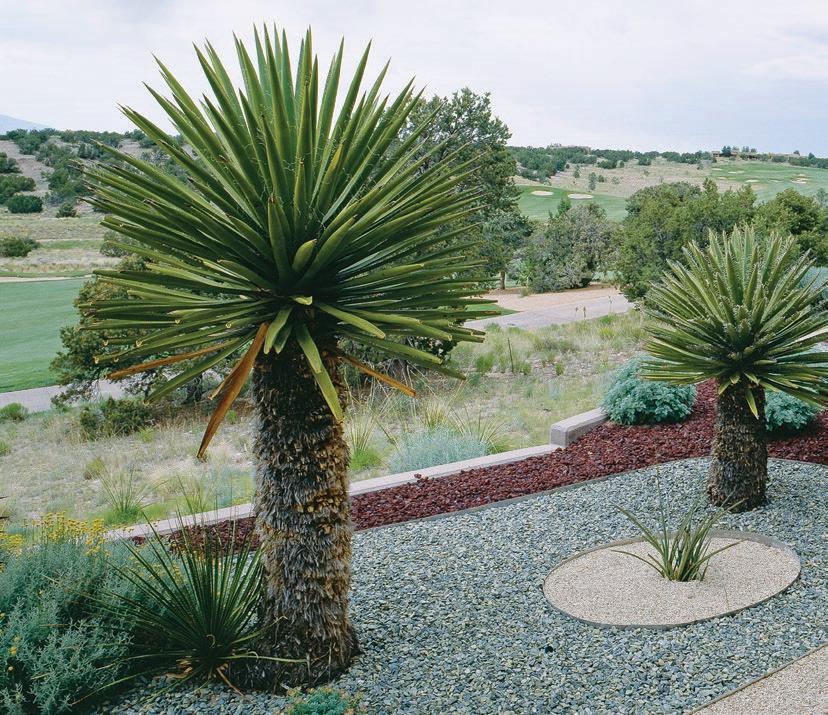
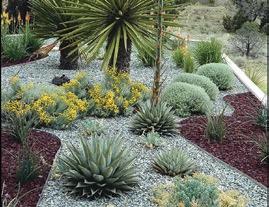
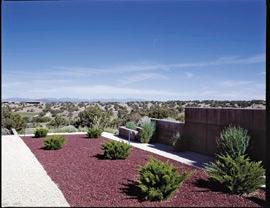
A 1950s sewing-pattern book helped Katz devise the shapes of planting beds in a xeric garden that adjoins the Las Campanas golf course. Using “borrowed scenery” as a design concept, she looked to the kidney-shaped tees and sand traps of the golf course to play up the relationship of compound curves and strong edges in her garden design. Gravel, a vernacular material used commonly across New Mexico, makes a strong color contrast of red and white in the garden.


In New Mexico one can often see a long distance. Many of us live in places that contain not only small, private backyards but also big, stunning views of sunsets and ranges.
Katz calls this point of the view a “context,” and, in her practice, it follows on the first image—“landscape”—that she flashes would-be clients on her iBook. “We live in this vast natural world here, so you’re always having to come up against the vastness of the prairie and the West,” she says.
Writer John Brinckerhoff Jackson, who lived in La Cienega, wrote in his seminal essay Looking at New Mexico that the landscape here “tells us that there is another way of measuring time, and that the present is, in fact, an enormous interval in which even the newest of manmade structures are contemporary with the primeval.”
For Katz, this parallel between old and new is a compelling thought. It relates to a tool of her professional life that she says can be choreographed into approaches to a huge variation of conditions, and that is called borrowed landscape, or borrowed scenery. It’s an idea borrowed from Japanese gardens: the one, she notes, that makes them appear so wedded to their sites that it is as if the gardens have existed eternally. An approach to what can be seen both in the garden and beyond it, borrowed landscape is a formal issue. An element of theory that Katz acknowledges she loves to work with, it essentially asks a designer to grab and miniaturize a faraway view into a near-ground design element. “In Japanese gardens,” explains Katz, “a bonsai stands for the entire pine forest; a shape will miniaturize the profile of a mountain.”
For the Las Campanas residence, the garden touches cheek by jowl with the emerald-green fantasy landscape that is the development’s golf course—hence, in the garden she designed, she makes a conscious nod to the work of Brazilian landscape architect Roberto Burle Marx, flaunting the ground plane as outrageously as Emilio Pucci did with one of his 1960s fashion prints.
In fact, for that garden, Katz used 1950s sewing patterns to devise the kidney-shaped planting beds, after looking to the golf course—with its loopy shapes of sand traps and greens—to generate designs for the ground plane that would inscribe an obvious relationship with the course.
But the links’ inspiration stopped there. The garden has sustainable characteristics that contrast with the lush grass of the course, including an amalgam of xeric plants and the vernacular material of gravel, which Katz notes has been for centuries in New Mexico an everyday response to climate. Roof water runs off into percolation chambers that lets the water return to the aquifer. Such measures, says Katz, “have been a benefit of the realities of the drought.”
This garden commemorates the curandera as healer. It actively engages memory while it confirms the present and projects into the future. This garden invites participation and modification by local people according to their own cultural traditions, practices, memories, and needs. It explores the role of landscape to evoke ancestral memory and to affirm cultural identity.
Edith Katz and Ada Medina (1997)




In that both garden and landscape embed memory and desire, they possess a strong relationship to the feminine that Katz has emphasized through her career in a series of conceptual, even “theoretical,” garden designs. One such project was the unbuilt Curandera’s Garden: Sur y , for which she and Santa Fe artist Ada Medina won a Visionary Landscapes award in 1997 from Landscape Architecture magazine.
Curandera’s Garden was designed to frame the role of curanderismo, a folk healing practice in the North American Southwest and Mexico, as an integral cultural practice that could make for a meaningful public garden. Katz and Medina envisioned using collage to invite a relationship in the garden between past and present, and to let visitors alter the garden, over time and through their participation, to present-day needs.
“We conceived the garden as a response to the mixture of cultures of certain cities in the U.S. that have Latin, Hispanic, and Anglo populations,” notes Katz, “and as a way of positioning the garden as a resistance to the homogeneously built world of global capital.”
If it all begins to sound political, it certainly is, she avers, returning—as is her wont—to a theory lesson that manages to cross international borders and then cycles back to Santa Fe: “Theory is a way of thinking about what you don’t normally think about. It buys you distance from your activity so you can recognize whether you want actually to be doing what you are doing inadvertently.”
Gardens can create consciousness, but often, like much of architecture, gardens are designed to meet unconscious wishes that aren’t really considered, Katz says, relating this point to Santa Fe style.
“For example, if you told people in Santa Fe that they were involved in a massive simulation [of the past],” she says, “they might be shocked. Yet all the buildings that

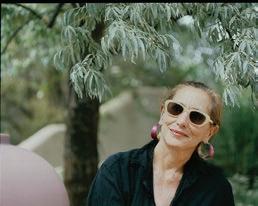
The Curandera’s Garden: Sur Y Norte concept involved designing a theoretical garden whose components could be replicated in various cities of the North American Southwest. Based on curanderismo, a folk healing ritual, the Curandera’s Garden concept employs cast-aluminum milagros and large nichos that garden visitors can rearrange and change, thus making the garden responsive to contemporary needs. The promise that city dwellers might participate actively in the life of this urban garden makes it both a contemporary representation of the way folk knowledge traveled through the Southwest historically, along trade routes, and a reflection of the vibrancy of folk traditions in the present.
try to imitate adobe—or styles that might have existed for good reason at the beginning of the 20th century—now are created over and over again without much questioning as to their validity today.”
Curandera’s Garden deals with this very issue, says Katz, in that it attempts to impose quite consciously a condition of localism—medicinal plants, cast milagros onto a place that would be referencing history while permitting new interpretations of it by the public.
“Monumental milagro-like forms of hollow-cast aluminum sculptures are central to the garden’s southern portion,” reads Katz and Medina’s proposal. “Exaggerated hearts, lungs, eyes, and ears are embedded in the ground plane. The milagro, a cross-cultural votive offering, testifies to faith and potentialities. They rest adjacent to an ensemble of shrine-nichos, constructed from an amalgamation of influences. The curandera ’s most commonly used pharmacopeia—lavender, chamomile, milkweed— grow in the nichos’ urns.”
Visitors, the proposal emphasizes, are invited to “pull up one of the many vibrantly colored domestic wooden chairs to sit by a shrine. Rows of nichos themselves may be altered by the local populace according to their needs and identities.”
The garden furthermore was conceived as being a kind of contemporary trade route, the way that curanderismo had traveled in the past. If, say, one were built in Santa Fe and another in San Antonio and a third in Los Angeles, each garden could be a response to “infill”—meaning reclaiming existing or blighted city area for a garden— and the result of the sequence of gardens in the Southwest and West would be a kind of dialogue in the present about cross-culturalism and individualism.
“Wouldn’t it be great if it could get built now?” Katz asks, emphasizing that our times demand even greater consciousness of history and the healing strategies of the feminine made visible. R
From the Summer 2007 issue
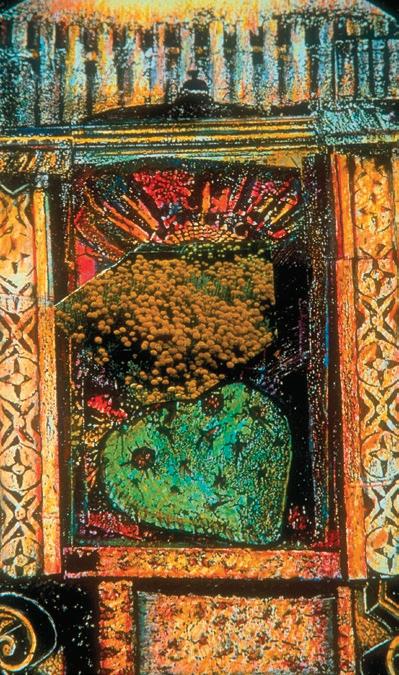
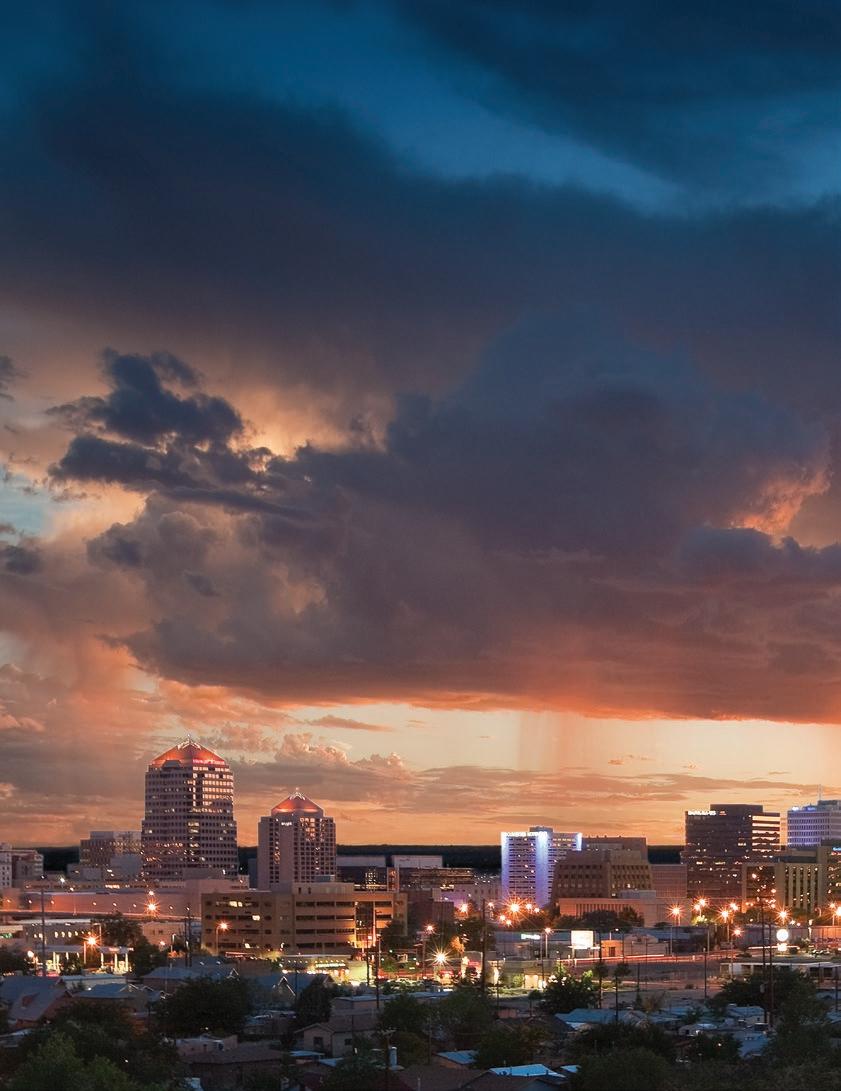


PHOTO BY ROBERT RECK
Abird’s-eye view of Albuquerque reveals a city that is quintessentially Sunbelt. It sprawls rather than rises, its confines pushing against the desert at three of its edges, halted at its fourth by a 10,000-foot mountain. Its growth is less a battle between Mother Nature and human will than a carefully choreographed duet— there is no Albuquerque without its wild places or its concrete and steel. Above looms a sky so vast that it dwarfs even the tallest of buildings. Below courses a bosque -lined river, whose banks founding families still farm, managing the life-giving water through an age-old system of communal irrigation. Two interstates, arteries transporting the lifeblood of the state, also snake their way through the city, meeting at a juncture famous enough to have earned it a nickname, “the Big I.” The largest city in New Mexico, Albuquerque boasts a history both ancient and Atomic Age, balancing cultural preservation with progressive revitalization. Industry, commerce, art, and culture thrive, from the shops of historic Old Town to the highrises of downtown, the boutique businesses that line Central Avenue to the entrepreneurial start-ups of midtown. Here, the photos of renowned photographer and Albuquerque resident Robert Reck present a city that embodies the spirit of the modern American West—respectful of the past, mindful of the present, and ever-optimistic about the future. R
From the Spring/Summer 2014 issue

BY RENA DISTASIO
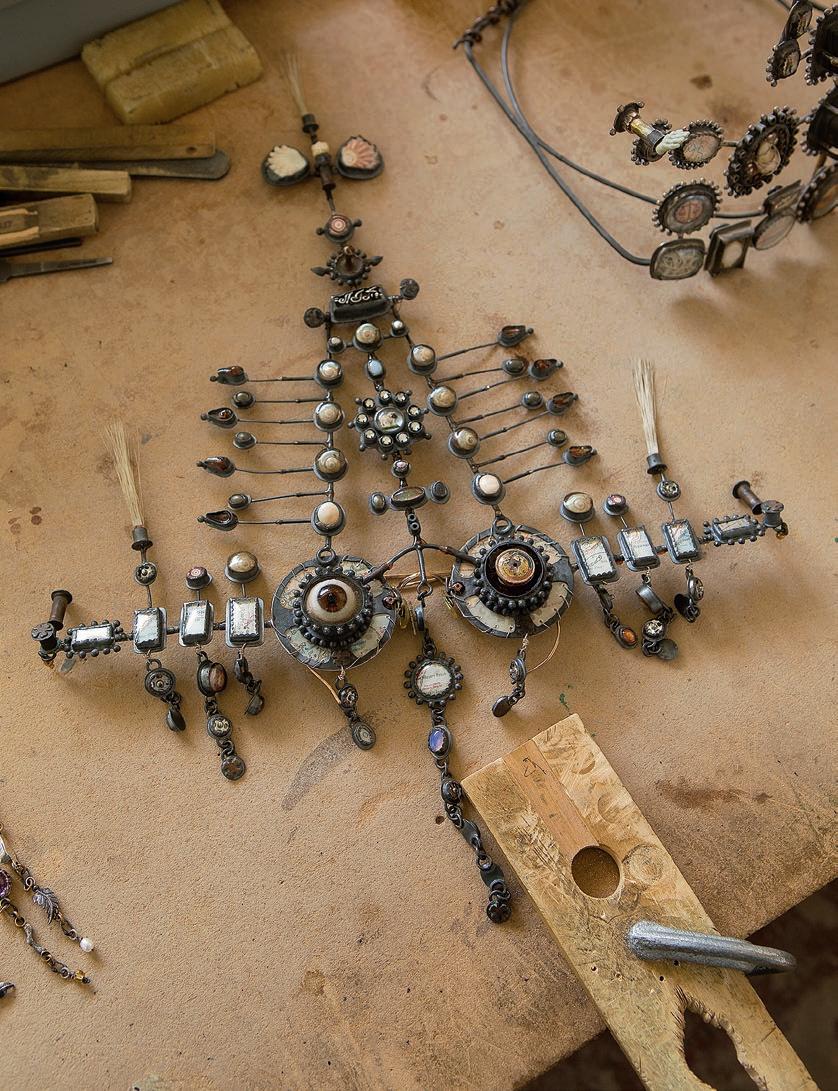
Jewelry maker Kristin Diener runs a finger down a length of chain on one of her necklaces and stops at about the one-and-a-half-inch mark. The handsoldered sterling silver links are tiny, an eighth- to a quarter-inch long. “This section took me eight hours,” she says, “And that was working full steam.”
The piece, Blue Sky: Cascade (2013), is nearly 20 inches long and striking in its intricacy: link after link supporting a sterling silver plate shaped like half a sunburst and adorned with semiprecious stones, off of which more chains— what Diener calls “danglies”—are attached, themselves linking additional stones and tiny bits of found objects. Looking at this and the other finished and unfinished pieces housed in her Northeast Albuquerque studio, one gets an immediate sense of the transformative quality of both her process and the resulting works; the obsessive nature of their construction becomes an act of devotion, turning jewelry into sculpture, adornment into armor.
Born in the Midwest and raised in New York, Georgia, and Alabama, Diener received her MFA in jewelry making and metalsmithing from Bowling Green State University in 1986. She had been studying ceramics and drawing before learning of a jewelry class taught just once every two years. “As a kid I had always loved the ancient historical jewelry I had seen in books or museums, so I took the class and thought, ‘This is it,’ ” she says.
Since her instructor was more into casting than fabricating, Diener worked for several years in clay, producing organic, botanical-themed shapes. It was toward the end of her seven years in Boston that she began to experiment with soldering. A move to New Mexico in 1996 finally forced her hand. “I couldn’t cast anymore because I didn’t have the equipment, so I began fabricating.” And, she says, she rediscovered the beauty of turquoise and just how “yummy” sterling silver could be.


Which is not to say her work in any way mimics the turquoise and silver work of Native American jewelers. She starts with a theme or an idea, not a form or a function. An avid traveler, especially throughout the American South, her work has always been about navigation—the journey, not the destination—and, most recently, how we are guided by water and the stars. Which is perhaps why much of her work is built around the shape of the cross. “I learned when reading about archetypal imagery that the cross is energizing,” she says. “It represents a crossroads.”
A lover of all forms of ancient armor and ceremonial jewelry, Diener’s work also references the pageantry and talismanic qualities inherent in certain forms of body decoration. “When I see beautiful ancient jewelry and metalwork and armor and chatelaines and samurai swords and Peruvian nose rings and kingfisher feather crowns and crowns encrusted with jewels . . . I do know that [they are] related to rank, beauty, and gender,” she says. “That fascinates me, often dismays me, and informs my studies.”
She is similarly drawn to the power of found objects, both from her own life and travels and those of others, which she always incorporates into her work. Navajo tears (rounded obsidian pebbles) collected on her hikes, bits of colored foil, animal hair and bones, the nose piece from a long-discarded pair of eyeglasses, antique buttons—they all become elements of the overall story she tells.
“I am not thinking about gender,” she continues. “I am thinking about the human body and spirit . . . about going someplace fantastical.’” R
From the Summer 2017 issue

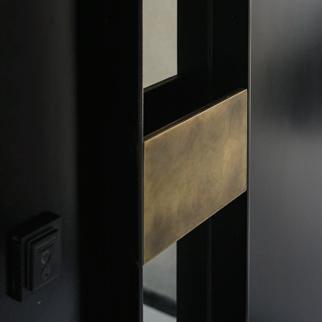
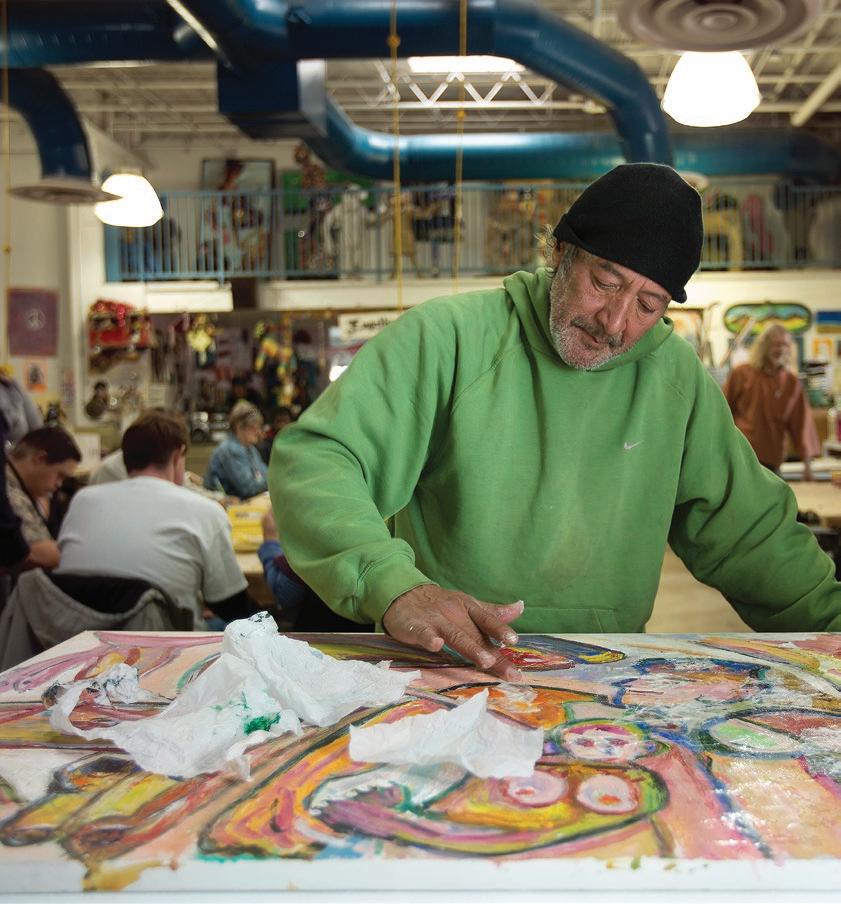

A unique Albuquerque initiative addresses homelessness through pencils, paint, and purpose
For 27 years, Jimmy Lujan was an active member of the community, running his funeral home in Taos and playing guitar in a rock band on weekends. But when a close family member was murdered in 2006, life as he knew it ended. Lujan began to experience mania, depression, nightmares. He couldn’t focus enough to hold a job and was involved in a series of car wrecks. Eventually he lost his apartment—then everything else.
Lujan fell into using alcohol and even crack and heroin. After ending up on the streets of Albuquerque, he slept behind Dumpsters and desperately tried to numb the pain of his trauma—now compounded by being homeless in a part of the city known for being as rough as it is hot. One afternoon as he sat waiting for a bus at 1st and Mountain, a friend came by and invited him into a place she thought might engage him: ArtStreet, a massive studio where anyone could come in off the streets and work with a diverse range of art-making supplies and materials. Lujan was immediately intrigued. “Here was this great place to be creative and get out of the heat,” he says. “And it was free .”
ArtStreet was created in 1994 after a Leadership Albuquerque economic development committee conducted a series of brainstorming sessions that included people experiencing homelessness, Albuquerque Healthcare for the Homeless (AHCH), community advocates, and dedicated art therapists. The studio has since served as a gateway for people in crisis, providing a welcome escape from the intense isolation and danger of life on the streets, in a large-family ambiance. “The homeless are shunned in many other places,” Lujan says. “It’s the complete opposite at ArtStreet. It’s a loving, safe place to be.”
The program asks just two things of its clients: show up sober and participate in making art, in the medium of your choice. You don’t have to have art skills, aptitude, or even be experiencing homelessness (though 85 percent are or have been). In addition to providing the open studio, ArtStreet holds several closed art
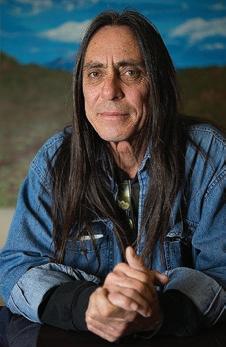
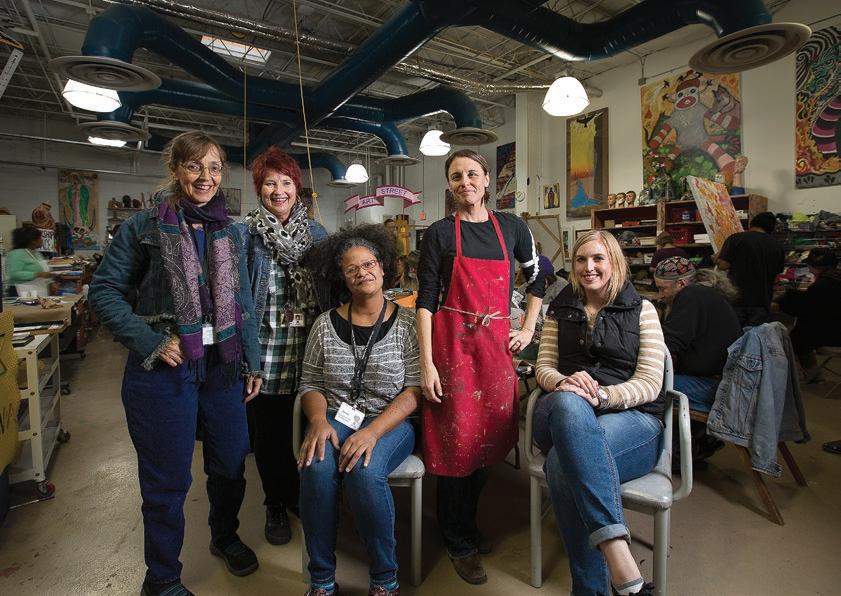
therapy groups for people in recovery of all kinds, stages client art shows for the general public, and helps its artists sell their work at farmer’s markets and recycled art shows throughout Albuquerque and Santa Fe.
Its 2,680-square-foot space with 20-foot-high ceilings holds a web of loosely connected substations for painting and sketching, a wheel and kiln for making pots, a sewing area with fiber art materials, wood- and metalworking tables, a shelf of donated recycled materials for mixed-media artists, art books and magazines for inspiration, and paper and pen for those of a more literary bent. In deference to Albuquerque’s 7,000 unhoused children, there’s a separate area where kids and families can
create. At any given time, 35 to 40 artists are working away at their individual projects, self-directed, though with the potential support of five staff members.
One such staffer is program coordinator Mindy Grossberg, a Chicago-area native and 13-year ArtStreet veteran whose dedication to building close relationships and trust with and among her clientele is palpable. “You might have someone come in who’s in the middle of a crisis, and so we would sit down with them and recommend art that would be good to help work through that process—such as pounding some clay. Some people come in and really settle down when they do their precise penand-ink drawings. This is their sense of ‘I have control of this,’ because these
people don’t have a lot of control over their environments.”
The clients she sees come from varied backgrounds—some attended art school, while others haven’t seen a paint box since childhood. The 1,500 or so individuals who enter the studio each year range from the very young to the very old, evenly split between male and female, as diverse in their ethnic and cultural backgrounds as Albuquerque itself. “A lot can happen when people sit next to each other, making art,” Grossberg notes. “We don’t necessarily define each other—you’re homeless, or you’re this or that. We’re all artists making art, and we discover our similarities, not differences.”
So what do the ArtStreet clients make? Much of the work isn’t necessarily

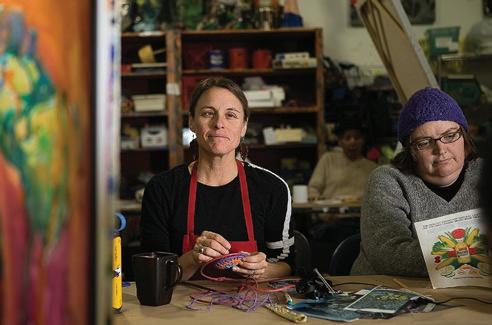
Grossberg and her staff enjoy creating art alongside the clients. “We get to be fellow artists and experience the trials and tribulations that are art-making,” she says. “I think that helps new individuals who come in . . . and really helps people see that we don’t define art in a very specific way.”
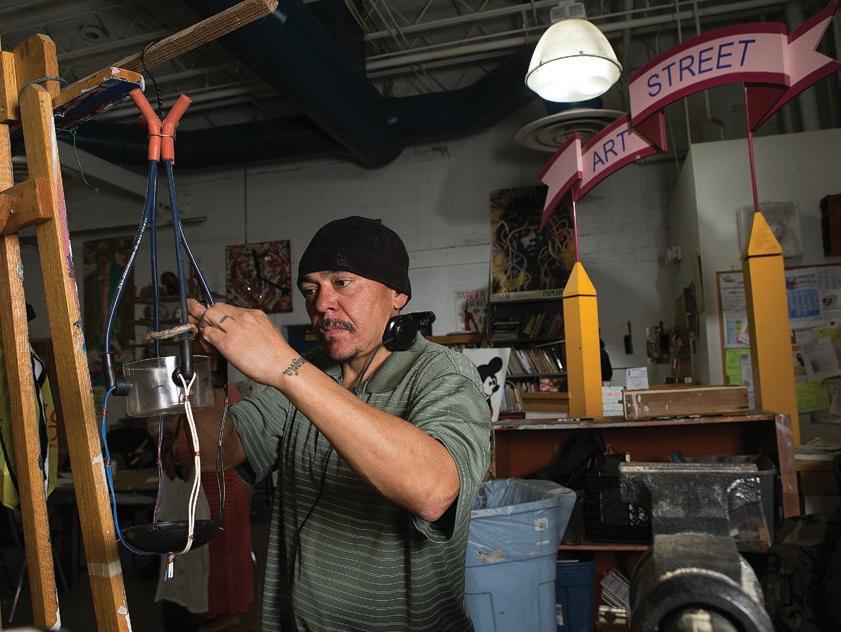
conceptual or didactic in its aims but instead veers toward universal themes. Artists will frequently use objects found on the streets and sometimes create collages, which has led to their work being exhibited at recycled art shows in Albuquerque and Santa Fe. “They’ll do things around addiction or mental illness, things that show they’re passing through dark into light or light into dark, maybe religious themes . . . There’s a rawness to the art,” Grossberg says.
discovered that some artists were selling their pieces at markets and shows—and keeping 100 percent of the proceeds. That got him thinking: selling his art could put a roof over his head.
Mindy Grossberg
“It’s not just the finished product, it’s the process, it’s the interaction, it’s the where do people decide to sit, what kinds of little things do they tuck away and hide because they don’t want anyone to take them, the little books that people create for themselves, the space that becomes their own. It’s sort of like an unspoken thing, even though there are no assigned seats. It’s almost like being here itself is an art piece.”
At ArtStreet, Lujan was encouraged to paint, something he’d enjoyed doing since junior high school. Soon he met several mentors whose work he admired, and he tagged along with them to learn techniques. After showing up every week for a year at Thursday and Friday afternoon open studios, Lujan
But first he needed to address his health. ArtStreet connected him with a doctor at its parent organization, AHCH, and a medical evaluation turned up mental health issues. The agency suggested he apply for Social Security benefits, started him on medication, and offered him a slot in a men’s art therapy group. Meanwhile, his art was steadily improving, and as he worked to make it more professional, it began to command higher prices. “I could sell pieces for $120, $130. That was enough for a motel room for a week.”
Consistent therapy at ArtStreet and AHCH boosted his sense of purpose




“I think what’s great about ArtStreet is that it came out of focus groups and conversations with people experiencing homelessness, particularly families in this case. The gap was identified by people in need, and then people like the director of Albuquerque Healthcare for the Homeless at the time, Jennifer Metzler, and Leadership Albuquerque worked to make this program possible.
and self-esteem, and his substance abuse diminished. He began collecting Social Security, regularly making and selling art, and mentoring other ArtStreet participants in painting and guitar playing. By 2009, Lujan was off the streets.
As Lujan’s experience shows, a vital ingredient in ArtStreet’s success has been its affiliation and shared facility with AHCH, a 30-year-old nonprofit that helps clients overcome health-related barriers to moving out of homelessness, a condition that dramatically increases one’s risk of illness, injury, and death. In addition to providing medical, dental, and psychiatric services to about 7,000 individuals each year, the nonprofit offers residential recovery programs and manages 90 scattered-site housing units. Many people who walk into the open studio to make
art later realize they need other services, which the program can link them to. And as a 1999 HUD study found, when those without housing have access to comprehensive services. 76 percent of families and 60 percent of singles find homes.
AHCH works very closely with other housing initiatives, such as the Barrett Foundation/Casa Milagro and New Day, to make sure they can shelter as many people as possible. “We believe in housing first. So we don’t say, ‘When you’re sober for two months, come talk to us.’ We don’t ever put carrots in front of them. Our thing is to house them and wrap them around with care and services,” says Anita Cordova, AHCH director of development, planning, and evaluation.
These comprehensive services are unique in New Mexico, and have earned
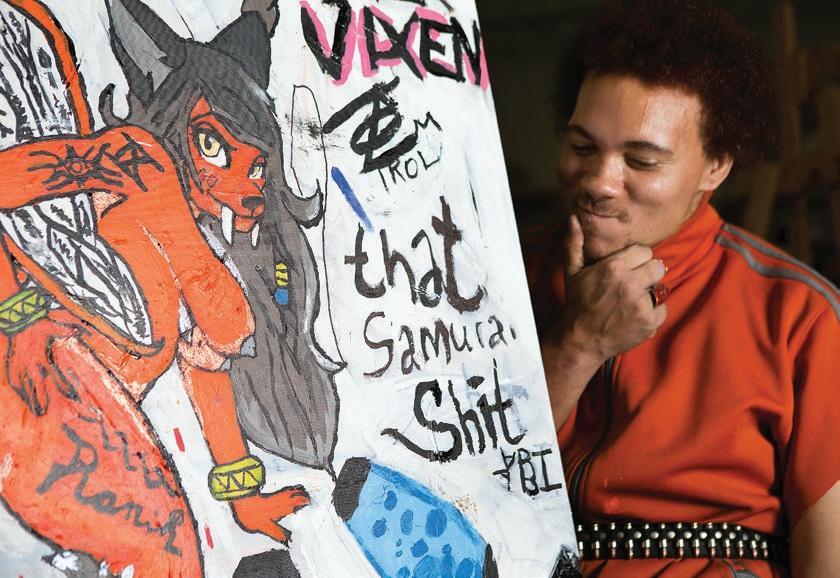
the program funding from the National Endowment for the Arts on three occasions. The grants have pushed clients’ skills to a higher level via mentorship by professional artists such as Cynthia Cook, Catalina Delgado Trunk, and poet Valerie Martinez; encouraged collaborations with community arts organizations including the Harwood Art Center, Tamarind Institute, and the National Hispanic Cultural Center; and educated artists about their craft through lectures and field trips. They have also helped integrate ArtStreet’s clients into Albuquerque’s community of working artists.
Among those most impacted by the first NEA project in 2008 was Terry Yazzie Begay, whose participation led to work as an assistant to a visiting artist. He was then invited to show his work
in a South Broadway Cultural Center exhibit curated by another visiting artist, and he went on to attend the Institute of American Indian Arts. Now a working artist, he plans to teach art in the future.
ArtStreet’s many other success stories include not only artists but leaders such as Kristin Leve, who helmed the AHCH board of directors and is now starting her own advocacy organization for and by individuals experiencing homelessness. In addition, a cadre of mostly female artists have recently banded together and used their ArtStreet-learned skills to create art on the fences surrounding the freshly remodeled Sundowner Motel, once home to Bill Gates, now a low- and mixed-income housing project developed by NewLife Homes.
And then there’s Jimmy Lujan—today
fully sober, with a roof overhead, a working vehicle, and a thriving art career.
“I tackle my art with vigor,” he says, describing his style as leaning toward Spiritualism or Surrealism. “I have a wonderful partner and just the cutest four-month-old baby. Life has become peaceful, and there’s safety and sobriety,” he reflects. Lujan paints in his home studio, does extensive street outreach and advocacy work through his church, and has stepped up to serve as a board member for ArtStreet. He’s shown his art widely and has sold his work to people in eight states and even abroad. And for those walking through ArtStreet’s doors for the first time, he serves as an example of how art can save lives. R
From the Spring 2015 issue

The prickly ethical question raised by the Harwood Museum of Art’s exhibition of Agnes Martin’s earliest works had some critics and viewers crying foul. If Martin were alive today, she would have been livid. Others, however, aligned themselves with the opinion of art historian and critic Richard Tobin, who also wrote the show’s catalog essay. In Ann Landi’s March 14, 2011, Wall Street Journal article, “Saved from the Artist’s Fire,” he flatly states, “The museum’s responsibility is not to the artist. The museum’s responsibility is to educate.”
And quite an education this has been. No viewer with even a modicum of familiarity with the tropes and clichés of mid-20thcentury Modernism, especially those of the halcyon era of Abstract Expressionism, could fail to come away from the experi-
ence without conflicted thoughts, not simply about the ethics of the whole affair but also about the phenomenon, not unheard of, in which an artist determines to destroy all traces of their pictorial evolution. If Martin had had her way, everything before her pristine grid paintings would be to us tabula rasa, for she famously sought to hunt down, retrieve, and torch all her early work.
Organized by curators Tiffany Bell and Jina Brenneman, the show brought together a mere handful of Martin’s earliest works, created mostly from the early 1940s to the late 1950s. Seen together, they vividly illustrated the course of the artist’s apparently arduous experimentation with all genres. Both representational and abstract, these paintings comprised portraits, still lifes, landscapes, and a series of biomorphic and geometric abstractions that point
toward the rarefied “grid works” of her maturity, which miraculously conflated Abstract Expressionism and Minimalism into what Bell and Brenneman call Martin’s “singular genre.”
“The exhibition shows that before Martin arrived at the simplicity and directness of her mature, non-objective work,” observes Bell, “she painted for many years in a range of styles and techniques, addressing content—the vast New Mexico landscape, primordial and biomorphic forms, and hovering, atmospheric geometric shapes— that suggests a search for a way to convey an essential or universal truth.”
It is not inconceivable that had Martin succeeded in her well-documented efforts to ferret out and destroy all traces of this revelatory body of work, today’s viewer would be much poorer when contemplat-


ing the radiant works for which she would subsequently become famous.
Certainly, several successful modern artists have gone to the trouble to scavenge and destroy all traces of their development, invariably with no real explanation for such immolation. In one notable instance and precisely in Martin’s milieu, the great Bay Area figurative abstractionist David Park legendarily torched a huge pile of his early works on a San Francisco hillside.
The will to be born anew, to be seen ab ovo, is understandable but ultimately lamentable, especially when it comes to artists of Martin’s repute. With the Harwood’s astonishing project, however, contemporary art lovers have the opportunity to contemplate Agnes Martin’s mature
works through new and irrevocably altered lenses.
For the purposes of this brief review, one can pass over with little discussion the very earliest pieces in the show, such as a couple of totally competent, attractive, late 1940s New Mexico watercolor landscapes, which surely will strike most viewers as pure Taos Society of Artists productions. These works, and a few self-portraits, show the very young artist learning the ropes. They are so innocuous, one has to wonder why Martin would seek to destroy them.
When the artist took a brief respite from the New York art scene to visit Taos in the 1950s, the work she produced “raises some issues,” Ann Landi observes in “Saved from the Artist’s Fire.”
These early works, Landi points out, are decidedly retardataire, and show Martin wrestling with imagery that had long since been left in the dust by her Abstract Expressionist compatriots: vaguely geometric forms and oozy (as Landi puts it) biomorphism, although it is possible that the artist was influenced by some of the Taos artists’ interest in Surrealism.
Works like The Bluebird from 1954 reveal Martin juggling free-floating geometric shapes that echo, for this viewer at least, nothing so much as the vaguely “moderne” ornament of countless Formica dinette sets.
More accomplished are the biomorphic works, many of which suggest earlier influences, like Kandinsky, Gorky, Miró,

Arp, and, strikingly, William Baziotes, perhaps the foremost biomorphist among the Abstract Expressionists. The best of this lot are the ethereal 1954 Dream of Night Sailing and the masterful The Expulsion of Adam and Eve from the Garden of Eden from 1953, a tour de force in many respects and, at 48 x 72 inches, the largest painting by far that escaped the artist’s torch.
The pallid palette that characterizes many of these surviving works resonates as decidedly feminine, even delicate. The Expulsion, save for one startling slash of vermillion, is rendered in pale pinks, tans, and ambers, and feels like a commingling of the cavorting imagery of Gorky and Miró but with the reticent palette of Marie Laurencin. It is a compelling mixture. De-
picted in semi-figurative fashion, The Expulsion impresses with its jangling, jagged drawing and the pell-mell motion of the ill-fated couple. There is about the entire affair a sense that Martin was kinetically invested in the theme, even empathizing with the protagonists. In no other work on view at the Harwood was there such a palpable feeling of the artist energized. Nor was there another example in which she seemed to have so fully absorbed the lessons of a handful of pivotal works, namely Picasso’s biomorphic Night Fishing at Antibes from his Cubist period, and Gorky’s turbulent geometric-cum-biomorphic abstraction Liver is the Cock’s Comb
The Expulsion is a work of considerable panache, but it was a style she would not
pursue in subsequent works, and one cannot help but wonder if the artist Agnes Martin eventually became was not in some way a reaction against this cacophony of gesture. Certainly, she could have gone the way of a Gorky, whose works were nothing if not vivid demonstrations of life’s endless travails—so much so that art critic John Russell suggested the artist “allowed art to eat him alive.”
Instead, it seems Agnes Martin forged a new path entirely, eventually retreating into the melancholy and the solace that would become her grid. R
From the Summer 2012 issue


There is no art without intoxication. But I mean a mad intoxication!
Let reason teeter! Delirium! The highest degree of delirium!
Plunged in burning dementia!
Art is the most enraptured orgy within man’s grasp.
Art must make you laugh a little and make you a little afraid.
Anything as long as it doesn’t bore.
—Jean Dubuffet, “notes for the Well-lettereD” (1945)
James Havard’s work is often compared with that of Jean Dubuffet, whose painting is characterized by a raw, naive, and seemingly untrained style inspired by the art of children, mental patients, and prisoners—creative output that the French artist coined art brut. Dubuffet’s then-radical style, formulated during the years following World War II, was a conscious departure from European artistic traditions, a complete rejection of the Academy—and culture, for that matter. Similarly, Havard’s embrace of art brut (or outsider art), a style he transitioned to in the mid-1990s, marked his repudiation of an art marketplace that he felt had become formulaic and stale. His was a personal revolution aimed at reinventing not the art world, but himself.
James Havard was born in 1937 in Galveston, Texas. His early art training was academic in nature, focusing on life drawing and realism at Sam Houston State University, in night classes at Atelier Chapman Kelly, and then at the Pennsylvania Acad-
emy of the Fine Arts (1961–1965). Realism was the means by which he gained acceptance in art circles at the time, excelling at the Academy, exhibiting his work at student art shows, and even moonlighting as a technical illustrator to support himself. Ever the experimenter, however, Havard was by the late 1960s playing with abstract figuration, pop art, minimalism, and materials such as auto-body paint and vacuum-formed shapes.
By the late 1970s, living in New York City, Havard became known as the leading practitioner of what gallerist Louis K. Meisel termed “abstract illusionism,” a style of painting characterized by the illusion of three-dimensional space on a twodimensional surface. Paintings such as Color Chart for Cane Garden Bay (1977) possess their own pictographic language of loosely scrawled lines, squirts of paint, X marks, and geometric elements that appear to jump forth from the canvas, an impression accentuated by painted shadows. Havard’s system of



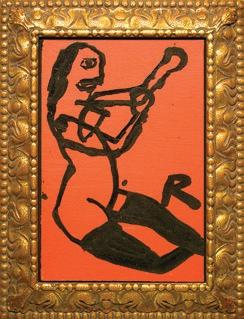
symbols is an enigmatic form of writing familiar only to him. His reputation was cemented by various exhibitions at galleries and museums that established abstract illusionism as a veritable art movement.
The boom years of the 1980s were good to Havard. However, not one to become complacent with his growing success, he began to move his paintings toward a darker palette and deeper expressionism. A work such as Peyote Wall (1982) epitomizes this transitional style. Figuration and references to indigenous cultures, particularly influenced by his passion for collecting Native American objects, appeared sporadically in his work while he was in New York, but once Havard moved to Santa Fe in 1989, they became more common currency. His New Mexico History Page series, for example, incorporated ethnographic imagery in the form of collaged reproductions. The play of illusion and reality became all the more evident with this juxtaposition of paint and photograph.
In turning to the elemental quality attributed to outsider art and ethnographic objects, Havard was following a well-worn, though problematic, path negotiated by Dubuffet, Paul Gauguin, Pablo Picasso, Paul Klee, and André Breton, among others. Through their fixation on tribal cultures and the marginalized of society, the European avant-garde sought a return to origins, true creativity, and authenticity. Abandoning his early painting successes, Havard seemed to be searching for a more authentic voice that was unsullied by market demand. Here again we find parallels with Dubuffet, who in his lifetime



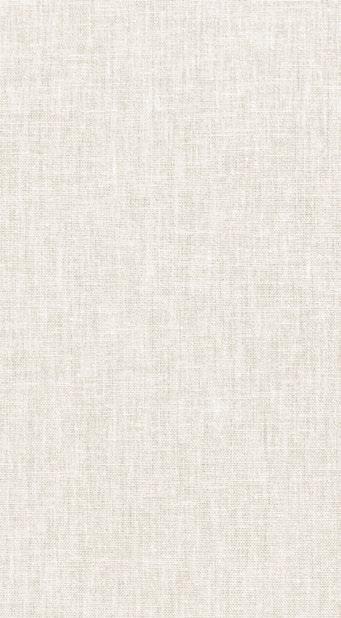
A PRAGMATIC, AFFORDABLE approach to transform your well-loved home into a FRESH, INVITING ENVIRONMENT, ready to welcome its next family, or to set the stage for your own family’s next chapter.

sought liberation from cultural norms and historical precedents. The irony, of course, is that each artist found his authentic voice by rejecting the art establishment while working within it and deriving recognition and monetary success from it.
Although in retrospect Havard’s shift to a more raw, expressive, and unmediated style of painting was clearly a gradual process, the new style seemed in 1996 to be a sudden schism—a response to two health emergencies in five years, both neardeath experiences. It was as if he was channeling Jean Dubuffet—or, more accurately, the outsider artists the Frenchman championed as original and authentic voices— through his paintings.
864/986-8205
beautifulspacesforall@gmail.com
One could hardly conceive of two painting styles more disparate than the refined finish of Havard’s abstract-illusionist canvases and the raw, unrelenting, childlike hand of his art brut works. Yet further consideration suggests what it is that Havard’s two styles share: “intoxication,” such as that described by Dubuffet, with the tactility,
sensuousness, and shape-shifting potential of paint. Early in his career, Havard made paint trick the eye with illusionism so convincing it left you with the impression that you could touch the object represented. In contrast, his later works make paint seize the emotions with the intensity and vigor of its handling. A characteristic painting, such as Woman in Drawing Room with Scorpion , consists of a central figure coarsely drawn or incised, often female, floating on a dense oil-and-wax matrix that is often black. Words may appear gouged into the thick, primordial substrate; when legible, they are cryptic at best. For Havard, unknown demons are purged through the act of painting, drawing, and incising. Sometimes the painting is completed with the ultimate stylistic paradox: an ornate, gilded frame. In this dark underworld—at times humorous, at times menacing—there is no more visual deception of dimensional space. In its place is an insistent flatness. And there is no effort at refinement. Instead there is pure automatism, spontaneity, and “mad intoxication.”
The naiveté of Havard’s expressionist paintings belies a mastery of the human form through rigorous academic training. And the crudeness of the surface and line—accomplished by combining oil and wax, using fingers and paintbrushes, and building up layers and then brutally incising those layers with screwdrivers—is a complete renunciation of the finish he sought as an abstract illusionist. Havard’s late work, in its apparent impulsiveness, seems to embody Dubuffet’s exhortation: “Let reason teeter! Delirium! The highest degree of delirium! Plunged in burning dementia!”
At 72, James Havard still creates nearly every day, despite a third near-death experience in 2006 that left him on a long road to recovery and reliant upon a wheelchair. Despite his physical limitations, Havard’s artistic practice continues along the same path. “I make beautiful messes,” he once quipped. The shape-shifting of his early years has given way to a firm conviction that his brand of art brut for the 21st century is his legacy to the art world. R
From Fall/Winter 2009/2010 issue

In her pursuit of beauty, minimalist artist Florence Pierce utilizes creative vision and light to achieve balance and elegance in her intriguing resin reliefs, while inviting perfection into her Zen-like, modernist artistry. w Seems serendipity slipped into her life when a drop of resin accidentally spilled onto tinfoil—and opened up new ways for this artist to look at light. Pierce began seeing her art—colorful monochromatic abstractions and varying textures within flat-surfaced works— as being beyond the ordinary. w The last living member of Taos TPG (Transcendental Painting Group), Pierce credits Emil Bisttram, her TPG mentor, with inspiring her artistic growth. Moving to Taos at 18 to be his student, Pierce laughingly recalls how her mother had no idea that her daughter’s nubile “attraction for the men in town would turn out to be quite hazardous.” w Can the transcendental truths Taos bestows upon receptive artists be sacred tools for creating illumining art? Pierce has certainly mastered her art from within, and in so doing, transports us into that wordless realm to better appreciate uncommon beauty that can only be felt, and not described. w Celebrating her 86th birthday last July, Pierce smiles at the memory of her gallerist-friend Charlotte Jackson, “surprising me as she does every year, with a cake.” Pierce has lived in Albuquerque for 55 years. R
From the Winter/Spring 2005 isssue



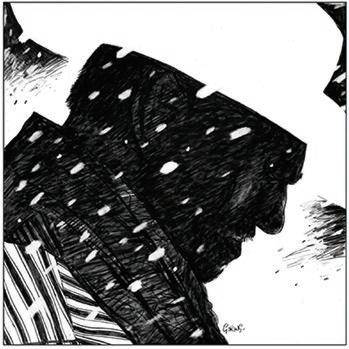
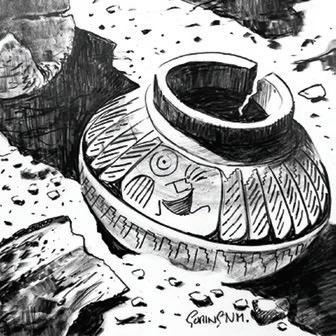

A New Mexico artist devotes her life to shattering assumptions and stereotypes
BY WESLEY PULKKA | PHOTOS BY DO NALD WOODMAN
Judy Chicago looks at least a decade younger than her 66 years, and her warm, open demeanor makes her seem more like a friendly neighbor than someone who has changed the world. An artist, author, educator, feminist, and iconoclast, Chicago launched her breathtaking career in Los Angeles during the early 1970s as a minimalist sculptor. At that time, she met enormous resistance from the male-dominated art establishment, and although critics and other artists recognized her extraordinary talent, Chicago hit the glass ceiling for women artists, who were expected to be supporters of their male counterparts but never their equals or superiors. Her response was to work harder, pushing her art into new areas of exploration, showing it in alternative venues, and helping to establish art programs for women at the university level. Though frustrated at the time, she is philosophical as she looks back on that period.
“I’ve always been dedicated to excellence, so I took courses at an auto-body school to learn spray painting,” Chicago says. “And though I loved the minimalist aesthetic, my other passions are content and relevancy. As I developed my personal expression, I included minimalist elements but gave them a story line.” She also changed her name, dropping both her maiden name of Cohen and her married name of Gerowitz to become
Judy Chicago. The artist says she borrowed the name-change concept from the Black Power movement, whose members, like Muhammad Ali, adopted new monikers to rid themselves of slave identities. “I knew I had the right to my own identity and, thanks to the support expressed by my parents, who made it possible for me to start my art training at age five, I knew that I had a right to be recognized for my talent. My name change was a step toward selfrealization,” Chicago says.
As a gesture of defiance against male oppression, Chicago enlisted Los Angeles gallery owner Jack Glenn to help her create a pugnacious poster of herself wearing boxing gloves and shorts, a pair of men’s athletic boots, and a custom-made sweatshirt emblazoned with her new name. The picture was taken in the same boxing ring used by Ali during training sessions. “Jack and I made the poster as a lark to counteract the macho nature of the L.A. art scene, never imagining that Artforum would run it on a full page and turn our picture into an international emblem,” Chicago recalls. The poster also became a symbol of personal toughness that masked the pain that she had endured in her life: As a child she lost her father to complications
following surgery, and her first husband, Jerry Gerowitz, died in an automobile accident.
Chicago’s self-realization found its first major artistic expression in The Dinner Party, an installation celebrating women in history as well as feminine materials, processes, and talents. The triangular work, measuring 48 feet on a side, incorporates symbols of female sexual organs as well as textiles, embroidery, pottery, and paintings contributed by more than 400 female artists. It includes 39 place settings that celebrate the achievements of historic women and goddesses; every setting features an embroidered tablecloth, a ceramic chalice, and a dinner plate depicting milestones in each celebrant’s life or story. The materials and techniques are traditionally associated with quotidian “women’s work.” Begun in 1974, The Dinner Party was first shown at the San Francisco Museum of Modern Art in 1979 and will reopen in 2007 as part of the permanent collection at the Brooklyn Museum of Art.
Throughout her career as both an artist and a university teacher, Chicago has confronted male-dominated subject matter like the female nude and depictions of historic events. Her solo exhibitions
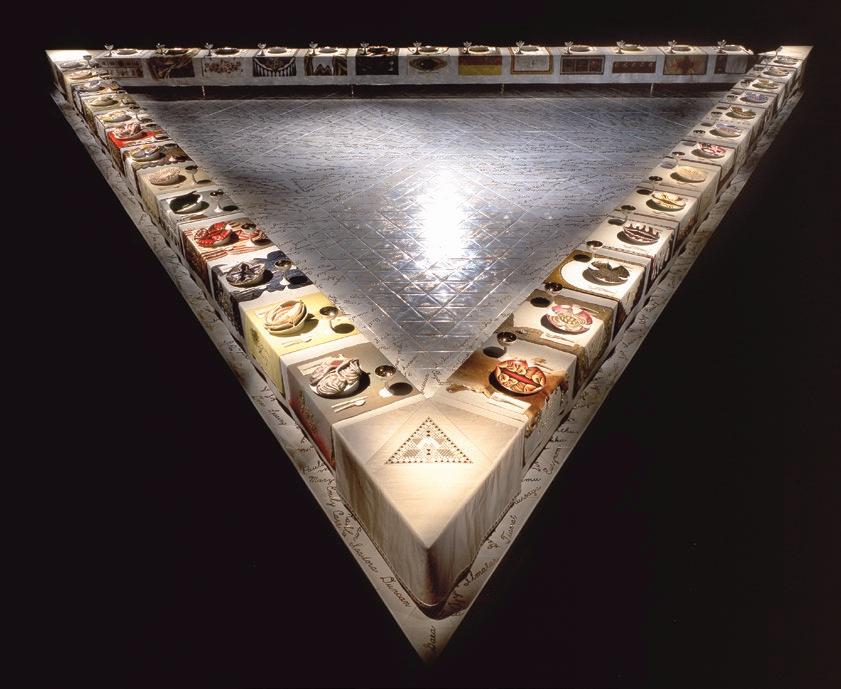


“Jack and I made the poster as a lark to counteract the macho nature of the L.A. art scene, never imagining that Artforum would run it on a full page and turn our picture into an international emblem,” Chicago recalls.





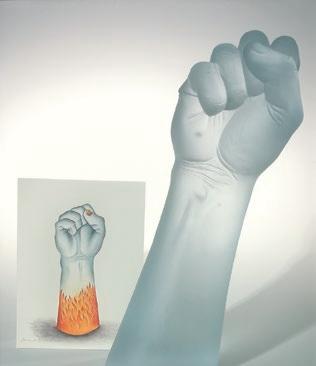
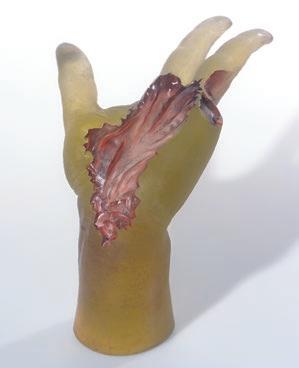

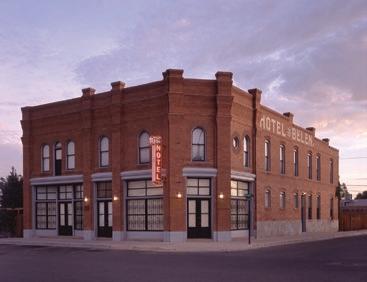
and community-oriented art projects that challenge the accepted view span four decades. Additional highlights are The Birth Project, 1980–1985; The Holocaust Project, 1985–1993; The International Quilting Bee, 1980–1996; and Resolutions: A Stitch in Time, 1994–2000. All of her major projects became traveling exhibitions that achieved national stature.
“The name Judy Chicago has become synonymous with the feminist art movement,” says Laura Addison, contemporary art curator at New Mexico’s Museum of Fine Arts. “Though she’s best known for The Dinner Party, her significance extends far beyond one project. She’s a provocateur who pushes whatever topic she takes on to its limits, giving it epic import. She has tackled biblical themes, birth and motherhood, women’s work, the Holocaust—always working with ideas much larger than herself or any given viewer. She denies the fallibility of memory by writing people into their rightful place in history.” Addison also cites Chicago’s unsung impact on male-dominated Minimalism, noting that her beautifully crafted minimalist work, like Rainbow Picket, is now being recognized more than 30 years after the works were completed.
“Judy Chicago is magnificent,” concurs Ken Marvel, co-owner of LewAllen Contemporary in Santa Fe. “She quietly works through her art to improve the status of women in our society. Judy has remained resolute about the seriousness of her work and, despite resistance from others and debates in the United States Congress over The Dinner Party, for goodness’ sake, she remains one of the most cheerful, intelligent, highly skilled, and positive people I’ve known.” (Congress became involved with The Dinner Party when several arts institutions sought public funding to display the installation.)
Chicago says she was seduced by New Mexico during a series of short trips to Santa Fe to see friends. The visits became longer until she finally settled here. Chicago makes her home—the first she’s ever owned—in Belen with her husband, photographer Donald Woodman, and their six cats. Formerly the Belen Hotel, the property is listed in the National Register of Historic Places and exudes Victorian grace. “After finishing The Holocaust Project, we were exhausted and in debt,” recalls Chicago. “There was no rational way for us to get this property, but we fell in love with it while we were
looking for a place close to the airport.” She credits Woodman, who once built a studio and residence for Agnes Martin, with the beautiful renovation that restored the hotel to its turn-of-the-century flavor. Her spacious studio occupies a portion of the ground floor that has variously served as a restaurant, a bar, a meat market, and a sitting room for the town’s schoolteachers. Upstairs is her drawing studio.
Chicago is currently working on a series of fused-, cast-, and painted-glass sculptures dedicated to the inner structure of the human figure. Her work is related to so-called shamanic x-ray drawings and other sources. She is working with glass experts in Prague, in the Czech Republic; glass etchers Norm and Ruth Dobbins in Santa Fe; and the staff at Pilchuck Glass Studios in Washington State. Her new work is a clear-eyed expression of the state of our world— both troubled and filled with hope. Other major projects in progress include the expansion and development of Through the Flower Foundation, Chicago’s private nonprofit organization dedicated to women in the arts. Her hotel and the property across the street will become a permanent educational center and will feature exhibitions of feminist art, including the artist’s own.
Chicago was recognized recently in Reform Judaism magazine as one of eight women who have changed the world, alongside Supreme Court Justice Ruth Bader Ginsberg and Betty Friedan, author of The Feminine Mystique and co-founder of the National Organization for Women. Chicago also is included in the seventh edition of A Basic History of Western Art, a university textbook that has traditionally excluded women artists.
“I believe most of the controversy about Judy’s work is the result of her being a strong woman artist,” says Woodman. “She does what she believes in and wants to have a positive influence on our messy world. She doesn’t seek notoriety.”
“I am a content-driven artist,” explains Chicago, who is known for her single-minded thoroughness and devotion to detail. “When I take on a project, I need to know everything about the materials and techniques, and the history of the subject, and I find some way to get it done even if I have to invent one.” R
From the Fall 2006 / Winter 2007 issue

Eli Levin hates Modern art. The wellknown local painter, etcher, and writer, who turns 81 this year, has even written a book about it, aptly titled, Why I Hate Modern Art. “I was never even tempted to follow that trend,” he says. “In fact, I was asked to leave the School of the Museum of Fine Arts in Boston in the early 1960s because of my commitment to realism. They wanted me to paint large abstract pieces, which were all the rage at the time, but I just wanted to do small-scale social realist works, so they let me go without giving me a degree. I always wanted to paint subjects that everyone can relate to, not just a culturally elite art circle.”
Dixon-based artist Eli Levin eschews technology and trends in works that speak directly to the viewer
Levin—tall, slim, and remarkably fit— still paints every day and considers himself a social commentator. Through his artwork, he tells stories that need to be told. Common themes include homelessness, social problems resulting from the extreme wealth disparity between rich and poor, workers being pressured by corporations into taking low-wage jobs in order to survive, and, more recently, racial conflict and police shootings.
“Unfortunately, social realism isn’t very saleable these days,” he admits. “It’s considered outdated, and frankly, I wouldn’t want to hang my social commentary artworks on the wall and look at them every day, either. I’d much rather
they were hung somewhere where lots of people can see them, start thinking about what they represent and, hopefully, start a conversation. Most of my work now ends up on display in museums, which is just fine with me.”
Born in Chicago in 1938, Levin grew up in a left-leaning, intellectual environment. His father was a war correspondent who went on to write several books, and his mother was a university professor and a card-carrying Communist, as Levin is to this day. He began drawing and painting as a small child and went on to study art in New York and Boston before hitchhiking across the country, ending up in Santa Fe in 1964. “I didn’t really have a plan,
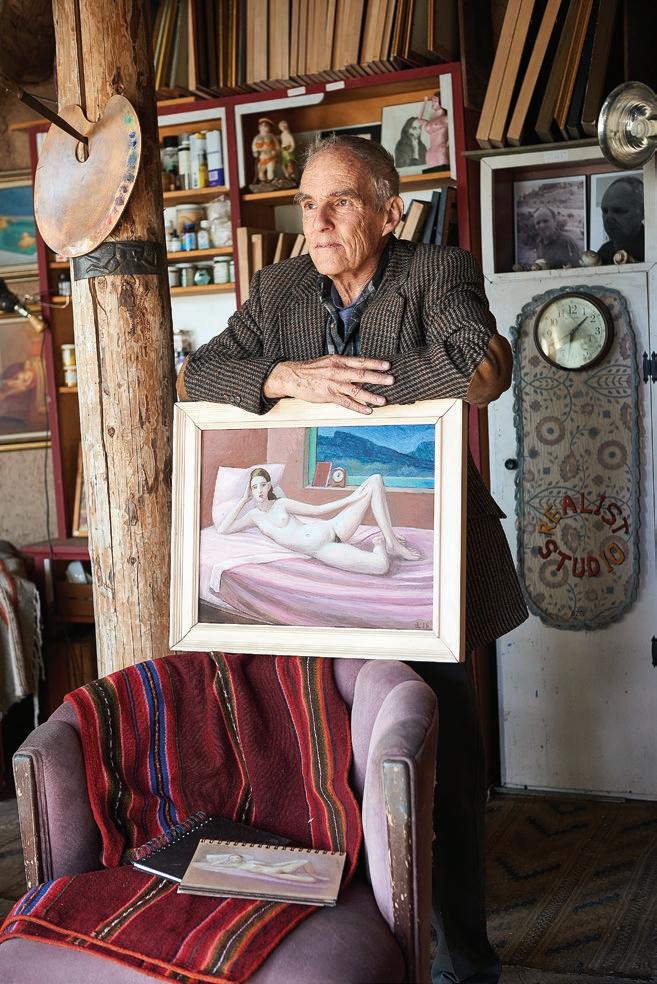
and I didn’t know anyone,” he says. “I just needed a change, and I’d heard that Santa Fe had a good art scene, so I thought I’d check it out.” That was 55 years ago, and he has been here ever since.
There was, indeed, a thriving art colony in Santa Fe from about the mid1960s until the early 1980s, and Levin has since written a book about it called Santa Fe Bohemia. Canyon Road was a thriving art hub, with studios where artists could both live and work. Levin was able to rent a residential studio for just $65 a month, and his art career flourished. “I was able to make a living as an artist during that time,” he says with a smile. “It was great.”
His social life flourished as well. At that time, Santa Fe was a melting pot for creative artists like Will Shuster, T.C. Cannon, and Fritz Scholder, among many others, and Levin knew and partied with them all. The most popular place to hang out was Claude’s Bar on Canyon Road (in the space now occupied by Tresa Vorenberg Goldsmiths), which attracted a mix of artists, cowboys, Indians, writers, lobbyists, and politicians, and Levin liked to paint the frequently wild bar scenes. The paintings sold, often right off the easel, but then the prestigious gallery he had signed with wanted him to paint pictures with a predetermined mix of characters, and Levin refused. “I won’t paint to order,” he says, “not for a gallery and not for a client.” He finally needed a lawyer to get himself out of the contract.
In the late 1960s, Levin built himself a house in downtown Santa Fe (“I learned as I went along,” he says modestly), which he divided into four apartments, one to live in and three to rent out. That was his home for many years, until the art scene finally shifted. Galleries moved in, and Canyon Road became known for selling art rather than making art. “The artists were forced to move out as things became too expensive, and the whole character and personality of the place



changed,” he says wistfully. “It didn’t feel the same any more. My friends had either died or moved on, and the younger artists coming in were more interested in using technological aids, rather than producing pure art forms like the old masters did.”
Since he already owned some land in Dixon, New Mexico, Levin decided to move there and build himself another house with a studio where he has lived with his girlfriend, also an artist, for about the past fifteen years. The studio is simple but welcoming, with a big, antique woodstove, a few threadbare rugs tossed onto the concrete floor, wooden beams, a huge easel, an abundance of books, and shelves for storing paintings … a real hippie hideaway and a perfect reflection of who he is: an uncompromising spirit of simpler times past.
His favorite medium for painting (and another reminder of his rugged individualism) is egg tempera, which was much favored by Renaissance painters before oil took over as the preferred medium in the 1500s. Powdered pigment is added to specially prepared egg yolk to produce the desired color. Unlike oil, it dries instantly, hardens, doesn’t fade with time, and produces brilliant, permanent colors.
“That’s why Renaissance paintings still look so vibrant,” he explains. “The yellow from the egg yolk disappears at once and, even though it’s flat—you can’t build layers to produce a three-dimensional look like you can with oils—I personally think it’s cooler looking in the end.”
A prolific painter, Levin works with other media, too, including both oil and watercolor, and he is also highly skilled in the art of printmaking. In 1980, together with artist Sarah McCarty, he started the Santa Fe Etching Club. Now based in the Argos Gallery downtown under the leadership of Eric Thomson, the club offers regular classes, studio sessions, and events, and it gives artists the opportunity to show their work by taking part in regular exhibitions. Although he no longer makes prints himself, Levin is still involved with the group and will occasionally give talks or take part in events.
In addition to his bar scenes, Levin is also known for painting nudes, but he now prefers to use his imagination instead of a real-life model. “It can take up to 30 hours to paint a nude,” he says, “and, just like with photographs, the models are rarely satisfied with the result. That’s why I’ve never painted por-
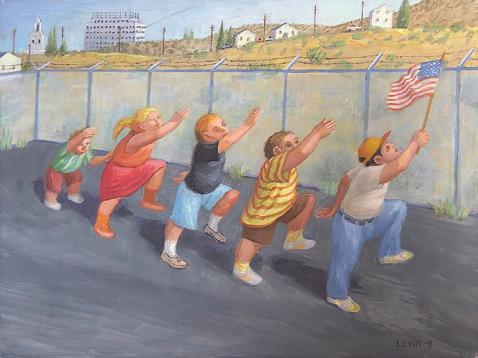
traits. Working with live models you inevitably build a relationship, and I much prefer to have artistic freedom.”
Levin has recently turned his attention to inanimate objects—everyday items such as kitchen utensils, hammers, and screwdrivers—which he refers to as “a structured little section of the universe.”
Living in rural Dixon, with its wide-open spaces, he is now drawn to painting landscapes as well. “Most artists nowadays focus on just one theme, either to make their work instantly recognizable, or because a gallery thinks that will make them more salable. I think the art of painting has definitely suffered because of commercial considerations.”
Levin’s art has been displayed in many Santa Fe galleries over the years, including Zaplin Lampert Gallery, Ernesto Mayans Gallery, and St. John’s College, among others, and a retrospective of his work was held at the Las Vegas Art Museum in Nevada in 2000 . His work is also included in the collections of the Tucson Museum of Art, the Archives of American Art in Washington, DC, the Cleveland Museum of Art, and the New Mexico Museum of Art in Santa Fe. He is also a regular participant in the Dixon Studio Tour, which has been held annually during the first weekend of November for more than 35 years and now includes some 40 different artists.
Levin is proud to still be painting and to have maintained his independence from popular artistic trends throughout his career. He firmly believes that fine art has been in rapid decline for well over a century, moving further and further away from its purist roots. He cites the loss of technical skills, the lack of depth, the lack of concern for the human condition, and the advent of technology as major reasons for that decline. “Who wants to be a Renaissance artist these days?” he asks. “Most artists use technology now; people are obsessed with it. Artists today really don’t know how to paint anymore, but then, I don’t know how to use a computer.” R
From the Summer 2019 issue

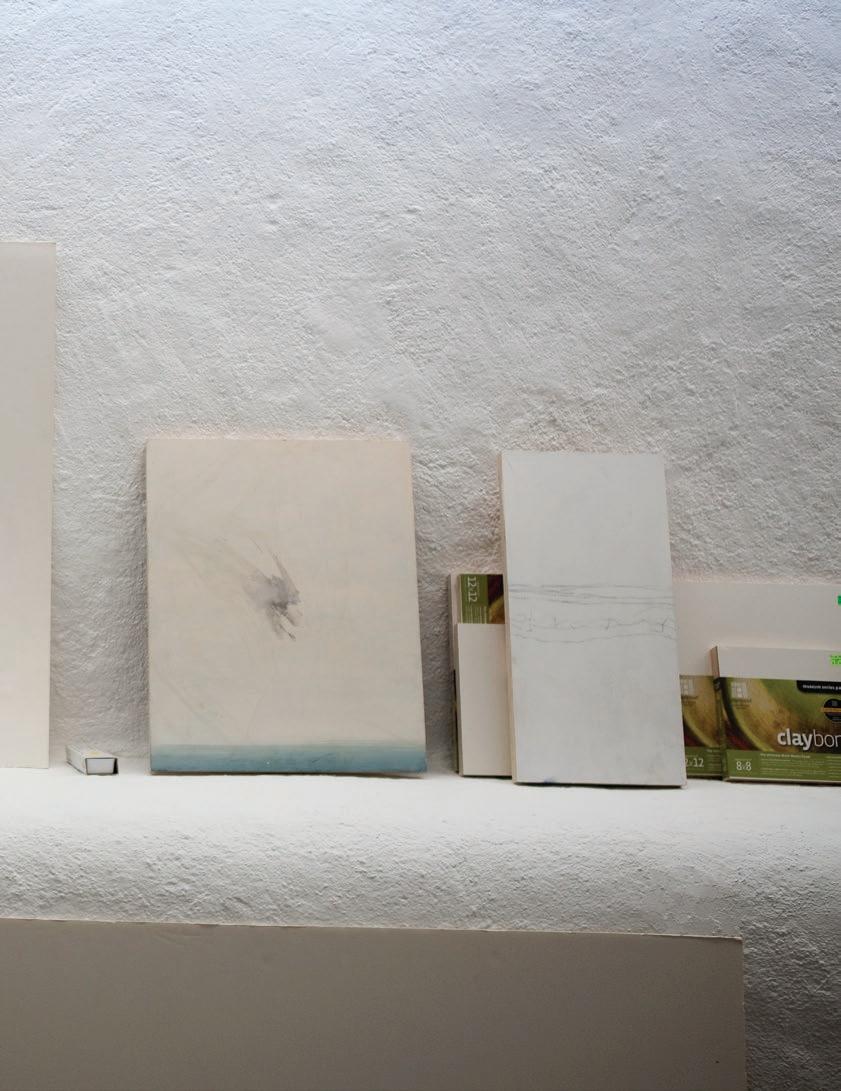
The master of plein-air realism finds truth in what is

If only more of us could express ourselves as clearly and profoundly in word or image as Woody Gwyn does with his paintbrush. The intense detail in Gwyn’s natural realism delivers us true terrains of New Mexico, Texas, Virginia, Pennsylvania, California—wherever he is inspired.
Light is the common thread, and Gwyn treats it with delicate precision. His light moves like a life force through the canvas to shroud a tree, grace a field, climb rocks, splash into the Galisteo Basin, or tip the waves of the sea. It’s ironic how such intense precision and energy conjure a feeling of calm.
Often there is historic relevance to a site. In Midday (2010), Gwyn painted near Manassas, Virginia, where George Washington used this tree as a marker when he surveyed the land. Gwyn studied at the Pennsylvania Academy of Fine Arts in Philadelphia “before the Civil War,” he jests, adding that “actually, I was there the day Kennedy was shot.” He studied under Carolyn Wyeth, the sister of Andrew Wyeth. This family of painters profoundly affected the 19-year-old Gwyn, and he found himself getting to know them quite well. At the time, the Wyeths lived in Chadds Ford, Pennsylvania, a township about 25 miles west of Philadelphia. “I had a car,”
Gwyn recalls. “One time, Mrs. Wyeth was stranded when Andrew took their car up to Maine, so I drove her around.”
Gwyn recalls as well some words of wisdom from Andrew Wyeth, who told him: “Whatever you do, do it like a man.”
The Wyeth family has long had a presence in New Mexico as well. Michael Hurd, son to painters Peter Hurd and Henriette Wyeth Hurd, lives near Ruidoso, New Mexico, on the Sentinel Ranch that his parents established in the 1940s. There, Michael operates the Hurd La Rinconada Gallery, which not only showcases his own powerful paintings, but also those of his parents and his uncle, Henriette’s brother, Andrew Wyeth. Gwyn hopes to go there to paint soon, continuing a five-decade long relationship with this iconic family of American artists.
True to his Welsh heritage, Gwyn is a storyteller. As a young man, he made a point to meet great artists. He sought them out or visited studios. “I’ve gone out of my way to meet these people, so I could know what it is to be an artist,” he says. “I’ve always been curious about artists.”
He speaks of visiting Georgia O’Keeffe. She showed him a note by 19th-century Romanian sculptor Constantin Brancusi, a modern master. “I asked Mrs. O’Keeffe what she

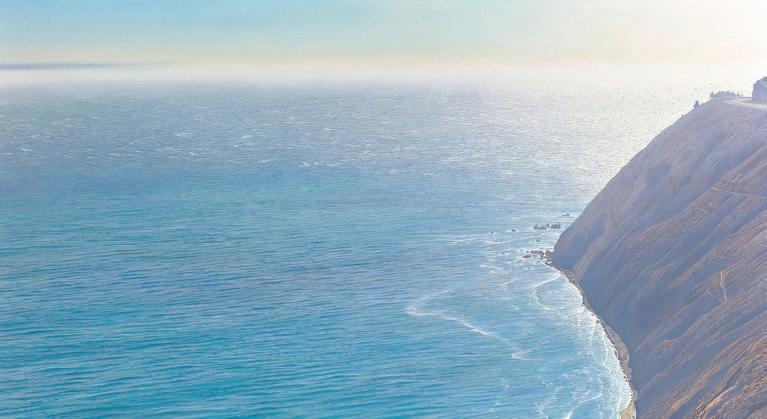
“There has to be passion. There’s simply no other way to approach this life.”
—Woody Gwyn
thought of Brancusi. All she said was, ‘He had the bluest eyes you’ve ever seen.’ That’s the only info I got about Brancusi. She was like a teenage girl.”
Open and affable, easy and coasting on life, art, and meanings, Gwyn describes how he finds landscapes to paint. He says they are either places he passes, or places he’s imagined. “Sometimes I’m like a dog who knows where his bone is buried. I go seek what I imagine.”
Then the process starts. Perhaps in his “art truck”—a veritable pleinair painting studio on wheels. From there Gwyn studies his spot, making drawings, watercolors, and taking photographs.
“I draw to get the feeling of the place,”
he explains. “I take a photo for detail, but it doesn’t ever have the feeling.”
A subject might receive his attention for many months as he paints it in different sizes and shapes, working through the idea until he feels it is complete.
Many Realist painters, Gwyn notes, are considered stylized even though the places they painted really look like their paintings. He cites Peter Hurd, a master of the Western landscape, Thomas Moran of the Hudson River School, and the Venetian Giovanni Antonio Canal, known as Canaletto. “They weren’t making these things up.”
Gwyn adds of French photographer Henri Cartier-Bresson (1908-2004), known for his ability to capture “deci-
sive moments” with his camera, that he “showed us that, with vision, every moment has its profundity, even the most slight moments.”
The artist lives a quiet life, both laidback and intense. His home is a vast, historic adobe once occupied by Bishop Lamy. As we walk through the many rooms, we come to one that was the Bishop’s original chapel. Gwyn says this will soon be his watercolor studio. Next to it, a room that serves as his oil painting studio was the Bishop’s living quarters. We walk through the house under a portal, where a swallow feeds her nest of hatchlings.
In 1976 Gywn landed in the village of Galisteo after attending Art Academy in Philadelphia. In 1997 he and
his wife, Diana, moved into the historic adobe museum that once housed Linda Durham’s gallery.
The quiet village has gotten even quieter since Durham moved her gallery to Santa Fe and the Galisteo Inn closed. To bolster the community, two years ago Gwyn and his wife generously opened their front hall, a great room, and the room adjacent to it, as a gathering spot and gallery for local artists. “The only rule,” quips Gwyn, “is that they get along.”
In 2010 Gwyn was awarded the prestigious New Mexico Governor’s Art Award for an Individual Artist. “It felt good to have that recognition,” he says.
This year opened with a dire scare. Gwyn suffered an aortic dissection, a condition in which the aorta disintegrates, pouring blood into the chest cavity. Few survive it, but Gwyn did. After an eight-hour openheart surgery, he began his long recovery and is painting again.
Gwyn’s paintings are an homage to the earth’s natural beauty—but they are not simple. In many works, he introduces man-made elements, like a blacktop road rolling through a vast landscape, or a railroad track. He delivers a bit of edge by discussing visually the mingling of man and the wild environment. Light serves as the happy music in this show. Gwyn is precise in his representation of geological forms and colors. As he works, from first study to final piece, be it small or large in scale, the process is a constant dialogue back to the initial inspiration.
Many of the landscapes Gwyn has painted over the last 50 years are changed or gone. “Nature’s going to win in the end,” he remarks. The sense that the earth is tired and unhappy hovers over him like a dark cloud. As a body of work, his paintings present an enlightened sense of humility of the human place on earth.
As passionate about the work as he is about the process, Gwyn’s credo might be summed up by Brancusi: “Create like a god, order like a king, and work like a slave. That’s what it’s like to be an artist.” R
From the Fall 2011 / Winter 2012 issue
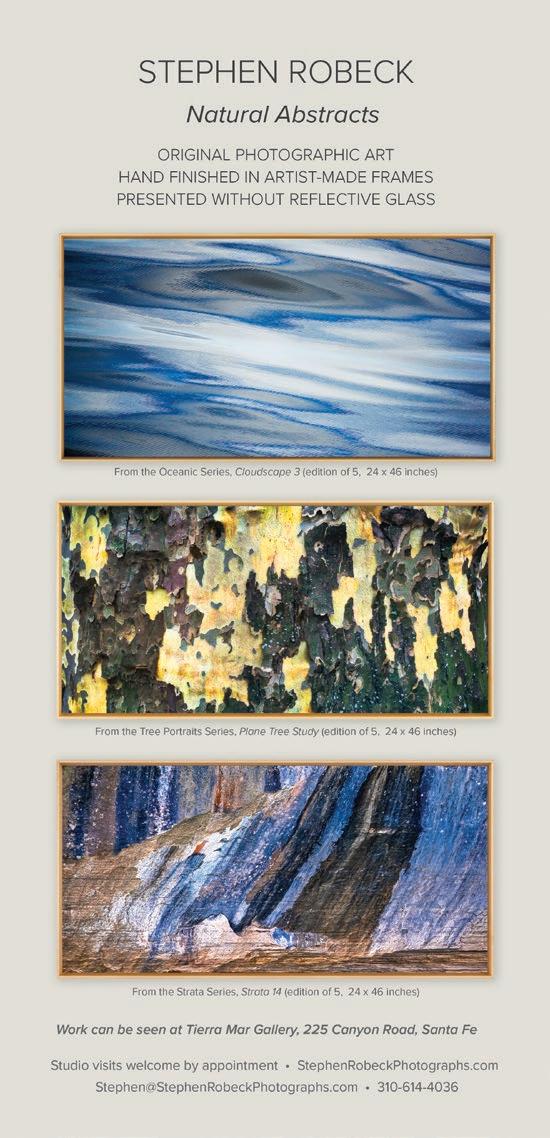
BY WESLEY PULKKA |
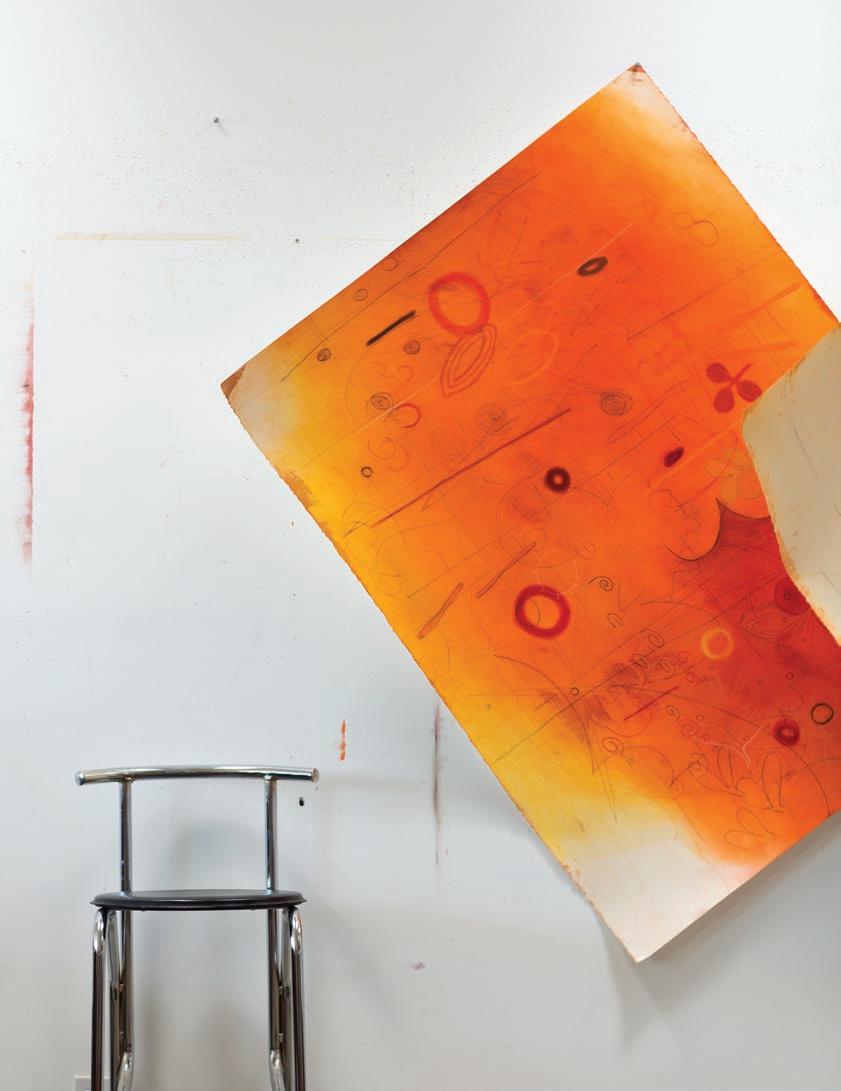
Emmi Whitehorse and her symbolic connection to the natural world

Artist Emmi Whitehorse is internationally renowned for her atmospheric abstractions that use color, symbol, and metaphor to celebrate the life force that makes our existence possible.
“I have chosen to focus on nature, on landscape,” she wrote in a recent artist statement. “My paintings tell the story of knowing land over time—of being completely, microcosmically within a place. I am defining a particular space, describing a particular place. They are purposely meditative and meant to be seen slowly. The intricate language of symbols refers to specific plants, people, and experiences.”
Whitehorse’s spacious studio ten minutes south of Santa Fe offers her the contemplative solitude and peaceful ambiance that her work demands. “I come to the studio to escape all of the noise and bother,” she says during a recent visit. “Here I can relax and focus on my work.”
Her studio is filled with work in preparation for a solo show at Chiaroscuro Contemporary Art Gallery in Santa Fe. These timeless, contemplative paintings, drawings, and prints emblematically embrace the fragile and ephemeral spirit and raw energy within our living environment.
Whitehorse entered the world 54 years ago on the Navajo reservation outside Crownpoint, New Mexico. Her mother was
tending sheep at a winter graze and went into labor during a heavy snowstorm. She had to ride home on horseback to catch a ride in her husband’s pickup truck down bumpy, winding, and unplowed roads to the hospital, which was in Crownpoint. The perilous journey consumed the rest of the day. Fortunately, Whitehorse waited until early the next morning to be born.
“My childhood was spent playing and tending sheep in a landscape that seemed magical and endless,” she says. “It was a gift to be able to spend time alone watching the animals. My only real frustration was with the goats—[they] always had their own ideas. The goats would wander, and, of course, the sheep followed.”
Whitehorse did not have conventional art materials as a child but she and her friends would make art with what fell to hand. “We used to draw on these really fine deposits of silt that we found in the washes,” Whitehorse recalls. “If you didn’t like the drawing you could just smooth them away with your hand. Like an Etch A Sketch®. The drawings we liked would be left overnight where they would collect lizard tracks or get changed by the wind. We also drew on rocks. It was fun to find them again and see if we could improve on them.”
The turning point came when Whitehorse won an award for one of her abstract paintings in a statewide art competition at
her high school. “It was a strong affirmation that I could really be an artist,” she says. “Once I realized that I could still make art and study, the academics came easily.”
Though her parents and grandmother— who was a weaver—lived traditional Navajo lives, they wanted Whitehorse to excel in school and get the best possible education. “When I was accepted into UNM my parents hoped I would study something serious. I couldn’t bear to tell them I was an art major. They would have been shocked to know I was drawing naked people,” Whitehorse says with a laugh.
Her university path was not always smooth. When Whitehorse wrote an insightful paper on the influence of American Indian arts on mainstream contemporary art, she received pushback from her professors and fellow students. It’s a shame her teachers had not read artist and art theorist Marsden Hartley’s treatise on the same subject, written in the 1920s.
Though she fast-tracked through her Master of Arts program with the intent to become a Tamarind Institute master printer, Whitehorse soon realized that her heart was not in teaching. Instead she focused on making her way in the art world, and was soon exhibiting in galleries and museums throughout the United States and Europe.
One of her early exhibitions was a 1983 show titled Native Artists of the Eighties at the Sacred Circle Gallery in Seattle, owned and operated by the United Indians of All Tribes Foundation. Former gallery founding director Jim Halliday (1981–1985) said in a recent interview, “Emmi Whitehorse was recommended to us by Jaune Quickto-See Smith, who was helping us identify emerging Indian artists. [Whitehorse] was absolutely one of the greatest discoveries that we came across. The thing that I loved about her work is that it had true depth that allowed the viewer to spatially enter her world. In a self-induced meditative state she pulled the images from her life experiences, childhood memories, and imagination.”
The Sacred Circle show occurred in the third year of her professional career. Whitehorse had already exhibited in New York City and Venice, Italy. Since then her works have been exhibited in major museums and galleries throughout the

United States and Europe, including Chicago, Los Angeles, San Francisco, Tucson, Santa Fe, Denver, Germany, Belgium, and Switzerland.
Chiaroscuro Contemporary Art in Santa Fe currently represents Whitehorse, and gallery director John Addison has enthusiastically followed her 30-year artistic development. “Emmi’s career has grown over the years among those collecting Native American arts as well as making that crossover to mainstream collectors of all types of art,” he says. “She’s really in demand just as a painter, without regard to her Navajo heritage.”
Addison points out that Emmi has recently come full circle. Her early work was very much grounded in nature, but starting in the late 1990s it became increasingly abstract. In the last few years, however, her work has returned to more landscape-based imagery, incorporating seedpods, ferns, and other recognizable botanicals—as witness her latest series, Opuntia, the scientific designation for a genus of cactus.
Author and critic Lucy Lippard wrote in a 1997 Tucson Museum of Art catalogue essay: “In the recent work, Whitehorse has traveled into more remote territory, looking through one world into another . . . There is a weightless quality to her images . . . Her paintings seem to catch the momentary pause before these light transparent creatures blow away again . . . The forms in her new works appear to be pressed into the retina, mediating between self and landscape, melting boundaries, forming and reforming from one painting to another.”
Whitehorse’s renderings are both spatially expansive and highly detailed, bearing witness to bird calls, buzzing insects, rustling leaves, animal tracks by a streambed, spring breezes, winter snows, worm paths in the mud, and the omnipresent viscous mass of ambient air, water, and earth that are truly in constant motion— embodying the layered vibrations between the microcosm and macrocosm.
Whitehorse is married to author and cultural arts business owner Mark Bahti,
who earned an MFA in American Indian arts and is currently working on his doctorate. The couple has residences in Santa Fe and Tucson, and Whitehorse is currently working on a series of green paintings inspired by the cacti that dominate her Arizona home’s backyard.
“The cacti are what [confront] you when you live in Tucson,” she says, explaining her interest. “It’s kind of odd that you’re just surrounded by cacti. I understand why Jim Waid paints cacti as alien things. I’m also impressed by their strangeness. It’s the green that I find interesting as well as disturbing, so I’m trying to come to terms with it and make peace. Not my favorite color, but . . .” Whitehorse’s words trail off into laughter.
Ultimately, Whitehorse hopes that her artwork, regardless of subject matter, will help her viewers become more aware of their surroundings and connect to the energy and spirit that exists within the living environment. R
From the Fall 2012 / Spring 2013 issue
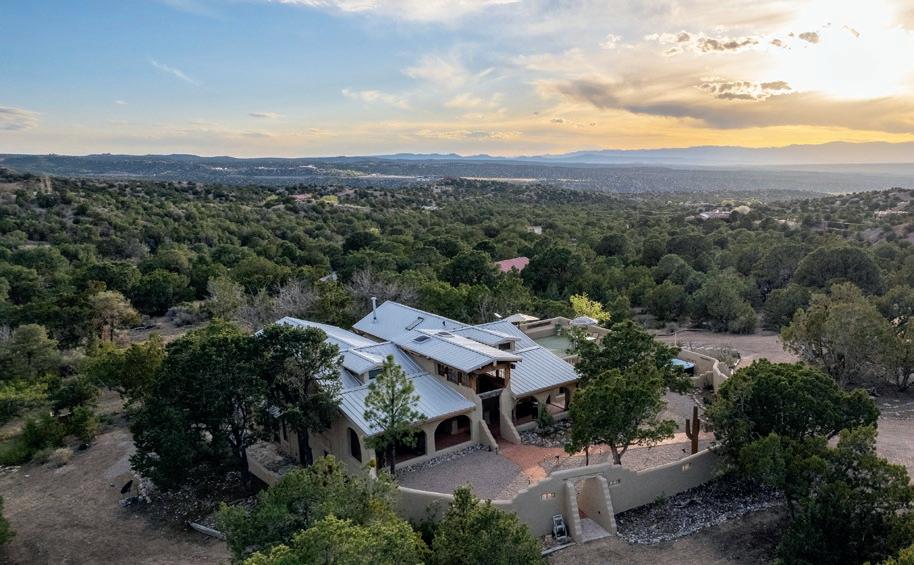



XANADU VILLA is a 4,100 square foot estate property with 5 bedrooms, 4 baths, with 2 living areas located on 5 private acres in the Tesuque foothills, yet less than 10 minutes to the Plaza. A 1,000 sq. ft. observation deck looks over the Santa Fe Opera as well as the Jemez and Sangre de Cristo Mountains. Relax in the hot tub and enjoy amazing New Mexico skies. This property is luxuriously furnished by the owners, Santa Fe Xanadu Gallery. Use the QR codes to visit the website or to view the amazing drone aerial of the estate.






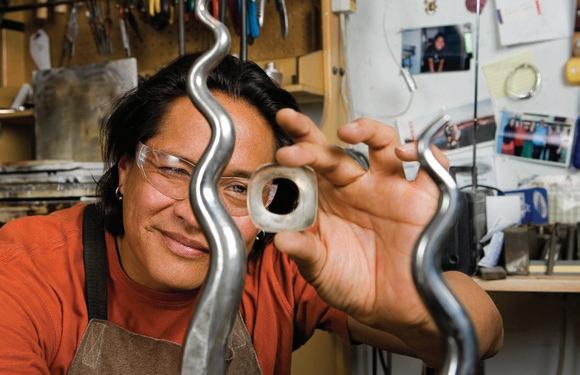
BY GUSSIE FAUNTLEROY | PHOTOS BY SARA STATHAS
Asilver bracelet with a double row of gently curved, inchlong triangular spikes is part of jewelry artist Cody Sanderson’s risky-looking line. “People say, ‘Is that jewelry or a weapon? Can I get on an airplane with that?’ My response is it may look dangerous, but it’s very comfortable to the wearer,” Sanderson explains, sitting in his Santa Fe studio alongside a bench of neatly organized metalsmithing tools.
Actually, “sitting” is imprecise; the 43-year-old artist rarely stops moving. He demonstrates making high domes in a copper sheet, using the antique silver-
smithing form of repoussé. He points out new pieces and photos of older works. “My theme this year for Indian Market is bugs, spikes, and stars,” he declares, opening a display box of silver bracelets whose repoussé designs form squiggly legged and legless elliptical shapes. “I call these my paramecium and amoebas.”
Sanderson, of Diné (Navajo) ancestry, is known for his imaginative, often playful style. His award-winning jewelry frequently involves hand-fabricating techniques such as bending, forging, casting, and stamping. Especially inventive works may incorporate ball bearings,

multiple hinges, or internal springs. But the artist also has a more serious, yet still innovative side. This is expressed in pieces like a 22kt-gold necklace that uses exquisite, naturally branching red coral. The necklace comes with a Bisbee turquoise–accented crab with diamond eyes, which can be attached to the necklace or worn as a pin.
The artist grew up in Window Rock, Arizona, and as a young man worked as an EMT and a chiropractic therapist, and did a stint in the U.S. Navy. He also spent several years as a traveling jewelry rep. Looking at jewelry by various artists, he



became convinced he could learn metalsmithing and create jewelry. “So I bought a workbench on sale and started asking questions,” he relates. Among his first teachers were metal fabrication instructors Sabra Sowell and David Gaussoin, for lost-wax casting. One of the lasting lessons Gaussoin passed on was something his own first teacher (his mother, Connie Tsosie Gaussoin) always said: Don’t sweat it if another artist borrows your ideas. “They can’t see the designs that are in your head,” Sanderson points out. “So it keeps pushing me to do something different.”
Which is clearly what he loves doing. And inspiration can come from anywhere. Once, Sanderson was buying a pumpkin at a market when the woman selling it suddenly yanked off her hollow prosthetic leg and reached inside for change. From that came a silver-and-gold tea infuser in the shape of a ball and chain connected to a tiny hollow leg. The piece can also be worn as a bracelet or pendant.
Sanderson’s wife, fashion designer Pilar Agoyo of Ohkay Owingeh, occasionally works with film productions in the Santa Fe area and has enlisted Sanderson to create special jewelry items. One such piece was a large, spiked silver belt buckle for Wild Hogs —which unfortunately didn’t hit the big screen, because actor Ray Liotta wore his shirt untucked. Sanderson wasn’t fazed; he was on to the next idea. “I really enjoy waking up to know I’m going to create something,” he says. “A new day is a new piece.” R
From the Summer 2007 isssue

BY WESLEY PULKKA
RUSSELL
No single medium or style can speak this idiosyncratic visual language
Santa Fe multimedia artist Carlos Carulo of Santiago, Chile, moved to the City Different in 1974 after several years of architecture and fine arts studies and travel around Chile, England, and Sweden. Following a brief return to Chile to reconnect with family, Carulo visited friends in Deming, New Mexico, who urged him to consider Santa Fe as a possible home. At first sight, “I fell in love, and I’ve lived here ever since,” Carulo says.
For 10 years Carulo has lived and worked in a quiet neighborhood on Santa Fe’s west side. Despite high ceilings, uncluttered floors, and generous track lighting, the voluminous, well-appointed studio barely contains his creative imagination. The walls teem with mural-scale paintings interspersed with sketches, beautifully executed abstract metal sculptures, and small maquettes. Several works in progress occupy one end of the studio opposite some comfortable chairs, a round table, and a small sofa. Carulo has manifested a living workspace that echoes his disarming, graceful personality.
He is currently preparing for a spring exhibition with Riva Yares Gallery that will include some works from his Artifacts series, which are featured in his new book. “I’m trying to create whole worlds to contain the fragments of artifacts I’ve already been working with,” he notes with a sweep of his hand toward the easel end of the studio.
Over the years, Carulo has explored a variety of subjects and styles, including his wildly successful Pueblo series. But he keeps returning to surrealism and abstraction. His complex compositions include figurative elements, mechanical references, Mesoamerican iconography, and his own visual grammar.
“My work is always changing, and my newest paintings could be bracketed in Abstract Expressionism, but I call them Situationalism, something that [Jackson] Pollock was talking about during his lifetime. Pollock named what he was doing Situational art, but historians dropped that ball. I think of my paintings as responses to emotional situations as they come to you in an abstract way.”
Carulo’s view of abstraction is shared by others, including the late Taos artist Agnes Martin, who referred to her pale-hued minimalist paintings as expressions of abstract emotions. His powerful canvases and works on paper automatically trigger visceral responses. The juicily foreboding dark lines, intense colors, and complicated forms are a far cry from the safely bland

corporate office art or hackneyed nostalgia occupying many contemporary galleries.
Carulo is an able artist and excellent draftsman who brings skillful execution and a playful imagination to any medium or style. But his first love is abstraction. “In many ways I see realism as an enemy of contemporary art. Traditional realism becomes a habit that prevents many people from being able to see in new and different ways,” he says. “Our perception of reality is always changing; there are no fixed points of reference, so we have to keep our eyes and minds open to new possibilities.”
Carulo’s expansive view of art is informed in part by his admiration for Chilean artist Roberto Matta, who also studied architecture before art, and by Pablo Picasso. He sees enormous value in both artists’ symbology and mastery of abstraction, and he occasionally emulates specific works, such as Picasso’s Guernica or Matta’s A Grave Situation
“I’ve always been amused by Picasso’s statement that master artists copy, while geniuses steal,” he says with a broad smile. Though Picasso and Matta were also sculptors, Carulo’s favorite is Eduardo Chillida, a Basque artist who quit professional
soccer to become a world-renowned monumental sculptor. More to the point, Carulo sees freedom of expression growing from his ability, like that of his artistic models, to move between two- and threedimensional media.
Sculpture has been a large part of his creative process, for which he credits his early architectural studies as well as the three-dimensional quality in many of his early paintings. But because sculpture is more time-consuming and labor intensive, for the past four years Carulo has accepted commissions only.
He is also looking forward to teaching a painting class this spring. “We are going to study the philosophical basis for abstract painting while reviewing art history from the Renaissance to the present. But my goal is to empower the students not to paint what their eyes see, but to paint what they feel. I want them to express the emotion of really seeing something or experiencing something in a specific situation,” Carulo says.
Now 61 years old, Carulo says he has to “reinvent” himself every few years “to pique my curiosity and to ask new questions in my work. The world is changing so fast, and new ideas flow so rapidly. There is no stopping or final destination. Every day is a new possibility.” R
From the Spring/Summer 2011 issue




Erin Currier is an avid world traveler, but she’s not on the lookout for trendy destinations or the next great food fad. From South America to Southeast Asia, Egypt to Italy, she seeks out the humble people whose daily lives are invisible to most visitors but whose collective energy and spirit form the backbone of their cultures. “It’s an entire universe of the people, the cultures, their arts that’s vast and rich,” she says.
Back home in her Santa Fe studio, Currier pays homage to these unsung individuals by depicting their extraordinary dignity and resilience in the face of oppression, injustice, persecution, and displacement in luminous collage paintings that sometimes resemble religious art. Using found objects and discarded materials to highlight the unassuming beauty of even the lowliest materials—like empty tea boxes or colorful wrappings that were tossed in the trash—she draws parallels between society’s tendency to dispose of things without a thought and the marginalization of many of the world’s peoples.
“So much in today’s world is discarded,” Currier says, “but there’s so much beauty in it that people usually don’t even notice. Human beings have been discarded in a similar way, treated as if they’re dispensable.”
In Currier’s capable hands, these ordinary people become objects of respect, affection, and admiration as she illuminates our shared humanity. Her newest series, Fight Like a Girl, takes aim at the misogyny and victimization so many women and girls experience by exalting their strength and beauty. “In my new work, I’m interested in finding examples where feminine strength is alive and well. It persists in so many unlikely places—girls’ boxing rings in Pakistan, and skate parks in Afghanistan,” says Currier, who transforms these scenes into appealing images of young girls bursting with energy and creativity.
“It’s about our commonalities as human beings,” she explains. “The first thing you notice in the paintings is these engaging girls who look like young girls everywhere—they could be your daughters or sisters. Then you notice they’re wearing headscarves and you realize, ‘Oh, they’re Muslims,’ almost as an afterthought. I want people to feel that personal connection before they notice that these girls are ‘the Other.’” In this way Currier underscores the similarities that bind
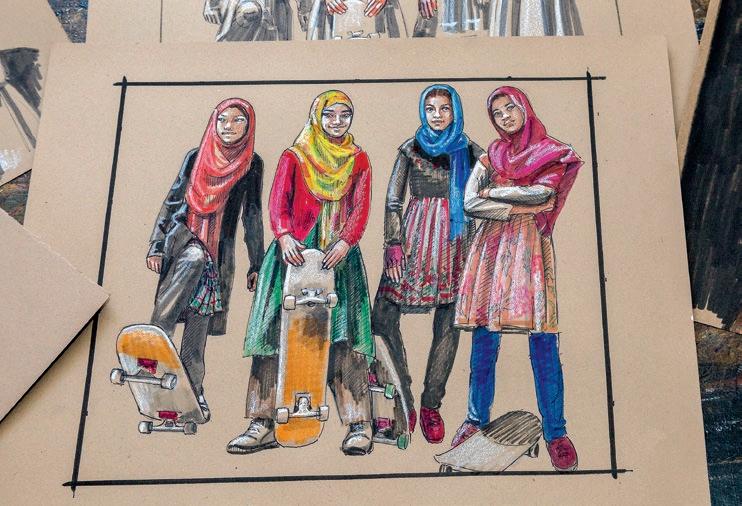
us; in her world, we’re not defined by our differences but rather by what we have in common.
Currier has been drawing since before she could walk or talk, and her long experience brings an easy confidence to her work that mirrors that of her subjects. Her glowing portraits come alive with vibrant, jewel-toned colors, giving the works a celebratory quality that radiates joy and fellowship. In an age where people are often unable to bridge religious and political differences through reasoned discourse, art’s transcendent appeal can serve as the glue that binds us. Currier shows us how that works, emphasizing beauty and harmony rather than anger and fear with her optimistic but clear-eyed take on the world around us. R
From the Summer 2017 isssue

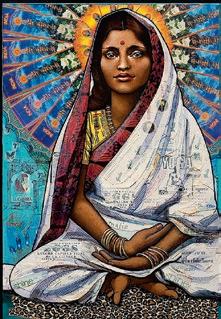

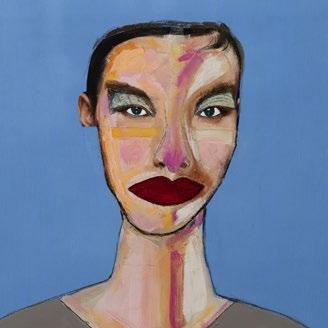




BY WESLEY PULKKA

Artist
Poets are able to imagine motion within stone walls or mountainsides. They understand liminal form—that which is on the verge of coming into being for the observer. Contemplative ceramic sculptor and educator James Marshall works at the edge of awareness to create elegant clay forms bathed in luscious monochrome glazes that speak to the viewer’s inner being. His long-running Liminal Objects series is the result of years of experience in the arts and, more importantly for Marshall, his time spent hiking, snowshoeing, and skiing.
“The nature of the mountains is a real foundational part of my life. There’s a presence that mountains have—that quietness and solid stillness—that is a an large part of my work.”
His sculpture echoes wave forms, rock cliff edges, rolling foothills, and the things we see that are not quite in focus nor identifiable, amorphous shapes that might be ships at sea or trees along the shore or a mountain lion fashioned of logs and stone.
Marshall’s home and workshop on the far west side of Santa Fe are located along an unpaved road that snakes out toward open country. Filled with pieces both finished and in progress, his cluttered studio houses clay, powdered glazes, a large electric kiln, work tables, hand tools, and lots of shelves.
Like Henri Matisse, Marshall first studied law before turning to art. Then he took a crafts class in his senior year as an undergraduate. “It wasn’t even a fine arts course, but I tried working with clay, and that was it,” he says. “It was like waking up from a dream. I’m not exaggerating—it was profound.”
After that, Marshall went into the Peace Corps in Guatemala, where he wound up becoming a potter’s apprentice, throwing bowls for five months and working eight hours a day. He followed this experience with graduate school at the University of Michigan School of Art, where he earned an MFA and began work as an independent artist.



By the early 1990s, Marshall was showing at the Sena Galleries in Santa Fe, where he exhibited mythically inspired wood and mixed-media sculptures. It all ground to a halt in 1993.
“I was living a very one-dimensional life at that point,” he explains. “I spent every waking hour building sculpture, looking for places to show, and in general pushing myself to be successful. I finally went broke and quit the art scene.”
For the next eight years he ran a successful design studio where he completed and sold more than 130 functional objects and pieces of furniture in wood, steel, and brass. “Once I let go, I finally was making a living, and for the first time in 20 years I took vacations, went skiing, walked in the woods, had money in the bank, and had girlfriends. It was great,” he says.
In 1999 he was offered a job as lead instructor in the ceramics department at Santa Fe Community College, where he still teaches ceramics, drawing, studio practice, and three-dimensional design. “It was fun working with these high-energy students who also loved clay—but I didn’t jump right back into making art again.”
Two dreams inspired his return to the studio. “I was visiting a gallery full of really bland ceramic sculpture. As I turned to leave in disgust, I realized that I was holding a large ball of
wet clay. In the second dream, I visited a show that turned out to be my work. In the center of the gallery was a four-foot-tall stylized vessel that looked like a plastic detergent bottle. It was covered with a bubblegum-pink glaze.”
Until then, Marshall had never worked with bright colors nor taken interest in industrial shapes. “I decided to let those dreams guide me, and it has turned out to be a very good decision.”
In his artist statement for the 2008 Liminal Objects solo show at Winterowd Fine Art in Santa Fe, Marshall writes: “My desire as an artist is to create beautiful objects that are a colorful presence. The essence of this work, then, is really color and light and how color and light of a form radiates into the life. What motivates me is the question: When does an ordinary object move into other dimensions? It is this ‘unidentified’ dimension of a form that intrigues me the most . . .. There is a deep beauty that resides inside of the indeterminate, the saturated Chroma, the light that radiates out into the life. A life where everything is what it is and nothing is what it seems. Where color, energy, light, and form merge into one. That is where I do my work.” R
From the Spring/Summer 2011 isssue
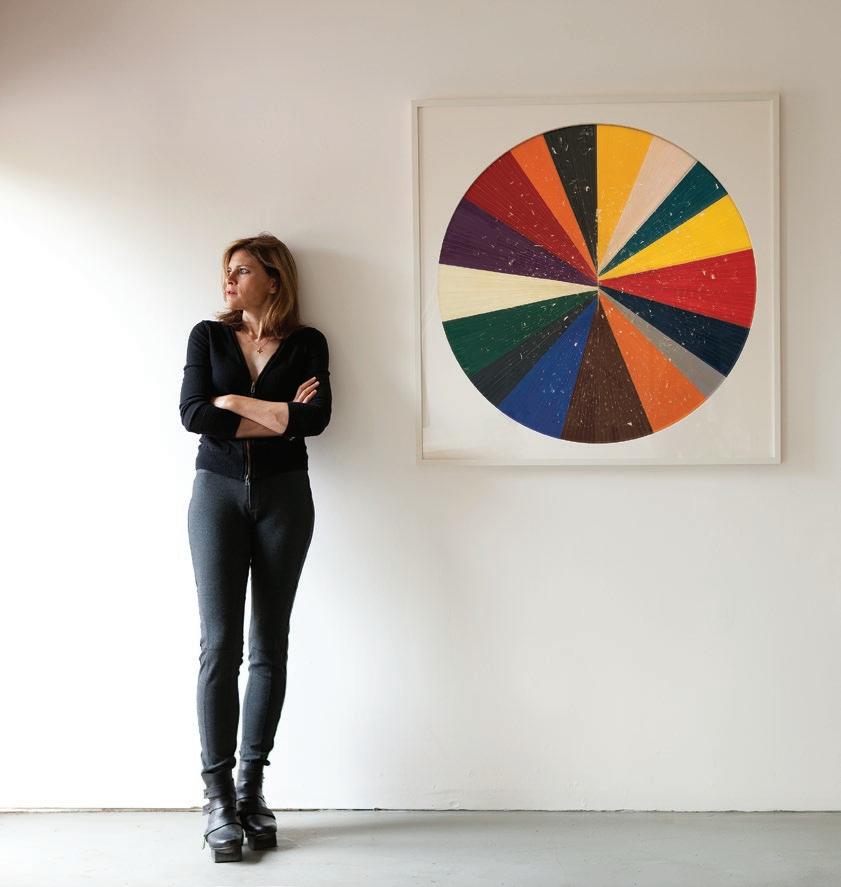
Tasha Ostrander’s meditative process turns artist into magician

al • che • my —any magical power or process of transmuting a common substance, usually of little value, into a substance of great value.
Rhythmic, melodic, and harmonious structures from the simplest of materials and methods belie Tasha Ostrander’s process-oriented constructions of paper, pigment, and varnish. They reflect transformation of the inner self and the shimmering fractals of nature—spatial magnitude, if you will, an extension of the spirit and body in several dimensions of space. Like a paper wasp chewing organic materials into pulp and constructing a complex geometric nest, Ostrander’s art is a daily practice that embraces and encompasses repetitive acts, discipline, the tedium of creating large tondos, mandala forms from small slivers of paper. A bigger reality emerges—that of balance between the spiritual and material worlds.
Describing the work of Joseph Beuys and the Arte Povera group, architect Peter Zumthor said, “What impresses me is the precise and sensuous way they use materials. It seems anchored in an ancient, elemental knowledge about man’s use of materials, and at the same time to expose the very essence of these materials, which is beyond all culturally conveyed meaning.” That describes Ostrander’s work to a T.
Her love of alchemy began at age 16, during a six-month darkroom apprenticeship with photographer Walter Chappell. Her fascination with photography took to the dark side, the red-lit room where the alchemy of printing, versus taking photos, developed.
“It was much more about the subtle nuance of chemical proportions, temperature variation, friction upon the emulsion, or the time the print sat in the developer tray to intensify contrast in the tonal range,” she explains. “I went on to study photography for many years, but felt more in love with camera equipment itself than the pictures taken with it. Looking back on this detachment, I realize it was the process and not the result that captured my attention. Alchemy and transformation of material would enter my subconscious, and I would use those basic concepts to learn to extract both wonder and healing from the idea that life force and material can be transformed into a higher statements of expression and environment.”
Ostrander went on to study at the Maine Photographic Workshops residency program in Rockport, eventually receiving her BFA from the University of New Mexico, where she also studied multimedia installation under Steve Barry. He encouraged Ostrander to use whatever material she wanted, to explore

“thing making.” In 1984-85 she printed images for the noted filmmaker and photographer Willard Van Dyke for his retrospective at the New Mexico Museum of Art in Santa Fe.
In 1994 Ostrander had her first solo show, Chorus, at Linda Durham Contemporary Art in Santa Fe, and her first group show, The Inner Mounting Flame, at Charlotte Jackson Fine Art. Through the 1990s until now, she has had solo and group shows at galleries including James Kelly Contemporary, SITE Santa Fe, Turner Carroll, the New Mexico Museum of Art


in Santa Fe, as well as at Galerie Nine in Amsterdam and I-20 Gallery in New York. Commitment, process, and practice have been important aspects of her work, and during the last decade and a half Ostrander has produced very large installations in which alchemy and transformation of material are front and center. “I would use those basic concepts to learn to extract both wonder and healing from the idea that life force and material can be transformed into a higher statement of expression and environment,” she says. “Also, as in alchemy, there is a constant shift in the perception of micro- and macrocosms. In the spiritual sense, this gives great credence and power to the ability to observe that which is base and simple, and to be able to reinterpret these things into large lessons or large environmental transformations. An example of this thinking would be the idea that through a commitment of time and the willingness to repeat the same action over and over, a beautiful pattern could be revealed, and in turn becomes a symbolic manifestation of wholeness.”
At one time Ostrander also studied Japanese porcelain, throwing what she says were hundreds of bowls. “The glazing and firing were of little interest, as I had no interest in the bowls themselves,” she recalls. “But the pure challenge of dealing with a material that has little forgiveness in terms of cracking and breaking, and the delicacy of the traditional forms, required a lot of concentration and physical balance. Again, the process informs
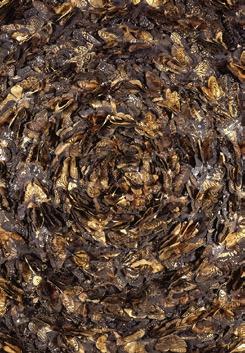
more of a personal composure, and it is not the end-objects that make the experience valuable.”
A magnificent and telling work that exemplifies the spatial magnitude of her practice is a 10-foot-diameter tondo covered with 26,645 handmade paper butterflies, constructed of photocopied butterfly images from old field manuals, representing the 26,645 days of an average human life. Her current work takes the mandala form to a reflective, calm state, empty of content and entered through the process of working with the material.
“These pieces are meant to have integral beauty, and to be what they are without added explanation,” she says. “All of the ideas mentioned above live through this new work, but this time I do feel attached to the end result as objects. They are made to bestow a sense of calmness and centeredness to the environments in which they are placed. In these pieces are many of the concepts of the Japanese philosophy wabi-sabi —simplicity, economy, austerity, intimacy, and appreciation of the ingenious integrity of natural objects and processes.” Art that truly reflects the artist who lives her art. R
From the Fall 2011 / Winter 2012 issue













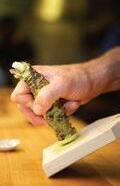















Native American chefs create a healthier future by reclaiming the past

BY NANCY ZIMMERMAN | PHOTOS BY LOIS ELLEN
Eating is not only a physical act based on biological necessity, it’s an expression of cultural identity rooted in geography and ancestry, with far-reaching effects on health as well as on a given society’s worldviews and self-definitions. How food is acquired, prepared, and presented informs gender roles, social structures, family relations, rituals, and spiritual beliefs, and it underlies humankind’s earliest artistic endeavors, from crafting baskets and pottery to store and cook food to creating cave and rock art depicting hunting and farming scenes. In Native America, a growing movement to revive traditional cuisines of centuries past addresses issues of health and well-being and, in the process, reclaims a vital cultural heritage.
This movement has been spurred in part by crisis. Throughout the United States, type 2 diabetes has reached epidemic proportions, and Native American communities have been especially hard hit. Related illnesses like obesity, high blood pressure, and heart disease are at alarming rates as well. And while everyone from healthcare professionals to researchers to desperate dieters struggles to find a solution to these growing health threats, a dedicated cadre of Native American chefs, scholars, and educators are working to forge a new path to wellness and cultural continuity via the ancient foodstuffs and dietary practices that may be in danger of being forgotten.
One of the first to recognize the importance of Native cuisine as a cultural force was Loretta Barrett Oden, a Potawatomi chef and food historian from Oklahoma who is revered as a leader in the movement to return to a Native diet. In 1993 she and her son, Clayton Oden, opened the highly acclaimed Corn Dance Café in Santa Fe, the first upscale restaurant to
offer indigenous foods to sophisticated diners. “My absolute, all-consuming passion is the relationship between food and culture,” she says. “There’s no way to separate one from the other.” Oden spread the word via her cooking show, Seasoned With Spirit, which ran on PBS between 2005 and 2007, as well as through appearances on Good Morning America and The Today Show, among others, and she continues to serve as a consultant on a variety of food-related projects.
Taking the movement to the next level is Santa Fe–based Lois Ellen Frank, PhD, a renowned chef and culinary anthropologist of Kiowa-Sephardic ancestry, who is also an educator, author, food historian, and photographer. Frank has made the revival of traditional foodways her life’s work, and her results so far have been impressive and encouraging.
“Returning to an ancestral, plant-based diet is a way to reclaim our health,” she says. “And when traditional foods are revitalized, all of the cultural traditions associated with them are also revitalized—the songs that go with the planting, the sustainable agricultural techniques that each tribe uses, traditional knowledge of how to harvest wild foods, the foods that have medicinal qualities, the language, the stories, the baskets, everything.”
Frank is the chef/owner of Red Mesa Cuisine, a catering company whose mission is to bring Native American cuisine into today’s kitchen and to promote traditional foods, agricultural practices, and cooking techniques from throughout the Americas. She brings a contemporary flair to ancient recipes while promoting heirloom agriculture and introducing exciting “new” products to receptive diners. Along with Diné chef Walter Whitewater, who has done turns in the kitchens of such Santa Fe landmarks as Mu Du Noodles,

Bishop’s Lodge, and the late but fondly remembered Café Escalera, she prepares meals for a varied clientele.
Whitewater grew up in Pinon, Arizona, outside of Chinle, and he credits his grandmother with teaching him about the traditional foods and imbuing in him a reverence for the sustaining gifts of the land. “I remember the foods my grandmother used to make,” he says, “and the prayers she taught me, the songs that go with the food. Food is our medicine. When we take an animal or a plant for our own use, we make offerings. And we don’t take everything—we must always leave something for others. We need to go back to what we’ve been taught by the elders, and not get lost in the Western way. It’s our seeds that will be our survival, not our money.”


The traditional Southwest diet Whitewater’s grandmother taught him about was based on the Three Sisters: corn, beans, and squash. These symbiotic foods thrived in particular when planted together, and they provided nutritional balance through their well-proportioned mix of fiber and protein. Cactus fruits and game animals supplemented this fare, which was further expanded when the Spanish arrived and introduced sheep along with their own food products. Elsewhere in North America, Native populations enjoyed varied cuisines based on local bounty: salmon, berries, and herbs in parts of the Pacific Northwest; wild rice and corn in
the upper Midwest; buffalo and grouse in the Great Plains; cranberries and turkey in the Northeast.
The forced relocation that sequestered tribes into reservations in the 18th and 19th centuries dealt a huge blow to Native food sovereignty and disrupted the chain of knowledge. Many of the healthy, natural foods that had sustained people for centuries were replaced by U.S. government–supplied commodities like flour, lard, and sugar. “It’s when food became commodified by European immigrants that it lost its intrinsic value,” Frank says.
Nephi Craig, executive chef of the fine-dining restaurant

“Returning to an ancestral, plant-based diet is a way to reclaim our health.”
—Lois Ellen Frank, author and culinary anthropologist

at his White Mountain Apache tribe’s Sunrise Park Resort Hotel near Greer, Arizona, refers to this unfortunate break with the past as the Great Interruption. “Precontact, we were expert farmers, hunters, gatherers, fishermen, and cooks,” he said in a recent interview with Indian Country Today Media Network. “Then we suffered a violent clash of cultures that lasted 500 years and ended in the reservation system and cheap, high-fat, high-carbohydrate commodity foods.”
Native American ingredients featuring wildharvested and cultivated foods. Opposite: Juanita and Maria Kavena (Hopi) from Polacca, Arizona, eating yellow and red piki bread (a paper-thin cornbread). Below: Abiquiú farm growing Native American ingredients and heirloom vegetables.
Ever resourceful, the people found new uses for these less nutritious commodities, creating dishes like fry bread and Indian tacos that have since become emblematic of pan-Indian cuisine. Native chefs tend to embrace their culinary history in its entirety, both the good and the bad, so even less-healthy options like fry bread are sometimes incorporated into the innovative new approaches to contemporary cuisine. “It’s part of history, after all,” says Frank, “and it’s delicious. But we often do it in healthier ways now, using whole-wheat flour or grilling the bread rather than deep-frying it.”
Gallup-based chef Freddie Bitsoie, a food historian with a background in cultural anthropology, believes that the move away from traditional food preparation actually pre-dated the
introduction of government commodity food, suggesting that it goes back to the trading-post era. “The trading post was the McDonald’s of its time,” he says.
“Instead of growing or hunting food, people started buying tinned food.”
Bitsoie sees the devaluation of Native foods as a product of colonization, and points out that its effects continue today.
“It’s a question of respect. Native cuisines have always been seen as inferior because the Native cultures themselves are seen as inferior,” he says. “People are willing to pay well for European cuisine, but nobody’s going to pay $50 for an Indian taco. Once when I worked at a culinary school, the chef objected to my paying $60 a pound for cholla buds, whose harvesting is quite labor-intensive, but he had no problem paying for French truffles, which cost $3,000 a pound.”
The issue of respect Bitsoie raises is key, and chefs throughout the Southwest are addressing it through a variety of educational initiatives, directed toward both Native Americans and the general public, which emphasize the wisdom of the ancient ways. Frank has created a curriculum for a required four-credit science course at the Institute of American Indian Arts (IAIA) in Santa Fe that includes a hands-on lab to teach students to
cook traditional foods. The course examines the cultural, ecological, and medicinal properties of Native foods and is offered each spring semester. “It provides a blueprint for living within an ecosystem rather than at odds with it, or at the expense of it—a practice that has sustained Native cultures for millennia,” she says.
She also teamed up with Santa Fe Public Schools’ Indian Education Program to create the Kids’ Cooking Camp, which teaches children about such topics as food history, what protein is, how calories are counted, and how food can be medicine. “We use kid-friendly ingredients to make fun dishes like a Native American parfait, a blue-corn pudding layered with a mixed-berry compote,” says Frank. “We also use a 72 percent dark chocolate for our snacks, and teach the students about natural dark chocolate, a cacao product that’s full of antioxidants and native to the Americas, rather than an overly sweetened chocolate. The kids love it!”
Frank’s other projects include a DVD and companion booklet, produced in conjunction with the Physicians Committee for Responsible Medicine based in Washington, D.C., that encourages Native peoples to return to an ancestral diet to combat diabetes, and she is the author and photographer of a popular cookbook, Foods of the Southwest Indian Nations, that received the James Beard Foundation Book Award in the Americana category. Whitewater, who was the first Native American chef to cook at the James Beard House in New York, worked with Frank as a culinary advisor to test and adapt the recipes in the book, which includes a detailed discussion of the history, ingredients, and cultural meanings of the food. The recipes showcase indigenous ingredients in ways that appeal to contemporary tastes in dishes like blue cornmeal and piñon hotcakes with prickly-pear syrup and peach honey, and spicy pinto bean ravioli with corn and chile cream sauce.
“It’s our seeds that will be our survival, not our money.”
—Diné chef Walter Whitewater


When artist Kathleen Wall was growing up in Jemez Pueblo, she enjoyed home-cooked meals made from real ingredients, far from the lure of drivethrough “restaurants” and prepackaged meals. “We didn’t have a lot of money,” she says, “so we didn’t buy processed food. We made our own meals from scratch.”
Years later, as a married mother of three living in Albuquerque, she found herself immersed in a fast-food culture that led to weight gain and, for her husband, diabetes. “He was truly addicted to sugary, high-starch foods,” she says, adding that her kids were also inclined to want sodas and fast foods. “Although I had never cared much for that kind of food myself since I wasn’t raised on it, I tended to give in to my husband’s cravings, bringing home boxes of sugary Froot Loops, his favorite breakfast, and not objecting when he ate at McDonald’s.”
His diabetes diagnosis forced Wall to rethink her food priorities, and she decided to move the family back to Jemez Pueblo, where they’d have less exposure to the temptations of the city and more control over their diets. “My husband is much better now,” she says, “and my kids don’t eat fast food or drink sugary sodas. It’s a healthier environment.”
Wall has tried to spread the word about healthy eating, but she has concluded that it’s better to remind people of the good things about a traditional Native diet rather than to harp on what’s bad about the current ways. “I know people get tired of hearing me go on and on about nutrition,” she says, “and I thought that it would be easier to get the message across using art.”
Thus was born Harvesting Traditions, an exhibition at Santa Fe’s Pablita Velarde Museum of Indian Women in the Arts, running through January 4, 2015, which celebrates Native foods. Working with co-curators Marita Hinds and Martha Becktell, Wall fashioned a show of ceramic clay figures in traditional garb and paired them with paintings relating to indigenous foodways that show the kinds of foods, utensils, and cultural manifestations that made for a healthy lifestyle. A series of live presentations, the Noonday Dialogues, held on the third Thursday of each month, initiates conversations about how food was gathered and prepared and its relevance to the present. —N.Z.
Frank also teaches classes for the general public at the Santa Fe School of Cooking, and travels extensively, along with Whitewater, to offer demonstrations and lectures at museums and organizations. Even her Red Mesa Cuisine catering company uses an educational approach. “We always bring the story in,” she says. “We’re not an ordinary catering company.” Adds Whitewater, who tends a flock of 15 churro sheep on the Navajo reservation when he’s not at the stove, “We like to do a presentation that includes a blessing to start the meal and a song at the end, and we explain about the foods and what they mean to the culture.”
One of Frank’s newest projects is a cookbook that includes information about sourcing local foods that stresses the concept of terroir, the French term for the natural growing environment and its influence on a plant’s flavor. “I like to include all of the ‘scapes,’” she says. “It’s important not only to appreciate the landscape but also to listen to the soundscape, the noises made by the plants and animals, and let your body be in the moment so you’re aware of your own bodyscape and mindscape. The foodscape is thus embodied in the food that you eat. It’s a way of becoming more mindful about your food, and about life in general.”

Bitsoie, too, has his own catering company, FJ Bits Concepts, and, like Frank, has appeared at events and institutions around the country, among them Kraft Foods, the Heard Museum, and Yale University, to promote a healthy, traditional diet brought up to date with modern flourishes. His creations include such dishes as Navajo herb-rubbed roasted lamb, blue corncakes, and pumpkin bread pudding, and he uses traditional ingredients like tepary beans, acorn squash, corn, and cholla buds. He won the Native Chef Competition at the Smithsonian National Museum of the American Indian in 2013 and is currently working on a pilot for a television cooking show, Rezervations Not Required, that he hopes will get picked up by a national network.
Native cooking generally is attracting attention and carving out a place for itself in the larger world of contemporary cuisine. The popular Desert Rain Café in Sells, Arizona, about 60 miles southwest of Tucson, celebrates traditional Tohono O’odham foods that have sustained these people for countless generations. According to consulting chef Mary Paganelli Votto, each dish on the menu contains at least one traditional ingredient, such as cholla buds, tepary beans, or saguaro fruit syrup,
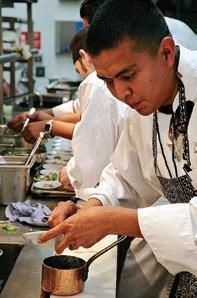
which are brought together in tasty dishes like prickly pear–glazed pork ribs, or cholla bud citrus salad with jicama, fresh spinach, and pineapple. The café is a project of Tohono O’odham Community Action, a nonprofit that is dedicated to creating a healthy, culturally vital, and sustainable community on the Tohono O’odham Nation.
Another hot spot in Provo, Utah, is the familyowned Black Sheep Café, a neighborhood café during the day and a fine-dining restaurant in the evening, where Diné chef Mark Mason serves up an imaginative mix of Navajo-, Pueblo-, and Hopi-influenced creations. His signature dishes include appetizers like spicy chicken wings served with creamy cotija-chipotle-lime dressing, and an entrée of braised beef short ribs in a Cabernetguajillo mole sauce, served over yellow-corn polenta enlivened with lime zest and mascarpone.
Designed as an authentic representation of the Gila River Indian Community’s heritage and culture, the Sheraton Wild Horse Pass Resort and Spa in Phoenix features a fine-dining restaurant, Kai, that uses locally farmed ingredients and heirloom products. Its menu includes entrees like grilled tenderloin of buffalo accompanied by smoked-corn puree, cholla buds, and scarlet runner-bean chili with saguaro-blossom syrup.
Amaya at Hotel Santa Fe, the city’s only Native American–owned lodging, features a seasonally changing menu of fresh ingredients and traditional regional foods from around the country that highlights local Pueblo and Northern New Mexico influences.
The Native food movement continues to gather steam, fueled by the passion of its proponents and their congenial camaraderie, which fosters cooperative efforts to reach out to ever-larger constituencies. This outreach has effects beyond the immediate community—it benefits the population as a whole, many of whose members suffer from the same diet-induced ailments as the Native Americans. As healthy traditional fare joins forces with haute cuisine, it becomes more than just the fad du jour the movement is going mainstream.
Times and tastes may change but ancient wisdom endures, offering us fresh opportunities to heal ourselves and find common ground through our shared human need: nourishing, satisfying food. R
From the Fall 2015 issue

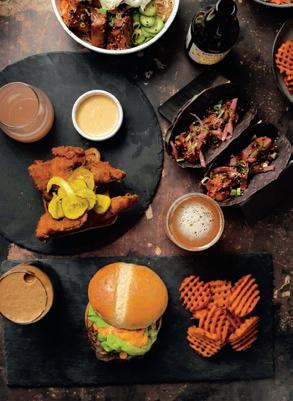


There were so many things I didn’t expect when I moved 1,100 miles southeast from San Francisco to the Southwest. I didn’t expect that I’d learn how to grow a garden in the desert. I didn’t expect that six years into my experience, I’d have six chickens and a stretch limo of a daschund-chihuahua mix known as a chiweenie. I never anticipated that I’d be on a first name basis with most of the farmers and ranchers from whom I get groceries on my weekly pilgrimage to the farmers’ market.

TEXT AND PHOTOS BY GABRIELLA MARKS
I certainly didn’t expect that nestled in the ancient badlands of Chimayó I would be learning about classic European defensive architecture, discovering our natural tendency to form communities, and witnessing the emergence of new traditions that echo and celebrate old ones.
New Mexico is known for blindingly blue skies, mountain horizons, and visibility clear to Colorado—it’s utterly breathtaking how far you can see in this land. And yet the landscape shelters mysteries—hidden and notoriously private communities beyond the main highways that take patience, curiosity, and a GPS to discover. To drink from the well-worn metaphor of the spring in the desert, you’d be amazed at some of the oases concealed behind scraggly coyote fences down rambling washboard dirt roads.
On your first visit to Rancho Manzana, the dramatic mesas of the Chimayó badlands give little hint as to the fertile fields and lush orchards of the property. The contrast is breathtaking: Just three minutes from the parched pink cliffs that border the Juan Medina highway, you’re suddenly surrounded by tranquil green.
Jody Kent-Apple purchased Rancho Manzana from the renowned Ortega rug-weaving family more than 20 years ago and she has painstakingly restored the fields and the buildings, which occupy the southern boundary of the historic Chimayó Plaza del Cerro. Dating from the early Spanish settlers of the 1700s, the Plaza was essentially a town square—an area of land bordered by a connected series of buildings—that served as residence, social space, farming land, and defensive protection for the families that lived there.
Today, Rancho Manzana is a bed and breakfast surrounded by orchards, birdsong, and fertile fields sown for harvest. A few years ago Brett Ellison and Alexis Elton, inspired by their experience working with nearby Gemini Farms, joined Kent-Apple at Rancho Manzana to revive the agricultural heritage of the Plaza. The couple are a new breed of farmers, members of a movement that has been gaining momentum for years, based on small-scale, sustainable farming practices.
But Ellison and Elton take “back to the land” much further forward. Their philosophy is not just about seeds and soil, about getting dirty and growing good food. It is also an aesthetic approach, a romantic vision of a certain way of being. You can see it in the old Plaza post office now converted to an art studio where Elton, a graduate of the the Art Institute of Chicago, builds organic sculptures.
Their Aliss-Chalmers tractor in Technicolor orange is the most iconic symbol of their unique way of doing things. From 1914 to the early 1980s, the name AlissChalmers was synonymous with farming tractors. Today they are the very definition of old school: Instead of the lumbering combine behemoths of industrial farming, they are human-sized, with all moving parts accessible and exposed to make them easy to repair by the mechanically inclined. They’d look perfectly at home in front of an antique store, yet they are fully functional, useful, and in high demand these days for small farms like Rancho Manzana. Ellison’s love for the Aliss-Chalmers extends beyond the simple satisfaction of using a perfectly good tool. He wants to move away from reliance on fossil fuels and convert the tractor to a new kind of hybrid, fitting it with a solar battery that will both drive the engine and provide a mobile power source for other tools on remote areas of the farm.
The return to antique tools and methods brings another, richer component back to working the land: the need for, and celebration of, working together. As Ellison puts it, you simply can’t do it alone. There are times in the farming calendar when you need your neighbors and friends to help out on the big jobs—tilling the fields, sowing the seeds, reaping the harvest. According to Ellison, working together—for instance, when the Channing brothers and their team of mules from Gemini Farms helped him plant this season’s potatoes—is not only a more fulfilling way to get things done, it is often the only way to accomplish all of the tasks that bring produce to market.
Community is also the primary motivation at the heart of Elton and Ellison’s plans to begin a dinner series this summer at Rancho Manzana. For their version of Farm to Table, they are expanding the “kitchen garden” to grow a bounty of produce—a greater variety of vegetables and herbs than the crops they bring to market—in order to create and host locally-sourced dinner evenings at the Rancho.
“We’re looking to form a new bond in the customer-to-grower dialogue.” says Elton. “These dinners will be an intimate space for educating and supporting one another, farmer to mouth. Through this we would like to think that we are creating awareness of what
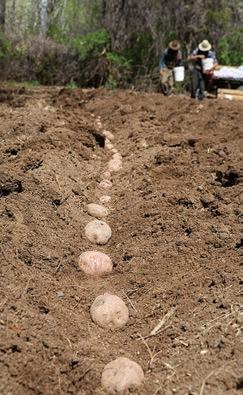

Farming teaches us that out of little, comes much: Each of these potato “seeds,” neatly planted in long rows, will yield many offspring, and the garlic plantings will eventually produce nearly seven different varieties. Another lesson learned: Farming is 90 percent fixing things. Reuse and recycle is the name of the game, and it’s amazing how, with a little maintenance and care, even old farm gear does the job as well as new. The human element is just as important. Assistance from friends and neighbors is always appreciated, as is the hard work of mule team Jack and Jill.
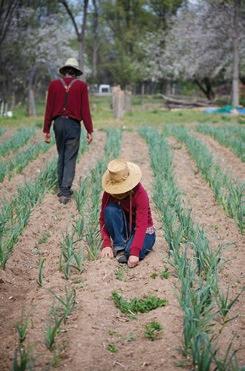


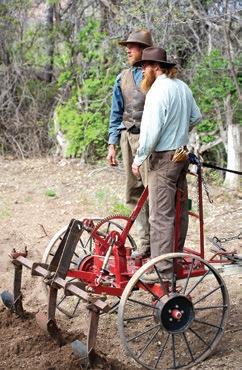




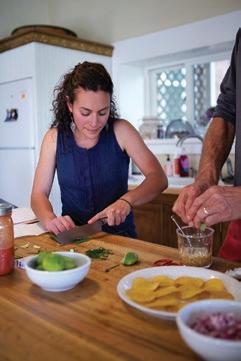





Traditions both old and new are indelibly woven into the fabric of daily life at Rancho Manzana. Irrigation is provided via New Mexico’s time-honored community-operated acequia system, and tractor work on a vintage Aliss-Chalmers proves that everything old can be new again.

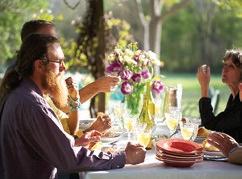

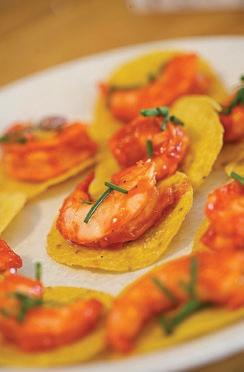

it means to support local agriculture.”
Given her background in art, Elton also wants these evenings to appeal to all of the senses, to the eyes as well as to the palate, and therefore will include art exhibits as part of the event. It’s a compelling idea, to bring people together to enjoy good food and each other, to experience first-hand the land their food comes from, to taste delicious recipes made from just-picked produce, and to appreciate artwork inspired by the land.
Such evenings took place in the Plaza centuries ago. No doubt Ellison and Elton are growing more than the corn and chile that were the predominant crops in bygone days—and the art is more abstract than the rugs the Ortegas wove there for generations—but given that the spirit is the same, generations of Plaza residents would feel right at home tonight at Rancho Manzana. R
From the Summer 2012 isssue




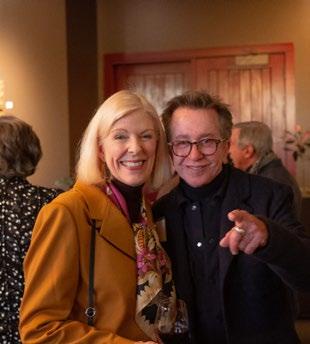






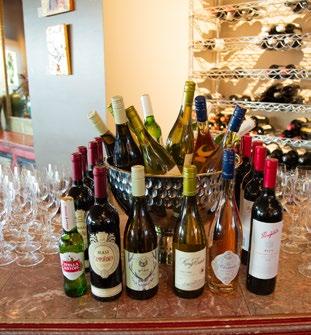






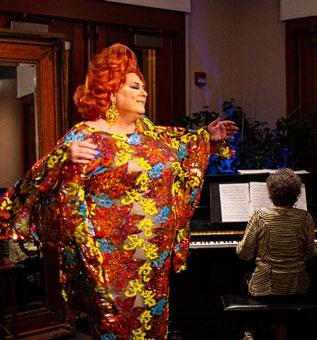


Serving what we consider comfort food: simple food done well
The pictures tell the story.
Whether it’s lunch Tuesday thru Friday or brunch/lunch Saturday and Sunday, we have your afternoons covered.
Museum Hill Cafe, 100 miles of views
One of the largest covered patios
We have a darn good wine and beer list. Plenty of free parking.
Tuesday thr ough Sunday 11-3
Reservations suggested 505-984-8900
We reserve our evenings for your private parties.

Dee and Bernie Rusanowski have been in the restaurant business for over 50 years.
Among the accolades they’ve earned for a half-century of delicious food and outstanding hospitality are two certificates from the State of New Mexico recognizing their achievements. And Dee is adamant that as long as they have their health, Saveur, their Europeaninfluenced bistro, will be serving from-scratch and often organic meals just as it has since 2003.
With Saveur, their second Santa Fe restaurant, the couple returned to cooking and caring for the community they love after eight years of “retirement.” They’d run Dee’s Restaurant from 1976 to 1998, becoming famous for their from-scratch donuts and having introduced the handheld breakfast burrito to diners on the go.
Bernie helms the Saveur kitchen, while Dee handles customer service, dispensing her trademark hospitality as she greets patrons like old friends. “The most special thing is the people I’ve met. I’ve been blessed with taking care of them, their kids and grandkids for 50 years,” she says.


ERIN WADE DOESN’T LOOK LIKE A FARMER. Or like someone who parlayed a certain penchant for digging in the dirt into a concept restaurant, even if that restaurant happens to be the casually chic salad bistro Vinaigrette. With her long tumble of sun-streaked hair, tawny eyes, and petite frame clothed in T-shirt, skinny jeans, and boho sandals, the early-30-something Wade instead has a decidedly urban Cool Girl vibe, less soil-science geek and more, say, lifestyle or fashion blogger.
But Wade’s entrepreneurial spirit runs deeper than the surface of a computer screen flashing pretty pictures. It goes all the way down into the land she has cultivated for the past eight years, and from which she drew knowledge for a healthier, more positive way to nurture people. In many ways, Vinaigrette is Wade’s remedy for a world that—despite all the ballyhoo about sustainability and eco-responsibility—still has issues with food. She’s spreading that remedy. By late this fall, Wade will expand her ambitions beyond the boundaries of the Land of Enchantment.
Not that it didn’t take time to discover
this calling. After receiving her undergraduate degree in English from Harvard, the Bellingham, Washington, native spent a year in Milan studying fashion design, with the promise of a job at Harper’s Bazaar waiting back in the States. But in the second of what she calls a “gestaltshifting” moment of clarity (the first had been to ditch pre-med studies at Harvard in favor of a liberal-arts education) Wade realized that fashion was not her destiny. So she did what many bright and ambitious young people have done when struggling with the pressure to figure it all out by the time they hit 30. She went back to the land.
“I had been living in cities, and feeling like a fish out of water, for five years,” she says. “My childhood had been about running around in the woods, being outside. I missed space and quiet and the beauty of a more natural landscape.”
What she calls her initial “vague, nagging craving” soon turned into an action plan. A vacant ten-acre parcel of familyowned land in Nambé, complete with an old adobe home, outbuildings, and three acres of water rights, was hers for the ask-
ing. “I realized that what I really wanted was to get my hands in the dirt,” she says. “My mom made me read Wendell Berry when I was about ten, I think. There’s a legacy of environmental stewardship in my family that started with my mom’s dad. So in a sense, a commitment to taking care of the land is in my blood.”
Wade’s goal was to return her family’s property to its agricultural roots and farm it organically in high-yield crops like salad greens, arugula, kale, mint, parsley, cilantro, and scallions. To learn the art and science of farming, she drew on her background in science, math, and the environment. (Her original pre-med major had been environmental science and public policy.) She also read books on soil science and agro-ecology, including organic farmer Eliot Coleman’s classic
Its airy, light-filled atmosphere makes Albuquerque Vinaigrette a regular stop for visitors to nearby Old Town as well as locals working and living in downtown and its surrounding neighborhoods. Preceding page: Wade wearing her trademark red boots, working a section of the farm that includes tomato and lettuce beds interspersed with volunteer sunflowers. “Diversity is our main method of pest control,” she says.
how-tos. Then she just got out there and started doing it.
“I rehabilitated the soil first,” she explains. “We have really delicate, fragile soils in New Mexico in general, and people are always talking about what a bummer it can be to grow food here. And it can be. But you can also take a piece of degraded land and make it better, leave it more diverse. The feeling of having improved that property from a biological and ecological standpoint is something I’m really proud of.”
Originally, Wade had also planned to convert several of the outbuildings into agri-tourism vacation rentals. Then another concept emerged. “I was hugely, life changingly inspired by my time in Italy, but in ways that had nothing to do with fashion,” she says. “Italians just don’t have the baggage about food that we Americans do. They don’t feel guilt about the pleasure of eating, and they don’t separate it from health.”
Raised in a foodie household, Wade instinctively knew this—but Harvard had shocked her system. “The food was so unbelievably shitty,” she says, laughing. “I think I ate cereal with frozen yogurt the entire time.” Another thing she noticed: her contemporaries either starved themselves or overindulged, a theme reflected in American culture at large. “We equate health with deprivation,” she continues. “No wonder our appetites are so big— people always talk about the supply side, but what about the demand?”
Wade wanted to help change this yo-yo dynamic. She already had the means growing on her farm, but it wasn’t until she drove by a vacant building in Pojoaque that she thought about opening a restaurant.“I thought to myself, ‘I could have a little salad shack there.’ There’s infinite creativity with salads. They’re the perfect vessel for this idea that eating healthy should be easy and not a deprivation.”
Ultimately, she decided that Santa Fe
would be better suited to her concept, and in 2008 she opened the first Vinaigrette, in a historic adobe on Don Cubero Alley, just off Cerrillos Road in Santa Fe.
Although she was untrained as a chef, or in the restaurant industry as a whole, Wade had faith in the menu she developed from a mix of family recipes and her own instinctive palate. “We don’t serve what you’d normally think of as a salad,” she says. “I’m thinking about the flavor balance and the texture and the perfect amount of acid and salt and the little bit of creaminess and the crunch. All those different aspects that any chef is thinking about when making a sauce
Located next to Santa Fe Vinaigrette, Modern General was conceived by Wade as a store/café hybrid, where you can pick up a juice or breakfast sandwich and peruse the selection of books, garden tools, and household items. Offering free WiFi and ample seating, Modern General has also become a popular hangout, where people can gather at either the community table or at the counter, with its Piet Hein Eek up-cycled scrap wood bar stools and vintage 1930s factory lights.




or dish. We put a lot of time into the architecture of a perfect bite.”
Part of that bite can also include meat. “I think there’s a sustainable, respectful way to eat and source meat,” comments Wade, “but the proper portion size has been blown all out of proportion. “We [at Vinaigrette] make salad the center of the plate not the meat.” Carnivores can add their choice of lemon-herb chicken breast, grilled flank steak, grilled pork tenderloin, or duck confit to any of two-dozen salad offerings, many with clever names like The Beet Goes On, The Nutty Pear-Fessor, or All Kale Caesar.
Like the farm, Vinaigrette also operates as a sustainable system: all organic waste produced by the restaurant is composted and fed back into the soil, which grows the produce that feeds customers. But while
the farm-to-table ethos is central to her vision for Vinaigrette, Wade also urges a more nuanced understanding of the meaning of terms like sustainability and organic—often misinterpreted. “People want every last shred of everything to come from [the farm], but I have a responsibility to my land as well. I can only push it so far.” As such, roughly 70 percent of Vinaigrette’s produce comes from the farm. The rest she sources from farmowned brokerages like Albuquerque’s Agri-Cultura Network. Neither is she certified organic, which is nothing more than a stamp of approval from the USDA. She does, however, grow organically, using compost instead of chemical fertilizers, employing companion plantings instead of pesticides, and undertaking extensive soil and water conservation methods.
Her mission clearly resonates with diners, and not just in Santa Fe. Since it opened in 2012 on Central Avenue in the Country Club neighborhood, Albuquerque Vinaigrette does a thriving business. This past February Wade debuted her take on a modern-day general store next door to her restaurant in Santa Fe. Part hardware store, part grocery, part breakfast cafe, Modern General is an airy space filled with carefully curated items ranging from gardening books and supplies to kitchen items and locally produced food stuffs.
Late this fall Wade will also open a third Vinaigrette—this one in Austin, Texas—for which she is purchasing a ten-acre farm. “I’m not interested in expanding beyond our quirkiness,” she comments, “but my intention was always
that Vinaigrette would be a concept, with multiple locations. I believe in what we’re doing . . . that this way of eating is relevant and powerful. Why Austin?
“I want to go where we’re needed,” she explains. “I had looked at California and obviously the concept is a great fit, but it’s very much done there. Plus, I had a lot of customers come in and tell me, ‘This would be great in Austin.’ You start to listen, you know? With Austin, you have this teeming economy and locus of activity, but you also have this astonishing paucity of healthy places to eat.”
For now, the Austin location will follow the Santa Fe and Albuquerque blueprint: same menu, with different interior design. It will also be an important spoke in the wheel of Wade’s overall mission. “All businesses are modeled after the military, but I’m really interested in how we can be competitive and collaborative in the way that nature is—like an ecosystem. I think it involves the multiple concepts working together and based around a farm. That’s the next wave for me. That’s what I’m most excited about right now.” R


Santa Fe’s beloved resale store selling gently used kitchenware to benefit Kitchen Angels home-delivered meal program.
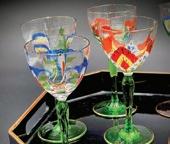
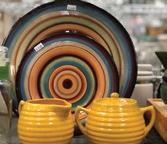



Providing meals to Santa Feans living with chronic illness.
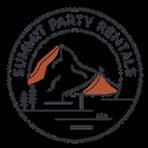


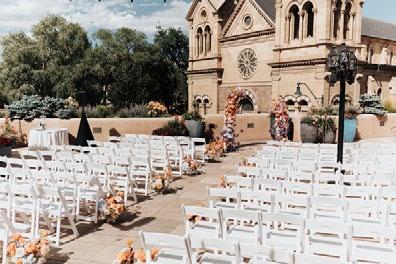


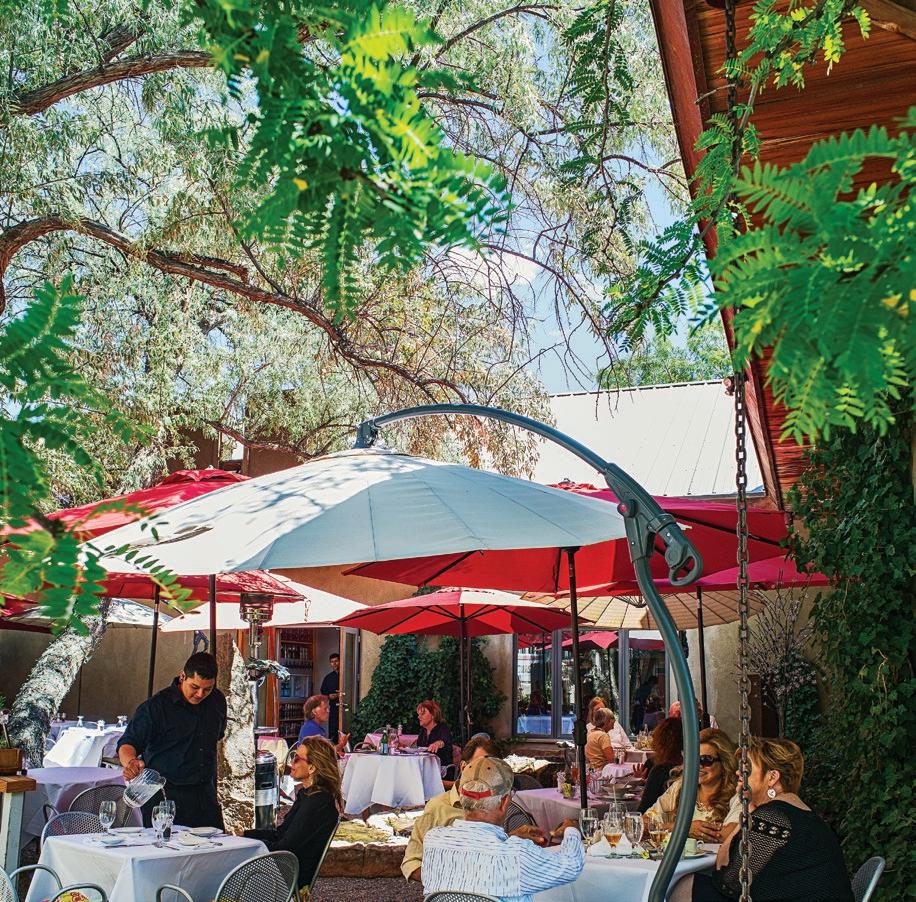


ANTIQUES, HOME FURNISHINGS, RUGS & ACCENTS
Bon Marché bonmarcheonline.com; 505-995-1000.................................45
Bosshard Gallery
505-685-0061....................................................................179
The Collective thecollectivesantafe.com; 505-230-7000..........................8–9
Jennifer Ashton Interiors jenniferashtoninteriors.com; 505-913-0104.......................132
Mistletoe by Clemens & Associates Inc.
505-983-0130....................................................................345
Moss Outdoor mossoutdoor.com; 505-989-7300.....................................127
Red Arrow Emporium Inc.
575-758-0540....................................................................150
The Rugman of Santa Fe therugmanofsantafe.com; 505-988-2393............................19
Santa Fe Fine Consignment 505-983-0145....................................................................344
Santa Kilim santakilim.com; 505-986-0340..................................340–341
Victoria at Home victoriaathome.com; 505-365-2687..........................346–347
Xanadu xanadusantafe.com; 505-982-1001..........................342–343
ARCHITECTS & DESIGNERS
Annie O’Carroll Interior Design annieocarroll.com; 505-983-7055..............................346–347
Archaeo Architects archaeoarchitects.com; 505-820-7200.....................346–347
Beautiful Spaces for All / Sondra Allison 864-986-8205....................................................................376
Clemens & Associates Inc. clemensandassociates.com; 505-983-0130......................345
Coronado Paint & Decorating Center coronadodecorating; 505-473-5333. 320–321
Hoopes + Associates Architects hoopesarchitects.com; 505-986-1010...............................286
Jennifer Ashton Interiors jenniferashtoninteriors.com; 505-913-0104.......................132
Lisa D. Martinez / B Constructive LLC mtzarchitecture.build; 505-470-7888.........................336–339
Martinez Architecture Studio martinezarch.com; 505-989-4958 336–339
Max Vasher Architect maxvasherarchitect.com; 505-615-0696..........................199 Palo Santo Designs palosantodesigns.com; 505-988-7230...............................289
Three Roots threerootsdesign.com; 505-699-5489..................................14
Tierra Concepts tierraconceptssantafe.com; 505-989-8484...............346–347
Victoria at Home victoriaathome.com; 505-365-2687..........................346–347
ARTISTS & GALLERIES
Acosta Strong Fine Art acostastrong.com; 505-982-2795.................................30–33
Alexander Brown Sculpture alexanderbrownsculpture.com; 505-466-8177.................375
Alexandra Eldridge alexandraeldrige.com........................................................108
Alex Barrett Sculpture alexbarrettsculpture.com....................................................77
Art Is Gallery artisgallerysantafe.com; 505-629-2332...............................17
Bette Ridgeway Studio ridgewaystudio.com............................................................12
Bill Hester Fine Art / Sean Wimberly billhesterfineart.com; 505-660-5966...................................BC
Brigitte Brüggemann brigittebruggemann.com; 505-614-5762.............................20
Cara Romero Gallery cararomerophotography.com, 505-218-6588......................37
Carlos Carulo carloscarulo.com; 505-982-5856.........................................69
Charlotte Shroyer charlotteshroyer.com; 575-751-0375 ...........................54–57
Cody Sanderson codysanderson.com..........................................................111
Deborah Allison Fine Art Studio deborahallisonstudio.com; 432-294-3706.........................130
Doug Coffin 505-660-5082 181
Edition One Gallery / David Michael Kennedy / Mark Spencer editiononegallery.com; 505-982-9668...........................10–11
Faust Gallery faustgallery.com; 480-200-4290..........................................22
Fred Burns fredburnsart.com; rootwings.com; 619-885-5521....158–159
Gaia Contemporary / David Zaintz gaiacontemporary.com; 505-467-8363.............................405
Hebé García Fine Art Studio hebegarcia.com; 505-690-9888........................................180
Heidi Loewen Fine Art heidiloewen.com; 505-660-4585......................................120
Indigo Gallery indigoartgallery.com; 505-438-6202.......... ...................195
Jezebel Gallery jezebelgallery.com; 505-471-3795.....................................197
Jim Woodson jimwoodsonart.com; 505-929-7489.........................182–183
Jonathan Warm Day Coming 575-751-1273...................................................................148
Joseph Sánchez josephmsanchez.com; 505-488-4769................................110
Kay Contemporary / Rick Stevens kaycontemporary.com; 505-365-3992..............................109
Kevin Box Studio origamiinthegarden.com; 505-471-4688.............................18
Kevin Schaffer Photography kevinschafferphotography.com.........................................195
Lauren Snyder Art 303-520-9000....................................................................411
Linda Storm lindastormart.com; stormhold.com; 505-660-5663......96–97
Liquid Light Glass / Elodie Holmes liquidlightglass.com .........................................................132
Manitou Galleries / Ethelinda manitougalleries.com 505-986-0440, 505-986-9833.............................................21
Mary Stratton marystrattonart.com; 575-770-0760................................448
McCreery Jordan mccreeryjordan.com; 505-501-8363................................333
Michael Austin Wright michaelaustinwright.com; 505-577-4907.........................335 Nest
abiquiunest.com; 520-289-0656.......................................178
Niman Fine Art / Dan Namingha namingha.com; 505-988-5091............................................15
Owen Contemporary / Christopher Thomson / PJ Rogers Mary Long / Lynn Sanders owencontemporary.com; 505-820-0807......................62–65
Patina Gallery patina-gallery.com; 505-986-3432......................................39
Patricia Carlisle Fine Art / David Pearson carlislefa.com; 505-820-0596.......................................26–29
Prescott Gallery and Sculpture Garden prescottstudio.com; 505-424-8449..............................78–79
R.J. Gibson Photography 717-337-9393....................................................................123
Rocko Rupert rockorupert.com..................................................................98
Rose Masterpol masterpol.com....................................................................80
Sandra Duran Wilson sandraduranwilson.com ; 505-699-2184......................94–95
Sasha Vom Dorp sashavomdorp.com...................................................160–161
Sorrel Sky Gallery / Star Liana York sorrelsky.com; 866-878-3555...........................................184
Stacy Nixon Contemporary Fine Art stacynixonart.com; 505-521-9358..............................346–347
Stan Berning’s Art Box stanberningstudios.com; 928-460-2611..............................2–3
Stephen Robeck stephenrobeckphotographs.com; 310-614-4036..............397
Storyteller Fine Art / Brad Smith / Penny Peterson / Jessamine Narita pennypeterson.com; jessaminenarita..........................99–101
Tom Palmore / Almira Gallery / Lewallen Gallery lewallengalleries.com; 505-988-3250...............................449
Turquoise Acres Studios / Trevor Goring trevorgoringart.com............................................................379
Wiford Gallery / Tim Church / Jeremiah Daniel Welsh wifordgallery.com; 505-577-0888................................50–53
Yenny Cocq yennycocqsculpture.com; 505-670-6053.........................121
BUILDERS, LIGHTING, FIXTURES & MATERIALS
Counter Intelligence, LLC ci4usantafe.com; 505-988-4007..............................346–347
Custom Window Coverings cwcsantafe.com; 505-820-0511..............................346–347

Douglas Maahs Construction dmaahsconstruction.com; 505-992-8382...................290–291
H and S Craftsmen handscraftsmen.com; 505-988-4007..........................346–347
La Luz Artful Lighting laluzsf.com; 505-954-1149.........................................346–347
Michael Austin Wright michaelaustinwright.com; 505-577-4907...........................335
Palo Santo Designs palosantodesigns.com; 505-988-7230...............................289
Pella Windows and Doors pellabranch.com; 505-474-4112.................................346–347
Santa Fe By Design santafebydesign.com; 505-988-4111.................288, 346–347
Sol Door Co. by Josh Schriber Designs soldoor.co; schriberdesigns.com........................................359
Tierra Concepts tierraconceptssantafe.com; 505-989-8484.................346–347
CITY SERVICES, EDUCATION, EVENTS & MUSEUMS
Baca Street ........................................................................129
Dancing Earth dancingearth.org.................................................................377
Ghost Ranch ghostranch.org; 877-804-4678...................................176–177
Madrid, New Mexico visitmadridnm.com.....................................................196–197
Millicent Rogers Museum millicentrogers.org; 575-758-2462.............................146–147
Museum of Contemporary Native Arts iaia.edu/mocna; 505-983-8900.............................................36
Performance Santa Fe performancesantafe.org; 505-984-8759...............................49
The Railyard Santa Fe railyardsantafe.com....................................................125–126
Santa Fe County santafecountynm.gov; 505-986-6200..................................IFC
Santa Fe Farmer’s Market / Railyard Artisan Market santafefarmersmarket.com.................................................128
The Santa Fe Film Festival santafefilmfestival.com.......................................................404
Santa Fe Indian Market swaia.org; 505-983-5220...................................................137
Santa Fe Railyard District santaferailyarddistrict.com.................................................124
SITE Santa Fe sitesantafe.org; 505-989-1199.......................................34–35
Summit Party Rentals summiteventrentals.com; 505-303-7556.............................442
The Trailhead trailheadsantafe.com...........................................................130
Turquoise Trail Studio Tour turquoisetrailstudiotour.com.......................................185, 194
EYEWEAR, BEAUTY & HEALTH
Asa Shalom Agency greathealthagent.com; 505-605-5660 346–347
Beautiful Spaces for All / Sondra Allison 864-986-8205.....................................................................376
Craft Hair Studio crafthairstudio.com; 505-903-5070...................................198
Eldorado Dental eldoradodental.com; 505-466-0999...................................445
Quintana Optical 505-988-4234......................................................................70
Ten Thousand Waves tenthousandwaves.com; 505-982-9304............................418
FASHION, JEWELRY & ACCESSORIES
Art.i.fact artifactsantafe.com; 505-982-5000....................................133
Back at the Ranch backattheranch.com; 505-989-8110.....................................47
Cody Sanderson codysanderson.com...........................................................111
The Double Take Experience santafedoubletake.com; 505-989-8886..........................23, 25
The Golden Eye goldeneyesantafe.com; 505-984-0040.................................61
Goler Shoes golershoes.store; 505-982-0924.......................................4–5
Gusterman Silversmith gustermansantafe.com; 505-982-8972...............................75
John Rippel U.S.A johnrippel.com; 505-986-9115.............................................16
Natural Stones naturalstones.net; 505.820.7764.......................................133
Nest abiquiunest.com; 520-289-0656........................................178
Santa Fe Goldworks santafegoldworks.com; 505-983-4562..................................1
Wearabouts wearaboutssf.com; 505-982-1399....................................447
GARDENING & LANDSCAPING
Clemens & Associates Inc. clemensandassociates.com; 505-983-0130......................345
Chlorophyll Fine Houseplants chlorophyllfinehouseplants.com........................................130
Mistletoe by Clemens & Associates Inc. 505-983-0130....................................................................345
PHOTOGRAPHY, MEDIA & MARKETING
Cara Romero Gallery cararomerophotography.com, 505-218-6588.....................37
Edition One Gallery / David Michael Kennedy editiononegallery.com; 505-982-9668................................10
Kevin Schaffer Photography kevinschafferphotography.com.........................................195
Parasol Productions parasolproductions.com; 505-690-2910 ............................84
R.J. Gibson Photography 717-337-9393...................................................................123
Stephen Robeck Photography stephenrobeckphotographs.com; 310-614-4036.................397
REAL ESTATE
Pacheco Park officespacesantafe.com; 505-780-1159......................346–347
Ralph Alan Real Estate santafepropertyforsale.com; 505-465-9597...........................85
Sotheby’s International Realty / Jack Swonson jackswonson.com; 713-456-9381.........................................13
Xanadu Villa xanaduvilla.com; 505-603-1000...........................................401
RESTAURANTS, FOOD, DRINK & LODGING
Cafecito Trailhead cafecitotrailhead.com; 505-310-0089..................................131
Capital Coal capitalcoalneighborhoodeatery.com; 505-772-0192............427
Casa Benavides Inn casabenavides.com; 575-758-1772.....................................149
Castañeda Hotel castanedahotel.org; 505-425-3591..................................92–93
Coyote Cafe coyotecafe.com; 505-983-1615 6–7
Kakawa Chocolate House kakawachocolates.com; 505-930-5968, 505-982-0388........48
Kitchen Angels kitchenangels.org; 505-471-7780........................................441
La Posada Hotel laposada.org; 928-289-4366...........................................92–93
Legacy Café 575-779-3335......................................................................149
Legal Tender legaltenderlamy.com; 505-466-1650...............................92–93
Midtown Bistro midtownbistrosf.com; 505-820-3121..................................443
Mine Shaft Tavern and Cantina themineshafttavern.com; 505-473-0743.............................196
Museum Hill Café museumhillcafe.net; 505-984-8900.............................434–435
The Oasis Lake Travis oasis-austin.com; 512-266-2442.........................................417
Plaza Hotel plazahotellvnm.com; 505-425-3591................................92–93
Palace Modern palacemodern.com................................................................24
Santacafé santacafe.com; 505-984-1788 6–7
Santa Fe Tea santafetea.love; 505-690-7791 122
Saveur Bistro saveurbistro.com; 505-989-4200.........................................436
Summit Party Rentals summiteventrentals.com; 505-303-7556.............................442
Sweetwater Harvest Kitchen sweetwatersf.com; 505-795-7383..............................346–347
Ten Thousand Waves tenthousandwaves.com; 505-982-9304..............................418
Xanadu Villa xanaduvilla.com; 505-603-1000...........................................401

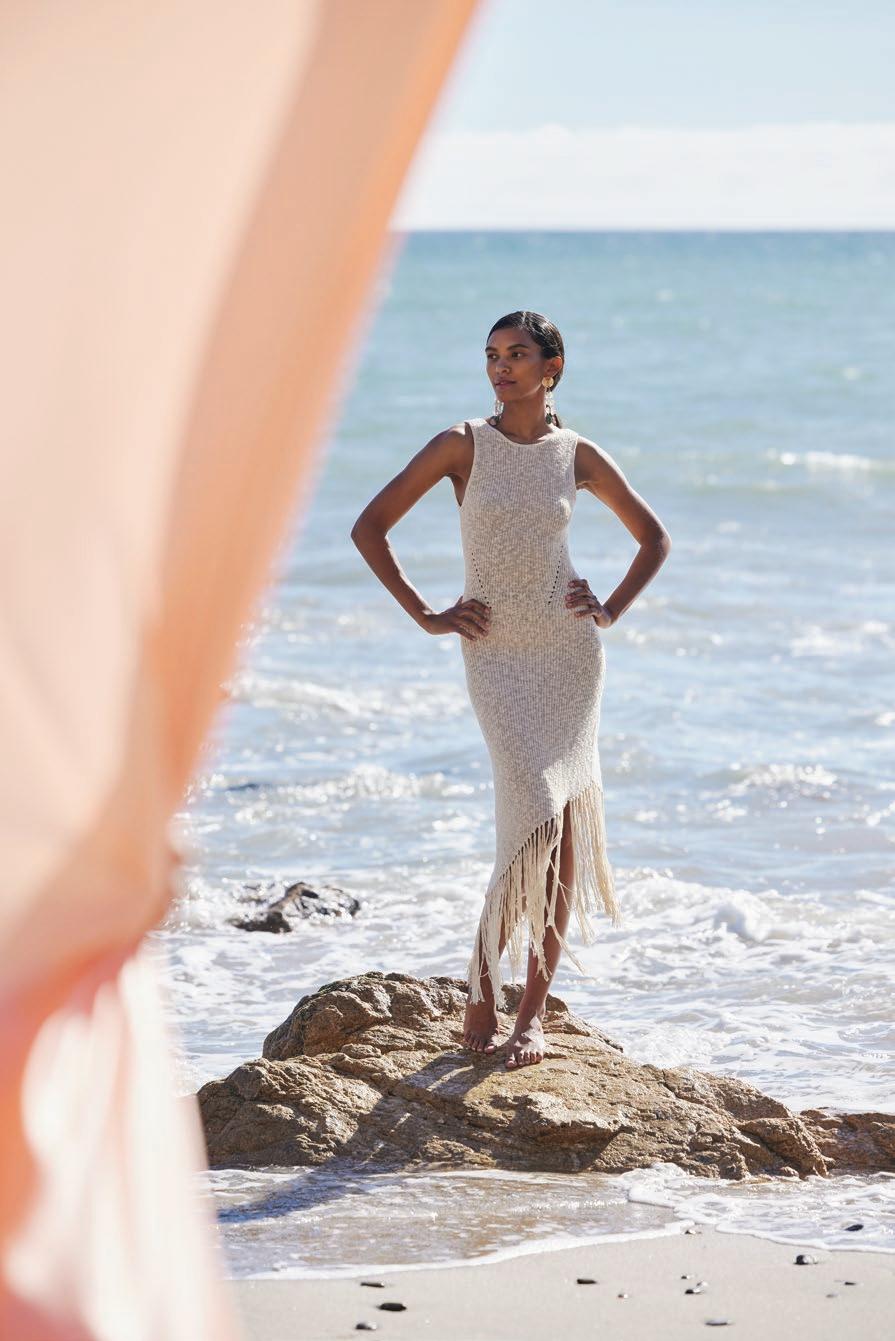




The idea is not to live forever but to create something that will.
—Andy WArhol

